Category: Comparability Analysis

Czech Republic vs Inventec s.r.o., May 2025, Supreme Administrative Court, Case No 1 Afs 2/2025 – 59
Inventec carried out manufacturing activities in the electronics industry on behalf of its parent company. It took formal title to the raw materials, but considered that its role was limited to assembly, without assuming risk or adding value to the materials. Inventec therefore used ROVAC (return on value added costs – not including cost of materials) as a profit level indicator (PLI) in its transfer pricing analysis. The tax authorities disagreed with the choice of PLI and considered ROTC (return on total costs – including materials) to be more appropriate. An appeal was filed by Inventec, which ended up before the Regional Court, which in its decision no. 29 Af 91/2019-147 found that the tax authorities had not taken into account Inventec’s FAR profile and that the alternative choice of profit level indicator – ROTC instead of ROVAC – had therefore not been sufficiently justified. On this basis, the court quashed the assessment and remitted the case to the tax authorities for reconsideration. The tax authorities reconsidered their approach and carried out an additional FAR analysis and amended their assessment accordingly. The new assessment was then the subject of the new appeal to the Regional Court which in a ruling issued in December 2024 upheld the tax assessment issued by the tax authorities. An appeal was then filed with the Supreme Administrative Court. Judgment The Supreme Administrative Court dismissed the appeal of Inventec s.r.o. and upheld the decision of the Regional Court. Click here for English Translation Click here for other translation
![Australia vs Alcoa, April 2025, Administrative Review Tribunal, Case No [2025] ARTA 482](https://tpguidelines.com/wp-content/uploads/Alcoa-1-142x200.png)
Australia vs Alcoa, April 2025, Administrative Review Tribunal, Case No [2025] ARTA 482
Alcoa of Australia Ltd. is engaged in mining and sold smelter-grade alumina to an unrelated party, Aluminium Bahrain B.S.C., under long-term contracts. [Australia’s transfer pricing legislation is applicable if an Australian entity gets a tax benefit in Australia from non-arm’s length cross-border conditions, regardless of whether the parties are related to one another. There are no control or ownership thresholds for the legislation to apply. This ensures that independent parties engaging in, for example, collusive behavior or other practices where they are not dealing exclusively in their own economic interests will not circumvent the rules by reason of their non-association.] Following an audit in which the arm’s-length pricing of the transactions was tested using the CUP method, the tax authorities concluded that Alcoa had not received an arm’s-length consideration for its sale of alumina. According to the tax authorities, it had undercharged Aluminium Bahrain B.S.C. by more than USD 420 million over FY 1993–2009, resulting in an assessment of additional taxes of AUD 213 million. After receiving the assessment, Alcoa filed objections with the Administrative Review Tribunal. Decision of the Tribunal The Tribunal allowed Alcoa’s objections and set aside the tax assessment. It found that the commercial terms and context were essential for a CUP analysis and concluded, based on the evidence provided, that Alcoa’s pricing was consistent with, or above, those found in comparable market transactions. Excerpts “ 502. As with the prior years, Mr Meurer provided a range of prices (low to high) which in his expert opinion represented arm’s length consideration for the years 2002 to 2009. If these prices are accepted as arm’s length consideration, then it is somewhat remarkable to observe that Alcoa received a price equal to or above what in Mr Meurer’s opinion was arm’s length consideration for the years 2002 and 2007, 2008 and 2009.407 It follows that on the Commissioner’s own evidence, Alcoa did not receive less than arm’s length consideration for those years. It is difficult to understand how the Commissioner pursued a claim with respect to those four years when the opinion of his own expert did not support his case. Mr Meurer’s insistence that the consideration received by Alcoa was nevertheless less than arm’s length consideration because the distribution agreements did not contain price review provisions is, in our view, untenable. Despite some flaws in Mr Meurer’s approach which we identify below, we are prepared to accept his opinion that Alcoa received a price equal to or above arm’s length consideration for the years 2002 and 2007, 2008 and 2009 because it is supported by Alcoa’s experts.” “509. The relevant test is not whether the Commissioner can establish an arm’s length consideration; it is whether the taxpayer received arm’s length consideration. As the Full Court said in Glencore, “what controls the range of acceptable arm’s length outcomes is the concept of what might reasonably be expected”.420…” “521. While we have found that Alcoa has not proved it was dealing at arm’s length with the Dahdaleh Entities, it is our view that Alcoa nevertheless received not less than arm’s length consideration in respect of its supply of alumina to the Dahdaleh Entities in 2002 to 2009. “ “DECISION 523. We have concluded that Alcoa has proved the consideration it received for the relevant supplies in each of the Relevant Years is not less than arm’s length consideration. It follows that Alcoa has proved the assessments are excessive and the amounts that should be assessed are the returned amounts based on the actual consideration received by Alcoa. 524. Accordingly, the Tribunal decides to set aside the Commissioner’s objection decision dated 1 April 2022 and substitute it with a decision that each of Alcoa’s objections is allowed in full.” Click here for translation
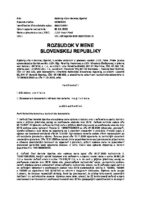
Slovakia vs SK MTS, s.r.o., March 2025, Administrative Court, Case No. 2Sf/8/2023 (ECLI:SK:SpSBB:2025:0823100247.2)
To support its transfer pricing, SK MTS, s.r.o. submitted documentation that included a benchmark study, asserting that its pricing fell within the full range. Upon review, the tax authorities found that 9 out of the 10 companies included in the benchmark were not truly independent. Consequently, the authorities conducted their own benchmarking study and determined that the pricing of SK MTS, s.r.o.’s controlled transactions fell outside the interquartile range. They therefore adjusted the pricing to the median and issued an assessment. SK MTS, s.r.o. appealed the assessment to the Administrative Court. Judgment of the Court The Administrative Court dismissed the appeal and upheld the assessment issued by the tax authorities. Excerpts “22. Given that the companies compared by the plaintiffs did not meet the condition of independence and the plaintiff did not submit transfer documentation for 2019 to the tax administrator or prepare a comparability analysis, the tax administrator prepared such an analysis himself, and this procedure cannot be criticised. When preparing the analysis, the tax administrator (i) selected from publicly available sources comparable entities that carried out the same activity (road freight transport), were not economically, personally or otherwise linked, were established before 2014 and had a comparable turnover and a similar number of employees in the year under review; (ii) selected from the financial statements of the selected companies the data necessary to calculate the profitability of income from economic activities, which the taxpayer chose as an indicator, and (iii) calculated the profitability in % for selected entities that can be considered comparable. The average profitability was calculated at 2.83% from the data on the profitability of these companies. For the sake of completeness, it should be noted that the tax administrator did not have detailed data on the selected entities, as it relied only on data from publicly available and published financial statements for 2019, and therefore referred to point 3.62 of the OECD Guidelines, which states that: “In determining this point within a range that contains relatively similar and highly reliable results, it could be argued that any point within that range is consistent with the arm’s length principle. If some comparability deficiencies still remain, as indicated in paragraph 3.57, it may be appropriate to use a mid-range indicator (e.g. median, arithmetic or weighted average, etc., depending on the specific characteristics of the data set) to determine this point in order to minimise the risk of error due to unknown or unquantifiable residual comparability deficiencies.” With regard to the use of the median, the administrative court states that the OECD guidelines recommend using the median in order to minimise errors due to persistent unknown or unquantifiable comparability flaws. The administrative court must agree with the tax administrator’s argument that independent companies were selected in an effort to find the most comparable companies possible, but that the median is used precisely in order to eliminate unknown comparability impairments, i.e. those that could occur despite all efforts made in the selection process. In general, it should be noted that the selection of independent comparable companies involves a huge number of risks that cannot be captured by the comparability adjustments used. The Administrative Court is of the opinion that the fact that the tax administrator accepted certain companies as comparable does not mean that the selected companies perform exactly the same functions and bear exactly the same risks as the applicant. The Administrative Court finds that the tax administrator took into account, from the available sources, the specific characteristics and conditions relevant to the calculation of an independent business relationship and correctly applied to the calculation of the adjustment of the economic result the profit margin of comparable independent entities, which is 2.07%, the most common median value. On this basis, the difference between the prices in mutual business relations between foreign entities and the prices used between independent entities in comparable business relations constitutes an item to be added to the economic result. In view of the above, the administrative court states that the use of the median was correct, appropriate and lawful, and therefore all the objections raised in this regard are unfounded.” […] “24. The Administrative Court points out that, on the basis of the evidence taken, the tax authority established the facts correctly and in accordance with the Tax Code. After examining the defendant’s administrative file, the Administrative Court came to the same conclusion that the tax authorities, in their decisions, thoroughly and extensively described the facts established, the evidence obtained by the tax administrator in the course of the tax audit and the assessment procedure, and also properly assessed and dealt with all the objections raised by the applicant. These conclusions, together with the correct citation of the relevant legal provisions, provide sufficient legal grounds for the contested decision of the defendant. The administrative court agreed with them in their entirety, considering the legal assessment of the case by the defendant to be correct.” Click here for English translation Click here for translation
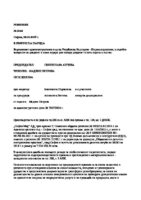
Bulgaria vs Sofia Med AD, January 2025, Supreme Administrative Court, Case no 2048 (7967/2024)
The tax authorities had challenged the transfer prices applied for FY 2014 in several of Sofia Med AD’s related-party transactions, including the purchase of intermediary services, the purchase of copper cathodes (with deferred payment interest), and the sale of finished products and an assessment of additional taxable income was issued. An appeal was made to the Administrative Court, which largely upheld the tax authorities’ decision, and Sofia Med AD then appealed to the Supreme Administrative Court. The main complaints in Sofia Med AD’s appeal were the lack of reasoning in the decision when rejecting the comparability analysis carried out by the company in the transfer pricing documentation submitted, the lack of evidence in the case regarding the additional analysis carried out by the tax authorities of the transactions for the purchase of intermediary services and the sale of production, as well as the failure to consider the evidence submitted in the administrative proceedings and the conclusion of the forensic economic expert. Judgment The Supreme Administrative Court referred the case back to the lower court for reconsideration. It found that the lower court had failed to assess key elements of the case and had not provided adequate reasoning, in particular as to whether the additional comparability criteria used by the tax authorities – grouping transactions by product type, geographical region and volume – were actually relevant to the pricing of intermediary services and the sale of products. The Court also noted that the lower court did not address the company’s argument that adjustments to the financial result should be made to reduce, and not only to increase, its tax base when applying transfer pricing rules. The Court found similar procedural omissions concerning the deferred payment interest on copper cathodes, where the tax authorities used short-term bank loan interest rates as comparables without establishing a suitable range of market values or explaining in detail how those loans were truly comparable to the extended payment terms. Because of these omissions and the lack of clarity on critical factual issues, the Supreme Administrative Court annulled the lower court’s ruling in the contested part and sent the case back for re-examination. It instructed the first-instance court to appoint an expert who would more precisely address the company’s objections to the additional comparability criteria and to give Sofia Med AD the opportunity to present further evidence, including translated documents, to demonstrate whether the services under certain invoices from a related party had indeed been rendered. The Court emphasized that only after clarifying these factual disputes in accordance with transfer pricing legislation could a proper legal assessment be made. Click here for English translation Click here for other translation
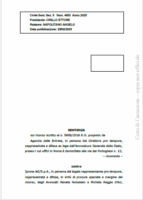
Italy vs Iprona SpA, February 2025, Supreme Court, Case No 4853/2025
Iprona SpA is an Italian company that sells fruit extract powder. It had sold products to an Austrian subsidiary at a price that was nearly tripled when the goods were quickly resold through related companies before reaching a final buyer in Liechtenstein. The tax authorities argued that the final price received by the Liechtenstein company should have been treated as the “normal value” of the initial sale from Iprona SpA, indicating an artificial profit shift. A tax assessment was issued on this basis. The case ended up in the Supreme Court. Judgment The Supreme Court decided that Iprona SpA had not applied the arm’s length principle correctly. The Court emphasized that, to establish normal value for transfer pricing purposes, one can rely on various complementary methods under both domestic law and OECD guidelines, such as the resale price method. The tax authority had shown that no further processing of the goods had occurred and that the rapid resale at a substantially higher price signaled an abnormally low initial sale price. The Court therefore overturned the regional judgment and remitted the case to a different composition of the Bolzano Court of Tax Justice. It instructed the lower court to verify whether the entire chain of sales took place among entities in the same group and whether the purchase price at issue was abnormally low relative to prices charged in comparable transactions with independent parties. The Court also rejected Iprona’s incidental challenges about alleged procedural flaws, noting that an adequate intra-procedural exchange had occurred and that a tax assessment need not address every point raised by the taxpayer so long as it contains sufficient reasoning. Click here for English translation Click here for other translation
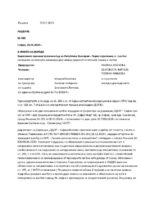
Bulgaria vs Sofia Med AD, January 2025, Supreme Administrative Court, Case no 641 (7114/2024)
Sofia Med AD is a manufacturer of a wide range of rolled and pressed copper and copper alloy products. It was subject to a tax audit in which the tax authorities challenged several aspects of its tax reporting, including transfer pricing adjustments on intercompany transactions. The dispute concerned the deductibility of intermediary fees, the application of the arm’s length principle, and the classification of certain payments as taxable under withholding tax rules. Intercompany Transactions and Transfer Pricing Adjustments The tax authorities audited Sofia Med’s pricing methods for transactions involving related entities. The company had used different pricing approaches over the years — first linking intermediary service fees to tonnes of production sold, then shifting to a percentage of net sales revenue. The authorities found that this methodology failed to ensure a reliable comparability analysis, as required under both Bulgarian regulations and OECD transfer pricing guidelines. Applying the CUP method, the tax authorities adjusted the company’s financial results, arguing that the transfer pricing policies did not adequately reflect market conditions. Intermediary Fees and Economic Substance Sofia Med had paid commission and agency fees to STEELMET (Cyprus) for market research and customer identification services. The tax authorities disallowed part of these expenses, asserting that no intermediary role had been contractually established for certain sales transactions. The court upheld the tax authorities’ position, concluding that a portion of the claimed service fees did not meet the criteria for tax deductibility. Regarding other fees classified as intra-group service payments, the court applied OECD guidelines, emphasizing that a service must provide an economic or commercial benefit. The Administrative Court annulled the assessment and the tax authorities appealed to the Supreme Administrative Court. Judgment The Supreme Administrative Court overturned the decision of the Administrative Court and largely upheld the transfer pricing adjustments, confirming that the tax authorities correctly applied the arm’s length principle. The court found that Sofia Med failed to provide a sufficient comparability analysis to justify its pricing methodologies for related-party transactions. The disallowed deductions for intermediary services and intra-group payments remained in place. The court found that the supporting documentation was insufficient to demonstrate that STEELMET’s activities improved Sofia Med’s business position. Given that the company reported financial losses during the audited years, the authorities determined that these payments facilitated intra-group profit shifting rather than legitimate business operations. However, the court ruled that some of the tax liabilities were time-barred under Bulgarian law, leading to a partial annulment of the additional taxes assessed. Click here for English translation Click here for other translation
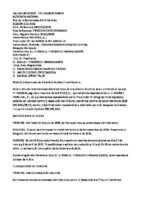
Spain vs IHLT ESPAÑA S.L. (NEX TYRES S.L.), December 2024, Audiencia Nacional, Case No SAN 6910/2024 – ECLI:ES:AN:2024:6910
IHLE ESPAÑA (later NEX TYRES) purchased tyres from its German parent company (IHLE BB) using what it claimed was the CUP method. It claimed that IHLE BB sold the tyres at the same price as it paid to third party suppliers, simply passing on additional transport costs and a small administration fee. The tax authorities rejected the CUP method used by IHLE and instead applied a TNMM, selecting a group of EU car parts wholesalers as comparables, using statistical tools to determine an interquartile range and then adjusting IHLE ESPAÑA’s profit to the median. IHLE ESPAÑA appealed. Judgment The Court ruled largely in favour of the tax authorities, but partially upheld IHLT’s appeal. The Court ruled that the “CUP method” used by IHLT was inconsistent because, once all indirect costs were added to the price, IHLE appeared to buy the tyres at a higher total price than it sold them, resulting in negative or minimal gross margins that no independent distributor would accept. In addition, the Court noted that IHLE had relied on internal comparables – tyres purchased independently in Spain – but that the tax authorities had identified various shortcomings in the comparability: differences in volumes, return policies and other conditions of sale which made a reliable price adjustment impossible. The Court upheld the tax authorities’ choice of transfer pricing method (TNMM) and approved the comparables in the benchmark, agreeing that it was reasonable to look beyond the Spanish market to find companies of comparable size and activity, given the taxpayer’s own pan-European sourcing strategy. However, the Court concluded that the tax authorities had adjusted to the median without explaining how remaining “comparability deficiencies” justified disregarding lower points in the range. Under the OECD Guidelines, the use of the median requires a clear demonstration that there are imperfections in the comparables such that only a measure of central tendency can correct them. As the tax authorities did not provide such justification, the Court partially upheld the taxpayer’s appeal on this point. Finally, the Court examined the tax authorities’ refusal to recognise the taxpayer’s tax losses from previous years (2006-2010). The tax authorities had assumed that the same transfer pricing errors discovered in 2011-2014 would also invalidate the earlier losses. The Court found that assumption unfounded and allowed those tax losses to stand unless and until the tax authorities had properly demonstrated that they resulted from incorrect transfer pricing in those unaudited years. Click here for English translation Click here for other translation
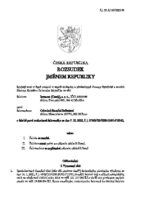
Czech Republic vs Inventec s.r.o., December 2024, Regional Court, Case No 29 Af 56/2022
Inventec carried out manufacturing activities in the electronics industry on behalf of its parent company. It took formal title to the raw materials, but considered that its role was limited to assembly, without assuming risk or adding value to the materials. Inventec therefore used ROVAC (return on value added costs – not including cost of materials) as a profit level indicator (PLI) in its transfer pricing analysis. The tax authorities disagreed with the choice of PLI and considered ROTC (return on total costs – including materials) to be more appropriate. An appeal was filed by Inventec, which ended up before the Regional Court, which in its decision no. 29 Af 91/2019-147 found that the tax authorities had not taken into account Inventec’s FAR profile and that the alternative choice of profit level indicator – ROTC instead of ROVAC – had therefore not been sufficiently justified. On this basis, the court quashed the assessment and remitted the case to the tax authorities for reconsideration. The tax authorities reconsidered their approach and carried out an additional FAR analysis and amended their assessment accordingly. The new assessment was then the subject of the new appeal to the Regional Court. Decision The Regional Court upheld the tax assessment issued by the tax authorities. Click here for English Translation Click here for other translation
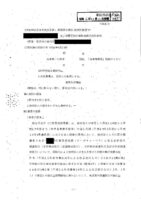
Japan vs “E Corp”, December 2024, Tokyo High Court, Case No 東京高裁令和6年12月11日判決
Plaintif, “E Corp” is a Japanese corporation whose business activities are focused on four business fields: resources and energy, public infrastructure, industrial machinery, and aeronautics and space. Through company B, E Corp owned the shares in Company A located in Thailand. Company A purchased vehicle turbocharger parts or components from “E Corp” or local suppliers, manufactured vehicle turbochargers under a licence agreement with E Corp and also recieved services from E Corp. It sold the turbochargers mainly to Japanese automobile manufacturers, and also both finished products and parts to E Corp’s other affiliated companies. Following an audit a dispute arose between E Corp and the tax authorities as to what transfer pricing method to apply. An assessment was issued where the tax authorities applied a “method equivalent to the Transactional Net Margin Method” “E Corp” filed a complaint which the district court alleging that the method used by the tax authoritis was not equivalent to a TNMM, and therefore the amount calculated by the tax authorities could not be considered at arm’s length. In 2023 the Tokyo District Court overturned the tax assessment and upheld the E Corp’s claim. An appeal was filed by the tax authorities with the Tokyo High Court. Judgment The Tokyo High Court upheld the district court’s decision and ruled in favour of ‘E Corp’, concluding that the transfer pricing method used by the tax authorities was inappropriate for this case. Excerpt in English “The OECD Guidelines (2010 Edition) list the characteristics of the transferred assets or services, the functions performed by the parties, and the economic circumstances of the parties as important attributes to be considered in a comparability analysis. It states that even if transactions involve the same assets or services, Furthermore, in determining the similarity of markets, the guidelines cite economic conditions relevant to the determination of market similarity, including ‘the degree of competition in the market and the relative competitive positions of buyers and sellers in the market,’ as well as ‘the level of supply and demand in the market as a whole and in specific regions.’ Additionally, operating profit indicators are cited as reflecting competitive position, including the competitive position within the industry. In addition, operating profit indicators are noted as potentially directly influenced by the forces acting within the industry, including competitive position, and as a factor that may result in differing profitability even if two companies belong to the same industry. ‘market share (market share ratio)’ and ‘competitive position’ as factors that may result in different profitability even if two companies belong to the same industry. (See the same paragraph 2.1.5.5, 2.72.)‘market share (market share ratio)’ and ‘competitive position’ as factors that may result in differing profitability even if two companies belong to the same industry. (Same paragraph 1.5, 2.72). Furthermore, in accordance with the same guidelines, Article 66-4(3) of the Measures Act states that when selecting comparable transactions, the following factors should be considered: When determining the degree of similarity between related-party transactions and non-related-party transactions, consideration should be given to the similarity of the following elements, such as the nature of the business of the corporation, related parties, and non-related parties, as well as the ‘functions performed by the seller or buyer’ and ‘market conditions’ (see Eth 4-4-975-11-5). From this, it is clear that when considering comparability (similarity of transactions), it goes without saying that the ‘functions performed by the seller or buyer’ in the transactions to be compared should be taken into account. However, in addition to this, ‘market conditions’ should also be considered, and when considering ‘market conditions,’ factors such as ‘market share’ and ‘demand’ are factors that may be considered. The foreign related party in this case and the comparable company both manufacture automobile parts, but there are significant differences in the market conditions for each product, such as market share and demand, and it cannot be immediately recognised that these differences do not have a significant impact on the operating profit margin. Therefore, the transactions in question lack similarity in ‘market conditions,’ and while adjustments to account for these differences may be necessary, it is not clear that such adjustments are possible. Based on the above, it must be concluded that there is no comparability between the transactions of the foreign related party and the comparable entity. Conclusion Based on the above, the defendant’s claims are all well-founded and should be granted, and the original judgment to the same effect is appropriate. The appeal is without merit.” Click here for English Translation Click here for other translation
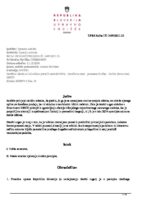
Slovenia vs “Pharma Seller Ltd”, December 2024, Administrative Court, UPRS Sodba I U 1489/2021-22 (ECLI:SI:UPRS:2024:I.U.1489.2021.22)
“Pharma Seller Ltd” — a Slovenian member of a multinational pharmaceutical group — had argued that, after a 2012 restructuring in which warehousing and logistics for South-Eastern Europe were moved to a newly formed Hungarian affiliate, it became merely a routine service provider entitled to a modest cost-plus return. During an audit the tax authorities concluded that “Pharma Seller Ltd” still performed the critical, value-creating functions for drug sales in the region: marketing to doctors, tender management, price setting, credit-risk monitoring and other commercial activities. Those activities were carried out by more than thirty highly qualified employees who remained on the Slovenian payroll, demonstrating that know-how, customer relationships and commercial risk control—constituting a marketable marketing intangible—had not migrated to Hungary. The tax authorities therefore treated the Hungarian company as performing only low-value distribution services, rewarded it with a 5 percent cost-plus mark-up, and allocated the residual (“non-routine”) profit to “Pharma Seller Ltd” through a notional royalty. An appeal was filed with the Administrative Court. Judgment The Administrative Court accepted the approach taken by the tax authorities, relying on Article 16 of the Corporate Income Tax Act, the Slovene Transfer Pricing Rules and the OECD Transfer Pricing Guidelines, which allow a profit-split method when traditional cost-based methods do not reflect the arm’s-length outcome. The Court held that “Pharma Seller Ltd”, bore the burden of supplying reliable comparables; because “Pharma Seller Ltd”’s own analyses used advertising-agency data unrelated to the regulated pharmaceutical context and failed to match its true functions, the tax authority was entitled to substitute the cost plus method with its own method. The partial relief previously granted on 2011 assessments was unaffected; for 2014 the additional corporate income tax of € 943,821.48 and related interest remain payable. Click here for English translation Click here for other translation

Greece vs “Lifts Ltd.”, December 2024, Administrative Court, Case No 5045/2024
“Lifts Ltd.” had used the transactional net margin method to set the pricing of its sales to related parties. The tax authority rejected that method for certain sales and applied a cost plus method instead, drawing comparisons to the company’s sales to third parties. This approach resulted in upward adjustments to taxable income. An appeal was filed by “Lifts Ltd.” with the Administrative Court. Judgment The Court largely upheld the authority’s use of a traditional (cost plus) method for most sales, finding that internal comparables of sales to independent parties existed and could be made sufficiently reliable through adjustments. However, it ruled that sales to a Turkish affiliate were not properly comparable to sales in Swedish or Czech markets. Given the market differences and the company’s strategy to penetrate Turkey, the authority had not shown that the transfer prices for those sales were outside an acceptable arm’s length range. Consequently, the related upward adjustment for the Turkish sales was annulled. Click here for English translation Click here for other translation
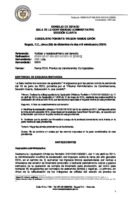
Colombia vs Abb Ltda (formerly Asea Brown Boveri Ltda), December 2024, Supreme Administrative Court, Case No. 25000-23-37-000-2015-01813-01 (25803)
The case concerned whether the tax authorities had been justified in rejecting five out of the sixteen comparable companies that had been selected by ABB Ltda. in a benchmark study to justify the pricing of its intercompany transactions, which was the basis for a tax assessment that had been issued by the tax authorities. The court of first instance accepted four of the comparables originally disallowed by the tax authorities, finding that the grounds for their exclusion were not adequately proven. It only upheld the exclusion of Dulhunty Power Ltd., because the company’s intangibles were well over ten percent of its sales, and there was no technical explanation for omitting that portion of its assets from the study. After recalculating the interquartile range with the accepted comparables, the court adjusted upward the sales of produced inventories but recognized the costs linked to purchases for production, as these fell within the arm’s-length range. Regarding technical assistance and royalty expenses, which were also rejected administratively on the same grounds and over allegations of failing to register contracts, the first-instance ruling observed that only the failure to comply with transfer pricing principles was ultimately sustained by the tax authorities. Once the court established that four of the disputed comparables should indeed be included, those transactions showed a profit margin within the arm’s-length range, and the court reinstated the disallowed expenses. Judgment In the appeal, the Council of State affirmed the court of first instance’s decision, reiterating that the existence of additional lines of business or a one-time loss does not, on its own, justify discarding a comparable. It upheld the exclusion of Dulhunty Power Ltd. because the presence of significant intangible assets beyond the threshold established in the company’s selection criteria remained unjustified. It also clarified that each type of transaction subject to transfer pricing must be analyzed separately, so excluding comparables for sales to related parties does not automatically apply to royalty and technical assistance transactions. Finally, the Council of State upheld the inaccuracy penalty, although it remained reduced by applying the principle of favorability. Click here for English translation Click here for other translation

Italy vs Ilapark Italia SpA , October 2024, Supreme Court, Case No 26432/2024
Ilapark Italia SpA is an Italian manufacturing company that produces packaging machines. Other companies within the group were responsible for distribution and sales of the machines. Following an audit, the Italian tax authorities issued an assessment for FY 2008, where they had set aside the CUP method applied by the company and instead used the Transactional Net Margin Method (TNMM). An appeal was filed where Ilapark Italia SpA argued that the CUP method was preferable over the TNMM according to the 2010 TPG. The lower courts upheld the tax authorities’ assessment and an appeal was then filed by Ilapark Italia SpA with the Supreme Court. Judgment The Supreme Court dismissed the appeal in regards of the transfer pricing issue. According to the Court the OECD Guidelines provide guidance rather than enforceable rules. The Guidelines offer operational strategies for implementing transfer pricing but are not part of Italy’s legal hierarchy. In the case at hand, the Court found that the TNMM was the more appropriate method, since the Italian manufacturing company had limited risk and mostly handled pre-confirmed orders. Click here for English translation Click here for other translation
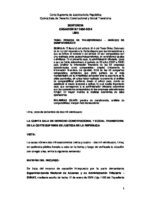
Peru vs Toyota del Perú S.A., September 2024, Supreme Court, Casación N° 2434-2024
Toyota del Perú S.A. applied the transactional net margin method (TNMM) to determine the arm’s length price for its controlled transactions involving the import of vehicles. The company made comparability adjustments and based its benchmarking analysis on multi-year data covering 2007 to 2009. The tax authorities rejected both the comparability adjustments and the use of multi-year data, relying instead solely on financial data from 2009 without adjustments. As a result, Toyota’s margins fell outside the interquartile range, leading to an assessment based on the median. Toyota appealed to the Tax Court, which held that since the multi-year data had been rejected, the tax authorities were required to carry out a new comparability analysis using only 2009 data. The tax authorities challenged this decision, and the case ultimately reached the Supreme Court. Judgment The Supreme Court overturned the Tax Court’s ruling and remanded the case for a new decision. It instructed the Tax Court to address the core issue: whether the comparability adjustments made by Toyota were appropriate and, if not, whether the use of multi-year data was justified in determining the operating margin. Paragraph d) of Article 32-A of the Consolidated Text of the Peruvian Income Tax Law provides that the transactions referred to in paragraph 4 of Article 32 are comparable to those carried out between independent parties, under the same or similar conditions. In the present case, the tax administration – despite having already determined the three-year period (2007 to 2009) for analysing the financial information of the six companies selected as comparables – used only the financial information for the 2009 financial year of the six comparable companies, stating that this period is the most representative of the sector’s profitability in the context of the economic crisis, without first carrying out the comparability analysis again from the first step, where the time frame to be applied was established, which is important given that it is up to the tax administration to determine that the comparable transactions of the selected companies reflect the economic reality of such transactions to a greater extent. Click here for English Translation Click here for other translation
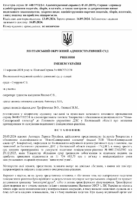
Ukrain vs “Novo-Sanzharsky Grain Storage LLC”, September 2024, Administrative Court, Case № 440/3712/24
Following an audit, the tax authority determined that prices for controlled transactions of grains had been below the arm’s length price and issued an assessment of additional taxable income. According to the tax authority, the correct application of the arm’s length principle in this case required the price of the controlled transaction to be compared with the prices (price range) of comparable uncontrolled transactions on the basis of the information available on the date closest to the date of the controlled transaction – and not on the date where the controlled contract had been concluded. For that purpose, the tax authorities had looked at prices from a different sources including non-public databases. An appeal was filed by “Novo-Sanzharsky Grain Storage LLC” with the Administrative Court. Judgment The Administrative Court decided in favour of “Novo-Sanzharsky Grain Storage LLC” and annulled the tax assessment issued by the tax authorities. Excerpt in English “The task of administrative court proceedings is to effectively protect the rights, freedoms and interests of individuals, rights and interests of legal entities from violations by public authorities. Accordingly, if an interested person files a claim with the court, the administrative court must provide a legal assessment of the actions of the authority in making a decision and check its compliance with the criteria of legality, which are applied to the decisions of the authority and which are enshrined in Article 2 of the Code of Administrative Procedure of Ukraine. In other words, regardless of the decision taken by the taxpayer on admission (non-admission) of officials to the audit, when challenging the results of the audit conducted by the controlling authority in the form of tax notices-decisions and other decisions, the taxpayer is not deprived of the opportunity to refer to violation by the controlling authority of the requirements of the legislation on conducting such an audit, if it believes that they cause the unlawfulness of such tax notices-decisions. At the same time, as noted above, such grounds of claim, if any, should be given a legal assessment by the courts in the first instance. Thus, the fact that the specialists of the controlling authority were allowed to conduct an audit is not a basis for an indisputable conclusion about the legality of the appointment and conduct of such an audit, and, accordingly, the arguments of the controlling authority in this regard are groundless. Similar conclusions on the application of the law were formulated by the Supreme Court as part of the panel of judges of the Administrative Court of Cassation in its decision of 21 May 2024 in case No. 440/8798/22. Taking into account the established circumstances of the case and the legal regulation of the disputed legal relations, the court concludes that there are sufficient factual and legal grounds to declare unlawful and cancel the tax notice-decision of the Main State Tax Service in Poltava region No. 000123632302 dated 28.12.2023 in full solely on the grounds of unlawfulness of appointment and conduct of the audit in accordance with paragraph 522 of subsection 10 of section XX of the Transitional Provisions of the Tax Code of Ukraine. Therefore, the claim should be satisfied in full.” Click here for English translation Click here for other translation
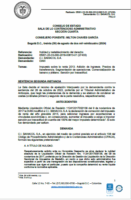
Colombia vs C.I. Banacol S.A., August 2024, Supreme Administrative Court, Case No. 05001-23-33-000-2018-00613-01 (27433)
The tax authority (DIAN) had issued an assessment of additional taxable income for FY2013 due to non-arm’s length pricing of transactions with related parties. According to the assessment, the tax authority disagreed with method applied by C.I. Banacol and instead applied a TNMM where the transactions were priced in the aggregate. C.I. Banacol appealed to the Administrative Court, which ruled in favour of the tax authories. An appeal was then filed with the Supreme Administrative Court. Judgment The Supreme Administrative Court upheld the decision of the Administrative Court and ruled in favour of the tax authorities. Excerpts in English “The Chamber agrees with the DIAN and the Court in the sense that the four segmented transactions for the purposes of the transfer pricing regime are interrelated and are directed to the fulfilment of a single object: the international marketing of bananas and plantains and other fruits, products that are previously acquired from national economic partners or consigned by third parties.” … “As can be seen, the selected comparables are, like Banacol, active in the marketing of fruit. One of them sells bananas, plantains and other fruits. Since it has been established that Banacol is engaged in the marketing of bananas, plantains and other fruit, the Board considers the interquartile range set by the administration to be appropriate because it corresponds to that of the activity carried out by the party under analysis (Banacol) and the selected comparables. Finally, the applicant submits that only transactions with related parties should have been assessed and revenues, costs and expenses not associated with such transactions, i.e. transactions with third parties, should have been excluded and that, by failing to do so, transactions not subject to the arm’s length principle were brought under the arm’s length principle. As noted, the TNMM method allows for an overall or segmental assessment of the profit margins obtained by companies in transactions with related parties. When the comparability analysis is done on an aggregate basis it is not necessary to exclude non-transfer pricing transactions because, as stated in the OECD guidelines, “income and expenses not related to the related party transaction under review [should] only be excluded where they significantly affect comparability with unrelated transactions” (paragraph 284). These same guidelines indicate that, when determining the net profit indicator or factor, in this case the ROTC, for the application of the net operating margin method, only those elements should be taken into account which: (a) are directly or indirectly related to the related operation under analysis, and (b) are related to the exploitation of the activity. In this case, it was sufficiently demonstrated that Banacol’s segmented operations, with related or unrelated parties, are interrelated to a larger operation: the marketing of bananas, plantains and other fruits, so it was not necessary to exclude the operations that the plaintiff claims should have been excluded. Moreover, the plaintiff did not demonstrate how such transactions affected comparability or the adjustments that were required, since, it should be emphasised, it is precisely the rejection of segmentation and the proposal of adjustments to the taxpayer’s global information that involves both controlled transactions and those carried out with independent parties, with the correlative consideration of profit margins that are also global. The taxpayer was therefore required to specify the adjustments that were required, in the analysed part, in the comparable parts or in both, that is to say, to prove the technical impertinence of the adjustment made by the tax authority, which was not done. The appeal is unsuccessful.” Click here for English translation Click here for other translation
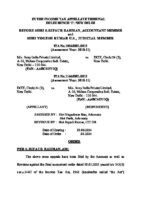
India vs M/s. Sony India Pvt. Ltd., August 2024, Income Tax Appellate Tribunal – Delhi Bench, Case ITA No.1026/DEL/2015 and ITA No.1166/DEL/2015
Sony India Private Limited is a wholly owned subsidiary of Sony Corporation, Japan. During the years under consideration, 2010-11, Sony India was engaged primarily in import and distribution of Sony products in the Indian market. Following an audit, an assessment was issued by the tax authorities where the taxable income of Sony India was adjusted upwards. The tax authorities considered and benchmarked the distribution activities and found that the margin declared by the Sony India was below the average margin of 27,8% determined by applying the TNMM. They further proceeded to benchmark advertising, markeing and promotion (APM) expenses separately by adopting bright line test. An appeal was filed by Sony India Private Limited with the Income Tax Appellate Tribunal. Judgment of the Income Tax Appellate Tribunal The Tribunal ruled mostly in favor of Sony India. Excerpt “24. Next coming to the issue of benchmarking the ALP relating to software division of the assessee, we heard both sides and considered each of the submissions made by both parties, we observe that the issue under consideration is, the assessee has selected its own comparables to make the TP analysis, however, the TPO rejected the same by adopting certain common filters and selected 16 comparables to benchmark the ALP at 25.34%. Before us, the assessee filed a chart with the prayer to exclude comparables selected by the TPO, they are E-Infochips, Infinite Data systems, Infosys Ltd, Persistent systems and Thirdware Solutions. Further prayed to include Quintegra Solutions. However, at the time of hearing, Ld AR submitted that the assessee do not want to press the ground on inclusion of Quitegra Solutions. Accordingly, it is not adjudicated. 25. After considering the submissions of both sides, we observe that the coordinate bench has already considered the above issues in assessee’s group concern Sony Mobile Communications International. When the bench asked for the similarities in the functions and activities of the both the group concerns, the assessee has filed comparative chart before us, the same is reproduced in this order elsewhere, we have convinced that both the concerns having similar activities and functions, we are inclined to follow the decision of coordinate bench in selecting the comparables. Accordingly, we direct the AO/TPO to follow the same and relevant decisions of the coordinate bench are reproduced below: 26. In the result, we direct the AO/TPO to exclude the 5 comparables as per the findings of coordinate bench as discussed in the above paragraph. Accordingly, the relevant grounds raised by the assessee are allowed.” Click here for other translation
Argentina vs Volkswagen Argentina S.A., August 2024, Supreme Court, Case No CSJN 13/08/2024 (TF 30954-I)
The case of Volkswagen Argentina S.A. concerns whether the company’s income for FY 1999 – 2001 had been determined in accordance with the arm’s length principle. For the purposes of its transfer pricing analysis, Volkswagen Argentina (VWA) had included in its profits an extraordinary gain resulting from the waiver of a loan granted by Volkswagen Argentina Holding S.A., and on this basis had concluded that the results were at – or even above – arm’s length. The tax authorities disagreed with the adjustment made to VWA’s profits and found that the company had not been remunerated at arm’s length and an assessment of additional taxable income was issued. An complaint was made to the Tax Court, which ruled in VWA’s favour. The tax authorities then filed an appeal with the Court of Appeal, which was dismissed in December 2019. The case went on to the Supreme Court. Judgment The Supreme Court ruled in favour of the tax authorities. Click here for English Translation Click here for other translation
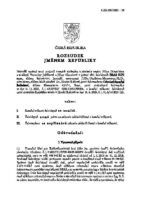
Czech Republic vs BEAS SUN s.r.o., July 2024, Supreme Administrative Court, Case No 6 Afs 255/2023 – 65
The tax authorities chose the cost plus method for determining the arm’s length price for low value-added intra-group services provided between related parties (Cost+). It took the parent company’s wage costs as the basis, to which it added a mark-up of 7 %, the maximum mark-up under Guideline D-10. On that basis, they concluded that the applicant had obtained services from the parent company that were different from the price at which an unrelated person would have provided the services. An appeal was filed with the regional court where BEAS SUN s.r.o. argued that the tax authorities should have chosen the comparable uncontrolled price (CUP) method, rather than the Cost plus method, to determine the reference price. The Regional Court stated that the CUP method is not superior to the other methods resulting from Guideline D-10 and the Transfer Pricing Guidelines for Multinational Enterprises and Tax Administrations issued by the Organisation for Economic Cooperation and Development (‘the OECD Guidelines’). The CUP method is preferred only if it can be used reliably. According to the Regional Court, the superiority of the CUP method is not apparent from the case-law of the Supreme Administrative Court. The case-law merely implies an obligation to state the reasons why the CUP method cannot be applied, on the ground that there are no independent transactions which are at least in substance comparable to the transaction under examination. According to the Regional Court, the tax authorities complied with that requirement. The tax authorities duly explained that the applicant purchased services which BEAS, a.s. supplied only to it or only to its subsidiaries. The tax authorities could not identify similar external independent transactions where services were provided in a similar content, scope and quality, given the wide range of activities provided. The Regional Court therefore confirmed that the tax authorities had sufficiently justified why they applied the Cost+ method instead of the CUP method. BEAS Sun then appealed to the Supreme Administrative Court. Judgment of the Court. The Supreme Administrative Court upheld the decision of the Regional Court. Excerpt in English “[31] The comparable independent price (CUP) method is a direct method and can be applied in a case in which an independent transaction that is comparable to the controlled transaction under examination can be found. This method is the simplest in terms of applicability, but it requires a high degree of comparability of the transactions being compared, which is also its weakness. Since there is no similar independent transaction for many of the transactions between related entities, this direct method cannot always be applied and one of the indirect methods must be used (cf. the judgment of the Supreme Administrative Court of 23 January 2013, No 1 Afs 101/2012-31). [32] The ‘cost plus’ method is an indirect method. It is based on the costs incurred by the supplier in a dependent transaction for the purchase of assets or services provided to the related undertaking by an independent seller. An appropriate mark-up is then added to these costs. It is applied to low value-added service cases using a gross profit mark-up. The advantage of the Cost+ method is that it does not require as much attention to the comparability of the product or service as the CUP method. Thus, this method must analyse the differences between the controlled and independent transactions which have an impact on the amount of the mark-up in order to determine which adjustments should be made to the relevant mark-up of the independent transaction (cf. Supreme Administrative Court judgments of 23 January 2013, 1 Afs 101/2012-31, and 29 January 2020, 9 Afs 232/2018-63). [33] On the basis of this case law, the Supreme Administrative Court finds that the tax authorities and the Regional Court did not err in relying on the OECD Directive and the guidelines issued by the General Tax Directorate, specifically Guideline D-10. The legal basis for their application was precisely Section 23(7) of the Income Tax Act. This was confirmed by the case law of the Supreme Administrative Court, which predated the decision of the tax authorities. The complainant disagreed, but did not put forward any opposing argumentation that would call into question the case-law referred to above.” Click here for English Translation Click here for other translation
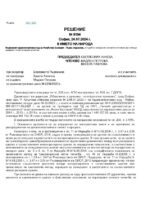
Bulgaria vs Yazaki Bulgaria, July 2024, Supreme Administrative Court, Case no 9194 (2294-2023)
The Administrative Court had annulled an income assessment issued by the tax authorities to Yazaki Bulgaria in FY 2014, 2015 and 2016. An appeal was filed by the tax authorities with the Supreme Administrative Court for annulment of the judgment. In the assessment, the tax authorities had accepted the comparability analysis carried out by Yazaki Bulgaria in respect of transactions relating to the manufacture of automotive products, including the calculated interquartile range of market values established on the basis of data for 25 comparable companies. According to the benchmark study the Net Cost Plus margins of the comparable companies for the three-year period were as follows: 2014 weighted average Net Cost Plus – lower quartile 2.27%, median 4.16% and upper quartile 7.02%; 2015 weighted average Net Cost plus 2015 – lower quartile 1.68%, median 4.31% and top quartile 6.80%; 2016 weighted average Net Cost plus for 2016 – lower quartile – 2.22%, median 3.95% and top quartile 7.66%; The actual Net Cost Plus margins realized by Yazaki Bulgaria for the periods were outside of the established range (-1.02% for 2014, 1.43% for 2015 and 0.46% for 2016) but by “adjusting” the cost basis, Yazaki Bulgaria’s net profit margin were within the interquartile range: 2.34% for 2014, 4.3% for 2015 and 2.56% for 2016. The tax authorities considered that there were no basis for the adjustments made by Yazaki Bulgaria to the actual net profit margins and since the actual results had been outside of the interquartile range, the profit was set to the lower quartile for each year. Judgment of the Supreme Administrative Court The Supreme administrative court allowed the appeal of the tax authorities and set aside the decision of the Administrative Court. Excerpts in English “In the present case, the audited company alleges the existence of losses from new projects during the audited periods that are specific only to the controlled transactions in the manufacture of automotive products, which were not found in the comparator companies. The impact of group-specific events on the profitability of the examined and compared businesses and the reliability of the comparability analysis is identified as a feature of TNMM in the OECD Handbook, 2010 (paragraph 2.72) and in the NRA Handbook on Transfer Pricing, Fact Sheet 10 (paragraph 6.2). These interpretative sources should be taken into account in the interpretation and application of the substantive law – Article 15 of the Tax Code and Article 46 of Regulation N-9/14.08.2006.” “According to paragraph 1.70 of the OECD Guidelines, 2010, related enterprises may incur real losses due to large initial costs, including inefficiencies or other legitimate business reasons, but under market conditions the losses would be temporary. Paragraph 1.72 states that losses such as those in the trial from unforeseen start-up labour costs can be expected for a limited period of time in order to increase profits in the long term. Such circumstances are also reflected in the transfer documentation prepared by the company, where the comparability analysis on the 2014, 2015 and 2016 automotive transactions indicates that YBE’s long-term projections are that for future periods the Renault Edison and Ford Transit projects, respectively the Renault Edison and Mercedes MFA2 projects will be more efficient and better revenue generating, but the case has not established that such results have been achieved. The valuation of the Renault Edison project in 2017 as a loss-maker and its discontinuation in 2017 is aimed at overcoming losses in accordance with paragraph 1.72 and the arm’s length principle. For the remaining projects, the case does not establish, including from the conclusion of the forensic economic expert, that the losses from the difference between the reported low productivity and the budgeted productivity during the periods at issue, resulting from higher labour costs at start-up, have been overcome in the long term in view of the life cycle effects of the products and that the profitability of the net profit indicator used, net cost plus, has been achieved in accordance with the arm’s length principle. Therefore, it cannot be assumed that the company’s elimination of the impact of labour cost losses for additional staff employed in 2014, 2015 and 2016 in connection with new production projects, when comparing the net profit indicators within the meaning of Articles 43 and 44(2) of Regulation N-9/2006, is in line with the objectives set out in Articles 4, 12 and 14 of the Regulation and with the arm’s length principle.” “Reasonably in this respect in the audit act it is accepted that the losses assumed by the audited company do not correspond to the functions, responsibilities and risks of the controlled transactions, which it has assumed according to the data in documentation for transfer pricing. According to the documentation, market and price risk is borne by the related party in the group (CSC) and not by the manufacturer. In view of the above, it is to be held that the increase in the financial results of a company for the year 2014-16 made by the revision order on the basis of section 15 of the Income-tax Act to the lower quartile of the range of market values found in comparable independent companies is lawful. In holding to the contrary, the court rendered a judgment contrary to the evidence in the case and in violation of substantive law, which should be set aside and another judgment entered dismissing the appeal in its place.” Click here for English translation Click here for other translation
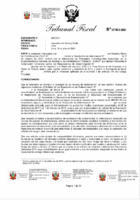
Peru vs “Mineral Export SA”, July 2024, Tax Court, Case No 06796-3-2024
In 2020 “Mineral Export SA” received a tax assessment for FY 2010 after the Peruvian tax authorities (SUNAT) had made two large transfer pricing adjustments: (i) an uplift of the remuneration it had received for its business activities (export of mineral concentrates to related parties), and (ii) an uplift of the price at which it had sold a controlling shareholding to a another group company. “Mineral Export SA” appealed to the Peruvian Tax Court. Judgment The Court partially upheld the adjustment concerning remuneration of the activities carried out, but it set aside the adjustment related to the price of the shares it had sold. In determining the remuneration for the activities carried out, the tax authorities had disallowed five comparability adjustments, discarding most of the taxpayer’s comparables, and recalculated the profit margins. The Court agreed that the comparability adjustments made by “Mineral Export SA” were unsupported and that the tax authorities could restrict the sample to two comparables. But according to the Court the tax authorities had been wrong to force a conversion into local currency when calculating the margins. Because the functional currency is the US dollar and that unit best reflects economic reality, the tax authorities would have to redo the TNMM analysis in dollars and re-issue the assessment. The adjustment to the price of the shares sold by “Mineral Export SA” to a another group company was nullified. In 2010 Peruvian law allowed only the six transfer-pricing methods listed in article 32-A(e); the discounted-cash-flow technique used by the tax authorities was not among them until 2017. Other methods was first formally embraced by Peru in 2017, and for prior years the tax authorities could therefore not impose valuations derived from a discounted-cash-flow method. Click here for English Translation Click here for other translation
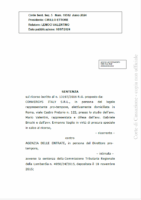
Italy vs Convergys Italy S.R.L, July 2024, Supreme Court, Case No 19512/2024
Convergys Italy Srl had provided call centre services to a related Dutch company for which it received a 5% mark-up on costs. Following an audit, the tax authorities found that the benchmark study on which the 5% was based included loss-making companies. After removing the loss-making companies, the median mark-up of the benchmark study was 7.42%. A tax assessment was issued adding the additional income to the taxable income. Convergys Italy Srl appealed, but the Provincial Tax Commission and the Regional Tax Commission later ruled in favour of the tax authorities. An appeal was then lodged with the Supreme Court. Judgment of the Court The Supreme Court ruled in favour of Convergys Italy Srl, stating that loss-making companies should only be excluded from the benchmark study if the losses are due to exceptional – not comparable – circumstances. Excerpt in English “…The company then proceeded to determine the mark-up applied to call-center services through the preparation of two transfer pricing studies, namely the Foundation Report, prepared at group level prior to the notice of the tax audit, and the National Transfer Pricing Documentation, prepared pursuant to Art. 26 of Decree-Law No. 78 of 31 May 2010, converted by Law No. 122 of 30 July 2010, as well as the Provision of the Director of the Revenue Agency of 29 September 2010; the latter documentation includes the benchmark analysis made by the company using the AIDA database, which collects data only from domestic companies. On the basis of these results, it can be inferred that the 5% value applied by the taxpayer company is positioned within the arm’s length range, being in the upper part of that range. Instead, the Office applied a higher normal value (7.42%), using different criteria, and in particular eliminating from the price analysis, for each tax year concerned, a number of companies with no accounting data or with negative operating results in at least two out of three tax years. The contested judgment found this methodology to be correct, and it must nevertheless be observed that such further criteria do not appear to be consistent with the OECD Guidelines and do not find any justification for the purpose of selecting (as envisaged by the aforementioned Guidelines) a sample of companies comparable to Stream Italy, since it is not possible to exclude in advance certain potentially comparable companies merely because they have recorded reduced and/or negative results in some years. In fact, it is normal that in a market of free competition there are also loss-making companies, or in any case companies lacking certain accounting data. In fact, the OECD guidelines themselves, in paragraph 1.59 et seq. admit that one of the factors determining comparability are company strategies, and therefore provide for the inclusion in the benchmark analysis of those companies that, in order to penetrate a given market or to increase their share in the same market, set a price for their products that is lower than the price charged on the market for comparable products, or temporarily incur higher costs and therefore make lower profits than other taxpayers operating in the same market. The OECD Guidelines do not provide for the elimination tout court of loss-making companies or companies with low or no book values, if these results are achieved in order to obtain better results in future years; according to para. 3.43, certain companies may be excluded when they are in ‘special situations’, such as start-ups, bankrupt companies, etc., if it is clear that these special situations do not represent appropriate comparisons. It was precisely this analysis that was completely omitted by the C.T.R., which apodictically considered the Office’s criterion to be valid, without making any assessment of the situation of the companies excluded from the comparison. Moreover, the appellant had pointed out that the Office, in the process of forming the sample of companies for the benchmark analysis, had included companies that for size and/or activity carried out could not have been comparable with Stream Italy s.r.l., and on this point the C.T.R. did not make any factual analysis. With specific reference, then, to the costs relating to the management services “Executive”, “Facilities” and “IT”, provided by the parent company Stream Europe, it should be noted that the costs incurred by a company for the purchase of services, on the basis of a contract entered into with other entities belonging to the same group, satisfy the conditions set forth in Article. 109 of Presidential Decree No. 917/1986 (inherence, objective determinability, certainty and effectiveness), which allow their deduction, if the group company documents the contracts in which the services received are provided for and regulated. In the present case, the appellant produced, at first instance, a contract for intra-group services, detailing the types of services that Stream Europe provided to Stream Italy s.r.l. and illustrating the manner in which those services were remunerated. Consequently, the C.T.R. should have analysed this contract in order to verify whether or not the conditions for the deduction of such costs were actually met.” Click here for English translation Click here for other translation
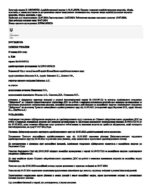
Ukrain vs Dniproazot, July 2024, Supreme Administrative Court, Case № 160/3387/22
Following an audit, the tax authority determined that prices for controlled transactions had been below the arm’s length price and issued an assessment of additional taxable income. According to the tax authority, the correct application of the arm’s length principle in this case required the price of the controlled transaction to be compared with the prices (price range) of comparable uncontrolled transactions on the basis of the information available on the date closest to the date of the controlled transaction – and not on the date where the controlled contract had been concluded. An appeal was filed by Dniproazot with the Administrative Court of Appeal, which was later dismissed. An appeal was then filed with the Supreme Court. Judgment The Supreme Court upheld the decision of the Administrative Court of Appeal. The Court agreed with the conclusions of the tax authority that the information regarding commodity exchanges could not be applied, since the exchange is used for transactions with derivative financial instruments, rather than agreements for the supply of real goods. The Court altso supported the tax authority’s position that the arm’s length price should be determined at the date of the controlled transaction (the date of the transfer of ownership of the goods) and not at the date of the conclusion of the controlled contract. Click here for English translation Click here for other translation
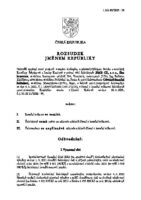
Czech Republic vs ESAB CZ, s. r. o., June 2024, Supreme Administrative Court, Case No 1 Afs 80/2023 – 64
Following an audit, the tax authorities concluded that ESAB CZ, a Czech contract manufacturer, had improperly excluded certain costs from the cost base used to calculate its profit margin on controlled transactions. By adjusting the cost base, ESAB CZ had effectively reduced its tax base. As a result, the tax authorities issued an assessment where they had increased the taxable income for the company. ESAB CZ appealed, arguing that the cost in question – an accounting write-off of the valuation difference in the annual amount of CZK 68 455 846 – should not be included in the cost base when calculating its arm’s length margin (TNMM, ROTC). The Regional Court dismissed the appeal and the case ultimately ended up in the Supreme Administrative Court. Judgment of the Court. The Supreme Administrative Court upheld the decision of the Regional Court and dismissed the appeal. Excerpt in English “[47] The complainant has never disputed that the assets to which the valuation difference relates are not related to contract manufacturing or that the valuation difference is related to any of its other activities. The complainant argued that the valuation difference (as an item resulting from the conversion) was not related to contract manufacturing within the meaning of transfer pricing terminology, since the amortisation of the valuation difference was not, from the perspective of manufacturing, an operating expense that should be included in the cost base under the OECD Guidelines. [48] However, the transaction in question and the related adjustments to the tax base cannot be viewed from a purely accounting perspective, but rather from a transfer pricing perspective. Transactions between related parties must be examined in terms of the functional and risk profile, the relationship of costs and benefits to the controlled transactions between related parties. Thus, the costs in the form of the amortisation of the valuation difference should have entered into the calculation of the complainant’s profitability as they affect transfer prices, because of their relationship to the assets related to the complainant’s production activities. [49] For the sake of clarity, the SAC summarises that, in the present case, the depreciation of the valuation difference related to assets whose transfer resulted from the Project and was the essence of the division by spin-off (a part of the assets related to the production activity was split off, while a part of the assets related to the business activity was retained in the company being divided). This resulted in a valuation difference of approximately CZK 1 billion on the acquired assets. It corresponded to the difference between the expert valuation of the assets transferred to the complainant and the sum of the values of the individual assets and liabilities in ESAB VAMBERK’s accounts. The resulting difference in the revaluation of the assets and the subsequent depreciation of the revaluation of those assets could not have been influenced by the complainant. Through the Manufacturing Agreement, the complainant was assured a profit determined on the basis of the Benchmarking Analysis and the resulting market spread. The Complainant’s business was primarily group-driven (99 % of its production was directed to related parties and 93 % of the Complainant’s production was directed to the group). The consequences of decisions taken by another company in the group cannot be passed on to the complainant, thereby reducing its profits by those items excluded from the cost base. The Regional Court’s conclusion that the costs in the form of depreciation on the difference in the revaluation of assets should be included in the calculation of the complainant’s profitability is therefore entirely correct, since the main reason is precisely the relationship of that depreciation to the assets relating to the operating and production activities of the complainant which were transferred to it. [50] It is apparent from the administrative file that the complainant had no control over its position as a manufacturer or over the fact that this activity would be its only source of profit. The view of the tax authorities, with which the Regional Court agreed, that the consequences of decisions taken by another company in the group could not be passed on to the complainant, thereby reducing its profits by those items excluded from the cost base, is therefore entirely unsound. [51] The SAC, like the Regional Court, is convinced that the amortisation of the valuation difference should have been included in the cost base for calculating the contractual mark-up in accordance with point 2.83 of the OECD Guidelines. The complainant’s objection that the tax authorities should have followed point 2.84 of that Directive cannot be accepted. The cost in question relates to a dependent transaction. Neither the tax authorities nor the Regional Court erred in examining the amortisation of the valuation difference in direct relation to the controlled transaction. The items at issue relating to the amortisation of the valuation difference are operational in nature (similar to accounting depreciation) and relate to contract manufacturing. Therefore, in accordance with the arm’s length principle, they should have been included in the cost base in the calculation of the profit margin under the TNMM. In the present case, neither the depreciation should have been excluded from the operating result nor from the cost base for calculating the contractual mark-up; on the contrary, the relevant mark-up should have been due to the complainant. This is because the profit generated by the complainant from the production activity under assessment was significantly affected by this cost accounting item (the amortisation of the valuation difference).” Click here for English Translation Click here for other translation
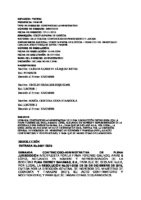
Panama vs Puma Energy Bahamas SA, June 2024, Supreme Court, N° 849112020
Puma Energy Bahamas SA is engaged in the wholesale of petroleum products, accessories and rolling stock in general in Panama. Following a thorough audit carried out by the Tax Administration in Panama, where discrepancies and inconsistencies had been identified between the transfer pricing documentation and financial reports and other publicly available information, an assessment was issued for FY 2013 and 2014 of additional taxable income of $39 million resulting in additional taxes and surcharges of approximately $ 14 millions. Puma Energy Bahamas SA disagreed with the assessment and brought the case before the Administrative Tribunal. In 2020 the Administrative Tribunal decided in favor of the tax authorities with a minor adjustment in the calculations for 2014. “…we consider that the Tax Administration adhered, in this case, to the powers conferred by law, and that there is no defenselessness, since it was verified that, in the course of the audit, several requests for information were made (as evidenced in the minutes of the proceedings in the background file), and then, in the governmental channel, after notification, the evidence requested by the plaintiff was admitted and practiced, in the first instance, having carried out the corresponding procedural stages.” “In view of the above, we consider that the taxpayer should have been consistent in the handling of the financial information used, and calculate the gross margin in accordance with the guidelines established in our legislation…” “In this sense, it is noteworthy that a method was chosen that weighs the margins, rather than the price of the product, when the part analysed is exclusively dedicated to the distribution of oil, a product that has a public market price, and in the Panamanian case, there is a suggested price for its purchase and sale to the consumer.” “Based on the calculations described in the previous point, no adjustment would be necessary to the calculation of the additional settlement for the period 2013, as it coincides with the work carried out by the tax authorities (see Table n.). 40 to sheet 309 of the background file). Therefore, we will only proceed with the adjustment of the taxpayer’s financial information for the 2014 period, specifically the cost of sales, in order to bring it to the median of the interquartile range, reflecting, for clarity, a comparative analysis of the adjustment made in the first instance, with the findings described in this resolution” An appeal was then filed by Puma Energy Bahamas SA with the Supreme Court. Notice The Supreme Court upheld the decision of the Administrative Tribunal and ruled in favour of the tax authorities. Consequently, ruling TAT-RF-062 of the Tax Administrative Court (TAT) of September 10, 2020, on the transfer pricing adjustment for purchases made with its related parties abroad for $39 million corresponding to the periods 2013 and 2014, is confirmed. Click here for English translation Click here for other translation
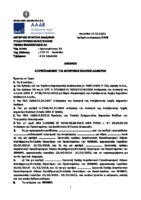
Greece vs “B Electro Ltd”, May 2024, Administrative Tribunal, Case No 1632/2024
“B Electro Ltd” is a wholly owned subsidiary of the “B Electro group” “which is one of the leading worldwide suppliers of technology and services with 468 subsidiaries and agencies in 60 countries around the world. In order to document the pricing of purchases and sales of goods from/to related companies, “Electro Ltd” had applied the net transaction margin method (TNMM), using itself as tested party and selected external comparative data using the TP Catalyst database and used ROS as PLI. An audit of intra-group transactions for the tax year 2018 was carried out, inter alia, and accounting differences were identified due to non-compliance with the arm’s length principle in the invoicing of intra-group transactions, and in particular the invoicing of the category of transactions involving purchases and sales of goods from/to related companies. The tax authorities found that 6 out of the 10 comparables were not sufficiently comparable and conducted a benchmark that showed that the return on sales for “B Electro Ltd” was out side of the interquartile range. On that basis an assessment of additional income was issued where the income had been adjusted to the median. A complaint was filed by “B Electro Ltd” with the Administrative Tribunal claming that the tax authority had misapplied the chosen transfer pricing method. Decision The Tribunal upheld the assessment of the tax authorities and rejected the appeal of “B Electro Ltd”. Excerpts in English “Because, in the present case, in order to achieve the intra-group transaction and in order to ensure that the nature and terms thereof do not deviate unduly from the terms of a transaction between independent undertakings, comparability factors are taken into account, referring in principle to the contractual terms, the prevailing economic conditions, the specific strategy of each undertaking, but also the specific characteristics of the goods and services provided, such as their quality, availability and volume of supply on the market, which largely determine the quality, availability and volume of supply of the goods and services. Since the sales volume of the auditee is not of a similar size to the sales volume of the companies in the audit sample, the audit selects the value which respects the principle of equidistance as the median value. Moreover, this choice is suggested by the OECD Guidelines (last updated version, July 2010) which, in paragraph 1.1, suggest that the audit should be carried out in accordance with the principle of proportionality. 3.57, state that: “It may be the case that, although every effort has been made to reject items that have a lower degree of comparability, the end result is a range for which, given the process used to select the comparable items and the limitations in the information available on the comparable items, some comparability flaws remain that cannot be identified or even quantified and are therefore not adjustable. In such cases, if the range includes a sufficient number of observations, statistical tools of central tendency to limit the range (e.g., the interquartile range, or other percentiles) can help improve the reliability of the analysis. “ In addition, in para. 3.61, they state that: “If the relevant condition of the controlled transaction (e.g., the price or margin) is outside the equidistance range calculated by the tax authority, the taxpayer should have the opportunity to present arguments that the price or margin of the controlled transaction adheres to the equidistance principle and that the result is within the equidistance range (i.e., that the equidistance range is different from that calculated by the tax authority). If the taxpayer is unable to demonstrate this fact, the tax authority should determine the point within the equidistance range at which the adjustment of the price or profit margin of the controlled transaction’, read in conjunction with paragraph 1. 3.62 of the OECD Guidelines, “In determining the point of adjustment where the range includes results of relatively equal and high reliability, any point in the range may be considered to comply with the principle of equidistance. Where comparability deficits remain, as discussed in paragraph 3.57, it may be appropriate to use measures of central tendency to determine this point (for example, the median, simple or weighted mean, etc., depending on the specific characteristics of the data sample) in order to minimise the risk of incorrectly selecting sixths of unknown or unquantifiable comparability deficits remaining.” Because, in the present case, the audit justified the calculation of the adjustment of the applicant company’s intra-group transactions by relying on the Greek and international context, while quoting the instructions of the tax authority and the critical passages of the OECD international guidelines, and the factual data of the case. Furthermore, he set out his reasoning in a clear manner, described the factual data and subordinated them to the provisions of the OECD Guidelines and the provisions of the Greek institutional framework on which he relied, while the audit report in question sets out in detail and accurately the procedure followed (rejection of the applicant’s sample, creation of a new comparable sample and calculation of the applicant’s net profit margin indicators for the application of the Net Transaction Profit Method (TNMM). Since, the findings of the audit, as recorded in the relevant partial income tax audit report of the C.E.M.E.P. dated 28/12/2023, on which the impugned act is based, are held to be valid, admissible and fully reasoned.” Click here for English translation Click here for other translation
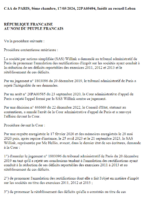
France vs Willink SAS, May 2024, CAA Paris (remanded), Case No 22PA05494
In 2011, Willink SAS issued two intercompany convertible bonds with a maturity of 10 years and an annual interest rate of 8%. The tax authorities found that the 8% interest rate had not been determined in accordance with the arm’s length principle. Willink appealed, but both the Administrative Court and later the Administrative Court of Appeal sided with the tax authorities. The case was then appealed to the Conseil d’Etat which in December 2022 overturned the decision and ruled predominantly in favour of Willink SAS finding that RiskCalc could be used to determine a company’s credit rating for transfer pricing purposes in a sufficiently reliable manner, notwithstanding its shortcomings and the differences in the business sectors of the comparables. On that basis the case was remanded to the Administrative Court of Appeal. Judgment After re-examination of the case, the Administrative Court of Appeal annulled the tax assessment and ruled in favour of Willink SAS. “12. It follows from the foregoing that SAS Willink provides the evidence incumbent on it that the interest rate applicable to the transactions at issue could not have been lower than that which would have been applicable to borrowing transactions of the same nature entered into by independent undertakings. It is therefore entitled to request the cancellation of the corporation tax adjustments that led to the reduction of its losses carried forward for the 2011, 2012 and 2013 financial years, and the reinstatement of those losses.” Click here for English translation Click here for other translation
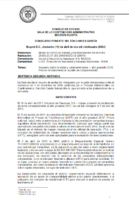
Colombia vs Sociedad de Fabricación de Automotores S.A., April 2024, Supreme Administrative Court, Case No. 25000-23-37-000-2016-01484-01 (27618)
The tax authority had issued an assessment of additional taxable income for FY2011 due to non-arm’s length pricing of transactions with foreign associated enterprises – purchase of inventory for distribution (CBU) and inventory for production (CDK). With regard to goods for distribution, the tax authority disagreed with the use of comparables from 2008 to 2010 and the screening criteria applied. With regard to inventory for production, the tax authority also disagreed with the transfer pricing method and some of the comparability adjustments made by Fabricación de Automotores S.A. Fabricación de Automotores S.A. appealed to the Administrative Court, which later ruled in its favour. The tax authority then appealed to the Supreme Administrative Court. Judgment The Supreme Administrative Court upheld the decision of the Administrative Court and ruled in favour of Fabricación de Automotores S.A. The Court found that the use of data from previous years was acceptable and that the transfer pricing method, benchmark study and comparability adjustments applied by Fabricación de Automotores S.A. were reasonable. Click here for English translation Click here for other translation
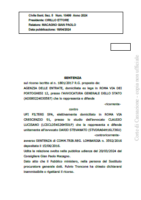
Italy vs UFI Filters, April 2024, Supreme Court, Case No 10499/2024
UFI Filters SpA had paid two related companies in China for the supply of filters in 2009 and deducted the costs from its taxable income. Following an audit, the tax authorities found, on the basis of a benchmark study of six comparable companies, that the mark-ups applied by the Chinese companies (39.77% and 17.2%) under the cost-plus method were not at arm’s length and issued a tax assessment of additional taxable income resulting from the reduction in the price and, consequently, the deductions. UFI Filters SpA appealed, arguing that the six companies were not comparable. The Provincial Tax Commission ruled against UFI Filters SpA, but the Regional Tax Commission later ruled in favour of UFI Filters SpA An appeal was then filed by the tax authorities with the Supreme Court. Judgment of the Court The Supreme Court upheld the decision of the Regional Tax Commission, and dismissed the appeal of the tax authorities. Excerpts in English “2.4. In indicating the criteria for the selection of the traditional transaction-based methods, the OECD Guidelines focus, as far as may be relevant here, on the cost-plus method. In particular, Section D of Part II of Chapter II of the 2017 OECD Guidelines – as well as the same guidelines in the 2010 edition – governs this method, which (see Section 2.45 et seq. OECD Guidelines) ‘considers first the costs incurred by the supplier of goods (or services) in a transaction between associated enterprises for goods transferred or services provided to a related buyer. An appropriate mark-up on the cost of production (cost plus mark-up) is then added to that cost in order to obtain an appropriate profit taking into account the functions performed and market conditions. The result of this transaction can be regarded as the arm’s length price of the original transaction between the associated enterprises. This method is most useful where the semi-finished products are sold between associated parties, where they have concluded agreements for the pooling of plant or long-term purchase-supply agreements, or where the transaction between the associated enterprises consists in the provision of services. The percentage mark-up on the supplier’s production costs in the course of a transaction between the associated enterprises shall be established by reference to the mark-up percentage which the same supplier obtains in the course of comparable transactions with independent third parties (‘internal comparables’). The percentage that would have been obtained in comparable transactions by an independent undertaking (‘external comparable’) may also be used as a benchmark”, stating in para. 47 that ‘(…) a transaction between independent parties is comparable with a transaction between associated enterprises for the purposes of the cost-plus method, if either of the following two conditions is met: (a) no differences (if any) between the compared transactions or between the enterprises entering into those transactions materially affect the mark-up percentage on the free market or (b) appropriate adjustments can be made to eliminate the substantial effects of those differences’. (…) 4.1. The Lombardy Regional Tax Commission extensively reconstructed the case examined on the basis of the allegations made by the parties, in particular highlighting that the six Chinese companies had been selected from a group of 44 companies as comparable third parties, substantially on the basis of the following characteristics, indicated by the Administration in the notice of assessment: they have the same activity code even if they do not produce the same goods, they do not own ‘Intangible fixed assets’, they belong to the same geographical area as the Chinese subsidiaries, and they have achieved an equivalent turnover. 4.2. It then observed (judgment, p. 13) that it was not possible ‘to find in the findings in the file, and consequently had to reject, the decisive ruling of the first judges who, in rejecting the taxpayer’s appeal, stated that the cost-plus methodology adopted by the Office – after identifying 6 companies selected to make up the sample of reference and comparison – for the verification of transfer priclng with the subsidiaries Ufi Filters Shanghai Ltd and Sofima Automotive Filter Shanghai Ltd ‘does not presuppose the identity of goods and services object of/activity, but requires the comparability of functions, risks or investments, affirming the entirely unproven circumstance that the 6 companies selected for comparison appear suitable for the purpose given the functional similarity with regard to design, production, assembly, research and provision of services, purchasing, distribution, marketing, management etc.. ‘’. 4.3. In this regard, the Regional Commission (judgment, p. 14) held that the Administration had not correctly identified the parameter against which it had identified the ‘normal’ price from which the taxpaying company would deviate, noting in particular that ‘In the present case, not only does the typology of the six companies chosen to make up the reference sample present unexceptionable inconsistencies at least with reference to the inconsistent type of production – e.g. cabins, tanks, gears and the like vs. high-tech filters – and to the geographic location – also considering the remote location of the companies of the sample within China in comparison with the location of the two subsidiaries located directly in the same port area of Shanghai – but above all no demonstration and/or evidence of the comparable ‘functions, risks or investments’ of the six companies of the selected sample appears to have been given, since any specific description relating to design, production, assembly, research, purchasing, distribution and marketing is absent, given that the only data made available are those of the balance sheet. The Commission then observes the erroneousness of the Office’s statement (see page 15 of the counter-deductions to the appeal on file) that would have the ‘almost totality of the sales’ of the subsidiaries as ‘occurring in favour of the parent company Ufi Filters spa’, while contradictorily the same Office affirms and highlights, as to the subsidiary Sofima Automotive Filter Shanghai Ltd. (…) 6. The ground of appeal is therefore unfounded and, moreover, manifestly inadmissible where it is, in truth, intended to call for a reassessment of the preliminary investigation compendium, albeit in the face of a coherent statement of reasons expressing a plausible outcome of the analysis
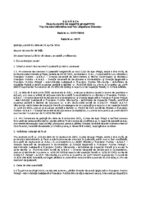
Romania vs “A Manufacturing S.R.L.”, April 2024, Supreme Administrative Court, Case No 2177/2024
A Manufacturing S.R.L. manufactures lifting and handling equipment and pays royalties to its French parent company B for the use of the group’s intangible assets – trademarks, etc. The arm’s length nature of the royalty payment had been determined indirectly using the TNMM to demonstrate that, even after paying the royalties, its profit was comparable to that of independent comparable companies. At the request of the tax authority, A SRL then submitted an additional analysis using the CUP method, which involved identifying and comparing royalty rates from supposedly similar licence agreements in a commercial database. During the following audit, the tax authority rejected four of the licence agreements that A S.R.L. had used as comparables. According to the tax authority, the four agreements in question did not meet the comparability criteria for two main reasons. First, the industry covered by these agreements was different from A S.R.L’s core business of manufacturing lifting and handling equipment, so they did not reflect similar economic circumstances. Secondly, the basis for calculating the royalties in these agreements was different from that of A. S.R.L. (they used cash flow, purchase price or another revenue measure), whereas A. S.R.L. paid royalties calculated as a percentage of net turnover. As a result, the tax authority did not consider these contracts to be comparable for the purpose of establishing an arm’s length range. Based on the revised benchmark, the tax authorities determined that the royalties (9% and later 11%) paid by A S.R.L. to B SRL exceeded the arm’s length range and the royalty rate was adjusted and a tax assessment issued. A S.R.L. challenged the assessment and in September 2022 the Court of Appeal annulled the tax assessment. The tax authorities appealed to the Supreme Administrative Court, arguing that the first instance court had not fully addressed their objections and had relied almost exclusively on a court-appointed expert’s report, Judgment The Supreme Administrative Court set aside the decision of the Court of Appeal and ruled in favour of the tax authorities. According to the court, the first instance court did not engage in a detailed analysis of the core transfer pricing issues. Specifically, it did not thoroughly examine whether the royalties were truly arm’s length over the relevant years, nor did it address all the tax authorities’ defenses and objections. As a result, the High Court set aside the lower court’s judgment and sent the case back for a thorough rehearing. Click here for English translation Click here for other translation
![UK vs BlackRock, April 2024, Court of Appeal, Case No [2024] EWCA Civ 330 (CA-2022-001918)](https://tpguidelines.com/wp-content/uploads/BlackRock-HoldCo-5-LLC-v-HMRC-Judgment-pdf-image-141x200.jpg)
UK vs BlackRock, April 2024, Court of Appeal, Case No [2024] EWCA Civ 330 (CA-2022-001918)
In 2009 the BlackRock Group acquired Barclays Global Investors for a total sum of $13,5bn. The price was paid in part by shares ($6.9bn) and in part by cash ($6.6bn). The cash payment was paid by BlackRock Holdco 5 LLC – a US Delaware Company tax resident in the UK – but funded by the parent company by issuing $4bn loan notes to the LLC. In the years following the acquisition Blackrock Holdco 5 LLC claimed tax deductions in the UK for interest payments on the intra-group loans. The tax authorities (HMRC) denied tax deductions for the interest costs on two grounds: (1) HMRC claimed that no loans would have been made between parties acting at arm’s length, so that relief should be denied under the transfer pricing rules in Part 4 of the Taxation (International and Other Provisions) Act 2010. (2) HMRC also maintained that relief should be denied under the unallowable purpose rule in section 441 of the Corporation Tax Act 2009, on the basis that securing a tax advantage was the only purpose of the relevant loans. An appeal was filed by the BlackRock Group with the First Tier Tribunal, which in a decision issued in November 2020 found that an independent lender acting at arm’s length would have made loans to LLC5 in the same amount and on the same terms as to interest as were actually made by LLC4 (the “Transfer Pricing Issue”). The FTT further found that the Loans had both a commercial purpose and a tax advantage purpose but that it would be just and reasonable to apportion all the debits to the commercial purpose and so they were fully deductible by LLC5 (the “Unallowable Purpose Issue”). An appeal was then filed with the Upper Tribunal by the tax authorities. According to the judgment issued in 2022, the Upper Tribunal found that the First Tier Tribunal had erred in law and therefore allowed HMRC’s appeal on both the transfer pricing issue and the unallowable purpose issue. The First Tier Tribunal’s Decision was set aside and the tax authorities amendments to LLC5’s tax returns were confirmed. An appeal was then filed by BlackRock with the Court of Appeal. Judgment The Court of Appeal found that tax deductions for the interest on the Loans were not restricted under the transfer pricing rules (cf. ground 1 above) but instead disallowed under the unallowable purpose rule in section 441 of the Corporation Tax Act 2009 (cf. ground 2 above). Excerpt regarding application of transfer pricing rules “34. Paragraph 1.6 of both the 1995 and 2010 versions of the OECD guidelines explains that what Article 9 of the model convention seeks to do is to adjust profits by reference to “the conditions which would have obtained between independent enterprises in comparable transactions and comparable circumstances” (a comparable “uncontrolled transaction”, as opposed to the actual “controlled transaction”). The 2010 version adds that this comparability analysis is at the “heart of the application of the arm’s length principle”, while explaining at para. 1.9 that there are cases, for example involving specialised goods or services or unique intangibles, where a comparability analysis is difficult or complicated to apply. 35. In its discussion of comparability analysis, para. 1.15 of the 1995 version states: “Application of the arm’s length principle is generally based on a comparison of the conditions in a controlled transaction with the conditions in transactions between independent enterprises. In order for such comparisons to be useful, the economically relevant characteristics of the situations being compared must be sufficiently comparable. To be comparable means that none of the differences (if any) between the situations being compared could materially affect the condition being examined in the methodology (e.g. price or margin), or that reasonably accurate adjustments can be made to eliminate the effect of any such differences. In determining the degree of comparability, including what adjustments are necessary to establish it, an understanding of how unrelated companies evaluate potential transactions is required. Independent enterprises, when evaluating the terms of a potential transaction, will compare the transaction to the other options realistically available to them, and they will only enter into the transaction if they see no alternative that is clearly more attractive. For example, one enterprise is unlikely to accept a price offered for its product by an independent enterprise if it knows that other potential customers are willing to pay more under similar conditions. This point is relevant to the question of comparability, since independent enterprises would generally take into account any economically relevant differences between the options realistically available to them (such as differences in the level of risk or other comparability factors discussed below) when valuing those options. Therefore, when making the comparisons entailed by application of the arm’s length principle, tax administrations should also take these differences into account when establishing whether there is comparability between the situations being compared and what adjustments may be necessary to achieve comparability.” Similar text appears at paras. 1.33 and 1.34 of the 2010 version. 36. As can be seen from this, it is essential that the “economically relevant characteristics” are “sufficiently comparable”, in the sense of any differences either not having a material effect on the relevant condition (term) of the transaction, or being capable of being adjusted for with reasonable accuracy so as to eliminate their effect. 37. Paragraph 1.17 of the 1995 version expands on the concept of differences as follows: “… In order to establish the degree of actual comparability and then to make appropriate adjustments to establish arm’s length conditions (or a range thereof), it is necessary to compare attributes of the transactions or enterprises that would affect conditions in arm’s length dealings. Attributes that may be important include the characteristics of the property or services transferred, the functions performed by the parties (taking into account assets used and risks assumed), the contractual terms, the economic circumstances of the parties, and the business strategies pursued by the parties…” Again, this is reflected in the 2010 version, at
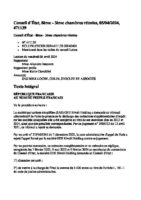
France vs GEII Rivoli Holding, April 2024, Conseil d’État, Case No 471139 (ECLI:FR:CECHR:2024:471139.20240405)
Following an audit of GEII Rivoli Holding’s accounts for FY 2013 and 2014, the tax authorities questioned the deductibility, beyond what resulted from the application of a “safe harbor” rate of 2,79% corresponding to the value mentioned in 3° of 1 of Article 39 of the French General Tax Code, of the interest paid to its parent company, at a rate of 5.08%, in return for a loan that the latter had granted it with a view to acquiring a building, and subjected it to additional corporate income tax assessments in respect of these two years. To justify the arm’s-length nature of this intragroup interest rate, the company provided two different methods. One method where the borrower’s credit risk (Baa1) was determined using a scoring model developed by Moody’s Analytics (RiskCalc) and another method where the credit risk of the borrower had been determined using based on the corporate bond yield curves provided by the S&P database. Both analyses were rejected by the tax authority and later the Administrative Court and the Administrative Court of Appeal. An appeal was then filed with the Conseil d’Etat. Judgment The Conseil d’Etat rejected the first method but accepted the second method and on that basis set aside the assessment of the tax authority. Excerpt in English “…in order to justify the validity of the rate it had chosen, the company submitted a new evaluation to the court, based on the calculation of two financial ratios, one of which, One of these ratios, known as the “loan-to-value” (LTV) ratio, relates the level of debt to the value of the company’s real estate assets, and in this case, by comparison with the ratios of listed French and European real estate companies, led to the conclusion that the financial rating it could have obtained would not have exceeded BBB. In order to justify that the rate of 5.08% paid to its parent company did not exceed the arm’s length rate, GEII Rivoli Holding argued, on the basis of bond market data taken from the Standard & Poor’s Capital IQ financial database, that at the date when the loan in dispute had been contracted, for euro-denominated transactions, the 10-year market interest rate for BBB-rated non-financial companies was 5.21%.9. In the first place, by rejecting this method, insofar as it made it possible to determine the company’s level of risk, on the sole ground that the LTV ratio in this case had been calculated by taking into account a financial debt corresponding exclusively to the loan whose rate had to be assessed, the court committed a first error of law.10. Secondly, in rejecting the rate resulting from the application of this method, the Court relied on the fact that GEII Rivoli Holding, in comparing its situation with that of larger real estate companies already present on the bond market, did not justify that a bond issue would have constituted a realistic alternative to an intra-group loan. By ruling out on this ground any possibility of comparison based on the rates charged on the bond market, when the size of a company is not in itself such as to hinder access to this market and when the realistic nature, for a company having recourse to an intra-group loan, of the alternative hypothesis of a bond issue can only be assessed in the light of the specific characteristics of the company and the transaction, with the rates observed on this market having to be adjusted where necessary to take account of the specific features of the company in question, the court committed a second error of law.11. Lastly, in rejecting the rate resulting from the application of this method, the court also relied on the fact that it had not been provided with any precisely identified comparables whose relevance it would have been able to assess. In so ruling, despite the fact that the arm’s length rate put forward by GEII Rivoli Holding as corresponding to its level of risk was based on the use of rate curves established on the basis of all the transactions recorded in the Standard & Poor’s Capital IQ financial database for loans of the same duration contracted by companies with the same risk profile, and that it was not argued that the transactions recorded in this database were unreliable, the court committed a final error of law.” Click here for English translation Click here for other translation
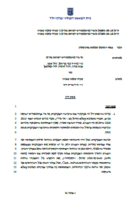
Israel vs eBay Marketplace Israel Ltd., April 2024, District Court, Case No AM 47399-04-18, AM 54654-05-19
An assessment was issued by the tax authorities in Israel where they had determined the income of eBay Israel based on the TNMM method using the operating margin as the profit level indicator. eBay Marketplace Israel Ltd. disagreed with the assessment and filed an appeal. Judgment of the District Court The court decided to return the case to the tax authorities for a reassessment. “…b. The new assessments will be issued on the basis of the assumption that the appellant is a Low risk distributor, as stipulated in the canceled assessments, but this while adjusting them for the profitability cycles relevant to managed sellers only. c. In addition, the new assessments must be adjusted for revised and updated transfer pricing work that you take into account the issues discussed above. This means: the “double” transactions of Israeli sellers and buyers must be reduced; Consideration must be given to the issue of double taxation considering the taxation that may be imposed for the same transaction in another country; The increase in transactions that originates from an increase in value must be considered the platform, which is not related to the activity of the business department as well as to the contribution of external bodies to the appellant; The various parameters for choosing the comparable companies must be re-examined; And finally, manual filtering should be performed as required…” Click here for English translation
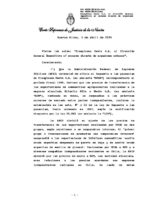
Argentina vs Oleaginosa Oeste SA, April 2024, Supreme Court, Case No. CAF 040430_2016_CS001
Following an audit, the tax authorities found that the transfer prices used by Oleaginosa Oeste SA for the export of agricultural commodities (soya bean oil and sunflower seed oil) to a related party in Switzerland were not at arm’s length. Oleaginosa Oeste SA appealed and the Tax Court partially annulled the assessment. This decision was later upheld by the Court of Appeal. The tax authorities then appealed the decision to the Supreme Court. Judgment of the Supreme Court. The Supreme Court partially overturned the decision of the lower court and remitted the case for reconsideration. The Court considered that the question of whether the transactions were sufficiently comparable for the application of the CUP method was of a factual and evidentiary nature and should be resolved by the judges. The Court found that the previous instances had not adequately addressed the lack of reliable evidence provided by Oleaginosa Oeste SA regarding the date of the sales to the related party in Switzerland, which led it to establish prices based on the date of invoicing. Click here for English Translation Click here for other translation
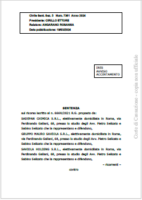
Italy vs Sadepan Chimica S.R.L., March 2024, Supreme Court, Sez. 5 Num. 7361 Anno 2024
Following an audit of Sadepan Chimica S.R.L., the Italian tax authorities issued an assessment of additional taxable income relating to non-interest bearing loans and bonds granted by Sadepan Chimica S.R.L. to its subsidiaries. The tax authorities considered that, in the financing relationship between the subsidiaries and the foreign associates – Polena S.A., based in Luxembourg, and Sadepan Chimica N.V., based in Belgium – the former had applied interest rates that did not correspond to the arm’s length value referred to in Article 9, paragraph 3, of the Italian Income Tax Code. U.I.R. As a result, the authorities issued separate tax assessments for the year 2013 claiming the higher amounts of interest income, calculated by applying an average rate of 3.83% for loans and 5.32% for bonds. Not satisfied with the assessment, Sadepan Chimica S.R.L. filed an appeal. The Regional Tax Commission (C.t.r.) confirmed the assessments and Sadepan Chimica S.R.L. filed an appeal with the Supreme Court. In the appeal Sadepan Chimica S.R.L. and its subsidiaries stated that the C.t.r. judgment were ‘irrelevant’ for not having analysed the general and specific conditions in relation to which the loans had been granted, and in so far as it held that it was for the taxpayer to provide evidence that the agreed consideration corresponded ‘to the economic values that the market attributes to such transactions. First of all, they claimed that the rules on the allocation of the burden of proof have been infringed; secondly, they complained of the failure to assess the evidence; they also claimed that the Office had used as a reference a market rate extraneous to the case at hand in that it was applicable to the different case of loans from financial institutions to industrial companies whereas it should have sought a benchmark relating to intra-group loans of industrial companies. They added that they had submitted to the judge of the merits, in order to determine in concrete terms the conditions of the financing, a number of elements capable of justifying the deviation from the normal value and, precisely a) the legal subordination of the financing b) the duration, c) the absence of creditworthiness, d) the indirect exercise of the activity through the subsidiaries; that, nevertheless, the C.t.r. had not assessed the economic and commercial reasons deduced. Judgment of the Supreme Court The Court ruled in favour of Sadepan Chimica S.R.L. and annulled the judgment under appeal on the grounds that it had failed to take account of the specific circumstances (solvency problems of the subsidiaries) relating to the transactions carried out by the related parties. Excerpts (English translation) “In fact, it still remains that a non-interest-bearing financing, or financing at a non-market rate, cannot be criticised per se, since it is possible for the taxpayer to prove the economic reasons that led it to finance its investee in the specific manner adopted. The rationale of the legislation is to be found in the arm’s length principle set forth in Article 9 of the OECD Model Convention, which provides for the possibility of taxing profits arising from intra-group transactions that have been governed by terms different from those that would have been agreed upon between independent companies in comparable transactions carried out in the free market. It follows from this conceptual core that “the valuation ‘at arm’s length’ disregards the original capacity of the transaction to produce income and, therefore, any negotiating obligation of the parties relating to the payment of consideration (see OECD Transfer Pricing Guidelines for Multinational Enterprises and Tax Administrations, paragraph 1.2). It is, in fact, a matter of examining the economic substance of the transaction that has taken place and comparing it with similar transactions carried out, in comparable circumstances, in free market conditions between independent parties and assessing its compliance with these (Cass. 20/05/2021, no. 13850 Cass. 15/04/2016, no. 749) Moreover, it is not excluded that intra-group gratuitous financing may have legal standing where it can be demonstrated that the deviation from the arm’s length principle was due to commercial reasons within the group, connected to the role that the parent company assumes in support of the other companies in the group (Court of Cassation 20/05/2021, no. 13850).” “In the OECD report published on 11/02/2020, on financial transactions, it is reiterated (as already stated in the OECD Commentary to Article 9 of the Model Convention) that, in intercompany financing transactions, the proper application of the arm’s length principle is relevant not only in determining the market value of the interest rates applied, but also in assessing whether a financing transaction is actually to be considered a loan or, alternatively, an equity contribution. It is also emphasised that, in order to distinguish a loan from an equity injection, among other useful indicators, the obligation to pay interest is of independent relevance. With reference to Italy, however, based on the application practice of the Agenzia delle Entrate (Circular No. 6/E of 30 March 2016 on leveraged buy-outs), the requalification of debt (or part thereof) into an equity contribution should represent an exceptional measure. Moreover, it is not ruled out that intra-group free financing may have legal standing where it can be demonstrated that the deviation from the arm’s length principle was due to commercial reasons within the group, related to the role that the parent company plays in supporting the other group companies. The Revenue Agency itself, already in Circular No. 42/IIDD/1981, had specified that the appropriateness of a transfer pricing method must be assessed on a case-by-case basis. “9.6. That being stated, this Court has clarified that, the examination by the court of merit must be directed along two lines: first, it must verify whether or not the office has provided the proof, which is due to it, that the Italian parent company has carried out a financing transaction in favour of the foreign subsidiary, as a legitimate prerequisite for the recovery of the taxation of the interest income on the loan, on the basis of the market rate observable in relation to loans
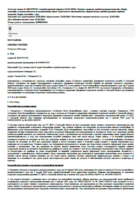
Ukrain vs Olympex Coupe International LLC, February 2024, Supreme Court, Case № К/990/675/24
Following a tax audit, the tax authorities concluded that the most appropriate method for determining Olympex’s income was the Transactional Net Margin Method (TNMM). However, in addition to the search criteria used by Olympex, the tax authorities added geographical and company size criteria. This resulted in higher margins for the comparables in the benchmark and an assessment of additional taxable income was made on this basis. Olympex disagreed with the assessment and appealed. The District Court upheld the appeal and quashed the assessment. The tax authorities appealed to the Court of Appeal, which in part overturned the decision of the District Court. Both parties then appealed to the Supreme Court, which remitted the case to the Court of Appeal for reconsideration. After re-examining the case, the Court of Appeal found largely in favour of Olympex, and the tax authorities then appealed to the Supreme Court. Final Judgment The Supreme Court upheld the decision of the Court of Appeal and dismissed the appeal of the tax authorities. Click here for English translation Click here for other translation
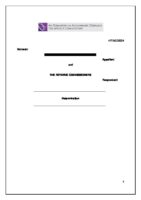
Ireland vs “Service Ltd”, February 2024, Tax Appeals Commission, Case No 59TACD2024
The Irish tax authorities considered that the cost of employee share options (stock-based compensation) should have been included in the cost basis when determining the remuneration of “Service Ltd” for services provided to its US parent company and issued an assessment of additional taxable income for FY2015 – FY2018. Service Ltd lodged an appeal with the Tax Appeals Commission. Decision The Tax Appeals Commission ruled in favour of “Service Ltd” and overturned the tax authorities’ assessment. Excerpts “271.The Commissioner notes that the nature of the comparability analysis performed for purposes of applying the TNMM necessitates comparing “like with like”. Paragraph 1.6 of the OECD Guidelines refers to the comparability analysis as “an analysis of the controlled and uncontrolled transactions”. The Commissioner notes paragraph 1.36 of the OECD Guidelines provides that: “…in making these comparisons, material differences between the compared transactions or enterprises should be taken into account. In order to establish the degree of actual comparability and then to make appropriate adjustments to establish arm’s length conditions (or a range thereof), it is necessary to compare attributes of the transactions or enterprises that would affect conditions in arm’s length transactions.” 272.Paragraph 3.2 of the OECD Guidelines provides that that: “[a]s part of the process of selecting the most appropriate transfer pricing method (see paragraph 2.2) and applying it, the comparability analysis always aims at finding the most reliable comparables”. 273.Paragraph 3.4 of the OECD Guidelines describes the typical process that can be followed when performing a comparability analysis. It states that: “This process is considered an accepted good practice but it is not a compulsory one, and any other search process leading to the identification of reliable comparables may be acceptable as reliability of the outcome is more important than process (i.e. going through the process does not provide any guarantee that the outcome will be arm’s length, and not going through the process does not imply that the outcome will not be arm’s length).” 274.The Commissioner observes that step 8 in the process is the “Determination of and making comparability adjustments where appropriate”, with the OECD Guidelines setting out guidance around such adjustments in paragraphs 3.47-3.54. 275.The Commissioner notes the Respondent’s correspondence to the Appellant dated 30 September 2021, which under a heading “Consideration of Comparability Adjustment”, it states that: “The OECD guidance indicates that comparability adjustments may only be made if appropriate to the results of the comparables identified and does not refer to adjustments to the financial results of the tested party. As a result, it is not appropriate to adjust the financial results of [the Appellant] in its statutory financial statements for the purposes of comparing with the NCP results of the comparables which are obtained from their statutory financial statements.” 276.The Commissioner observes that the Appellant in subsequent correspondence asserts that an adjustment to the financial results of the Appellant as the tested party to exclude the SBAs expense from its cost base is reasonable and enhances the reliability of the comparability analysis. The Respondent in its correspondence dated 30 September 2021, refers to paragraphs 3.47, 3.50 and 3.51 of the OECD Guidelines.” (…) “349. Having carefully considered all of the evidence, inter alia the viva voce evidence of the witnesses, the expert evidence, the case law and legal submissions advanced by Senior Counsel for both parties, in addition to the written submissions of the parties including, both parties’ statement of case and outline of arguments, the Commissioner has taken her decision on the basis of clear and convincing evidence and submissions in this appeal. In summary and having regard to the issues in this appeal, the Commissioner is satisfied that the answer to the issues as set out above in this determination, under the heading “the issues”, is as follows: (i) Was the Appellant correct to exclude in the calculation of its costs of providing the intercompany services, the expenses identified in the statutory financial statements of the Appellant in respect of the SBAs granted by the parent company to employees of the Appellant – Yes; (ii) If the Appellant was incorrect to exclude in the calculation of its costs of providing the intercompany services, the expenses identified in the statutory financial statements of the Appellant in respect of the SBAs granted by the parent company to employees of the Appellant, what, if any, adjustment is required – Not relevant, having regard to (i); (iii) The interpretation of section 835C and 835D TCA 1997 – An adjustment to profit rather than consideration is required; (iv) With respect to FY15, whether the Respondent was precluded from raising an amended assessment having regard to sections 959AA and 959AC TCA 1997 – Yes. 350. As set out, the Commissioner is satisfied that the Appellant has shown on balance that it was correct to exclude in the calculation of its costs of providing the intercompany services, the expenses identified in the statutory financial statements of the Appellant in respect of the SBAs granted by the parent company to employees of the Appellant. Hence, the appeal is allowed.”
![Kenya vs Beta Healthcare International Limited, February 2024, Tax Appeals Tribunal, Appeals No 866 of 2022 - [2024] KETAT 143 (KLR)](https://tpguidelines.com/wp-content/uploads/KRA-vs-Beta-Healthcare-2024-NW-pdf-image-141x200.jpg)
Kenya vs Beta Healthcare International Limited, February 2024, Tax Appeals Tribunal, Appeals No 866 of 2022 – [2024] KETAT 143 (KLR)
Following an audit of Beta Healthcare International Limited, a Kenyan subsidiary in the Aspen Healthcare Group, the tax authorities issued a notice of additional taxable income relating to controlled transactions, in which they had determined the arm’s length price for controlled transactions using the CUP method instead of the TNM-method as applied by the company. Beta Healthcare International Limited appealed to the Tax Appeals Tribunal, arguing that the tax authorities had failed in its characterisation of the company, failed to consider the comparability factors of the transactions and misapplied the transfer pricing guidelines. Decision of the Tax Appeals Tribunal The Tribunal dismissed the appeal and ruled in favour of the tax authorities. Excerpts “(…) 134. The Tribunal reviewed the parties’ pleadings and established that the Appellant attached the disputed information to its pleadings. However, the Respondent, both in its pleadings and orally at the hearing, urged that the information was never provided to it. Further, while the Appellant stated that it submitted the disputed information on 8th March, 2022, the Tribunal did not sight any document to confirm this averment. 135. In regard to selection of an appropriate Transfer Pricing method, Paragraph 2.1 of the OECD Guidelines provides that the selection of the transfer pricing method should consider the following; a. the respective strengths and weaknesses of the OECD recognised methods; b. the appropriateness of the method considered in view of the nature of the controlled transaction, determined through a functional analysis; c. the availability of reliable information (on uncontrolled comparables) needed to apply the selected method and/or other methods; and d. the degree of comparability between controlled and uncontrolled transactions, including the reliability of comparability adjustments that may be needed to eliminate material differences between them. 136. Additionally, Paragraph 3.20 of the OECD Guidelines states that, “ In order to select and apply the most appropriate transfer pricing method to the circumstances of the case, information is needed on the comparability factors in relation to the controlled transaction under review and in particular on the functions, assets and risks of all the parties to the controlled transaction, including the foreign associated enterprise(s).” 137. Paragraph 1.35 and 1.36 of the OECD Guidelines state as follows regarding comparable factors for the establishment of an appropriate Transfer Pricing method: “ 1.35. …Before making comparisons with uncontrolled transactions, it is therefore vital to identify the economically relevant characteristics of the commercial or financial relations as expressed in the controlled transaction. 1.36 The economically relevant characteristics or comparability factors that need to be identified in the commercial or financial relations between the associated enterprises in order to accurately delineate the actual transaction can be broadly categorised as follows: i. The contractual terms of the transaction; ii. The functions performed by each of the parties to the transaction, taking into account assets used and risks assumed, including how those functions relate to the wider generation of value by the MNE group to which the parties belong, the circumstances surrounding the transaction, and industry practices; iii. The characteristics of property transferred, or services provided; iv. The economic circumstances of the parties and of the market in which the parties operate; and v. The business strategies pursued by the parties.” 138. The Tribunal further notes that Paragraph 2.20 of the OECD Guidelines provides as follows in regard to application of the CUP method of Transfer Pricing: “ For the CUP method to be reliably applied to commodity transactions, the economically relevant characteristics of the controlled transaction and the uncontrolled transactions or the uncontrolled arrangements represented by the quoted price need to be comparable. For commodities, the economically relevant characteristics include, among others, the physical features and quality of the commodity; the contractual terms of the controlled transaction, such as volumes traded, period of the arrangements, the timing and terms of delivery, transportation, insurance, and foreign currency terms. For some commodities, certain economically relevant characteristics (e.g. prompt delivery) may lead to a premium or a discount. If the quoted price is used as a reference for determining the arm’s length price or price range, the standardised contracts which stipulate specifications on the basis of which commodities are traded on the exchange and which result in a quoted price for the commodity may be relevant. Where there are differences between the conditions of the controlled transaction and the conditions of the uncontrolled transactions or the conditions determining the quoted price for the commodity that materially affect the price of the commodity transactions being examined, reasonably accurate adjustments should be made to ensure that the economically relevant characteristics of the transactions are comparable. Contributions made in the form of functions performed, assets used and risks assumed by other entities in the supply chain should be compensated in accordance with the guidance provided in these Guidelines.” (Emphasis ours) 139. Separately, Paragraph 2.64 of the OECD Guidelines provide as follows regarding the application of the TNMM method: “ The transactional net margin method examines the net profit relative to an appropriate base (e.g. costs, sales, assets) that a taxpayer realises from a controlled transaction (or transactions that are appropriate to aggregate under the principles of paragraphs 3.9 -3.12). Thus, a transactional net margin method operates in a manner similar to the cost plus and resale price methods. This similarity means that in order to be applied reliably, the transactional net margin method must be applied in a manner consistent with the manner in which the resale price or cost plus method is applied. This means in particular that the net profit indicator of the taxpayer from the controlled transaction (or transactions that are appropriate to aggregate under the principles of paragraphs 3.9 -3.12) should ideally be established by reference to the net profit indicator that the same taxpayer earns in comparable uncontrolled transactions, i.e. by reference to “internal comparables” (see paragraphs 3.27-3.28). Where this is not possible, the net margin that would have been earned in comparable transactions by an independent enterprise (“external comparables”) may serve as a guide (see paragraphs 3.29-3.35).
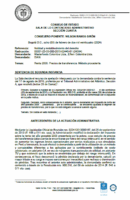
Colombia vs Masterfoods Colombia Ltda, Effem Colombia Ltda, February 2024, Supreme Administrative Court, Case No. 08001-23-33-000-2015-02445-01 (24364)
Following an audit, the Colombian tax authorities determined that Masterfoods Colombia’s results for FY2008 were outside the interquartile range and issued a tax assessment that adjusted the results to the median. The tax authorities had used the cost-plus method instead of the transactional net margin method used by Masterfoods. Masterfoods lodged an appeal, which was later upheld by the court of first instance. The tax authorities then appealed to the Supreme Administrative Court. Judgment The Supreme Administrative Court upheld the decision of the Court of First Instance to annul the assessment and ruled in favour of Masterfoods. Excerpts in English “Taking into account the aforementioned evidentiary study and the considerations set out in paragraph 2.1. above, for the Chamber, the cost plus method chosen by the defendant determines an arm’s length price based on the cost of production plus an appropriate gross profit margin, which implies the exclusion of operating expenses in the analysis of the comparable unrelated transaction. The TNMM method, on the other hand, examines the transaction on the basis of a net profit margin, i.e. the selling price minus the costs of the good and operating expenses. Comparing the two methods, the one established by the administration was based on the assumption that the internal comparables (customers of the plaintiff) used were relevant because the transactions assumed similar costs that were duly discriminated by third party according to the information provided by the taxpayer; however, the evidence in the file shows that the functions and risks assumed with the companies in the sample taken by the authority that ended up being the internal comparables, in contrast to the functions and risks assumed in the transactions with the related companies abroad, were different. In this regard, the transfer pricing study (specifically the financial information annex), the content of which was not challenged by the DIAN, segmented the manufacturing operation of the plaintiff taking into account the differences in functions and risks that materialised in higher expenses in operations with local independent companies, so that a method that considered only the gross profit could not be adopted. On the other hand, it is imperative to point out that this corporation is not unaware that the OECD guidelines have established that the cost plus method “is likely to be at its most useful” when applied, among other events, to sales of semi-finished products between associated parties; However, it is also true that the OECD explained that if the differences between the levels and types of expenses related to the functions performed and the risks assumed by the parties reflected a “functional difference” not considered at the time of applying the method, adjustments to the “margin over cost” might be required, so that the operating expenses incurred in the transactions with third parties, which materialised the exercise of higher functions and risks, could not be disregarded by the government in the transfer pricing analysis. Finally, the Chamber is aware that the application of the TNMM method by the plaintiff reflected that its profit margins in transactions with related parties were below the interquartile range set by the taxpayer itself, hence (in principle) the legal consequence provided for in paragraph 2 of Article 260-2 of the ET was appropriate. In this regard, the rule established as a mandatory mandate that, in all kinds of situations in which the factual assumption foreseen therein is verified, i.e. that the controlled transactions disregard the arm’s length principle because they are outside the range, the corresponding adjustment to the median must be made (judgment of 05 November 2020, exp. 21990, CP: Julio Roberto Piza Rodríguez)39. However, the content of the contested acts showed that the DIAN did not support the modification to the income tax report based on this fact, but chose to change the transfer pricing method used by the company, hence this Section is prohibited from making any modification in the first sense. Conclusion 2.4- In light of the above considerations, the Court concludes that the cost plus method applied by the defendant was not the appropriate one, as opposed to the TNMM method applied by the plaintiff in its transfer pricing study, taking into account the characteristics of the transactions analysed, the different functions and risks assumed by the company in the transactions carried out with related parties and independent third parties, a method which, although it showed that the transaction with related parties was outside the interquartile range, was not the basis for the amendment of the income tax return for the taxable year 2008. Regarding the appellant’s assertion that, in accordance with the OECD and the interpretative criteria, it was advisable not to make adjustments, which did not mean that they could not be made if necessary, as the rules themselves enshrine them, a premise under which it concludes that the appellant’s argument, The argument is incomplete, because although it recognises the possibility of making adjustments when they are required, even if it is not advisable, it does not support the reasons for their inappropriateness. In any case, according to the analysis carried out, it could be established that there were differences in comparability that ruled out the method chosen by the DIAN, which corresponded to the object of the debate. 3- In accordance with the analysis, this corporation finds that the addition of income derived from adjusting the transfer prices in the sales transactions carried out by the plaintiff to its related companies in Peru and Venezuela based on the use of a different method and comparables was not appropriate and, therefore, neither was the higher tax payable determined nor the penalties for inaccuracy and rejection of losses in accordance with the law. Consequently, the judgment of first instance will be confirmed, however, the second paragraph of the decision will be modified in the sense of adjusting the reinstatement of the right consequent to the declared nullity, that is to say, the private liquidation of the taxable year 2008 will be declared final.” Click here for English translation Click here
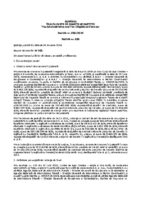
Romania vs “A Sugar Distributor S.A.”, January 2024, Supreme Administrative Court, Case No 530/2024
“A Sugar Distributor S.A.” processes and sells sugar, sourcing raw sugar both from affiliated entities and from independent suppliers. The company also purchases marketing, promotional, and logistical services from various retailers, with the costs invoiced back to A. S.A. During a tax audit, the authorities issued a tax assessment that included two major adjustments: first, disallowing the deduction of expenses for retailer-invoiced services on the grounds that they did not qualify as deductible business costs, and second, recalculating transfer prices on raw sugar purchases from an affiliated supplier (D.) after comparing those prices to New York commodity exchange quotes. “A Sugar Distributor S.A.” challenged the tax assessment. In April 2019, the Court of Appeal partly annulled it, holding that the retailer-invoiced services were indeed business-related and that the New York stock exchange prices were not appropriate comparables, given the uncertainties over origin and customs duties for raw sugar. However, the court rejected some of the company’s other claims (including one concerning the duration of the tax inspection), prompting both the taxpayer and the tax authorities to appeal. Judgment The Supreme Administrative Court dismissed both appeals. It concluded that the tax inspection was not invalidated by minor delays and that the lower court correctly applied binding precedents on the statute of limitations. It also upheld the Court of Appeal’s finding that the transfer pricing adjustment was unwarranted because the taxpayer could not simply rely on New York commodity exchange rates for raw sugar, given the specific EU import conditions and the associated cost uncertainties. Finally, it affirmed the deductibility of the retailer-invoiced services, agreeing with the lower court that these expenses were closely tied to the taxpayer’s sales operations and thereby satisfied the legal requirements for deductible costs. Click here for English translation Click here for other translation
Italy vs Terex Italia S.r.l., January 2024, Supreme Court, Cases No 2853/2024
Terex Italia s.r.l. is a manufacturer of heavy machinery and sold these products to a related distributor in the UK. The remuneration of the distributor had been determined based on application of the TNM-method. Following an audit for FY 2009 and 2010 the tax authorities served Terex a notice of assessment where adjustments was made to the taxable income in respect of a transfer pricing transaction, and in particular contesting the issuance of a credit note, in favour of the English company GENIE UK with the description “sales prices adjustment” recorded in the accounts as a reversal of revenue, in that, according to the Office, as a result of the adjustment made by the note, Terex would have made sales below cost to the English company, carrying out a clearly uneconomic transaction. In the same note, the non-deductibility of costs for transactions with blacklisted countries was contested. Terex lodged appeals against the assessments, but the Provincial Tax Commission upheld them only “in respect of the purchases from Hong Kong”, implicitly rejecting them in respect of the purchases made in Switzerland and explicitly rejecting them in respect of the disputed credit notes. An appeal was later rejected by the Regional Tax Commission. An appeal was then filed by Terex with the Supreme Court. In this appeal Terex stated that “The CTR, for the purposes of identifying the ‘normal value’ of the intra-group transactions relating to the relations with the English company GENIE UK, wrongly disallowed the applicability of the TNMM method (of the ‘net margin’), used by the taxpayer for the years 2009 and 2010 and presupposed the issuance of the contested credit notes and the relative reduction of the declared income, on the other hand, the Office considered that the CUP method (of the ‘price comparison’), used by the tax authorities in the findings relating to the same tax years, was applicable, with the consequent emergence of a higher taxable income, compared to that declared. The same Administration, on the other hand, with reference to the intra-group relations with the same company, located in the tax years 2007 and 2008 and subject to control without censure in the same audit, had not denied the applicability of the TNMM method, used by the taxpayer, which in such cases had led to the issuance of debit notes, with the relative increase in declared income.” Judgment of the Court The Supreme Court upheld part of the judgment (black listed costs) and refered part of it (Transfer pricing method and “sales prices adjustment”) back to the Regional Tax Commission for reconsideration. Excerpts in English 5.1. In particular, with regard to the method applicable for the purpose of determining the “normal value”, it has been clarified, with specific reference to the one referred to as the “TNMM”, that “On the subject of the determination of business income, the regulations set forth in Article 110, paragraph 7, of Presidential Decree no. 917 of 1986, aimed at repressing the economic phenomenon of “transfer pricing”, i.e. the shifting of taxable income following transactions between companies belonging to the same group and subject to different national regulations, requires the determination of weighted transfer prices for similar transactions carried out by companies competing on the market, for which purpose it is possible to use the method developed by the OECD which is based on the determination of the net margin of the transaction (so-called “TNMM”), which is based on the determination of the net margin of the transaction. “TNMM”), provided that the period of investigation is selected, the comparable companies are identified, the appropriate accounting adjustments are made to the financial statements of the tested party, due account is taken of the differences between the tested party and the comparable companies in terms of risks assumed or functions performed, and a reliable indicator of the level of profitability is assumed.” (Cass. 17/05/2022, no. 15668; the principle was shared by, among others, Cass. 12/09/2022, nos. 26695, 26696, 26697 and 26698; Cass. 28/04/2023, no. 11252).” “The adoption of the TNMM is particularly reliable when the functional analysis shows the existence of a party (tested party or tested party) to the controlled transaction that performs simpler functions and assumes less risk than the other party to the transaction (para. 2.64 et seq. OECD). In analogy to the RPM (Resale Price Method) or CPM (Cost Plus Method), it focuses on the profitability of the tested party in the controlled transaction, whereas it differs from it in that it operates at the level of net margins and not gross margins.” “Indeed, according to the OECD Guidelines (OECD, Guidelínes,1995), ‘The selection of a transfer pricing method is always aimed at finding the most appropriate method for a particular case. For this purpose, the following should be taken into account in the selection process: the respective advantages and disadvantages of the methods recognised by the OECD; the consistency of the method considered with the nature of the controlled transaction, as determined in particular through functional analysis; the availability of reliable information (especially on independent comparables) necessary for the application of the selected method and/or the other methods; the degree of comparability between controlled transactions and transactions between independent companies, including the reliability of comparability adjustments that are necessary to eliminate significant differences between them. No method can be used in all eventualities and it is not necessary to demonstrate the non-applicability of a given method to the circumstances of the particular case. Ministerial Circular No. 42 of 12 December 1981 also pointed out that the appropriateness of a transfer pricing method is assessed on a case-by-case basis.” “5.6. The importance that the TNMM has assumed in practice, as the most widely used means of determining transfer prices, has made it the subject of interest of the Eu Joint Transfer Pricing Forum (JTPF) body, set up by the European Commission, which, in 2019, drew up a document (EU JOINT TRANSFER PRICING FORUM, DOC: JTPF/002/2019/EN, SECTION 2), in which it describes its essential characteristics, among which, substantially tracing the
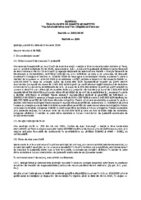
Romania vs “A Bottler S.R.L.”, January 2024, Supreme Administrative Court, Case No 304/2024
“A Bottler S.R.L.” carried out intra-group transactions in two main areas: producing (bottling) soft drinks and purchasing finished products for local distribution. In its transfer pricing file, it had used the transactional net margin method (TNMM) and analyzed data on a multi-year basis. It also adjusted certain large, one-off expenses (such as revaluation of land and buildings and reorganization costs) on grounds they were non-recurring items that should be excluded to ensure a proper like-for-like comparison. During the tax audit, however, the authorities recalculated the company’s results using annual figures (instead of multi-year averages) and reversed A. S.R.L.’s exclusion of those one-off expenses. They also changed how certain comparables were included or excluded in the benchmarking sample. The audit concluded that A. S.R.L.’s profits in the bottling and distribution segments were below the arm’s length range, leading to significant upward adjustments for corporate income tax. A. S.R.L. challenged these adjustments, arguing that the multi-year approach was justified under the OECD Guidelines, particularly given the timing for publicly available comparable data. It also maintained that treating the revaluation and reorganization costs as non-recurring was valid, because such expenses did not reflect its ordinary, year-to-year operating performance. Finally, it objected to the tax authority’s decision to introduce certain companies in the comparability sample that did not meet the independence criterion, while simultaneously excluding other companies that the taxpayer considered valid comparables. Judgment The Supreme Administrative Court sided largely with A. S.R.L., ruling that the authorities had overstepped by automatically favoring an annual approach without adequately considering the taxpayer’s multi-year rationale. It further held that big, isolated revaluation/reorganization expenses could indeed be set aside for transfer pricing margin calculations if they were truly exceptional and did not recur in ordinary operations. Lastly, the court found the tax authority had incorrectly included or excluded specific comparables—for instance, it added companies whose ownership structures likely made them ineligible and dismissed others despite those entities having valid data for the relevant years. Consequently, the High Court significantly reduced the transfer pricing adjustment and allowed most of A. S.R.L.’s original methodology, while confirming only a limited additional tax liability. Click here for English translation Click here for other translation
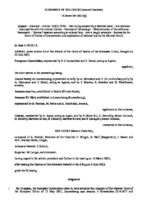
European Commission vs Amazon and Luxembourg, December 2023, European Court of Justice, Case No C‑457/21 P
In 2017 the European Commission concluded that Luxembourg had granted undue tax benefits to Amazon of around €250 million. According to the Commission, a tax ruling issued by Luxembourg in 2003 – and prolonged in 2011 – lowered the tax paid by Amazon in Luxembourg without any valid justification. The tax ruling enabled Amazon to shift the vast majority of its profits from an Amazon group company that is subject to tax in Luxembourg (Amazon EU) to a company which is not subject to tax (Amazon Europe Holding Technologies). In particular, the tax ruling endorsed the payment of a royalty from Amazon EU to Amazon Europe Holding Technologies, which significantly reduced Amazon EU’s taxable profits. This decision was brought before the European Courts by Luxembourg and Amazon, and in May 2021 the General Court found that Luxembourg’s tax treatment of Amazon was not illegal under EU State aid rules. An appeal was then filed by the European Commission with the European Court of Justice. Judgment of the Court The European Court of Justice upheld the decision of the General Court and annulled the decision of the European Commission. However, it did so for different reasons. According to the Court of Justice, the OECD Transfer Pricing Guidelines were not part of the legal framework against which a selective advantage should be assessed, since Luxembourg had not implemented these guidelines. Thus, although the General Court relied on an incorrect legal framework, it had reached the correct result. Click here for other translation
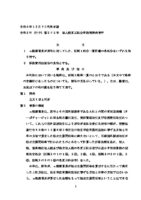
Japan vs “E Corp”, December 2023, Tokyo District Court, Case No 令和2年(行ウ)第372号, 372 of 2020
Plaintif, “E Corp” is a Japanese corporation whose business activities are focused on four business fields: resources and energy, public infrastructure, industrial machinery, and aeronautics and space. Through company B, E Corp owned the shares in Company A located in Thailand. Company A purchased vehicle turbocharger parts or components from “E Corp” or local suppliers, manufactured vehicle turbochargers under a licence agreement with E Corp and also recieved services from E Corp. It sold the turbochargers mainly to Japanese automobile manufacturers, and also both finished products and parts to E Corp’s other affiliated companies. Following an audit a dispute arose between E Corp and the tax authorities as to what transfer pricing method to apply. An assessment was issued where the tax authorities applied a “method equivalent to the Transactional Net Margin Method” “E Corp” filed a complaint which the district court alleging that the method used by the tax authoritis was not equivalent to a TNMM, and therefore the amount calculated by the tax authorities could not be considered at arm’s length. Judgment of the Court The Tokyo District Court overturned the tax assessment and upheld the E Corp’s claim. Click here for English Translation Click here for other translation

Ukrain vs Olympex Coupe International LLC, December 2023, Administrative Court of Appeal, Case № 420/19747/21
Following a tax audit, the tax authorities concluded that the most appropriate method for determining Olympex’s income was the Transactional Net Margin Method (TNMM). However, in addition to the search criteria used by Olympex, the tax authorities added geographical and company size criteria. This resulted in higher margins for the comparables in the benchmark and an assessment of additional taxable income was made on this basis. Olympex disagreed with the assessment and appealed. The District Court upheld the appeal and quashed the assessment. The tax authorities appealed to the Court of Appeal, which in part overturned the decision of the District Court. Both parties then appealed to the Supreme Court, which remitted the case to the Court of Appeal for reconsideration. Judgment of the Court After re-examining the case, the Court found largely in favour of Olympex. Click here for English translation Click here for other translation
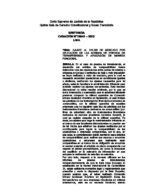
Peru vs Consorcio Minero Sociedad Anónima, November 2023, Supreme Court, CASACIÓN N° 19941-2023
The tax authorities disagreed with the comparables selected by Consorcio Minero Sociedad Anónima under the transactional net margin method and rejected some of the comparables and applied comparability adjustments (hedging losses and functional currency) to the remaining comparables. Consorcio Minero Sociedad Anónima was not satisfied with the resulting assessment of additional taxable income and filed an appeal with the Tax Court, which was subsequently dismissed. An appeal was then made to the Court of Appeal and later to the Supreme Court. Judgment The Supreme Court overturned the decision of the Tax Court and ruled largely in favour of Consorcio Minero Sociedad Anónima. This discretionary power should not be arbitrary, so it is unreasonable and unconscionable for the tax authority to try to compare the operating profit of Consorcio Minero Sociedad Anónima, which includes losses from commodity derivative financial instruments, with the operating profit of those companies that do not record such losses from commodity derivative financial instruments (for hedging purposes) but from currency derivative financial instruments (through forward contracts), which is recorded after the operating profit. In other words, the adjustments made by the tax administration cannot be such as to eliminate the adjustments made by the taxpayer to achieve comparability of comparables, where the administration should have maintained those comparability criteria, to make its adjustments or find transactions or companies that are truly comparable within the framework of its obligation to find the material truth, the arm’s length principle and respect for due process, as well as the search for balance in the asymmetry of information underlying the conduct of this type of study. Since Consorcio Minero Sociedad Anónima has carried out all transactions with its related companies in US dollars, this is its functional currency, and it is reasonable that the financial statements used to develop the transfer pricing report have been expressed in the same currency, in order to determine the margins or ratios corresponding to the application of the transactional net margin method – TNMM. Click here for English Translation Click here for other translation
Ukrain vs PJSC Odesa Port Plant, October 2023, Supreme Court, Case No 826/14873/17
Following a tax audit the tax authority conducted a on-site inspection of PJSC Odesa Port Plant on the completeness of tax calculation in respect of controlled transactions on the export of mineral fertilisers to non-resident companies Ameropa AG (Switzerland), “Koch Fertilizer Trading SARL (Switzerland), Nitora Commodities (Malta) Ltd (Malta), Nitora Commodities AG (Switzerland), Trammo AG (Switzerland), Trammo DMCC (United Arab Emirates), NF Trading AG (Switzerland) for FY 2013 and 2014, as well as business transactions on import of natural gas in gaseous form from a non-resident company Ostchem Holding Limited (Republic of Cyprus) for FY 2013. Based on the results of the inspection, an assessment of additional taxable income was issued. The assessment was based on the following considerations of the tax authority: – it is impossible to use the “net profit” method to confirm the compliance of prices in PJSC Odesa Port Plant’s controlled transactions for the export of mineral fertilisers in 2013 and 2014, since the “comparable uncontrolled price” method should have been used to determine the price in the said controlled transactions. The position of the tax authority is based on the fact that the application of the “net profit” method for determining the price does not allow to objectively determine the relevance of the price of the controlled transaction due to the lack of consideration of the impact of global trends in the nitrogen fertiliser market; information on derivative data available in officially recognised sources of information may be considered sufficient to determine the market price range (range of exchange prices) and calculate the level of arm’s length prices; in the presence of a market price range (range of exchange prices), – PJSC Odesa Port Plant’s transactions with Ostchem Holding Limited for the purchase of natural gas are controlled and PJSC Odesa Port Plant used the method of comparable uncontrolled price in determining the price in controlled transactions for the import of natural gas. However, PJSC Odesa Port Plant is a related party of PJSC Sumykhimprom, therefore, comparing the price in the controlled transaction with the prices in transactions that are also recognised as controlled. – it is not possible to use the “comparable uncontrolled price” method and it is appropriate to use the “net profit” method for natural gas import transactions, since no official source of information contains information on comparable uncontrolled transactions; it is not possible to adjust for the price of natural gas transportation from the European hub to the territory of Ukraine to ensure the proper level of comparability of the price in controlled transactions, and therefore the tax authority to find comparable transactions to apply the “net profit” method. It was found that the contract holder, Ostchem Holding Limited, did not perform any functions that could have influenced the increase in the sale price of natural gas. In the course of the audit, the Amadeus database was used to select independent companies that are comparable to Ostchem Holding Limited in terms of activities within the controlled natural gas import transaction. The sample included, in the tax authority’s opinion, independent companies with comparable activities and a similar functional profile to Ostchem Holding Limited. As a result of the search for comparable companies, 3 companies were selected, which, in the tax authority’s opinion, are fully comparable to Ostchem Holding Limited with key financial indicators for 2013. Based on the results of the analysis of the financial indicators of the comparable companies and the calculation of the range of profitability indicators, the tax authority found that the minimum value of the net profitability range for the comparable year 2013 was 0.04%, and the maximum value of the net profitability range was 1.51%. Thus, the net profitability of the controlled transaction with Ostchem Holding Limited exceeds the maximum value of the market range of net profitability of comparable companies by 30.34%. PJSC Odesa Port Plant disagreed with the tax assessment and filed an appeal. The district court upheld the appeal and dismissed the tax assessment. Subsequently, the Court of Appeal upheld the decision of the District Court and ruled in favour of PJSC Odesa Port Plant. The tax authority then appealed to the Supreme Court, which sent the case back to the Court of Appeal, which in the new trail upheld the tax authority’s assessment. This decision was then appealed to the Supreme Court – again – because, according to PJSC Odesa Port Plant, the Court of Appeal did not follow the instructions and conclusions of the Supreme Court in the course of the new procedure. Judgment of the Court The Supreme Court found that the violations of procedural and substantive law had been committed by the courts of first instance and appeal, and the failure to take into account the relevant correct conclusions of the Supreme Court, give grounds for sending the case for a new trial. In the new trail, it is necessary to take into account the above, to comprehensively and fully clarify all the factual circumstances of the case, verifying them with appropriate and admissible evidence, and to make a reasoned and lawful court decision with appropriate legal justification in terms of accepting or rejecting the arguments of the parties to the case. Excerpt in English “Subparagraphs 39.2.2.8 – 39.2.2.9 of paragraph 39.2.2 of Article 39.2.2 of the TC of Ukraine stipulate that, when determining the comparability of commercial and/or financial terms of comparable transactions with the terms of the controlled transaction, the characteristics of the markets for goods (works, services) where such transactions are conducted are analysed. At the same time, differences in the characteristics of such markets should not significantly affect the commercial and/or financial terms of the transactions conducted there, or such differences should be taken into account when making the appropriate adjustment. In determining the comparability of the characteristics of markets for goods (works, services), the following factors are taken into account: geographical location of markets and their volumes; the presence of competition in the markets, the relative competitiveness of sellers and buyers in the market; the
Switzerland vs “A AG”, September 2023, Federal Administrative Court, Case No A-4976/2022
A Swiss company, A AG, paid two related parties, B AG and C AG, for services in the financial years 2015 and 2016. These services had been priced using the internal CUP method based on the pricing of services provided by B Ltd to unrelated parties. Following an audit, the tax authorities concluded that the payments made by A AG for the intra-group services were above the arm’s length price and issued a notice of assessment where the price was instead determined using the cost-plus method. According to the tax authorities, the CUP method could not be applied due to a lack of reliable data. Following an appeal the court of first instance ruled mostly in favor of the tax authorities. A AG then appealed to the Federal Administrative Court. Decision of the Court The Federal Administrative Court ruled in favour of A AG. According to the Court, the CUP method is preferred to other methods and other transfer pricing methods should not be applied in cases where data on comparable uncontrolled prices are available. Therefore, the tax authorities had not complied with the OECD transfer pricing guidelines. Click here for English translation Click here for other translation
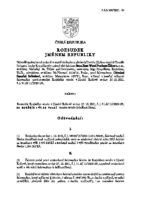
Czech Republic vs. Stora Enso Wood Products Ždírec s.r.o., August 2023, Supreme Administrative Court, No. 7 Afs 358/2021
Stora Enso Wood Products Ždírec s.r.o. is the Czech subsidiary of the Stora Enso Group, a multinational manufacturer of packaging and building products. In the years in question, Enso Wood Products Ždírec s.r.o. provided manufacturing services to its parent company and made losses. An audit was initiated by the tax authorities focusing on the method of determining transfer prices between related parties as defined in Article 23(7) of the Income Tax Act (which contains the Czech arm’s length principle). On the basis of a functional and risk analysis (in which it examined the extent to which the applicant depended on the decision-making mechanisms of another entity in the group), the tax administration concluded that Stora Enso Wood Products Ždírec s.r.o. did not act as a fully-fledged independent entity in its production and related activities, but as a producer with a limited functional and risk profile, since its production activities were influenced by transactions and relationships with its parent company, SEWP, which provided direct direction, coordination and management, both in terms of personnel and in terms of the competences and decision-making powers which it, as a superior entity to the applicant, possessed. The business model set up by the parent company SEWP did not therefore allow the applicant to negotiate contractual terms with its customers, nor was the applicant directly responsible for the purchase and delivery of goods. In the proceedings, the tax authorities did not dispute that the production and sale of lumber by the applicant was made both to related parties and to unrelated third parties (hereinafter referred to as ‘independent customers’). However, what was relevant in the present case was the finding that the sales to independent customers were also influenced by the ‘orders’ of SEWP’s parent company. The tax authorities made a transfer pricing adjustment based on the transactional net margin method and issued an assessment of additional income. Stora Enso Wood Products Ždírec s.r.o. filed an appeal, and in 2021 the regional court decided in favor of the company. An appeal was then filed by the tax authorities with the Supreme Administrative Court. Judgment of the Court The Supreme Administrative Court overturned the lower court’s decision and ruled in favour of the tax authorities. Excerpts “…the tax authorities took the legal view that the principle that a company should not be forced to carry out transactions which are disadvantageous to it applies in a group. If a controlling person (typically the parent company) exerts its influence to implement a transaction which causes the company to suffer a pecuniary loss, the controlling person is obliged to compensate the company for the relevant loss by the end of the accounting period at the latest, or, at least within the same period, to conclude an agreement with the company in which the manner and time limit for compensating such loss are agreed. In the present case, since the applicant did not prove how the loss incurred in the determination of the sales prices applied between the applicant and its business partners (related and unrelated parties) was compensated by the parent company, nor did it explain why it was not adequately compensated for its service to the multinational Stora Enso group in its income, the tax authorities proceeded to determine the normal price and to increase the income tax base by the difference found. [18] In the light of the above, the Court finds that, in so far as the Regional Court held in the judgment under appeal that the tax authorities had unlawfully applied Section 23(7) of the Income Tax Act or Article 9 of the double taxation treaty to the applicant’s transactions with its independent customers, who were not demonstrably connected persons, that argument cannot be upheld. “ “…Since the applicant, on the instructions of its parent company, was selling its products below its operating costs and thus losing profit, the applicant should, according to the tax authorities, have received a payment from its parent company to compensate for the loss thus incurred (the difference between its profitability and that of independent comparable operators). Therefore, on the basis of the relevant evidence, the tax authorities concluded that a service was provided between the applicant and its parent company SEWP, thereby creating a relationship between them to which Section 23(7) of the Income Tax Act could be applied. The complainant then defined the service in question as ‘a service consisting in bearing risks which are beyond the control of the taxable person and which are determined by related parties’ (see paragraph 99 of the contested decision). [19] With regard to the Regional Court’s assertion that the tax authorities should have distinguished whether the business transactions were made with related parties or with unrelated third parties, since the applicant’s sales to unrelated parties amounted to 60 % in terms of both production and revenue, the Supreme Administrative Court, in agreement with the complainant, states that this issue may be relevant at the stage of determining the price of the service performed by the applicant for the parent company. In the present case, however, the Regional Court did not assess whether the price of the service was correctly set, but only whether the first condition was met, i.e. whether Section 23(7) of the Income Tax Act was applied to the relationship of related parties.” Click here for English Translation Click here for other translation
Spain vs Tomas Bodero, S.A., July 2023, Tribunal Superior de Justicia, Case No STSJ CL 3218/2023
Tomas Bodero S.A. added a 4% fee when re-invoicing goods purchased from unrelated manufacturers to its Panamanian subsidiary. The transfer pricing documentation stated that “this fee (4%) is very similar to the fee that brokers in the sector usually charge for brokering imports of goods, so it can be concluded that a market price is charged for the services that the parent company provides to the subsidiary”. Following an audit, the tax authorities issued a tax assessment which, among other adjustments to the taxable income, also adjusted the fee received from the subsidiary. The arm’s length fee for the service provided was set at approximately 26% of the purchase price. Appeals were filed by Tomas Bodero S.A. which ended up in the High Court. Judgment of the Court In regards of procurement fee, the Court ruled in favor of Tomas Bodero A.S. Excerpts “….the method used by the Inspectorate to calculate the transfer prices is sufficiently justified; the internal comparable method is the method which, in general and a priori, provides a greater degree of accuracy and legal certainty given that it is obtained from the prices established by the interested party. However, regardless of the objections raised by the appellant regarding the sampling used by the Inspectorate – limited to a single month of the financial year and including a single Latin American client – and the possible discrepancies as regards the correct identification of the goods, the fact is that the tax authorities have not at any time called into question the specific business/financial intermediation and management model developed between the Spanish parent company and the Panamanian subsidiary. …the Inspectorate [does not] question the fact that the goods are at no time at the physical disposal of the parent company, since the supplier’s dispatch is made directly in Latin America. …we must understand that the (higher) price compared by the Inspectorate, in addition to the commercial margin of the resale itself, includes the cost of intermediation of the independent agent, which is not the case with the (lower) price re-invoiced by the parent company to its filial, which acts as a commercial intermediary with the retailers in Latin America. In fact, in the only invoice compared by the Inspectorate issued directly by the plaintiff to a Latin American customer -FacVen/9758, dated 5 January 2015- the filial TB LATAM is listed as “agent”, whereas, as we said, in the invoices issued by the appellant to its filial the legend “re-invoicing” appears. In other words, we cannot consider logical or reasonable the criterion of the Inspectorate that the price invoiced by the appellant to retailers for resales with agent intermediation is comparable to the price re-invoiced directly by the parent company to its filial in an operation of mere financial intermediation and management -without the intervention of a commercial agent, a task carried out by the filial itself-, all of which leads us to annul the regularisation for this concept. Click here for English Translation Click here for other translation
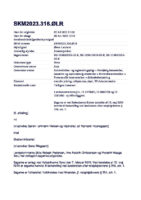
Denmark vs “Soy A/S”, June 2023, Eastern High Court, SKM2023.316.ØLR
Two issues were adressed in this case – transfer pricing and withholding taxes. The transfer pricing issue concerned whether the Danish tax authorities (SKAT) had been entitled to issue an assessment on controlled transactions made between “Soy A/S” and a flow-through company in the group located in a low tax jurisdiction. The withholding tax issue concerned whether the 13 transfers actually constituted taxable dividends under section 31, D of the Danish Corporation Tax Act, which “Soy A/S” was subsequently liable for not having withheld tax at source, cf. section 69(1) of the Danish Withholding Tax Act. Judgment of the High Court In regards of the transfer pricing issue, the High Court found that the company’s TP documentation was subject to a number of deficiencies which meant that the documentation did not provide the tax authorities with a sufficient basis for assessing whether the transactions were made in accordance with the arm’s length principle. The High Court emphasised, among other things, that the documentation did not sufficiently describe how prices and terms had actually been determined. The High Court also emphasised that there had only been a very general description and very sparse information about the sister company’s business activities, contractual terms and financial circumstances, including no information about to whom and at what prices the goods from the sister company were resold. SKAT was therefore entitled to make a discretionary assessment of the company’s taxable income. The High Court found no basis to set aside SKAT’s estimate, as the company had neither demonstrated that the estimate was exercised on an erroneous basis nor led to a manifestly unreasonable result. The High Court emphasised, among other things, the extent and nature of the deficiencies in the information basis and the fact that SKAT had unsuccessfully attempted to obtain additional information for use in the tax assessment. As regards the arm’s length interval used by SKAT, the High Court found, after an overall assessment, that SKAT had been entitled to use the interquartile range and adjusted the price to the third quartile. The High Court stated that the company had a central and value-creating function in the group, and that the comparability analysis was based on “limited risk distributors”, which were not directly comparable with the company. The High Court also found that the foreign sister company had to be considered a pure flow-through company that had no independent business justification in the group. In this connection, the High Court stated that there had been changing information about the sister company’s employees and that there was no documentation that there had been employees to carry out the alleged activities in the company. The analyses prepared after the tax assessment, including the capital adjustment test and the berry ratio analysis, as well as the other factors invoked by the company could not lead to a different assessment. In regards of the withholding tax issue the High Court found that the foreign sister company could only be considered to have acted as a flow-through company that did not bear any risk with the commodity trade. The High Court emphasised, among other things, that no hedging contracts had been presented. In light of the other circumstances of the case, the High Court found that the 13 transfers, which did not take place until 2010, could not be considered to have been made pursuant to the aforementioned agency agreement. The High Court stated that in the situation at hand, the company had a heightened burden of proof that there was no basis for considering the payments as subsidies/dividends with derived liability for withholding tax. The High Court found that the Danish company had not met this burden of proof through the testimony of the company’s former CEO and auditor. Finally, the High Court found that the Danish company was aware of all the circumstances surrounding the transfers to the foreign sister company in Y1 country, and that the transfers were very significant without documentation. On this basis, the High Court found that the Danish company had acted negligently and was therefore liable for the missing withholding tax, cf. section 69(1) of the current Withholding Tax Act, cf. section 65(1). Click here for English translation Click here for other translation
Colombia vs Drummond LTDA, June 2023, Counsil of State, Case No. 25000-23-37-000-2013-01285-01 (24727)
At issue was whether or not comparability adjustments made for exchange rate differences were appropriate, when the risk for such variations was assumed by the tested party. Judgment The Supreme Administrative Court found that the adjustments that had been made to improve the reliability of the comparability analysis were reasonable and decided in favour of Drummond LTDA. The Court specified that comparability factors that must be verified include significant economic functions or activities, including the assets used and risks assumed in the transactions by the parties to the transaction, including those that are caused by variations in the exchange rates, since these may affect the price or profit margin. Click here for English translation
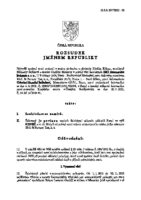
Czech Republic vs ERT Automotive Bohemia s.r.o., June 2023, Supreme Administrative Court, Case No 10 Afs 257/2022
ERT Automotive Bohemia s.r.o. is active in the automotive industry. From 1 January 2013 to 30 November 2013, it provided the manufacture and repair of upholstery products for the automotive industry for its ‘sister’ company, Reiner Lasertec GmbH, established in Germany (both companies were owned at the time by the parent company Notos Beteiligungen GmbH, also established in Germany). ERT Automotive Bohemia s.r.o. provided ‘wage labour’ for Reiner Lasertec at a price of EUR 0,15 per minute of work. In December 2013, ERT Automotive Bohemia s.r.o. changed this business model. It no longer simply processed materials for Reiner Lasertec, but instead took over its former role. It was thus responsible for the production of the entire specific automotive part, which it then supplied as an independent manufacturer and final supplier. The Tax Office suspected that ERT Automotive Bohemia s.r.o. had supplied services to a related party from January to November 2013 at a lower price than would have been agreed between independent parties pursuant to section 23(7) of the Income Tax Act. Following a tax audit, it therefore assessed ERT Automotive Bohemia s.r.o. by way of an additional assessment for corporate income tax for FY 2013. ERT Automotive Bohemia s.r.o. criticised the tax authorities for ‘comparing incomparables’ – that is to say, for comparing the activities and costs as a subcontractor and of Reiner Lasertec as the final supplier. However, Reiner Lasertec, as the final supplier, was, unlike ERT Automotive Bohemia s.r.o., in charge of, for example, negotiations with customers. ERT Automotive Bohemia s.r.o. also pointed out that, according to the tax authorities’ calculations, as a mere manufacturer, it should be making unprecedented profits (for that position in the production chain) in terms of wages. ERT Automotive Bohemia s.r.o. succeeded in an appeal to the Regional Court, which referred the case back for further proceedings. According to the Regional Court, the tax authorities did not bear the burden of proof or the burden of proof as regards the determination of the reference price and the difference between the agreed price and the reference price. Nor did they deal with the argument that the agreed price for the services provided to Reiner Lasertec covered all its costs as well as a reasonable profit. They did not take sufficient account of the fact that ERT Automotive Bohemia s.r.o. acted as a subcontractor in the controlled transaction, whereas in the independent transaction it was already acting as an independent manufacturer. Judgment of the Supreme Administrative Court The Supreme Administrative Court upheld the decision of the Regional Court and ruled in favour of ERT Automotive Bohemia s.r.o. Excerpts “[15] However, the tax authorities suspected that until November 2013 the applicant had provided its services ‘below cost’. The tax authorities first intended to adjust the applicant’s tax base by approximately CZK 7,5 million, based on the reference price determined by the TNMM (net margin method). However, he subsequently (also following the applicant’s objections) proceeded to establish a new reference price using the CUP (comparable independent prices) method. In determining the second reference price, the administrator compared the original transaction between the applicant and Rainer Lasertec (or the provision of services by the applicant from January to November 2013) with the subsequent transaction between the applicant and Boshoku Automotive. He then attempted to ‘clean up’ the independent transaction with Boshoku Automotive so as to compare only comparable activities, i.e. the part of the production that the applicant was also providing before December 2013 (the essential part of the dispute being whether the complainant succeeded in doing so). And it concluded that the applicant had indeed provided its services to Reiner Lasertec until November 2013 ‘below cost’, i.e. at a lower price than would have been agreed under similar conditions between independent persons…” “[21] First of all, the selection of the independent transactions with which the tax authority wants to compare the controlled transaction is already under scrutiny: ‘the selection of independent transactions and, if they are not fully comparable, the appropriate method of their adjustment must be made on the basis of objective, fair and reviewable criteria’ (8 Afs 80/2007). When determining the reference price, the tax authorities must primarily base themselves on existing independent transactions which are at least at their core comparable to the controlled transaction.” “[29] At the most general level, the SAC recognises that a transaction which is broader in scope than the controlled transaction and which incorporates the subject matter of the controlled transaction (i.e., for example, the present independent transaction) may also serve as an independent transaction in determining the reference price. As the SAC has already stated above, the range of transactions that can be used for comparison is wide (cf. paragraph [21]). After all, the SAC has even gone so far in the past as to allow the tax authorities to use a transaction between related parties as an independent transaction, but with a price determined by an expert opinion (cf. cases 1 Afs 143/2017, cited above, paragraph 26, and 3 Afs 105/2017, paragraph 22). [30] However, even such an independent transaction must be comparable, at least in substance, to a controlled transaction. It must at least be eligible for subsequent correction. What comparability means, at least at its core, is of course to be determined on a case-by-case basis. In general, however, the subject matter of the controlled transaction must form an essential part of the wider arm’s length transaction – so that the arm’s length price is agreed with respect to it. If the subject matter of the controlled transaction were only a marginal, insignificant part of the wider arm’s length transaction, it would become unworkable. Similarly, it is important that the position of the parties to the broader arm’s length transaction, in particular that corresponding to the position of the taxpayer in the controlled transaction, should not differ substantially. It is only if these conditions are met that the adjustment of the arm’s length transaction will make any sense – otherwise the tax authorities would
Hungary vs “Electronic components Manufacturing KtF”, June 2023, Supreme Court, Case No Kfv.V.35.415/2022/7
“Electric Component Manufacturing KtF” is a Hungarian subsidiary of a global group that distributes electronic components in more than 150 countries worldwide. The tax authorities had conducted a comprehensive tax audit of the Hungarian company for the period from 1 October 2016 to 30 September 2017, which resulted in an assessment of additional taxable income. The transfer pricing issues identified by the tax authorities were the remuneration received by the Hungarian company for its manufacturing activities and excessive interest payments to a group company in Luxembourg. Judgment of the Supreme Court The Supreme Court set aside the judgment of the Court of Appeal and ordered the court to conduct new proceedings and issue a new decision. In its decision, the Court of Appeal had relied on an expert opinion, which the Supreme Court found to to be questionable, because there were serious doubt as to its correctness. Therefore, according to the order issued by the Supreme Court, the Court of Appeal may not undertake a professional assessment of the expert opinion that goes beyond the interpretation of the applicable legislation, nor may it review the expert opinion in the new proceedings in the absence of expertise. Excerpt “[58] In relation to the adjustment of the profit level indicator for manufacturing activities, the expert found that comparable companies do not charge taxes such as the local business tax and the innovation levy as an expense to operating profit, the amount of which distorts comparability, this is a clearly identifiable difference in the cost structure of the company under investigation and the comparable companies, so an adjustment should be made in accordance with the OECD guidelines and the Transfer Pricing Regulation, because the statistical application of the interquartile range restriction cannot be used to increase comparability. However, the Court of First Instance held that it was not disputed that, even if the interquartile range as a statistical method was used, it might be necessary to apply individual adjustments, but that the applicant had not provided the audit with a detailed analysis of the justification for the adjustment and had not provided any documentary evidence in the course of the two administrative proceedings to show how the adjustment applied served to increase comparability. However, the application for review relied on the contradictory nature of the reasoning in this respect, since, while the Court of First Instance criticised the lack of documentation to support the adjustment {Ist judgment, paragraph 34}, it shared the expert’s view that this would indeed require an investment of time and energy which taxpayers could not reasonably be expected to make {Ist judgment, paragraph 35}. [59] On the other hand, the judgment at first instance explained that the applicant had only carried out research in the course of the administrative proceedings into whether the countries of the undertakings used as comparators had a similar type of tax burden to the Hungarian local business tax, and the expert had referred in his expert opinion to the fact that the applicant had only identified this one difference when carrying out the comparative analysis, but, if a detailed analysis is carried out, each difference can be individually identified and quantified and it is for this reason that the OECD guidelines also allow a range of results to be taken into account, because it reduces the differences between the business characteristics of the associated enterprises and the independent companies involved in comparable transactions and also takes account of differences which occur in different commercial and financial circumstances. Thus, the expert did not share the expert’s view that, while the narrowing to the interquartile range includes differences that are not quantifiable or clearly identifiable, individual adjustments should always be applied in the case of clearly identifiable and quantifiable significant differences. Thus, the trial court took a contrary view to the expert on this issue. [60] Nor did the Court of First Instance share the expert’s view in relation to the interest rate on the intercompany loan granted to the applicant by its affiliate and did not accept the expert’s finding that the MNB’s interest rate statistics were an averaging of the credit spreads of the debtor parties involved in the financing transactions, on an aggregated basis and, consequently, the use of the MNB interest rate statistics is not in itself capable of supporting or refuting the arm’s length principle of the interest rate applied in intra-group lending transactions, whether long or short-term. Nor did it accept the method used and described by the applicant in the comparability field, since it did not consider that the applicant should have used an international database to look for comparative data, since comparability was questionable. Furthermore, it considered irrelevant the expert’s reference to the fact that the average loan interest rates in Hungary in 2016 were strongly influenced by the low interest rates on subsidised loans to businesses and criticised the fact that the expert did not consider it necessary to examine the applicant’s current account loans under the cash-pool scheme. [61] It can thus be concluded that the Court of First Instance, in its judgment, did not accept the reasoning of the private expert’s opinion and made professionally different findings from those of the expert on both substantive points. [62] The opinion of the appointed expert is questionable if a) it is incomplete or does not contain the mandatory elements of the opinion required by law, b) it is vague, c) it contradicts itself or the data in the case, or d) there is otherwise a strong doubt as to its correctness [Art. 316 (1) of the Civil Code]. The private expert’s opinion is questionable if a) the case specified in paragraph (1) is present [Art. 316 (2) a) of the Civil Code]. Section 316 of the Private Expert Act specifies and indicates precisely in which cases the expert’s opinion is to be considered as a matter of concern. Thus, the expert’s opinion is of concern if it is incomplete, vague, contradictory or otherwise doubtful. The latter case
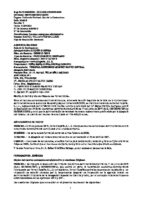
Spain vs Ferroli España, S.L.U., May 2023, Audiencia Nacional, Case No 3400/2023 – ECLI:EN:AN:2023:3400
Ferroli España, S.L.U. is a Spanish manufacturer manufacture of cookers and heaters. In FY 2010 and 2011 the company had various transactions with other companies in the Ferroli Group and reported negative profit margins on these transactions. According to the company this was due to the financial crises in Spain. Following an audit, the tax authorities issued a notice of assessment where the profit of Ferrolia had been adjusted resulting in additional taxable income. The TNN method had been used and profits were adjusted to the median. An appeal was filed by Ferroli. Judgment of the Court The Court largely ruled in favor of the tax authorities, but according to the Court, an adjustment to the median could only be made where the tax authorities established the existence of comparability defects. Since sufficient proof of such defects had not been established, the adjustment was reduced to the lower quartile (3 % ROS). Excerpts “We are therefore within the scope of point 3.61 of the OECD Guidelines, which states: “If the relevant terms of the controlled transaction (e.g. price or margin) are outside the arm’s length range determined by the tax administration, the taxpayer should be given the opportunity to argue how the terms of the controlled transaction satisfy the arm’s length principle, and whether the result falls within the arm’s length range (i.e. that the arm’s length range is different from that determined by the tax administration). If the taxpayer is not able to demonstrate these facts, the tax administration must determine the point within the arm’s length range to which to adjust the condition of the controlled transaction”.” “Well, the Central Economic-Administrative Court justifies the application of this rule in the following reasoning: “finding ourselves in a situation in which the margin used is out of range, and the reasons have not been accredited, we have to say that we consider it correct to apply the median or central tendency for the determination of the net operating margin between the company’s sales (in this sense, section 3.57 of the OECD Directives”. In the judgment of this Chamber and Section of 4 February 2021 (ROJ: SAN 416/2021, FJ 2.10), we have summarised the interpretative position on the conditions under which recourse to rule 3. 61 of the OECD Guidelines, as expressed in the judgment of 6 March 2019 (ROJ: SAN 1072/2019), in the following terms: “it is legitimate to resort to what the Guideline calls “measures of central tendency”, but whoever resorts to them has the burden of reasoning and setting out the reasons that lead to their application”. In the aforementioned judgment of 6 March 2019 (ROJ: SAN 1072/2019, FJ 3), the improper application of the disputed rule by the Tax Administration was reasoned as follows: “In short, it seems to us that, in effect, once it has been determined that the appellant’s ROS in the year under discussion is outside the lowest interquartile range – 2.1% – it is appropriate, in effect, to carry out the corresponding adjustment. But the fact that this occurs does not, without more, allow the median to be applied in the terms provided for in rule 3.62, since the application of that rule is not justified by the fact of being outside the range of full competence, but rather by the existence of “defects in comparability”, which according to the arguments of the TEAC itself were not acceptable in 2008 and, by extension, neither would they be acceptable in relation to 2007″.” As we can see, the contested decision incurs in the same deficiency of reasoning that we appreciate in the precedent cited above, beyond the differences between the different factual assumptions being tried, as the Central Economic-Administrative Court considers the appeal to the median to be plausible due to the mere existence of a deviation from the range of full competence determined by the Tax Administration. The justification offered by the assessment agreement and which the respondent administration reiterates in its reply, that the margins obtained are too wide, is not sufficient to consider that the burden of reasoning and setting out the reasons that lead to the application of the median in accordance with the provisions of rule 3.61 of the OECD Guidelines, that is to say, due to the persistence of defects of comparability, has been fulfilled. The reasoning offered by the tax authorities that the margins are too wide, having accepted that in 2011 the arm’s length range is within an interquartile range between 3.60 and 6.90 per cent, is not considered sufficiently expressive of the reasons that would support the application of the median in the sense stated above. The plea on this point is upheld and the application of the lowest point of the arm’s length range determined by the tax authorities (3%) is considered appropriate, with the legal effects inherent in this statement.” Click here for English translation Click here for other translation
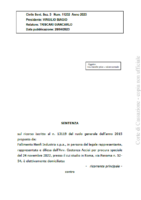
Italy vs Menfi Industria s.p.a., December 2022, Supreme Court, Cases No 11252/2023
Menfi Industria s.p.a. is a manufacturer of household goods – appliances, crockery, stainless steel items. Following an audit the tax authorities served Menfi Industria a notice of assessment for FY 2008. According to the tax authorities the company had sold products to another group company, at a price lower than the normal value. The adjustment was determined using the TNMM method. Other non-transfer pricing adjustments were also made in the assessment. An appeal was filed by Menfi Industria, which the court of first instance found to be well-founded in regards of leasing fees, depreciations etc., but in regards of the transfer pricing adjustment the appeal was dismissed. Subsequently, the Lombardy Court of Appeal confirmed the decision of the first instance court. Menfi Industria then appealed to the Supreme Court. In its appeal Menfi Industris pointed out that, with regard to the issue of the sale of intra-group assets at a price lower than the normal price, the court of appeal ruled in an apodictic and tautological manner, essentially confining itself to affirming the legitimacy of the recovery only by stating that the methodology applied, i.e. the TNMM, was correct, without offering any specific argument as to the legitimacy. Menfi Industria further argued, that the judgment was contradictory in that, after stating that the arm’s length price was determined by the CUP method, the court in ist conclution stated that the methodology applied was correct, even though it was based on the TNMM. Judgment of the Supreme Court The Supreme Court set aside the judgment of the Court of Appeal and refered the case back to the court, in a different composition. Excerpts (…) “The appeal court, after pointing out, in its reasoning passage, that ‘normal value is determined by the method of comparing the average price or consideration charged’, arrives at the final consideration that the TNMM method applied is lawful, without this being logically supported by the main premise. This Court, (Cass. civ, No. 15668/2022), with specific reference to the Transactional Net Margin Method or TNMM, in referring to Section B of Part III of Chapter II of the OECD Guidelines of 2010 that regulates it, as, similarly, the subsequent edition of 2017, has had occasion to affirm the principle, which must be given further continuity here, according to which “on the subject of determining business income, the rules set forth in Presidential Decree No. 917 of 1986 Art. 110, paragraph 7, aimed at repressing the economic phenomenon of “transfer pricing”, i.e., the shifting of taxable income following transactions between companies belonging to the same group and subject to different national regulations, requires the determination of weighted transfer prices for similar transactions carried out by companies competing on the market, for which purpose it is possible to use the method developed by the OECD that is based on the determination of the net margin of the transaction (so-called “TNM”), which is the basis for the determination of the net margin of the transaction. “TNMM”), provided that the period of investigation is selected, the comparable companies are identified, the appropriate accounting adjustments are made to the financial statements of the tested party, due account is taken of the differences between the tested party and the comparable companies in terms of risks assumed or functions performed, and a reliable indicator of the level of profitability is assumed”. The judgment under review, as seen, reasoned, in the abstract, with regard to the application prerequisite set forth in Article 110, paragraph 7, cited above, but then deemed legitimate the TNMM method which, on the other hand, is not based on the comparison of the price charged for goods of the same or similar kind at the same state of marketing, but on the basis of the net margin of the transaction, thus showing a substantial contradiction in the motivational path. On the other hand, as has been said, the assessment of the correctness of the TNMM method applied required a verification of the assumptions legitimising its application, but the judgment under appeal totally failed to carry out, in its decisional reasoning, the necessary factual verifications in the identification of the transfer pricing method most appropriate to the case in hand, since it could not give relevance to the generic and abstract motivational passage according to which: ‘in the first analysis, the functions performed by the appellant company and the risks assumed by it were assessed’, since that passage of reasoning, devoid of specific factual elements of reference, cannot identify the necessary argumentative premise for the final conclusion to be correct. The second ground of appeal criticises the judgment, pursuant to Article 360(1)(3) of the Code of Civil Procedure, for breach and misapplication of Article 110(7) and (9) of Presidential Decree No 917/1986, for having held the TNMM method to be lawful, despite the fact that the aforementioned regulatory provisions require the application of the various traditional transactional methods as a matter of priority.” (…) “With reference to the present case, the appeal court held that the company had provided proof of the intra-Group supplies but then, again in part of its reasoning, stated that it rejected the company’s appeal. There is no possibility, on the basis of the content of the decision, of being able to hold that the expression ‘Evidence that has been provided by the company Menfi’, contains a mere material error, in the sense that, indeed, the court would have wanted to state that the evidence had not been provided: the expression finds its completeness in itself, there being no further motivational passage that would allow the second interpretative option to be preferred, resulting, in this case, in a judgment contrary to that expressly stated by the appeal court. In that regard, the present ground of appeal correctly states the intrinsic and unremediable inconsistency between the finding of fact made by the court and the subsequent ruling rejecting the company’s appeal.” Click here for English translation Click here for other translation
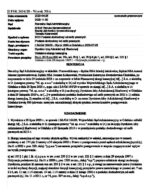
Poland vs “Fish Factory” sp. z o.o., April 2023, Supreme Administrative Court, II FSK 2636/20
The activity of Spółka A sp. z o.o. included salmon breeding, processing, smoking and sale and distribution of the finished products. The company operated within Group A with head quarter in the Netherlands. By decision of 27 May 2019, the tax authorities determined that the operating expenses determined by transactions with related parties were inflated by PLN 29,613,156.00. The authorities did not accept calculations presented by the Company, as there were no reliable accounting records regarding the amount of costs incurred. Furthermore, the authorities held that the cost plus method, which should guarantee profit on the transaction in the Company, had been applied incorrect. The dispute before the administrative Court was decided in favour of the tax authorities. An appeal was then filed by Spółka A sp. z o.o. with the Supreme Administrative Court. Judgment The Supreme Administrative Court dismissed the appeal and upheld the decision of the Administrative Court. “…. Taking into account the above provisions, it should be considered that the contested decision of 29/11/2019, annulling in its entirety the decision of the Head of the P. Tax Office in G. regarding the determination of the amount of income not giving rise to a tax liability for corporate income tax for 2013 in the amount of PLN 8,057,759.43 and referring the case for reconsideration by this authority, was issued before the expiry of the limitation period for the tax liability. The appellate body was therefore authorized to rule, as of the date of issue of the contested decision, on the company’s income tax settlements for 2013. The allegations raised by the complainant regarding the delivery of the notification of the Head of the Provincial Tax Office in G. dated 11 December 2019 on the suspension of the limitation period for the tax liability do not directly concern the contested decision of the Director of the Fiscal Administration Chamber in Gdańsk of 29 November 2019. As the complainant itself indicated, the notification on the suspension of the limitation period for the tax liability was issued by another authority, i.e. the Head of the Provincial Tax Office in G. on 11 December 2019, i.e. after the Director of the Fiscal Administration Chamber in Gdańsk issued the contested decision of 29 December 2019. Taking into account all the above circumstances, the Supreme Administrative Court, pursuant to Article 184 of the Code of Administrative Procedure, dismissed the cassation appeal, deeming it unfounded.” Click here for translation II FSK 2636-20 – Wyrok NSA ORG

Czech Republic vs LAKUM – KTL, a. s., April 2023, Regional Court, Case No 25 Af 62/2020
LAKUM KTL, a. s. had deducted from its taxable income costs for the purchase of advertising and promotional services from PRESSTEX MEDIA and PAMBROKE Media. Following an audit, the tax authorities concluded that LAKUM had entered into a legal relationship with PRESSTEX and PAMBROKE for the purpose of reducing the tax base. The tax authorities established reference prices on the basis that LAKUM could have entered into the contract for advertising and promotional services directly with the club concerned and, from the price range thus established, determined the arm’s length price for the services and increased the tax base accordingly. Decision of the Regional Court The Regional Court ruled in favour of the tax authorities on the pricing issue. Excerpts “37. The applicant first argued that the conditions for the application of the first sentence of Article 23(7) of the Income Tax Act were not met. According to that provision, if the prices agreed between related parties differ from the prices which would have been agreed between unrelated parties in normal commercial relations under the same or similar conditions, and if that difference is not satisfactorily substantiated, the taxpayer’s tax base is adjusted by the difference found. The concept of connected persons is defined in paragraph (b)(5) of the same provision as meaning that, for the purposes of this Act, connected persons are otherwise connected persons who have formed a legal relationship principally for the purpose of reducing the tax base or reducing a tax loss. 38. The applicant argued that a finding that the price obtained differs from the normal price is not sufficient to conclude that there are connected persons, otherwise the question of otherwise connected persons would be superfluous. At the same time, the applicant’s knowledge of that unreasonable increase must be established. He also argued that there was no profit on the part of the applicant, since he had actually spent the sums on advertising and the savings in the form of a reduced tax base were much smaller in relation to the costs incurred. 39. The Regional Court did not find any merit in this objection in its previous judgment. It has reached the same conclusion now. It did not consider it necessary to await the decision of the Extended Chamber in Case No 2 Afs 132/2020-56 of 22 December 2021 on the question whether ‘the finding of a significantly increased price of the subject-matter of the contract compared to the normal price without a satisfactory explanation of the difference is a sufficient condition for concluding that there is a combination of persons for the purpose of reducing the tax base or increasing the tax loss, or whether other facts in the conduct of the taxpayer indicating the unusual nature of the commercial transaction must be proved by the administration’. The reason for this is that the tax authorities based their conclusion that the parties were connected not only on the finding of an exorbitant price but also on other circumstances which suggest that the transaction was unusual. In its previous judgment, the Regional Court did not deal with them in detail, as it relied on the view, held by case law at the time, that the finding of an exorbitant price without a satisfactory reason was sufficient for the conclusion of connected persons within the meaning of Section 23(7)(b)(5) of the Income Tax Act (e.g. Supreme Administrative Court judgments of 13 June 2013, no. 7 Afs 47/2013-30, 28 January 2021, no. 3 Afs 393/2019-43 or 20 August 2021, no. 2 Afs 313/2019-43). The Court therefore found the applicant’s objection with regard to them irrelevant. In view of the question submitted to the Extended Chamber, its irrelevance is no longer apparent and the Regional Court will comment on them below, but there is no reason to wait for the decision of the Extended Chamber; even if it were to prevail that the definition of connected persons includes, in addition to the exorbitant price, the presence of such facts in the conduct of the tax entity as to indicate the unusual nature of the transaction, that could not have a favourable effect on the applicant’s procedural success in the case now under consideration. 40. In the case at hand, the tax authority raised doubts about the claimed costs, finding that the total costs incurred by the applicant’s suppliers PRESSTEX and PAMBROKE for advertising and promotional services for the year 2013 for the applicant amounted to CZK 56 104, while the applicant booked costs of CZK 6 000 000, representing 107 times the price paid by the suppliers PRESSTEX and PAMBROKE. The tax administrator’s doubts were also raised by other “non-standard circumstances” mentioned in the Tax Audit Report on pages 23-25, which are: – a change in the contractual terms, as the documents on the performance of the subject matter of the contract were delivered to the applicant after the end of the contractual relationship – discrepancies between the contract and the invoice and between the photographic documentation and the invoice (different size of the banner, failure to indicate advertising in the Golf Arena Ostrava, invoicing for advertising services even for months when no matches were played) – the applicant’s failure to comply with the payment terms – failure to verify the effectiveness of advertising costs – non-standardisation of the applicant’s suppliers PRESSTEX and PAMBROKE (non-contactability of PRESSTEX, virtual headquarters, cash withdrawals of large sums, company without a statutory body) – the failure to verify the price quotation, since the applicant accepted the price proposed by PRESSTEX without further investigation of the more advantageous quotation, even though the applicant could have recognised the overestimation of the price because it has long been active in the sports and business environment. 41. On the basis of the foregoing, the tax administration found that there was a relationship between the applicant and PRESSTEX and PAMBROKE corresponding to Article 23(7)(b)(5) of the Income Tax Act, and the defendant agreed with its assessment (see paragraph 90 of the contested decision). 42. The

Argentina vs Dart Sudamericana S.A., March 2023, Tax Court, Case No 35.050 I (IF-2023-35329672-APN-VOCII#TFN)
Dart Sudamericana S.A. (now Dart Sudamericana SRL) imported so-called EPS T601 pellets from related party abroad for use in its manufacturing activities. The controlled transactions had been priced using the CUP method. Following an audit the tax authorities made a transfer pricing adjustment where it had applied the transactional net margin method (TNMM). According to the tax authorities, the price paid for the pellets in the controlled transaction was higher than the arm’s length price. The adjustment resulted in an assessment of additional taxable income. Not satisfied with the assessment Dart Sudamericana filed a complaint. Tax Court Ruling The court upheld the assessment issued by the tax authorities and dismissed Dart Sudamericana’s appeal. Excerpts “In short, the appellant merely tried to prove the similarity of the product in order to carry out the price comparison, which is not sufficient for a proper study of the comparability of the transactions. At the risk of being reiterative, the transactions should be analysed, not only the products being traded. Therefore, the tax authority is right – as stated above – in its challenge to the application of the Comparable Price Method between Independent Parties – CUP or Uncontrolled Price – as a method of price analysis for the importation of EPS pellets and the application – entirely in accordance with the position taken by the appellant in the 2003 period – of the Transactional Net Margin Method for the 2004 tax period. “ “…In this regard, and as the Tax Court rightly pointed out, the OECD Committee on Fiscal Affairs has stated in its report that multi-year data are useful for providing information about the relevant business cycles and product life cycles of comparables. Differences in the business cycle or product cycle may have a substantial effect on transfer pricing conditions that must be assessed to determine comparability. Accordingly, in order to gain a full understanding of the facts and circumstances surrounding a controlled transaction, it may be useful to examine data for both the year under review and prior years. This type of analysis may be particularly useful when using one of the profit-based methods, as is the case here. The facts and circumstances of the particular case will determine whether differences in economic circumstances significantly influence the price, and whether reasonably accurate adjustments can be made to eliminate the effects of such differences” (Vid. CNACAF, Sala I, “Volkswagen Argentina S.A.”, 26/12/2019. The emphasis is my own). In this context, it is noted first of all that it is not clear from the appeals made, both in administrative proceedings and before this Court, that the use of multi-annual data was due to differences in the economic cycle of the industry under test. Likewise, it has not been proven that the economic situation the country went through in 2001 and 2002 existed in the countries of the companies used for the comparability study. The experts say nothing in their reports on the issue, limiting themselves to stating that national legislation does not prevent the use of multi-annual data, which – as mentioned above – is not in dispute. Therefore, and considering that the inclusion of data from 2001 and 2002 would inevitably increase the differences in comparability with companies abroad, I consider that the tax authority is right.” Click here for English Translation Click here for other translation
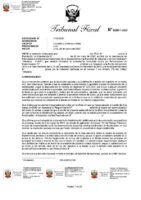
Peru vs “Merc & Parts S.A.”, March 2023, Tax Court, Case No 02387-1-2023
The Peruvian tax authorities (SUNAT) had rejected three comparables selected by “Merc & Parts S.A.” for a benchmark study on the grounds that they were loss-making. A transfer pricing adjustment was made and an assessment issued. “Merc & Parts S.A.” appealed to the Tax Court. Decision The Tax Court overturned the tax assessment issued by the tax authorities regarding the rejection of the three comparables. According to the court, the tax authorities had not justified the exclusion of the three comparable companies. According to the OECD guidelines, the fact that a comparable company is loss-making should lead to a more thorough analysis, but a comparable company should not be rejected for this reason alone. It must be demonstrated that the losses are due to exceptional – not comparable – circumstances, cf. paragraphs 3.64 and 3.65 of the OECD Transfer Pricing Guidelines. Click here for English translation Click here for other translation
Peru vs “Soybean-oil”, March 2023, Tax Court, Case No 02261-3-2023
“Soybean-oil” had purchased crude soybean oil from a related party and used the CUP method to price the controlled transactions. The tax authorities disagreed with the choice of method and instead applied a TNMM. On that basis an assessment of additional taxable profits was issued. Not satisfied with the assessment, “Soybean-oil” appealed to the Tax Court. Decision of the Court The Court set aside the assessment and ruled in favour of “Soybean-oil”. Click here for English Translation
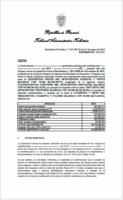
Panama vs “Spare Parts S.A.”, March 2023, Administrative Tribunal, Case No TAT-RF-019, Exp-100-19
“Spare Parts S.A. had transactions with related parties abroad for the purchase of inventory, administrative services, technical services, commissions, purchase of fixed assets, royalties and provision of administrative services. “Spare Parts S.A.” had used the Transaction Net Margin Method (TNMM) to determine the transfer prices for these transactions. Following an audit, the tax authorities found inconsistencies between the income tax returns and the transfer pricing reports. The tax authorities found that “Spare Parts S.A.” had excluded USD 6 million 956 thousand 967 from its general and administrative expenses in the calculation of the profit margin, by classifying these ordinary costs as extraordinary expenses. When the costs were included in the calculation, the profit of “Spare Parts S.A.” was below the range established in its transfer pricing study. The tax authorities therefore adjusted its operating margin to the median of 4.39%. Not satisfied with the adjustment, Spare Parts S.A. filed a complaint. Decision of the Court The Tax Court ruled in favour of the tax authorities, finding that the general and administrative expenses were ordinary costs that should have been included in the calculation. Click here for English translation Click here for other translation
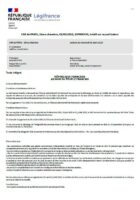
France vs SAS Sames Kremlin, March 2023, CAA de PARIS, Case No 21PA06439
SAS Sames Kremlin marketed its products abroad through subsidiaries or independent agents, depending on the territory. In Argentina, Brazil, India, Portugal and Russia it sold its products through subsidiaries under either a buy/sell distributor agreement or a commissionaire agreement. In Iran, Turkey and South Korea it sold the goods through independent agents to whom it paid a commission. The tax authorities considered that the commission paid to the independent agents was a CUP and determined the commission paid to the subsidiaries on that basis. The remuneration of the subsidiaries in excess of the commission (margin) paid to the independent agents was considered to be a transfer of profits abroad. SAS Sames Kremlin appealed against the assessment, arguing that the subsidiaries performed much more important functions than independent agents and that there were also significant geographical differences. The Administrative Court rejected the appeal and the case was then brought before the Administrative Court of Appeal. Judgment of the Court The Court upheld the decision of the Administrative Court and dismissed SAS Sames Kremlin’s appeal. Excerpt: “4. In order to justify the higher amount of remuneration paid to the subsidiaries of the group headed by SAS Sames Kremlin, compared with the amount paid to independent local intermediaries, SAS Sames Kremlin argued that the geographical markets in which the subsidiaries operated were fundamentally different from those in which the third-party sales agents operated, since they were highly strategic insofar as they were home to large car manufacturers, while the other markets were anecdotal. The subsidiaries responded to major invitations to tender, whereas the local sales agents were involved only in the supply of spare parts and small equipment, and the subsidiaries provided additional marketing, after-sales service, on-site assembly and testing of equipment, and assistance with the collection of debts, as evidenced by the significant human resources at their disposal. 5. Although the turnover achieved in Iran, Turkey and South Korea was generally lower than that achieved through the subsidiaries, it does not appear from the investigation that the characteristics of these markets justify the differences in the remuneration paid to the subsidiaries and to the independent intermediaries, since the turnover achieved by the subsidiaries is not systematically higher than the turnover achieved through independent sales agents. Even supposing that the composition of turnover achieved through independent sales agents is different from that achieved through subsidiaries, the latter including more sales of large equipment through tenders and fewer sales of spare parts and small equipment, which is not apparent from the investigation in the case of certain subsidiaries, it is common ground that the remuneration of independent sales agents does not take account of the nature of the products and equipment sold, since it is invariably set at 20% of turnover, and that the remuneration paid to subsidiaries is, irrespective of the nature of the products, equivalent to the amount of the discount they would have received if they had acted as a buyer-reseller. Finally, it is not apparent from the documents in the files that the services provided by the independent intermediaries are significantly less substantial than the services provided by the subsidiaries in their intermediation activity alone. The mere fact that the subsidiaries have greater material and human resources is not sufficient to presume, in the absence of documents in the file to that effect, that those resources were used in the context of the latter activity. It follows that, contrary to what is maintained, it does not follow from the investigation that the differences in remuneration between subsidiaries and intermediary agents can be explained by the different situation of those suppliers. Although the applicant company argues that the commissions paid to the subsidiaries take account of the margin which they would have made on a purchase/resale of the same product, such an argument is not such as to justify the abovementioned differences in remuneration between the economic agents belonging to the group and those outside it, since they are involved in the same intermediary activity, which is different from the purchase/resale activity. The various doctrines referred to, which are not expressly invoked on the basis of the provisions of Article L. 80 A of the Book of Tax Procedures, do not interpret the tax law differently from the above. 6. It follows that the tax authorities must be regarded as establishing, under the conditions referred to in point 3, the existence of an advantage, and were entitled to reintegrate it into the results of the French company, as the latter did not justify that this advantage would have had at least equivalent counterparts for it.” Click here for English translation Click here for other translation
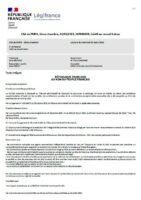
France vs SA Exel Industries, March 2023, CAA de PARIS, Case No 21PA06438
SA Exel Industries marketed its products abroad through subsidiaries or independent agents, depending on the territory. In Brazil, India, Argentina, Russia and Portugal it sold its products through subsidiaries under either a buy/sell distributor agreement or a commissionaire agreement. In Iran, Turkey and South Korea it sold through independent agents to whom it paid a commission. The tax authorities considered that the commission paid to the independent agents was a CUP and determined the commission paid to the subsidiaries on that basis. The remuneration of the subsidiaries in excess of the commission (margin) paid to the independent agents was considered to be a transfer of profits abroad. SA Exel Industries appealed against this assessment, arguing that the subsidiaries performed much more important functions than independent agents. It also argued that there were significant market differences, since the subsidiaries operated in highly strategic markets where the major car manufacturers were dominant, while the other markets in which the independent agents operated were anecdotal. The Administrative Court dismissed the appeal and the case was then brought to the Administrative Court of Appeal. Judgment of the Court The Court upheld the decision of the Administrative Court and dismissed SA Exel Industries’ appeal. Excerpt “4. In order to justify the higher amount of remuneration paid to the subsidiaries of the group it heads, compared with the amount paid to independent local intermediaries, SA Exel Industries argues that the geographical markets in which the subsidiaries operated are fundamentally different from those in which the third-party sales agents operated, since they are highly strategic in that they are home to large car manufacturers, whereas the other markets are anecdotal, The subsidiaries responded to major invitations to tender, whereas the local sales agents were involved only in the supply of spare parts and small equipment, and the subsidiaries provided additional marketing, after-sales service, on-site assembly and testing of equipment, and assistance with the collection of debts, as evidenced by the significant human resources at their disposal. 5. Although the turnover achieved in Iran, Turkey and South Korea was generally lower than that achieved through the subsidiaries, it does not appear from the investigation that the characteristics of these markets justify the differences in the remuneration paid to the subsidiaries and to the independent intermediaries, since the turnover achieved by the subsidiaries is not systematically higher than the turnover achieved through independent sales agents. Even supposing that the composition of turnover achieved through independent sales agents is different from that achieved through subsidiaries, the latter including more sales of large equipment through tenders and fewer sales of spare parts and small equipment, which is not apparent from the investigation in the case of certain subsidiaries, it is common ground that the remuneration of independent sales agents does not take account of the nature of the products and equipment sold, since it is invariably set at 20% of turnover, and that the remuneration paid to subsidiaries is, irrespective of the nature of the products, equivalent to the amount of the discount they would have received if they had acted as a buyer-reseller. Finally, it is not apparent from the documents in the files that the services provided by the independent intermediaries are significantly less substantial than the services provided by the subsidiaries in their intermediation activity alone. The mere fact that the subsidiaries have greater material and human resources is not sufficient to presume, in the absence of documents in the file to that effect, that those resources were used in the context of the latter activity. It follows that, contrary to what is maintained, it does not follow from the investigation that the differences in remuneration between subsidiaries and intermediary agents can be explained by the different situation of those suppliers. Although the applicant company argues that the commissions paid to the subsidiaries take account of the margin which they would have made on a purchase/resale of the same product, such an argument is not such as to justify the abovementioned differences in remuneration between the economic agents belonging to the group and those outside it, since they are involved in the same intermediary activity, which is different from the purchase/resale activity. The various doctrines referred to, which are not expressly invoked on the basis of the provisions of Article L. 80 A of the Book of Tax Procedures, do not interpret the tax law differently from the above. 6. It follows that the tax authorities must be regarded as establishing, under the conditions referred to in point 3, the existence of an advantage, and were entitled to reintegrate it into the results of the French company, as the latter did not justify that this advantage would have had at least equivalent counterparts for it.” Click here for English translation Click here for other translation
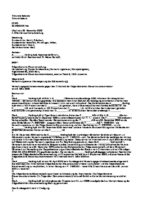
Spain vs “SGGE W T Spanish branch”, January 2023, TEAC, Case No Rec. 00/07503/2020/00/00
SGGE W T is a Spanish branch of SGG that carries out distribution and marketing activities related to the information technology network products and services. SGG is part of the KF group which “is an international group that provides solutions and services in the Information Technology (IT) sector, starting its activity in . .. as a distributor of access and communications networks”. The group “is the result of several corporate operations, mainly company acquisitions and mergers carried out to increase its share in world markets” and “is mainly organized in three divisions (SGG, QR and …) according to the IT areas (Technology, Integration and Consulting) in which they operate”. Following an audit of FY 2015 and 2016 the tax authorities issued assessments of additional income to the Spanish branch. One of the issues identified was SGGE’s remuneration for its sales and marketing activities. According to the tax authorities, the income of the Spanish branch was below the lower quartile of the range established under the TNMM. On this basis, the income was adjusted to the median. The tax authorities had also disallowed deductions for the cost of intra-group services. An appeal was filed by SGGE W T. Judgment of the Court The Court partially upheld and partially dismissed the appeal. Excerpt from the judgment concerning IQR and Median “Thus, this Court only appreciates, from the motivation of the Inspection, that there would be -according to the assessment- some defects of comparability that persist, unavoidable as a consequence of the selection process of comparable elements through databases, and of the limits of the available information, but it is not detailed what errors or circumstances concur in the selection of the comparable elements or what limits the available information has. It should be noted that when the Inspectorate, as transcribed above, refers to the fact that there are still defects in comparability, given that the resulting range does not include relatively equal results, it adds, paraphrasing the Guidelines, that these are defects that cannot be identified and quantified. Rule 3.57 of the OECD Guidelines – also transcribed above – refers to defects in comparability that cannot be identified or quantified and are therefore not susceptible to adjustment. Notwithstanding the foregoing, regardless of the possibility of identifying or quantifying such defects, the choice of the median, provided for in rule 3.62 of the OECD Guidelines, requires – as clearly stated by the Audiencia Nacional and this TEAC – that the Inspectorate must disclose the defects of comparability, and reasons must be given for the defect or defects of comparability that are found to persist and that cause the range not to include very reliable and relatively equal results. We have seen that when section 3.57 of the Guidelines refers to defects that cannot be identified or quantified, it immediately links it to the fact that this makes a specific adjustment impossible. This is perfectly logical, because if they could be concretely identified and quantified, the adjustment would be feasible. It is one thing if they cannot be identified in the sense of being precisely specified and quantified so that they can be adjusted or corrected, and another if elements or areas are detected which, due to their special circumstances or lack of documentation, allow us to conjecture that there is still a deficiency in comparability that cannot be corrected, for which reason there is no other recourse but to resort to the median. Therefore, the mere appeal to this generic reference cannot be considered sufficient; otherwise, the requirement to state reasons that the Audiencia Nacional and this TEAC maintain would be sterile. At the very least, it should be explained what errors or failures in the process of selecting comparables, or what limitations in the information available, determine, as a consequence, that there are such unidentifiable or unquantifiable defects in comparability. In the present case, the reasoning contained in the assessment notification -page 148- only talks about defects that are a consequence of the selection process and the limitations of the available information, but does not detail any aspects that could allow this reviewing body to assess which are the specific circumstances of the selection process that allow to consider that it will lead to unidentifiable or quantifiable defects of comparability; nor the specific circumstances of the available information from which it can be extracted that the limitations of the same (not identified by the Inspection in the aforementioned motivation) will lead to unidentifiable or quantifiable defects of comparability. Likewise, it is striking that the Inspection refers to defects derived from the process of selection of comparables when, in the Fourth Ground of Law of the agreement, in response to allegations, a table is drawn up in which five entities selected by the Inspection, which are the object of allegations by the taxpayer, are eliminated from the comparables, indicating that “the interquartile range derived from the remaining entities would not offer values very different from those resulting from the entities taken by the Inspection”. Also noteworthy is the statement made on page 209 of the contested resolution in which, in response to the allegation that the services of one of the comparable entities (…, S.A.) represent around 40% and 49% of the total income, in 2015 and 2016, respectively, it is stated that this “in no way implies that in all the other entities selected as comparable by the inspection this same circumstance is present”, indicating that in case it were so (that the percentage of 40% or 49% of the income from the provision of services were present in the other entities) “in no way would invalidate the sample of entities selected by the inspection since they are entities that carry out activities similar to those of the obligor and that constitute the best possible comparable”. It is striking that the Inspectorate states that the selected entities “constitute the best possible comparable” and that, nevertheless, the adjustment is based on the choice of the median “as the point in the range that
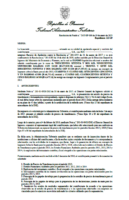
Panama vs “Tech Distributor S.A.”, January 2023, Administrative Tax Tribunal, Case No TAT-RF-006 Expediente: 115-19
The tax authorities issued a transfer pricing adjustment of USD 1.4 million for FY2013, claiming that the remuneration of “Tech Distributor S.A.” had not been determined in accordance with the arm’s length principle. According to the tax authorities, there were inconsistencies between the amounts of controlled transactions reported in the transfer pricing documentation and the income tax return. The tax authorities also found that “Tech Distributor S.A.” had incorrectly included “other income” in the calculation of its operating margin for the purposes of applying the Transactional Net Margin Method (TNMM). Finally, some of the companies selected as comparables were rejected and “comparability adjustments” were also disregarded. After making these adjustments to the benchmark analysis, the profit margin of “Tech Distributor S.A.” was outside the interquartile range and therefore the profit was adjusted to the median. “Tech Distributor S.A. appealed to the Tax Tribunal. Decision of the Tax Tribunal The Tribunal dismissed the appeal and upheld the assessment of the tax authorities. According to the Tribunal, ‘other income’ should not be included in the calculation of the operating margin. The court also upheld the tax authorities’ rejection of some of the comparables and agreed that the comparability adjustments made by the company were incorrect. Click here for English translation Click here for other translation
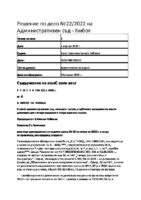
Bulgaria vs Yazaki Bulgaria Ltd, January 2023, Administrative Court, Case No 22/2022
Yazaki Bulgaria Ltd is active in the automotive industry and is part of the Japanese Yazaki Group. It had used the transactional net margin method (TNMM) to demonstrate that prices for the sale of products to related parties were at arm’s length. Following an audit, the tax authorities found that the company’s profit was outside the arm’s length range and issued an assessment of additional income for FY2014-2016. According to the tax authorities, Yazaki Bulgaria Ltd had not included all its costs when calculating its profit margin. Administrative Court Judgment The Administrative Court annulled the tax authority’s assessment and ruled in favour of Yazaki Bulgaria Ltd. Excerpt “It is undisputed in this case that the adjustments made by the appellant for comparability with the amounts of additional labour costs in individual years are as follows: For 2014, the reported operating loss of £2,192,845.67 was adjusted upwards to a net profit of £4,837,402.79 as a result of the elimination for comparability purposes of costs of £7,030,248. 46 leva; before adjustments a net profit margin of -1.02% is calculated and after adjustments the net profit margin indicator is +2.34% and falls above the lower quartile value which is 2.27; For 2015 – the reported net profit from operations of £4,086,310.44 has been adjusted upwards to a net profit of £11,832,352.26 as a result of eliminating for comparability purposes expenses of £7,746,041. 82 leva; before adjustments, the net profit margin is calculated at 1.43% and after adjustments, the net profit margin indicator is 4.26% and falls above the lower quartile value of 1.68%; for 2016 – the reported net profit from operations of £1,259,468.30 has been adjusted upwards to a net profit of £6,815,444.19 as a result of eliminating for comparability purposes expenses of £5,555,975. 89; Before adjustments, the net profit margin is calculated at 0.46% and after adjustments, the net profit margin indicator is 2.56% and falls above the lower quartile value which is 2.22% . In summary of the foregoing, the court finds that after the audited entity’s elimination of net profit comparability expenses, Y.B.’s net profit margin indicator falls within the interquartile range, and therefore, the conclusion that the company’s net profit margin indicator is below market values is not warranted. The adjustments made were to eliminate the effect of additional staff and training costs which affected the auditee’s net profit margin and, in the Court’s view, were consistent with the purpose of Article 4 N-9 of 14.08.2006 – to achieve a result that would have been achieved in an ordinary commercial or financial relationship between independent persons under comparable conditions. The additional costs have been recognized by the tax administration as actually incurred and are part of the costs taken into account in the declared financial result of the company. There is no basis for transformation of the financial result of the company, as done by the audit on the basis of Art, Article 16 and Article 78 of the Income Tax Act, since the net profit of the company falls within the market values when adjustments are made for comparability, i.e. there is no conduct on the part of the audited entity aimed at tax evasion. For the reasons set out above, the Court considers that the appeal should be upheld by annulling the contested revision act.” Click here for English Translation Click here for other translation
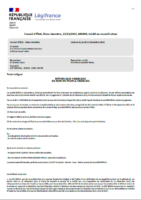
France vs Willink SAS, December 2022, Conseil d’Etat, Case No 446669
In 2011, Willink SAS issued two intercompany convertible bonds with a maturity of 10 years and an annual interest rate of 8%. The tax authorities found that the 8% interest rate had not been determined in accordance with the arm’s length principle. Willink appealed, but both the Administrative Court and later the Administrative Court of Appeal sided with the tax authorities. Judgment of the Supreme Court The Conseil d’Etat overturned the decision and ruled in favour of Willink SAS. The court found that RiskCalc could be used to determine a company’s credit rating for transfer pricing purposes in a sufficiently reliable manner, notwithstanding its shortcomings and the differences in the business sectors of the comparables. Click here for English translation Click here for other translation
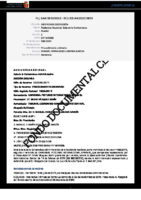
Spain vs Universal Pictures International Spain SL, December 2022, Audiencia Nacional, Case No SAN 5855/2022 – ECLI:EN:AN:2022:5855
Universal Pictures International Spain SL is a distributor of films on the Spanish Market. It distributes films both from related parties (Universal Pictures) and from unrelated parties. Following an audit, the Spanish tax authorities issued an assessment where the remuneration received for distribution of films from related parties had been compared to the remuneration received from distribution of films from unrelated parties and where the pricing of the controlled transactions had been adjusted accordingly . Not satisfied with the assessment of additional income a complaint was filed by Universal Pictures International Spain SL. Judgment of the Court The Court predominantly held in favor of Universal Pictures International Spain SL. The distribution activities performed in regards of films from related parties were limited risk whereas the activities performed in regards of distribution of films from unrelated parties were fully fledged. Hence the pricing of the controlled and uncontrolled transactions was not comparable. However, the comparables in the benchmark analysis on which Universal Pictures International Spain SL had based the pricing of controlled transactions was not all considered sufficiently comparable by the court and on that basis the case was referred back for reconsideration. Click here for English translation Click here for other translation
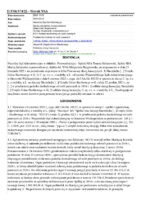
Poland vs C. spółka z o.o. , November 2022, Supreme Administrative Court, Case No II FSK 974/22
C. spółka z o.o. is part of a larger group and mainly (95%) sells products (boxes, metal enclosures, etc.) and related services to related parties. According to its transfer pricing documentation the “cost-plus” method had been used to determine the prices of products sold to related parties. The company was audited for FY 2016. According to the tax authorities, the company did not provide enough evidence to support the cost-plus method. The tax authority instead used the transactional net profit method to estimate the company’s income for the year 2016, taking into account factors such as characteristics of goods or services, functional analysis, contractual conditions, economic conditions, and economic strategy by comparing the company’s performance with similar companies over a 3 year period by using EBIT margin. As a result, the authority adjusted the company’s loss and established income based on a EBIT margin of 3.66%, resulting in additional taxable income of PLN 1,803,592.08. C. spółka filed an appeal with the Administrative Court. The Administrative Court predominantly dismissed the appeal and found in favor of the tax authorities. However, the tax authorities have wrongly determined the income of the complainant, by referencing to its entire activity, despite the fact that 5% of the transactions are not subject to regulation under the arm’s length provision. Because of this, the court repealed the decision of the first-instance authority and stated that when re-examining the case, the authority should take into account the position expressed. An appeal was then filed by C. spółka with the Supreme Administrative Court. Judgment of the Supreme Administrative Court The Court dismissed the appeal and upheld the decision of the Administrative Court. Excerpts “The company completely ignores in the cassation complaint that the tax documentation of the transaction submitted by it did not confirm its use of the “cost-plus” method of calculating the sales price to related parties with a mark-up of 30% on the direct costs constituting the cost base (depreciation, value of materials and energy used, third-party services, salaries and wages with mark-ups). The submitted tax documentation shows that in the Company, the valuation of the value of the products sold to related customers should follow the reasonable margin “cost-plus” method. In addition, the Company, in describing the method and manner of calculating income and determining the price of the subject of the transaction, explained, among other things, that in 2016, in transactions to related parties (i.e. to: C. GmbH,. P.GmbH, R. mbH), the price was the sales value of individual finished products, determined each time on invoices issued by the Applicant. The price for the individual products was determined on the basis of pre-agreed price lists or on the basis of ongoing arrangements and negotiations, taking into account changing market conditions. This was to be the method provided for in Article 11(2) of the A.p.d.o.p., consisting in setting the price for the sale of goods and rights and the provision of services in transactions with a related party at the level of the sum of the cost base and profit mark-up, comparable to the cost base and profit mark-up established between independent parties, which take into account comparable functions, risks incurred and assets involved. In the explanations submitted during the tax proceedings, the Company additionally stated that it calculated the selling prices of finished goods taking into account the following elements: – material costs; – third-party service costs; – labour costs; – a mark-up of 30%. It further explained that the 30% mark-up applied by it was established in 2005 and was not updated, and was applied in transactions carried out for related parties and independent parties under individual orders and orders. At the same time, it did not submit any documents related to the calculation of the sales prices of finished goods applied to related parties. It should also be emphasised that the Appellant, when preparing the profit and loss account in the comparative variant, did not separate in it such an item as management costs within the meaning of the Accounting Act, the determination of which is necessary in the event of a reliable application of the “cost-plus” method to transfer pricing settlements. The tax authority was therefore correct in concluding that the sales prices to related parties were not correctly calculated based on market standards. At the same time, it must be emphasised that the Company did not have any long-term contracts with customers, and production and sales were based on current orders from customers, including related and independent entities. In the business relationship concerning the production and sale of products to the related party C. GmbH (as parent company), the Applicant acted as a subcontractor, and these processes were planned on the basis of long-term contracts concluded by C. GmbH with its customers. The company did not in any way contractually secure its own turnover volume or even the planning of the supply of its products and services in the medium term. Most importantly, however, it is apparent from the evidence gathered, including the documentation obtained from the Applicant, that sales were made at amounts that did not take into account all costs incurred and that there was no rational reason for such sales prices. According to the tax authority’s calculations, the revenues obtained by the Company according to the reasonable “cost-plus” margin method indicated by itself should have been higher by approximately PLN 4.5 million. Meanwhile, the margin realised by the Applicant was negative and actually amounted to -6.80%. This indicates that the Company’s method of pricing to related parties, contrary to its position, did not assume the achievement of an adequate profit, and the tax documentation submitted for the Complainant’s transactions with related parties did not assume a mark-up of 30%, which would have translated into a profit for 2016 rather than a loss. Therefore, it is not possible to agree with the Company’s position that only objective factors influenced the negative financial result and were the only reason for the application of Article 11(1) of the A.T.C. Properly
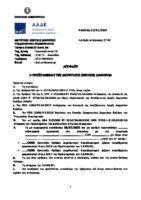
Greece vs “Tin Cup Ltd”, November 2022, Administrative Tribunal, Case No 3743/2022
Following an audit of “Tin Cup Ltd” for FY 2016 and 2017 an assessment was issued by the tax authorities regarding excessive amounts of waste materials and pricing of intra-group transactions. On the issue of excessive amounts of waste materials, tax deductions was denied by the authorities as the costs was not considered to have been held in the interest of the company, i.e. it did not take place with the purpose of increasing “Tin Cup Ltd” income. On the second issue, the tax authorities found that the most appropriate method for the transactions in question (sales to a related party) was the CUP method. Applying the CUP to the controlled transactions (instead of the TNMM) resulted in additional income of approximately 392.000 EUR in total for FY 2016 and 2017. A complaint was filed by “Tin Cup Ltd” with the Dispute Resolution Board. Decision of the Board The Board upheld the assessment of the tax authorities both in regards of denied deductions of costs related to excessive waste materials and in regards of the transfer pricing adjustment. Excerpts Issue of excessive waste materials “The applicant further submits that the audit is not entitled to disallow the excess consumption for tax purposes, since it is a real amount, which can only be considered to be in the interest of the undertaking, since the processing of the raw material results in the products to be sold. Since, however, the applicant’s above individual allegation is well-founded only to the extent that the purchases of raw and auxiliary materials are made within reasonable and expected limits and taking as a reference technical specifications and the data of common experience. Because in the present case, the products for which a difference was calculated show overruns of consumptions from 8,43% to 53,96% in excess of the normal consumption according to the accounting records. Because as it follows from the relevant Audit Report, the audit established with full and clear arguments that the excessive consumption of raw and auxiliary materials, which affected the cost of sales and the net results, did not take place in the interest of the company, i.e. it did not take place with the purpose of increasing its income and therefore, the condition of para. (a’) of Article 22 of Law 4172/2013. The applicant’s claim is therefore rejected as unfounded.” Issue of transfer pricing “…Because, as is clear from the relevant Audit Report (pp. 28-35), the audit provides full and sufficient reasons for the rejection of the applicant’s documentation, namely: · the sample of external comparables selected by the applicant concerns EU-28 countries, whereas the transaction at issue is between two Greek undertakings and the geographical area is a factor which materially affects the comparability of the transactions. · the audit preferred the comparable uncontrolled price (CUP) method, not only because it is the preferred traditional method in accordance with the above provisions, but also because it found that internal comparables with independent/unrelated companies existed. · the transactional net margin method (TNMM) has the disadvantage that the net profits taken into account are affected by factors not related to intra-group transactions, such as extraordinary income and expenses, thus reducing its reliability (OECD Guidelines 2017, para. 2.70 and 2.72). Indeed, in the present case, specifically in the 2016 tax year, the applicant incurred extraordinary expenses of €1.5 million, with the result that the net profit margin ratio is approximately half of what it would have been without them. Because the applicant also claims that there is a comparability deficit in the sample of the audit, since the way and time of payment of the sales invoices differs. In particular, unlike other independent/unrelated customers, which have open balances for a significant period of time, the related company………..normally advances 50 % of the annual turnover from the previous year. Since, however, because of this preferential method of collection, the applicant incurs significant amounts of interest payable to the abovementioned affiliated company, amounting to: · 2016: 200.121,00 € · 2017: 103.000,00 €, transaction which has also been documented and contributes to the elimination of any difference in comparability. Since the methodology and the conclusion of the audit, as reflected in the relevant Audit Report, are hereby found to be valid, acceptable and fully justified. The applicant’s claim is therefore rejected as unfounded. Click here for English translation Click here for other translation
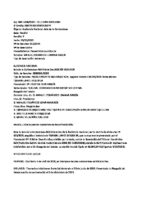
Spain vs Transalliance Iberica SA, November 2022, Audiencia Nacional, Case No SAN 5336/2022 – ECLI:EN:AN:2022:5336
Transalliance Iberica SA had priced its controlled transactions for the years 2008-2013 by comparing the gross margin achieved on an overall basis with the gross margins of comparable companies. Following an audit, the tax authorities issued a notice of assessment rejecting the method used by the company due to differences in the treatment of cost items and thus issues of comparability at a gross margin level. Instead, the tax authorities applied the TNMM. The profit was outside the interquartile range and an adjustment to the median was made. Transalliance lodged an appeal. Judgment of the Court The Court largely ruled in favor of the tax authorities, but according to the Court, an adjustment to the median could only be made where the tax authorities established the existence of comparability defects. Since such defects had not been established, the adjustment was reduced to the lower quartile. Excerpt “Of the points that are dealt with, the appellant focuses the discussion on the application of the median. In particular the Guidelines – 3.62 – state that “where the range comprises highly reliable and relatively equal results, it can be argued that any one of them satisfies the arm’s length principle. Where some defects in comparability persist, as discussed in paragraph 3.57, it may be appropriate to use measures of central tendency that allow this point to be determined (e.g. median, measure or weighted mean, depending on the specific characteristics of the data) in order to minimise the risk of error caused by defects in comparability that persist but are not known or cannot be quantified”. Applying this rule, p. 109 of the Agreement states that “the normal practice in such cases is to use the median as the most significant value of the interquantile range, as it avoids the problems that extreme values cause in the calculation of the arithmetic mean”. The appellant – p. 120 of the agreement – argued that the administration could not apply the median “mechanically”, as such automatism is not required by the Guidelines. Therefore, it argued that it is sufficient to apply the “lower quartile of the interquartile range” instead of the median. To which the Agreement replied that ‘the preference for the median must be justified on statistical grounds: it is a robust statistic, which is not influenced by extreme values in the sample of purchasables’. Both the TEAC and the Abogacía del Estado insist on the argument. The Chamber’s position in this regard is described in our SAN (2nd) of 6 March 2019 (Rec. 353/2015 ) – the appeal was rejected by order of 14/11/2019 – and 4 February 2021 (Rec. 658/2017), which hold that “it is legitimate to resort to what the Guideline calls “measures of central tendency”, but whoever resorts to them has the burden of reasoning and setting out the reasons that lead to their application”. This solution has been accepted in the Resolution of the TEAC of 23 November 2021 (4881/2019), which states, with a correct interpretation of the position of this Chamber, “that in order to resort to the median, there must be defects of comparability. In the event that such defects are not highlighted by the inspection, the adjustment would be made to the lower quartile”. Well, what the Inspectorate has done is to “automatically” apply the median -also the TEAC and the Abogacía del Estado-, without explaining and reasoning the concurrence of “defects of comparability”, a burden that corresponds to it and that the Chamber should not replace. This means that the lower inter-quantile range must be applied and not the median, as the appellant claims. On this point, the appeal is also upheld.” Click here for English translation Click here for other translation

Hungary vs “Gas-Trader KtF”, November 2022, Supreme Administrative Court, Case no Kfv.I.35.343/2022/8
“Gas-Trader KtF” – a subsidiary in the E.ON group – had entered into loan agreements with other group companies and the related parties had determined the interest rate by application of the CUP method using the Thomson Reuters LoanConnector database. Comparable transactions was extracted from the database by searching for credit rating, type of debtor party, date of loan, maturity, transactions with completed status, and spread/provision fee. An audit was conducted by the tax authorities for FY 2012-2013 and the interest rate determined by the group was found to be incompliant with the arm’s length principle. The tax authorities applied the same method as Gas-Trader but added further search criteria in the selection of comparable transactions – credit purpose and insurance coverage. This resulted in a different range and an assessment of additional taxable income was issued. An appeal was filed by Gas-Trader KtF with the National Tax and Customs Board of Appeal where a judgment in favor of the tax authorities was issued. Then an appeal was then filed with the courts where the decision was annulled and the Board of Appeal ordered to initiate new proceedings. During these proceedings, an expert opinion was obtained which was in favor of Gas-Trader. However following objections from the tax authorities, the Board of Appeal dismissed the expert opinion and decided predominantly in favor of the tax authorities. An appeal was then filed with Supreme Administrative Court. Judgment of the Court The Supreme Administrative Court set aside the decision and issued a judgment in favor of Gas-Trader. In its judgment, the Court states “[26] A large amount of data is needed to determine the transfer price. However, the available information may be incomplete, difficult to interpret, difficult to obtain for reasons of confidentiality, or may not exist at all, or the relevant independent enterprise itself may be missing. In the practical application of the arm’s length principle, the objective is always to determine an acceptable estimate of arm’s length profit based on reliable data. The ‘estimated’ nature of the transfer price means that it is never an exact tax act, but requires both the taxpayer and the tax authorities to subsequently take evidence that is clearly identifiable and realistic. The Curia has stated in its judgment Kfv.I.35.550/2018/12 that the question of transfer pricing can be a technical question or a purely legal question depending on the underlying facts. In the case at hand, the defendant transformed the decision into a question of law by basing its decision not on an examination of the transfer pricing method, but on a different classification of the underlying legal relationship from that of the plaintiff in that case. In the present case, the Curia adds that, in the event of a substantive examination of the transfer pricing method by the tax authorities, the applicant may also submit a request for evidence on a technical point in the course of the judicial review. [27] Among the methods of transfer pricing, both the Directives and the Tao [Corporate Tax and Dividend Tax] Law recognise the method of comparative independent prices. Pursuant to Section 18(2)(a) of the Tao Law, the arm’s length price is to be determined by one of the following methods: the arm’s length price method, whereby the arm’s length price is the price that independent parties would apply for the sale of a comparable asset or service in an economically comparable market. The problem in applying this method is the identification of the ‘economically comparable market’, which is ultimately achieved by applying the correction/constraint criteria within the scope of the method. Indeed, an independent transaction can only be compared with a controlled transaction using the method of comparable independent prices if one of the following two conditions is met: (a) none of the differences, if any, between the transactions to be compared or between the undertakings entering into those transactions can materially affect the free market price, or (b) relatively accurate adjustments can be made to eliminate the distortive effect of such differences. Therefore, where distorting differences exist between controlled and unrelated transactions, adjustments should be made to at least broadly eliminate price influencing factors and enhance comparability. Each of the narrowing methods should be assessed for their relative accuracy and only those adjustments should be made that are likely to improve comparability. [28] In the case at bar, it is a fact that the defendant did not make a finding with respect to the plaintiff’s records that the plaintiff had developed what it considered to be an appropriate transfer price, that the defendant agreed to the use of the comparative independent pricing method. The court’s remedy resulted from a difference in the criteria considered by the parties to eliminate the distorting effect of the differences. It may also be noted that in the decision of the Court of Appeal ordering a new trial in the main proceedings, the defendant excluded the application of the interquartile range correction criterion of narrowing the range around the midpoint. [29] Defendant used the data extracted by the plaintiff from the LoanConnector database to verify the transfer pricing. In its procedure, it considered the relevant aspects of the Directives to be relevant, according to the review request: in the expected audit practice, tax auditors should be flexible in their approach, take into account the business considerations of taxpayers and start their analysis from the perspective of the pricing method chosen by the taxpayer. If the taxpayer’s screening strategy is reproducible and the screening steps are suitable to produce a suitable sample for the transaction under consideration, the tax administration will use the taxpayer’s database screening as a basis. If, for any reason, the tax administration disputes the screening steps, it will attempt to make the necessary adjustments based on the taxpayer’s research to ensure that the results calculated from the improved sample are consistent with the market price principle. As a starting point, the tax administration does not therefore seek to determine the price or range of prices applicable to
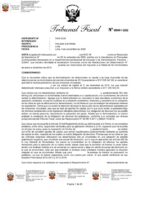
Peru vs “Capital Ltd”, November 2022, Tax Court, Case No 08044-1-2022
At issue was whether certain disbursements received by “Capital Ltd” from non-domiciled related companies should be classified as loans or capital contributions. “Capital Ltd” claimed that the purpose of the funds was to stabilize the financial state of the company, and that classifying them as loans with presumed interest was inappropriate under these circumstances. The tax authority argued that the disbursements should be regarded as loans, with a clear obligation of repayment, which justified applying withholding tax on presumed interest payments. The assessment relied on a comparability analysis to establish a market interest rate for these transactions. “Capital Ltd” asserted that the tax authority had failed to consider crucial comparability factors, such as the scale of the principal amount, the debtor’s financial status, and its risk rating. These omissions led to an improperly inflated deemed interest calculation. Judgment The court determined that the tax authority’s comparability analysis was insufficient, as it did not fully account for the differences between the taxpayer’s circumstances and those of independent third parties, which affected the accuracy of the presumed interest. Consequently, the court annulled the assessment, concluding that the tax adjustments lacked adequate justification. Peru Tribunal Fiscal 08044-1-2022 ENG Click here for English Translation Click here for other translation
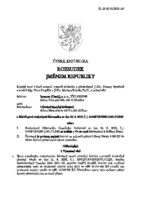
Czech Republic vs Inventec s.r.o., October 2022, Regional Court, Case No 29 Af 91/2019
Inventec carried out manufacturing activities in the electronics industry on behalf of its parent company. It took formal title to the raw materials, but considered that its role was limited to assembly, without assuming risk or adding value to the materials. Inventec therefore used ROVAC (return on value added costs – not including cost of materials) as a profit level indicator (PLI) in its transfer pricing analysis. The tax authorities disagreed with the choice of PLI and considered ROTC (return on total costs – including materials) to be more appropriate. An appeal was filed by Inventec, which ended up before the regional court. Judgment The regional court found that the tax authorities had failed to take into account Inventec’s FAR profile and that the alternative choice of profit level indicator – ROTC instead of ROVAC – had therefore not been sufficiently justified. On this basis, the court quashed the assessment and remitted the case to the tax authorities for reconsideration. Excerpt in English “37. Furthermore, the contested decision fails to take into account how the fact that the material costs of the compared companies are significantly lower than those of the applicant and the fact that the applicant has a significantly higher turnover than the companies under assessment affect the outcome of the benchmark profit figure. It is not only the risk and functional profile of the applicant, but also these facts that the Regional Court considers relevant for a fair comparison. The defendant’s claim (paragraph 113 of the contested decision) that those differences are compensated for by the fact that it produces similar products on the same market is not convincing. It is understandable that it is not always possible to have 100 % comparable companies that fully fit the applicant’s business model. However, the tax authorities are obliged to make an appropriate adjustment when they find economic differences which could affect the assessed values. In addition, the transactional profit method must be used with particular care to ensure that it does not lead to the imposition of excessive taxes on companies primarily because they realise lower than average profits or to the undertaxation of companies that realise higher than average profits. Therefore, due care should be taken to calculate the values correctly in the light of all the relevant circumstances of the case and to justify the calculations on the basis of objective criteria. The assessment of the reference price is not an exact science, but a judgment whose correctness must be reliably justified. 38. It must therefore be demonstrated whether or not it is necessary to apply a mark-up to the cost of the material to the same extent as for companies which process the material directly and change their properties. Indeed, that view is partly accepted by the tax authorities in other tax proceedings which also concern the applicant. In the result of the audit findings so far for the 2015 tax year, the tax authority has taken the view that the applicant should be remunerated at least in part by a material cost mark-up and thus perceives that the applicant performed limited risk and liability functions in relation to the material it owned in 2015. The Tax Administrator considered it clear that the profitability did not correspond to the entire unadjusted ROTC markup percentage. The tax administrator in this tax proceeding performed an analysis resulting in a quantification of the proportion of function and risk borne by the claimant in order to realise the claimant’s remuneration. The Regional Court agreed with this approach and is convinced that this approach is more consistent with the fact that the claimant’s risk and function profile does not fully match that of a contract manufacturer; on the other hand, because of the very limited liability, it does not match that of a contract manufacturer in the payroll. The Court emphasises that the model types of contract manufacturer and producer in payroll may not be an exact reflection of reality, but are merely thresholds between which market actors move, and it is therefore not overly important to have far-reaching discussions about whether the claimant is a full-fledged contract manufacturer or producer in payroll. The audit findings to date for the 2015 tax year show that the tax authorities did not consider the risk and functional profile in 2015 to be different from that in 2013 (see, for example, p. 8). The fact that the situation was similar in 2013 and in subsequent years is confirmed by the interviews of witnesses J. H. (quality supervisor) and M.A. (personnel manager), who stated that their statements concerning the applicant’s functioning also applied to 2013 (see, for example, page 7 of the witness interview report of 12 May 2022, no. 86265/22/4200-30762-711761). In the Court’s view, the defendant’s assertion that it did not include the percentage reduction in the 2013 tax year now under review in its calculation because of the plaintiff’s failure to testify, i.e., passivity, is too formalistic in a situation where the plaintiff’s employees as witnesses merely confirmed the plaintiff’s earlier assertions, and does not correspond to a fair and objective assessment of the plaintiff’s consistent assertions regarding its functions and risks throughout the tax proceedings.” Click here for English Translation Click here for other translation
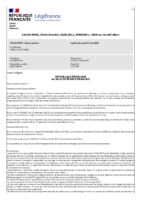
France vs Ferragamo France, June 2022, Administrative Court of Appeal (CAA), Case No 20PA03601
Ferragamo France, which was set up in 1992 and is wholly owned by the Dutch company Ferragamo International BV, which in turn is owned by the Italian company Salvatore Ferragamo Spa, carries on the business of retailing shoes, leather goods and luxury accessories and distributes, in shops in France, products under the ‘Salvatore Ferragamo’ brand, which is owned by the Italian parent company. An assessment had been issued to Ferragamo France in which the French tax authorities asserted that the French subsidiary had not been sufficiently remunerated for additional expenses and contributions to the value of the Ferragamo trademark. The French subsidiary had been remunerated on a gross margin basis, but had incurred losses in previous years and had indirect cost exceeding those of the selected comparable companies. In 2017 the Administrative Court decided in favour of Ferragamo and dismissed the assessment issued by the tax authorities. According to the Court the tax administration had not demonstrated the existence of an advantage granted by Ferragamo France to the Italien parent, Salvatore Ferragamo SPA, nor the amount of this advantage. This decision was later upheld by the Administrative Court of Appeal. An appel was then filed by the tax authorities with the Supreme Court. The Supreme Court (Conseil d’Etat) overturned the decision and remanded the case back to the Administrative Court of Appeal for further considerations. “In ruling that the administration did not establish the existence of an advantage granted to the Italian company on the grounds that the French company’s results for the financial years ending from 2010 to 2015 had been profitable without any change in the company’s transfer pricing policy, whereas it had noted that the exposure of additional charges of wages and rents in comparison with independent companies was intended to increase, in a strategic market in the luxury sector, the value of the Italian brand which did not yet have the same notoriety as its direct competitors, the administrative court of appeal erred in law. Moreover, although it emerged from the documents in the file submitted to the trial judges that the tax authorities had established the existence of a practice falling within the provisions of Article 57 of the General Tax Code, by showing that the remuneration granted by the Italian company was not sufficient to cover the additional expenses which contributed to the value of the Salvatore Ferragamo trade mark incurred by the French subsidiary and by arguing that the latter had been continuously loss-making since at least 1996 until 2009, the court distorted the facts and documents in the file. By dismissing, under these conditions, the existence of an indirect transfer of profits to be reintegrated into its taxable income when the company did not establish, by merely claiming a profitable situation between 2010 and 2015, that it had received a consideration for the advantage in question, the court incorrectly qualified the facts of the case.” Judgment of the Administrative Court of Appeal The Administrative Court of Appeal issued a final decision in June 2022 in which the 2017 decision of the Paris Administrative Court was annulled and the tax assessment issued by the tax authorities reinstated. “Firstly, Ferragamo France argued that the companies included in the above-mentioned panel were not comparable, since most of their activities were carried out in the provinces, whereas its activity was concentrated in international tourist areas, mainly in Paris, and their workforce was less than ten employees, whereas it employed 68 people, that they are mere distributors whereas it also manages a network of boutiques and concessions in department stores, and that some of them own their premises whereas it rents its premises for amounts much higher than the rents in the provinces, the relationship between external charges and turnover thus being irrelevant. However, most of the comparables selected by the administration, which operate as multi-brand distributors in the luxury ready-to-wear sector, were proposed by Ferragamo France itself. Moreover, the company does not indicate the adjustments that should be made to the various ratios of salary and external costs used to obtain a result that it considers more satisfactory, even though it has been established that additional costs in the area of salaries and property constitute an advantage granted to Salvatore Ferragamo Spa. Furthermore, apart from the fact that it has not been established that some of the companies on the panel own their premises, Ferragamo France does not allege that excluding the companies in question from the calculation of the ratios would result in a reduction in the amount of the adjustments. Lastly, as regards the insufficient consideration of the management of a network of department stores’ boutiques and concessions, Ferragamo France does not provide any specific information in support of its allegations, whereas the comparison made by the administration is intended to assess the normality of the remuneration of its retail activity.” … It follows from all of the above that the Minister of the Economy, Finance and Recovery is entitled to argue that it was wrong for the Administrative Court of Paris, in the judgment under appeal, to discharge, in terms of duties and increases, the supplementary corporate tax assessment to which Ferragamo France was subject in respect of the financial year ended in 2010, of the withholding tax charged to it for 2009 and 2010 and of the supplementary minimum business tax and business value added contribution charged to it for 2009 and 2010 respectively. This judgment must therefore be annulled and the aforementioned taxes, in duties and increases, must be remitted to Ferragamo France.” Click here for English Translation Click here for other translation
France vs Issey Miyake Europe, June 2022, CAA de Paris, Case N° 20PA03807
The French company Issey Miyake Europe is owned by the Japanese company, Issey Miyake Inc, which is active in the fashion industry. Following an audit covering the FY 2006 – 2012, the tax authorities issued an assessment of additional income. According to the tax authorities the pricing of controlled transactions was not at arm’s length, resulting in an indirect transfer of profits within the meaning of Article 57 of the General Tax Code. In order to determine the arm’s length results, the tax authorities applied the transactional net margin method. After searching for comparables on the basis of a database and selecting seven companies for the retail business and nine companies for the wholesale business, and then examining the net operating margins, it adjusted the result to the median. It concluded that Issey Miyake Europe’s results as a wholesaler were within the arm’s length range, but that its results as a retailer were not, with the exception of the financial year ending in 2012, and adopted a rate for this activity corresponding to the median (3,82% for FY 2005, 2.39% for FY 2006, 2.06% for FY 2007, 1.43% for FY 2008, 1.70% for FY 2009, 1.58% for FY 2010 and 2.07% for FY 2011. Not satisfied with the assessment, Issey Miyake Europe appealed to the Administrative Court, which dismissed the appeal. Issey Miyake Europe then appealed to the Court of Administrative Appeals. Judgment of the Court The Court of Administrative Appeals udheld the decision of the Administrative Court and ruled in favour of the tax authorities. Excerpts: “6. In these circumstances, the tax authorities have established that Issey Miyake Inc sells its products to all its subsidiaries worldwide at cost price, to which a margin is added without taking into account the specific nature of local markets, Maintaining the loss-making business in France enabled this company to benefit from a showcase to display and develop the brand’s reputation and to have a commercial outlet in a market with international influence in the luxury goods sector, while Issey Miyake Europe incurred rent expenses that were excessive in relation to its activity with a view to developing the brand. It thus provides evidence that Issey Miyake Europe’s operating result was structurally in deficit for the period under review due to its retail sales activity, as a result of the additional costs incurred by the marketing strategy, which had the effect of having Issey Miyake Inc’s intangible assets valued by its subsidiary.” (…) 10. Thirdly, it is clear from the investigation, in particular from the terms of the rectification proposal and the response to the taxpayer’s observations, which are not seriously contested, that Issey Miyake Europe, although questioned on this point and even though it was not bound by detailed documentary obligations, did not produce any sufficiently precise evidence during the accounting audit to justify transfer prices, contrary to what it maintains. On the other hand, it submitted a study carried out in June 2015 by Grant Thornton during the taxation procedure, which analysed transactions involving inventories for the period between the financial year ending in 2012 and that ending in 2014 and found, after carrying out an analysis of the functions and risks of Issey Miyake Inc and Issey Miyake Europe alone, the cost-plus method, on the grounds that Issey Miyake Inc also sells wholesale to independent companies in the Asia-Oceania region and that these transactions are similar to those carried out with Issey Miyake Europe. However, this study, which notes that the markets analysed are different and relate to a period other than the period audited, compares the margins achieved by Issey Miyake Inc in its sales to independent distributors with the margins achieved in sales to Issey Miyake Europe, making adjustments to take account of the length of the distribution channel and differences in exchange rate risks, without providing any specific information concerning the products sold, as the study merely refers in general terms to the types of products, the volumes of transactions compared and the contractual stipulations governing these transactions. In these circumstances, the tax authorities were right to reject the method proposed by Issey Miyake Europe. 11. Furthermore, although Issey Miyake Europe contests the principle of the administration’s use of the transactional net margin method, the investigation does not show that the administration had sufficient information, internal to the group, on transfer pricing to enable it to use a method based on transactions, and the applicant does not provide any evidence to support its allegations that the analysis of functions and risks carried out on the basis of its own replies was erroneous. Nor does it provide any evidence in support of its allegations that the method used by the tax authorities would, as a matter of principle, result in over-taxation that did not take commercial factors into account. In these circumstances, Issey Miyake Europe is not entitled to argue that the tax authorities could not have used the transactional net margin method. 12. Fourthly, Issey Miyake Europe maintains that the comparables used by the tax authorities for the retail business are not relevant, since the companies in question are engaged in distribution in the clothing sector and not in the luxury goods sector, which has its own specific requirements, as confirmed by the aesthetics of the windows, the quality of the shops, the locations, the type of staff and the price of the products sold. However, the purpose of the transactional net margin method is to compare the results of controlled transactions with those of third-party companies performing comparable functions and assuming comparable risks, unlike price-based methods, which require the products sold to be similar. In this case, Issey Miyake Europe simply refutes the comparables on the sole grounds that they are not independent French companies distributing luxury ready-to-wear clothing similar to that which it distributes and under the same conditions, whereas the administration, which excluded the companies initially retained whose functions were likely to present substantial differences, such as those performing manufacturing and production functions, appended
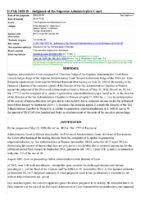
Poland vs “Shopping Centre Developer sp.k.”, June 2022, Supreme Administrative Court, Case No II FSK 3050/19
A Polish company, “Shopping Centre Lender sp.k.”, had been granted three intra group loans in FY 2013 for a maximum amount of EUR 2 million, EUR 115 million and EUR 43.5 million. The interest rate on the loans had been set at 9%. The tax authorities found that the 9% interest rate was higher than the arm’s length rate, and issued an assessment where the interest rate had been lowered to 3.667%, resulting in lower interest expenses and thus additional taxable income. “Shopping Centre Lender sp.k.” filed an appeal with the Administrative Court claiming that the procedure for estimating income – determining the arm’s length interest rate – had not been conducted correctly by the tax authority. In a judgment issued in May 2019 (no. III SA/Wa 1777/18) the Administrative Court issued a judgment in favour of the company. An appeal was then filed by the tax authorities with the Supreme Administrative Court. Judgment of the Supreme Administrative Court The Supreme Administrative Court upheld the decision of the Administrative Court and dismissed the appeal of the tax authorities. Excerpts “In the opinion of the Supreme Administrative Court, the Court of First Instance made a proper assessment of the case submitted to its review. In the justification of the contested judgment, it presented the legal basis for the decision and its explanation, and within this framework it diagnosed the infringements committed by the authority and assessed their impact on the results of the case. It did so in a clear manner which makes it possible to review the grounds on which it was based. The conclusions formulated, as well as the objections to the proceedings conducted and the content of the decision concluding them, were presented in a reliable and comprehensive manner, in mutual confrontation of the state of the case, applicable legal norms and case-law. It indicated which provisions had been violated, which allegations of the complaint it considered justified and why. In the present case, the essence of the dispute essentially boiled down to determining whether the interest rate (9% p.a.) of the three loans concluded in 2013 for a maximum amount of EUR 2 million, EUR 115 million and EUR 43.5 million (in respect of which the total balance of liabilities as at 30 September 2014 amounted to almost PLN 623 million), which were granted to the Applicant by a related entity, was in line with market conditions, i.e. whether independent, rational entities would have agreed on an interest rate of that amount under comparable conditions. More generally, however, the issue in the case oscillated around so-called transfer pricing and generally – in view of the arguments now raised by the parties – boiled down to an assessment of whether, in fact, the procedure for estimating income [art. 11 of the AOP] had been conducted correctly, as the authority argued, or, as the Appellant and the Court argued, in breach of the provisions of the Act and the Ordinance.” “Referring in turn to the individual problems diagnosed by the WSA, it should be pointed out that this Court, taking into account the disposition arising from the content of Article 11(1) of the A.p.d.o.p., rightly emphasised that its application (in order to determine the income of a given entity and the tax due) requires a prior analysis of comparability. In order to determine what conditions would be set between independent entities, it is necessary to determine what transactions concluded by independent entities are comparable to the transaction assessed from the point of view of Article 11(1) of the A.l.t.d.o.p., which requires a prior comparability analysis. Such an analysis is always conducted, as it serves the purpose of determining whether the prerequisite for estimating income (and the tax due) under Article 11(1) of the A.l.t.c. has been fulfilled. This conclusion is also confirmed by the above-mentioned § 6(1) of the Ordinance, The comparability analysis precedes the assessment, regardless of the method of assessment that would ultimately be applied. On the other hand, § 21 of the Ordinance (Chapter 5) indicates how to estimate income in the case of the specific benefits specified therein (loan or credit). One must agree with the Court of First Instance that the application of Article 11(1) of the A.P.C. requires a prior comparability analysis in respect of the loans in question. A properly conducted comparability analysis should consist of the steps listed in § 6(4) of the Ordinance and establish the relevant comparability factors (§ 21(3) of the Ordinance, which uses the term “relevant circumstances relating to a particular case”) arising from § 6(3) and § 21(3) of the Ordinance.” “The point is that it is not a matter of carrying out any comparability analysis, but rather one consisting precisely of the steps listed in § 6(4) of the Ordinance and establishing the relevant comparability factors arising from § 6(3) and § 21(3) of the Ordinance. As the Court of First Instance aptly pointed out, § 6(4) lists the consecutive stages comprising the comparability analysis, of which the first two in particular include – a general analysis of information concerning the taxpayer and its economic environment (stage one) and an analysis of the terms and conditions established or imposed between related parties, in particular on the basis of the functions they perform, the assets involved and the risks incurred, as a result of which economically relevant factors in the circumstances of the case under review should be identified (stage two). In the realities of this case, the Court of First Instance correctly held that the authority, in its decision issued pursuant to Article 11(1) of the A.p.d.o.p. – taking into account the aforementioned provisions of the Ordinance – in carrying out the comparability analysis was obliged to carry out the individual stages and identify the relevant comparability factors, and this should have been appropriately reflected in the wording of the decision. And although one has to agree with the authority that the Regulation does not indicate the necessity of drawing up the analysis in the
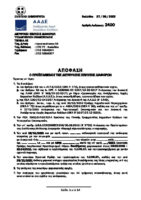
Greece vs “Clothing Distributor Ltd.”, June 2022, Administrative Tribunal, Case No 2400/2022
Following an audit, the Greek tax authorities determined that the remuneration of a Greek Clothing Distributor had not been determined in accordance with the arm’s length principle. On that basis an upwards adjustment of the taxable income was issued. An appeal was filed by “Clothing Distributor Ltd.” Judgment of the Tribunal The Tribunal dismissed the appeal and upheld the assessment issued by the tax authorities. “the findings of the audit, as recorded in the partial income tax audit report of 29/12/2021 of the C.E.M.E.P., on which the contested act is based, are considered valid, acceptable and fully justified” Click here for English translation Click here for other translation

Ukrain vs PrJSC “Poltava GZK”, June 2022, Supreme Court, Case No 440/1053/19
Poltova GZK is a Ukrainian subsidiary of the Ferrexpo group – the world’s third largest exporter of iron ore pellets. In FY 2015 the iron ore mined in Ukraine by Poltava GZK was sold to other companies in the group – Ferrexpo Middle East FZE, and the transfer prices for the ore was determined by application of the CUP method using Platts quotations. However, according to the tax authorities Poltava GZK used Platts quotations for pellets with a lower iron content when pricing the higher quality pellets, resulting in non arm’s length prices for the controlled transactions and lower profits in the Ukraine subsidiary. The tax authorities also found that Poltava GZK had overestimated the cost of freight – in the case of actual transportation of pellets by ships of different classes (“Panamax”, “Capesize”), the adjustment of the delivery conditions was carried out only at the maximum rate. On that basis an assessment was issued. Not satisfied with the assessment an appel was filed Poltova GZK, and in 2019 the Administrative Court and later the Court of Appeal set aside the assessment of the tax authorities. An appeal was then filed by the tax authorities with the Supreme Court. Judgment of the Supreme Court The Supreme Court partially annulled the decision of the Administrative Court and Court of Appeal and ruled predominantly in favor of the tax authorities approving the position that the transfer prices of the iron ore pellets did not correspond to the arm’s length price. The Court confirmed the validity of the tax assessment and the legality of the issued tax notice-decision regarding the reduction of the negative taxable income in an amount of 1.3 billion hryvnias (~$35 millions). The Court confirmed that the taxpayer did not take into account the actual properties of the products specified in the Quality Certificates, namely: the content of impurities (silicon dioxide) and the moisture level when pricing the controlled transactions. The court confirmed that the constant fluctuation of prices on the market of iron ore pellets is not a basis for comparing prices in CU with the average indicator in comparable operations for a certain period (month) without constructing a price range. Also, the taxpayer had overestimated the cost of freight. Click here for English translation Click here for other translation
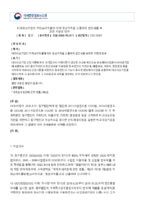
Korea vs “Semicon-sales”, June 2022, Tax Court, Case No 2020-서-2311
A Korean subsidiary (“Semicon-sales”) of a foreign group was active in distribution and sales of semiconductors for the automotive and industrial industry. Following an audit, the tax authorities found that the subsidiary had purchased semiconductors from a foreign affiliated company at a higher price than the arm’s length price. An assessment was issued where the the sum of the difference between the arm’s length price and the reported price had been included in the taxable income for FY 2015-2018. Both “Semicon-sales” and the tax authorities had applied the TNMM to find the arm’s length price, but the tax authorities had rejected the comparables selected by “Semicon” and replaced them with others. Not satisfied with the assessment “Semicon-sales” filed an appeal. Judgment of the Court The court remanded the case with an order to exclude from the benchmark comparables where the sales volume is significantly different from that of the “Semicon-sales”. Since the proportion of the taxpayers transactions with large companies is significant, the transaction stage, sales volume, customer, business environment should also be taken into consideration. Click here for English translation Click here for other translation
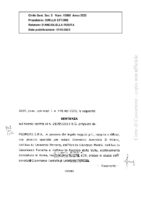
Italy vs Promgas s.p.a., May 2022, Supreme Court, Cases No 15668/2022
Promgas s.p.a. is 50% owned by the Italian company Eni s.p.a. and 50% owned by the Russian company Gazprom Export. It deals with the purchase and sale of natural gas of Russian origin destined for the Italian market. It sells the gas to a single Italian entity not belonging to the group, Edison spa, on the basis of a contract signed on 24 January 2000. In essence, Promgas s.p.a. performes intermediary function between the Russian company, Gazprom Export (exporter of the gas), and the Italian company, Edison s.p.a. (final purchaser of the gas). Following an audit for FY 2005/06, the tax authorities – based on the Transaction Net Margin Method – held that the operating margin obtained by Promgas s.p.a. (0.23% in 2025 and 0.06% in 2006) were not in line with the results that the company could have achieved at arm’s length. Applying an operating margin of l.39% resulted in a arm’s length profit of €4,227,438.07, for the year 2005, which was €3,426.803.00 higher than the profit declared by the company. Promgas s.p.a. appealed against the notice of assessment, which was upheld by the Provincial Tax Commission of Milan, with sentence no. 356/44/11, notified on 23/12/2011. The tax authorities then filed an appeal with the Regional Tax Commission of Lombardy which upheld the the tax authorities main appeal and rejected the company’s cross appeal. Promgas s.p.a. then filed an appeal with the Supreme Court Judgment of the Supreme Court The Supreme Court remanded the cast to the Regional Tax Commission of Lombardy Excerpts “…. 8.1. The failure to examine the facts put forward by the taxpayer company to oppose the set of comparables identified by the Revenue Agency resulted in a defect in the overall reasoning of the contested judgment, as denounced by the appellant company in its fifth and sixth grounds of complaint. 8.2. As is clear from the criteria indicated in the OECD Guidelines referred to above, in order for the application of the TNMM to be reliable, it is necessary to conduct an analysis of comparability that passes through the two moments of the choice of the tested party and the identification of the comparable companies, an identification that, under free market conditions (arm’s length principle), presupposes a “comparison” (internal or external) between the tested party and comparable companies that satisfies the five factors of comparability indicated by the OECD criteria (characteristics of goods and services functional analysis; contractual terms underlying the intra-group transaction; business strategies; economic conditions). It is through such a comparison that the factors that may significantly influence the net profit indicators (see paragraph 7.9 below) are identified on the basis of the facts and circumstances of the case. 8.3. Indeed, the reliability of such a method, according to the prevailing practice and interpretation, must pass through the following steps – selection of the tested party for the analysis; – determination of the financial results relating to the controlled transactions – selection of the investigation period; – identification of comparable companies; – accounting adjustments to the financial statements of the tested party and differences in accounting practices, provided that such adjustments are appropriate and possible; – assessment of whether adjustments are appropriate or necessary to take account of differences between the tested party and the identified comparable companies in terms of risks assumed or functions performed; – selection of a reliable profitability profit level indicator (so-called Profit Leverage/ Indicator, or PLI). 8.4. The CTR’s failure to verify the circumstances alleged by the taxpayer, resulted, in essence, in the pretermission of the comparability analysis for the selection of the TNMM applied to the case, and thus, of the procedure for the identification of comparable transactions and the use of relevant information to ensure the reliability of the analysis and the compliance of the PLI, or PLI, with the principle of free competition, or rather, the reliability of the selected TNMM. 9. The seventh ground of appeal – alleging breach of Article 6(1) of Legislative Decree 18/12/1997, no. The seventh ground of appeal – which alleges infringement of Article 6(1) of Legislative Decree No 472 of 18 December 1997, on the ground that the Regional Tax Commission held that the financial penalties applied by the Tax Office were lawful, erroneously excluding the existence of a ground of non-punishability, without specifically verifying the percentage of discrepancy between the amount declared by the company (0.23%) and the amount assessed by the Administration (1.39%) – is considered to be absorbed by the acceptance of the fifth and sixth grounds of appeal. 10. In conclusion, the appeal must be upheld limited to the fifth and sixth grounds of appeal, with absorption of the seventh and dismissal of the remainder. The judgment must be set aside in relation to the upheld grounds, with a reference back to the CTR, in a different composition, for a new examination of the merits of the dispute from the point of view of the standards of comparability relating to the method chosen and the penalty profile also in the light of the more favourable ius superveniens.” Click here for English translation Click here for other translation

Chile vs Avery Dennison Chile S.A., May 2022, Court of Appeal, Case N° Rol: 99-2021
The US group, Avery Dennison, manufactures and distributes labelling and packaging materials in more than 50 countries around the world. The remuneration of the distribution and marketing activities performed Avery Dennison Chile S.A. had been determined to be at arm’s length by application of a “full range” analysis based on the resale price minus method. Furthermore, surplus capital from the local company had been placed at the group’s financial centre in Luxembourg, Avery Management KGAA, at an interest rate of 0,79% (12-month Libor). According the tax authorities in Chile the remuneration of the local company had not been at arm’s length, and the interest rate paid by the related party in Luxembourg had been to low, and on that basis an assessment was issued. A complaint was filed by Avery Dennison with the Tax Tribunal and in March 2021 the Tribunal issued a decision in favour of Avery Dennison Chile S.A. “Hence, the Respondent [tax authorities] failed to prove its allegations that the marketing operations carried out by the taxpayer during the 2012 business year with related parties not domiciled or resident in Chile do not conform to normal market prices between unrelated parties..” “Although the OECD Guidelines recommend the use of the interquartile range as a reliable statistical tool (point 3.57), or, in cases of selection of the most appropriate point of the range “the median” (point 3.61), its application is not mandatory in the national tax administration…” “the Claimant [taxpayer]carried out two financing operations with its related company Avery Management KGAA, domiciled in Luxembourg, which contains one of the treasury centres of the “Avery Dennison” conglomerate, where the taxpayer granted two loans for US $3.200.000.- in 2010 and another for US $1.1000.000.- in 2011.” “In relation to the financial transactions, the transfer pricing methodology used and the interests agreed by the plaintiff have been confirmed. Consequently, Assessment No. 210, dated 30 August 2016, should be annulled and, consequently, this Tax and Customs Court will uphold the claim presented in these proceedings.” An appeal was then filed by the tax authorities. Judgment of the Court of Appeal The Court upheld the decision of the Tax Tribunal and set aside the assessment issued by the tax authorities. Excerpts “(…) Fourth: That the OECD regulations – while article 38 of the LIR was in force – should be understood as a guide with indications or suggestions for determining prices assigned between related parties with respect to those charged between independent parties. The aim is to eliminate distortions that may arise between companies with common ownership and to respect market rules. Notwithstanding the above recognition, Article 38 of the LIR regulated transfer prices and even though its normative content was minimal and insufficient to provide an adequate response on the matter, its text must be followed for the purposes of resolving the conflict in question, especially if one considers that the third paragraph of the provision states that when prices between related companies are not in line with the values charged between independent companies for similar transactions, “the Regional Directorate may challenge them, taking as a reference basis for such prices a reasonable profitability for the characteristics of the transaction, or the production costs plus a reasonable profit margin. The same rule shall apply with respect to prices paid or owed for goods or services provided by the parent company, its agencies or related companies, when such prices do not conform to normal market prices between unrelated parties, and may also consider the resale prices to third parties of goods acquired from an associated company, minus the profit margin observed in similar operations with or between independent companies”. The following paragraph adds that if the company does not carry out the same type of operations with independent companies, the Regional Directorate “may challenge the prices based on the values of the respective products or services on the international market (…) for this purpose (…) it shall request a report from the National Customs Service, the Central Bank of Chile or the bodies that have the required information”. It can be inferred from the transcribed rule that the use of external comparables is only authorised if the company does not carry out any type of transaction of goods and services with independent companies; that the challenge must be well-founded; and that the taxpayer and the SII are free to use the method that seems most appropriate to them as long as the legal requirements are met. It is also relevant to note that the domestic regulations at that date did not contemplate all the methods included in the OECD guidelines and it is inappropriate, under article 38 of the LIR, to resort directly to such guidelines in respect of situations not provided for in the domestic regulations, i.e., in relation to methods not included in the aforementioned provision. An interpretation contrary to the above would infringe the principle of legality of taxes or legal reserve, according to which only the law can impose, eliminate, reduce or condone taxes of any kind or nature, establish exemptions or modify existing ones and determine their form, proportionality or progress. Fifth: That the contested act shows that the method used by the SII for the entire period under review, business year 2012, corresponds to the so-called “Transactional Net Margin Method” for marketing operations, and the ” Comparable Uncontrolled Price Method” for financial operations, The Court therefore agrees with the findings of the lower court in grounds 22 to 25 of the judgment under review regarding the lack of the necessary grounds for the administrative act, in that the tax authority, although obliged to do so, omitted to analyse the transactions in accordance with the legislation in force at the date on which they were carried out…” Click here for English translation Click here for other translation
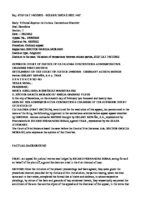
Spain vs Delsey España S.A, February 2022, Tribunal Superior de Justicia, Case No 483/2022 (Roj: STSJ CAT 1467/2022 – ECLI:ES:TSJCAT:2022:1467)
DELSEY España distributes and sells suitcases and other travel accessories of the DESLEY brand on the Spanish market and belongs to the French multinational group of the same name. The Spanish distributor had declared losses for FY 2005-2010 and was subject to a transfer pricing audit for FY 2011 to 2014. Based on the audit, the tax authorities concluded that the losses in FY 2005-2010 was a result of controlled transactions not being priced at arm’s length. The same was concluded for FY 2011 and 2012. The CUP method and RPM method applied by the taxpayer was found to be inappropriate and was replaced with the TNMM by the tax authorities. An appeal was filed by Delsey España S.A. Judgment of the Court The Court dismissed the appeal and upheld the assessment. Click here for English translation Click here for other translation
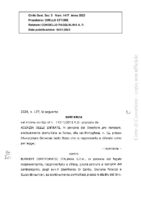
Italy vs Burckert Contromatic Italiana S.p.A., November 2021, Corte di Cassazione, Sez. 5 Num. 1417 Anno 2022
Burkert Contromatic Italiana s.p.a. is engaged in sale and services of fluid control systems. The italian company is a subsidiary of the German Bürkert Group. Following a tax audit, the Italian tax authorities issued a notice of assessment for FY 2007 on the grounds that the cost resulting from the transactions with its parent company (incorporated under Swiss law) were higher than the arms length price of these transactions. The company challenged the tax assessment, arguing that the analysis carried out by the Office had been superficial, both because it had examined accounting documents relating to tax years other than the one under examination (2007), and because the Office, in confirming that the Transactional Net Margin Method (TNMM) was the most reliable method, in order to verify whether the margin obtained by the company corresponded to the arm’s length value, had carried out a comparability analysis (aimed at identifying the net remuneration margin obtained by independent third parties in similar transactions), identifying only three comparables.. The tax authorities replied that the analysis carried out using the Transactional Net Margin income method, had revealed an average Return On Sales (R.O.S.) equal to 13.35 %, with the consequent ascertainment of the company’s higher profitability and the recovery for taxation of intra-group costs exceeding the normal value. The Provincial Tax Commission decided in favor of Burkert Contromatic Italiana s.p.a., noting that the choice of companies made by the tax authorities was completely different from that made by the company. In particular, they pointed out that the benchmark analysis carried out by the taxpayer, and attached to the appeal, had the objective of identifying independent companies operating in the national territory engaged in activities comparable to that of the taxpayer itself, i.e. commercial companies that purchased products from third-party suppliers and resold them on the national market to third-party customers; this comparison had indicated an average profitability of 4.85% compared to that ascertained by the Office of 10.26%. It also excluded that the Office had provided clear and irrefutable evidence of the methodology applied in the assessment. An appeal was lodged by the tax authorities, which complained of failure to state reasons or insufficient reasons on decisive facts and infringement of Article 110, paragraph 7, since the grounds of the judgment did not show the reasons in law justifying the acceptance of the appeal. The Regional Tax Commission rejected the appeal of the tax authorities. It held that there was no “omitted and/or grossly inadequate motivation on decisive and controversial facts” on the part of the judges at first instance and even less a violation of the provisions of Article 110, paragraph 7, of the TUIR. The tax authorities then filed an appeal with the Supreme Court. In the appeal the tax authorities stated that it is a clear case of motivation by reference, since the regional tax court confines itself to using vague and general formulas, stating that the judgment of the provincial tax court is “clear” and “well-founded”, without giving any reason to understand why the objections raised by the tax authorities to the judgment at first instance were unfounded and why the reasoning provided by the judge at first instance was shared. Judgment of the Supreme Court The Supreme Court decided in favor of the tax authorities. It set aside the judgment under appeal and referred the case back to the court of first instance, with a different composition. Excerpts “Referring to the judgment appealed against, the C.T.R. [Commissione tributaria regionale] limited itself to stating that the first judges, ruling on the benchmark analysis, “for the purpose of identifying the companies comparable to the appellant and the relevant interquartile range of market value”, carried out by the Office on the basis of a comparison with three companies, had concluded that the Administration had not offered irrefutable evidence of the methodology applied in the assessment. It did not, however, adequately explain either the reasons why it intended to adhere to the decision of the Provincial Tax Commission and, therefore, the reasons why the method used by the Office could not be considered reliable, or why the method used by the taxpayer company should be preferred, and it failed to examine the specific observations made by the Tax Office, which had clearly and exhaustively set out the methodology actually applied and the results of the audit. In so doing, it failed to explain whether the assessment made by the tax authorities deviated from the criteria that must guide the analysis of intra-group transactions aimed at ascertaining whether the taxpayer company complied with the arm’s length price by comparing it with similar transactions carried out by independent third party companies. The taxpayer’s defence is therefore not adequately argued and the overall reading of the judgment, which also includes the factual premise and the arguments put forward by the parties at the various stages of the proceedings, does not bear witness to an independent assessment by the appeal court because it does not allow for an understanding of the assessment made with regard to the transfer pricing analysis carried out by the Office.” Click here for English translation Click here for other translation
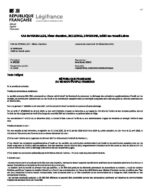
France vs BSA Finances, December 2021, Court of Appeal Versailles, Case No 20VE03249
In 2009, 2010 and 2011 BSA Finances received a total of five loans granted by the Luxembourg company Nethuns, which belongs to the same group (the “Lactalis group”). Depending on the date on which the loans were granted, they carried interest rates of respectively 6.196%, 3.98% and 4.52%. Following an audit covering the FY 2009 to 2011, the tax authorities considered that BSA Finances did not justify that the interest rates thus charged should exceed the average effective rates charged by credit institutions for variable-rate loans to companies with an initial term of more than two years. Hence, the portion of interest exceeding these rates was considered non-deductible pursuant to the provisions of Article 212(I) of the General Tax Code. In 2017, the Administrative Court ruled in favor of BSA Finances and discharged the additional corporate tax. But this decision was appealed by the authorities to the Administrative Court of Appeal which in June 2019 overturned the decision of the lower court. The Judgment from the Administrative court of Appels was then appealed by BSA Finances to the French Supreme Administrative Court. The Supreme Administrative Court overturned the decision from the Court of Appeal and remanded the case to the Court of Appeal. “In considering that the company had not established that the margin rates applied were in line with market rates for loans made under the same conditions, whereas the Riskcalc application, which it was not disputed was fed from the company’s balance sheets and profit and loss accounts over several years, had classified its level of risk as “BBB/BBB-” on the basis of comparative ratios established by Moody’s, that the refinancing contracts produced, which made it possible to determine the actual margin rate of the loans taken out by the applicant company itself, were accompanied by details making it possible to compare the main specific conditions with the clauses of the loans in dispute and that, lastly, the combination of these elements was such as to justify, in the absence of any element to the contrary, that the credit margins applied by Nethuns were in line with market practices, the Court distorted the documents in the file submitted for its assessment.” Judgment of the Court of Appeal The court ruled in favor of BSA stating that a scoring obtained by using automated tools such as RiskCalc is inherently less accurate than the actual rating a proper rating agency the fact such a scoring is less accurate does not mean that it can be disregarded systematically. in the absence of any valid criticism of the scoring by the tax authorities, it was an acceptable proof “10. After the Conseil d’Etat, in its decision of 11 December 2020, annulled the judgment of the Court of Appeal of 25 June 2019 on the grounds that the combination of elements attesting to a rating of the company’s risk by means of a publicly accessible financial tool, namely the RiskCalc software developed by the rating agency Moody’s, which it was not disputed was fed from the company’s balance sheets and profit and loss accounts over several years, and the syndicated contracts entered into with the company, which were not the subject of a complaint, was not sufficient to justify the decision, and the syndicated contracts concluded with financial organisations in 2010 and 2011 were such as to justify, in the absence of any evidence to the contrary, that the credit margins applied by Nethuns were in line with market practices, the Minister for Economic Affairs, The Minister of the Economy, Finance and Recovery reiterated his criticism of the RiskCalc software, arguing that it covers only a small fraction of the methodology used by the rating agencies, so that it provides only a measure of the probability of default that is meaningful only in relation to the scale of default probabilities created by the software itself. It questions the relevance of the model for entities such as SNC BSA Finances insofar as it is based on data from companies with gross assets of less than EUR 10 million, and is therefore not relevant to global groups. It also stresses the inadequacy of the information provided by the methodologies published by Moody’s regarding the adjustments allowed by the software and their potential impact on the rating, even though these adjustments may be significant, particularly in terms of taking into account the support of the parent company or the special treatment of shareholder loans. 11. However, on the one hand, SA BSA argues, without being challenged, that the ‘BBB/BBB-‘ ratings used correspond to a ‘conservative’ analysis based on ratings that are less downgraded than those of SNC BSA Finances with regard to the rating of its main partner, known as a corroborative economic analysis, so that, having itself made the necessary adjustments, the argument based on the failure to take account of the group’s support in determining the rating is, in any event, lacking in fact. The Minister does not mention, in detail, any other form of data restatement, in particular as regards a possible ‘special treatment of shareholder loans’, which would have been necessary in this case. On the other hand, SA BSA argues, again without being challenged, that if the model is established with regard to a sample drawn up by Moody’s showing the balance between small and large companies, it does not lead to an under-representation of the latter given their economic weight. Finally, in a more general way, it is certainly constant that the ratings obtained from tools of the trade make it possible to attribute a rating to a specific loan that is more approximate than a credit rating that could be carried out by a rating agency for a given borrower. Nevertheless, while SA BSA argues without being challenged that the use of a rating agency is not intended to apply, given its cost, in an intra-group transaction, the rating provided in this case by RiskCalc can be considered sufficiently reliable to justify the profile of SNC BSA Finances and
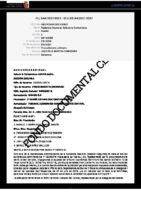
Spain vs MAHOU (SAN MIGUEL) S.A., December 2021, Audiencia Nacional, Case No SAN 5537/2021 – ECLI:ES:AN:2021:5537
The Mahou (SAN MIGUEL) S.A Group is active in brewing and sale of beers. Penibética de cervezas y bebidas SL and Andaluza de cervezas y bebidas SL are wholly owned by Cervezas Alhambra SL, which again is owned by MAHOU (SAN MIGUEL) S.A. The main activity of Cervezas Alhambra SL is the distribution and marketing under its own brands of the beer produced by its subsidiaries; that of Penibética de Cervezas y Bebidas SL is the production of beers which, without its own brand, are mainly distributed and marketed by Alhambra and the core activity of Andaluza de Cervezas y Bebidas S.L. is the manufacture of beers which, without its own brand, are distributed and marketed by Alhambra. In 2014, the tax authorities issued two tax assessments to the group: one in relation to FY 2008 and 2009, in the amount of €12,303,526.50 an another in relation to FY 2010, 2011, in the amount of €4,951,701.39. Among the issues raised in these assessments was transfer pricing. The CUP method used by the company was rejected by the tax authorities who instead applied the TNMM method. The tax authorities considered that the pricing of the sales made by Penibética de Cervezas y Bebidas S.L and Andaluza de Cervezas y Bebidas S.L to Cervezas Alhambra SL had been below market price, which could be due to fiscal reasons as the higher taxable income in Cervezas Alhambra SL could be offset by losses from previous years. Dissatisfied with the tax assessment Mahou S.A. filed a complaint which resulted in a decision in favour of the tax authorities. This decision was then appealed to the Audiencia Nacional. Judgment of the Court The National Court dismissed the appeal of Mahou in regards of transfer pricing and upheld the assessment of the tax authorities. Excerpts “As mentioned above, Cervezas Alhambra SL had significant BINs pending offsetting; they were generated in 1996 and subsequent years and at the start of the verification period amounted to 47,485,324.63 euros. And in the years 2010 and 2011 the declared tax bases of Cervezas Alhambra SL amounted to 8,953,184.43 euros and 8,213,717.51 euros. Tax Group 612/09, in which the related parties are taxed, has made the following offsets of tax losses from Cervezas Alhambra SL in years prior to its inclusion in the consolidated group: 2,884,427.23 euros (year of generation: 1996) 6,068,757.20 euros (year of generation. 1997) 2011: 6,781,618.18 euros (year of generation: 1997). Well, in the settlement, as a result of applying the TNMM to the transactions between related parties, the declared operating results are readjusted, increasing the results and bases declared by Penibética de Cervezas y Bebidas SL and Andaluza de Cervezas y Bebidas S.L in 2010 by €1,314,040 and €1,556,860 respectively, and correspondingly reducing the operating result and taxable base of Cervezas Alhambra SL in 2010 by €2,870,900. And here the problem lies in determining which is the (most appropriate) method for establishing the price of related-party transactions. Of the methods regulated in Article 16.4 TRLIS, the dichotomous positions in conflict here are, on the one hand, the CUP method, maintained by the appellant, and, on the other, the TNMM method applied by the Inspectorate. First of all, in the financial year prior to 2010, the TNMM was used to determine the transfer prices between related parties, although it is fair to recognise that in that year the transactions between Cervezas Alhambra and its subsidiaries were not included, since the fiscal group 612/09 had its first financial year in 2010. Be that as it may, Mahou, S.A. provided the Inspectorate with a series of transfer pricing reports of the companies of the group prior to the financial year 2010 carried out by Ernst & Young (manufacture of Cervezas Alhambra S.L. by Mahou S.A. and with San Miguel, Penibética de Cervezas y Bebidas S.L. with San Miguel, Cervezas Anaga S.A. with Mahou and San Miguel, purchase of Mahou branded beers and other brands manufactured by San Miguel and Cervezas Anaga and sale of beers manufactured by Mahou under the San Miguel brand to San Miguel and purchase of own branded beers manufactured by related entities and other brands manufactured by San Miguel and Cervezas Anaga and sale of own branded beers to related entities and sale of Mahou branded goods manufactured by Mahou S. A.) and in all of them the sale of Mahou branded goods manufactured by Mahou S. A. to San Miguel and sale of Mahou branded goods to San Miguel and sale of Mahou branded goods manufactured by San Miguel and Cervezas Anaga S.A. to San Miguel. A.) and in all of them the TNMM was used as it was considered the most appropriate to assess whether the brewing activities are in line with the arm’s length principle, using as an indicator of profitability the operating margin on total costs, selecting the brewing companies as the tested party. As regards the comparables used, Alhambra and Penibética use the AMADEUS and SABI databases, selecting five comparable European brewing companies, using data for 2006, 2007 and 2008. Well, even hypothetically admitting that the use of the TNMM in previous years cannot condition the valuation of the transactions between Cervezas Alhambra and its subsidiaries because in those years they were not included and therefore were not analysed in the reports, we must agree with the Inspectorate that with the information available this is the methodology that allows the transfer prices of brewing operations to be assessed, while the use of the CUP method is unacceptable. In fact, in the report A-02 (in section A.3.d) as well as in the non-conformity report (3.3 d/) and in section 4 of the pricing report of the operations of Penibética, Andaluza and Alhambra, the reasons for opting for this method are sufficiently justified, having used to select the comparable samples those that meet the requirements of activity and independence in accordance with the OECD guidelines obtained from the internationally accredited AMADEUS database. At the same time, the Inspectorate rejects the CUP method in
Poland vs “P. sp. z o.o.”, December 2021, Supreme Administrative Court, Case No , II FSK 2360/20
The tax authority found that P.sp. z o.o. had understated its income from sales to related parties in the P. Group. The tax authority selected three comparable independent wholesalers and established a range of profit margins between 4.02% and 6.24%. As P. sp. z o.o. had a profit margin of only 2.84% on its wholesale activities, an adjustment was made to the taxable income. A complaint was filed by “P. sp. z o.o.” with the Administrative Court, which was dismissed, and an appeal was then filed with the Supreme Administrative Court. Judgment of the Supreme Administrative Court. The the Supreme Administrative Court, annulled the appealed decision in its entirety and ordered – when re-examining the case – the tax authority to follow the interpretation of the law made by the Supreme Administrative Court. In a very comprehensive judgment, the Court ruled on a wide range of issues, including Whether and how to take into account income received for other activities (marketing services) when determining the arm’s length income. The choice and application of transfer pricing methods The objectives and standards of a compability analysis and benchmarking study conducted by the tax authority The use of statistical methods (IQR) when the number of comparables in a benchmark is limited. Click here for English translation Click here for other translation
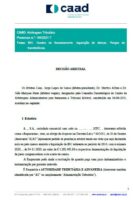
Portugal vs “Welding Mesh SA”, December 2021, CAAD Tax Arbitration, Case No 194/2021-T
A Portuguese subsidiary – A SA – had received intra group loans in foreign currency and had various other transactions with foreign group companies. The tax authorities claimed that the pricing of the transactions had not been at arm’s length and that the interest payment and exchange losses on the loans were not tax deductible. Decision of CAAD The CAAD set aside the assessment and decided in favour of “Welding Mesh SA” Click here for English translation
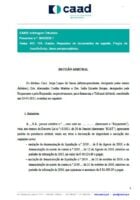
Portugal vs “FURNITURE S.A.” No II, November 2021, CAAD, Case No 604/2021-T
Furniture S.A is engaged in the production and sale of furniture and had established a US subsidiary to market and sell furniture overseas. The pricing of the controlled transactions with the US subsidiary had been based on a resale price method, which resulted in prices amounting to 70% of the list price for the products. The Portuguese tax authority issued an assessment for FY 2015 and 2016, where the pricing of the controlled transaction had been adjusted in accordance with the price list resulting in additional taxable profits. Result reached in the arbitration tribunal. The Tribunal set aside the additional assessment of income in respect of the transfer pricing adjustment. Excerpts “…In the contract concluded with E… the Claimant safeguarded direct sales to large customers (with volume to fill a given number of containers). In practice, despite this safeguard, it is apparent from the evidence produced that the only major customer in the US since then has been E… and, in particular, no business was conducted with any major US customer in the years 2015 and 2016. Therefore, it is not possible to identify, as there is no internal comparable in the transactions carried out by the Claimant with unrelated entities in the US market. In fact, the comparable used by the Tax and Customs Authority are the list prices of direct (end) customers of the Claimant, in relation to which the comparability factors required for the application of the transfer pricing regime are not demonstrated, namely the comparable market price method used by the Tax and Customs Authority. In fact, to compare commercial transactions carried out with wholesalers (on the one hand) with transactions carried out with retailers and direct addressees (on the other hand), is to compare substantially different realities, since the intervention of wholesalers in the marketing circuit necessarily implies that prices are charged that ensure them a profit margin, which does not occur in sales made directly to retailers. Indeed, it is unsustainable, from an economic point of view, that, in purchases from the Plaintiff for subsequent resale to retailers, an independent wholesale intermediary would accept a price that would not allow it to remunerate itself with a margin (aimed at covering its costs plus a remuneration). Therefore, it cannot be considered proven that the price that would be charged between the Claimant and E…, if the latter were an independent wholesaler, would be the price charged by the Claimant with retailers. On the other hand, the quantities sold by the Claimant to E… are different (much higher) than those sold to other direct customers of the Claimant in the US market and the quantity of goods sold is one of the factors “likely to influence the price of the transactions” expressly provided for in paragraph a) of no. 5 of Ordinance no. 1446-C/2001. Furthermore, the conditions under which marketing is carried out are also different, as none of the operations carried out with direct retail customers were subject to the conditions agreed in the contract entered into between the Claimant and E… and “the contractual terms and conditions that define, explicitly or implicitly, the manner in which responsibilities, risks and profits are shared between the parties involved in the operation”, are comparability factors that sub-paragraph b) of article 5 of Ordinance 1446-C/2001 requires to be weighed. In this context, it must be taken into account that the deferral of payment allowed to a wholly owned entity does not imply bearing an economic risk similar to that inherent to transactions with independent entities. In this context, as there are unique characteristics in the transactions of the Claimant with E…, the lack of adequacy of the comparable market price method is evident, as it “requires the highest degree of comparability with incidence both on the object and other terms and conditions of the transaction and on the functional analysis of the intervening entities” (article 6, no. 1, of Ministerial Order no. 1446-C/2001). This lack of appropriateness of the comparable market price method is confirmed by paragraph a) of no. 2 of the same article 6 of Ministerial Order 1446-C/2001, from which it follows that, as regards the use of internal comparables, this method cannot be used when there is no “transaction of the same nature having as its object an identical or similar service or product, in like quantity or value, and under substantially identical terms and conditions, with an independent entity in the same or similar markets”. Lastly, it should be emphasised that, as tax arbitration proceedings are an alternative to judicial review proceedings (Article 124(2) of Law 3-B/2010 of 28 April 2010), they are, like the latter, a procedural means of mere legality which aims to eliminate the effects produced by illegal acts, annulling them or declaring their nullity or non-existence [Articles 2 of the RJAT and 99 of the RJAT]. Therefore, the acts must be assessed as they were performed. Therefore, it is not in question to assess whether the application by the Claimant of the transfer pricing regime (for example, in relation to the use of the Minimum Resale Price Method provided for in article 7 of Ministerial Order no. 1446-C/2001) was correct or not, but to determine whether the corrections made by the Tax and Customs Authority have legal support. In the case at issue, the corrections are illegal due to an error in the choice of the comparable market price method and its application to a situation in which the legal requirements for its application are not met. Therefore, it must be concluded that the corrections made by the Portuguese Tax and Customs Authority based on the transfer pricing system are vitiated by error on the assumptions of law. This error justifies the annulment of the corrections, under the terms of article 163, no. 1, of the Administrative Procedure Code, applicable subsidiarily under the terms of article 2, paragraph c), of the LGT. The request for arbitral award regarding these corrections being granted, the knowledge of the remaining defects imputed to
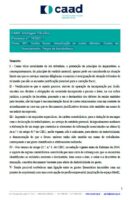
Portugal vs “FURNITURE S.A.” No I, November 2021, CAAD, Case No 14/2021-T
Furniture S.A is engaged in the production and sale of furniture and had established a US subsidiary to market and sell furniture overseas. The pricing of the controlled transactions with the US subsidiary had been based on a resale price method, which resulted in prices amounting to 70% of the list price for the products. The Portuguese tax authority issued an assessment, where the pricing of the controlled transaction had been adjusted in accordance with the price list resulting in additional taxable profits. Result reached in the arbitration tribunal. The Tribunal set aside the additional assessment of income in respect of the transfer pricing adjustment. Excerpts “… The application of the principle of comparability must be based on an individual analysis of the transactions, with a view to comparing the conditions practiced in a transaction between related entities and those practiced between independent entities. As it results from the matter of fact given as settled, the creation by the Claimant of a subsidiary based in the United States of America was determined by the bankruptcy of its main US customer and had the purpose of maintaining and boosting the commercial relationship with that market and minimizing the costs of local transportation, storage and packaging of the products sold to retailers and the agency of local intermediaries. The contract for the supply of products and goods entered into between the Claimant and the subsidiary sets out precise rules regarding the commercial relationship established between the parties and the charges that each of the contracting parties assumes in relation to the marketing of the furniture manufactured by the Claimant (clauses five and six). The same contract expressly contemplates the possibility of the direct sale of the products and goods to other customers residing in the United States of America without prior authorisation of the subsidiary (clause four). In this context, the invoicing of the supplies made to the subsidiary for 70% of the price list practiced in the sales directly made by the Applicant in the North American market constitutes a reasonable profit margin, which is intended not only to remunerate the activity of reselling the products, but also to compensate the marketing costs incurred by the counterparty and to which it is contractually bound. It is not possible to consider, under this condition, that the Claimant violates the arm’s length by stipulating, in relation to its subsidiary, a lower price than that practiced in direct sales, when it is certain that the comparison established by the Tax Authority is made with the direct clients of the Claimant without considering the comparability factors between the tied and the non-tied operations, namely with regard to the contractual terms and conditions that define how responsibilities, risks, and profits are shared between the parties involved in any of those operations. Therefore, regardless of the most appropriate method for determining transfer prices, the tax correction, in this regard, proves to be illegal due to the incorrect interpretation and application of the transfer pricing regime by the Claimant.” Click here for English translation. Click here for other translation
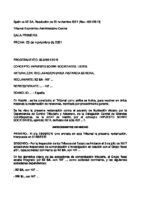
Spain vs “Benchmark SA”, November 2021, TEAC, Case No Rec. 4881/2019
The tax authorities excluded some of the entities selected by the taxpayer in a benchmark study, as it considered that they did not meet the necessary comparability requirements, and also included some of the excluded entities, as it considered that they were comparable. These modifications to the benchmark resulted in a variation of the arm’s length range, with the margin earned by the taxpayer falling outside the range. The taxpayer argued that the recalculation of market value should be based on a complete new analysis to replace the one provided by the entity. In relation to the rejection of certain comparables, the taxpayer argued that the information used by the tax authorities and consulted on the internet was not available at the time the transfer pricing documentation was prepared. Judgment of the TEAC The TEAC rejected the claim filed by the taxpayer and upheld the assessment of the tax authorities. It is not necessary to carry out a new economic analysis to replace the one provided by the entity, given that the inspection accepts said analysis, and what it limits itself to is correcting the defects present in the same. It is considered reasonable for the inspectorate to apply a rejection criterion based on the number of employees, taking into account that the taxpayer has more than 200 employees on its payroll and that the claimant applied other rejection criteria in order to ensure comparability of the size of the companies. It is understandable that the administration uses the information contained in the websites of the companies selected as comparable at the time of the inspection, it is quoted “as it could not be otherwise”. The TEAC refers to the OECD Guidelines on Transfer Pricing for Multinational Enterprises and Tax Administrations, which stress the importance of verifying the information obtained in the databases. The inspection is justified in making the adjustment to the median because the Administration has revealed comparability defects in the benchmark provided by the taxpayer in the economic analysis. Click here for English translation Click here for other translation
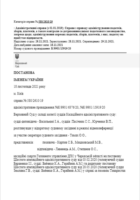
Ukrain vs Totland LLC, November 2021, Supreme Court, Case No 580/2610/19
Following a tax audit of controlled transactions in 2013 and 2015 for the sale of goods to foreign related parties, the tax authorities concluded that Totland had understated the price of the goods sold and thus its taxable income. On that basis an assessment of additional income tax was issued. Totland disagreed with the assessment and filed an appeal. Totland stated that the dates of the price information used by the tax authorities differed from the date of the controlled transactions in question, and furthermore that those uncontrolled transactions were carried out on different terms. Totland had based the pricing of the controlled transactions on stock exchange prices and noted that the tax authorities in the assessment had violated the requirements of the Tax Code of Ukraine by applying stock exchange prices established a decade before the controlled transactions were carried out. The District Court dismissed Totland’s claim and upheld the assessment. Later the Court of Appeal overturned the decision of the District Court and decided in favor of Totland. The Court of Appeal concluded that the uncontrolled transactions on which the pricing and assessment had been based were not comparable with the controlled transactions. An appeal was then filed by the tax authorities with the Supreme Court. Judgment of the Court The Supreme Court dismissed the tax authorities appeal and upheld the decision of the Court of Appeal. According to the Resolution of the Cabinet of Ministers of Ukraine dated 08 September 2016 No. 616 “On Approval of the List of Exchange Traded Goods and World Commodity Exchanges for determining the compliance of the terms of controlled transactions with the arm’s length principle”, the compliance of the terms with the arm’s length principle is determined by the CUP method. The components of this method are: use of the price range for stock exchange quoted goods; consideration of the volume of the controlled transaction, payment and delivery terms; consideration of the quality characteristics of the goods and the costs of their transportation. The provisions of sub-clause 39.2.1.3 of clause 39.2 of Article 39 of the Tax Code of Ukraine are special for controlled transactions on export and/or import of goods that have a stock exchange quotation and are included in the list approved by the said resolution. Sources of information on stock exchange quotations, criteria for comparability of controlled and uncontrolled transactions are determined in accordance with subparagraphs 39.5.3.1, 39.2.2 of Article 39 of the Tax Code of Ukraine. In the judgment the Supreme Court refers to its prior ruling in case No. 804/5360/17, where the Supreme Court, applying the provisions of the above subparagraphs of Article 39 of the Tax Code of Ukraine, concluded that the tax authority in determining the price range for controlled transactions of commodities must verify the reliability of the information sources used; the terms of uncontrolled transactions with the terms of controlled transactions; the compliance of the prices selected for comparison in comparable uncontrolled transactions with the terms of controlled transactions. Click here for English translation Click here for other translation
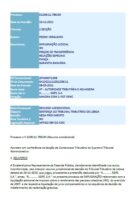
Portugal vs “A Bank SGPS, S.A.”, November 2021, Supremo Tribunal Administrativo, Case No JSTA00071308
The Tax Authority had made a transfer pricing adjustment for FY 2007 in the amount of €262,500.00 arising from the provision of a guarantee for payment granted under a credit agreement between a bank and its subsidiary. The adjustment had been determined using a CUP method where the pricing of the controlled transaction had been compared to the pricing of uncontrolled bank guarantees. The Court of first instance held that “it cannot be concluded that the transactions at issue here are comparable on the basis of the criterion adopted by the Tax Authorities referred to above. In fact, although the guarantee and the independent bank guarantee may share common features, the way in which the risk falls on the guarantor and on the guarantor of the independent bank guarantee potentially generates differences that significantly affect their comparability.” An appeal was filed by the tax authorities. Decision of Supreme Administrative Court The Court dismissed the appeal of the tax authorities. In accordance with article 58 of the CIRC (wording at the time of the facts), the AT could make the corrections that are necessary for the determination of the taxable profit whenever, by virtue of special relations between the taxpayer and another person, subject or not subject to IRC, different conditions have been established to those that would normally be agreed upon between independent persons, leading to the profit ascertained on the basis of accounting being different from that which would be ascertained in the absence of such relations. The Tax Authority has the burden of proving the existence of those special relations, as well as the terms under which operations of the same nature normally take place between independent persons and under identical circumstances, and the act must be annulled if that proof is not provided, which means that the correction referred to in Article 58 of the CIRC cannot therefore be based on indications or presumptions, the AT having to prove the abovementioned legal requirements in order to be able to correct the taxpayer’s taxable amount under that regime. The provision of a guarantee by the Defendant constitutes a situation that has no equivalent between independent entities, since this type of provision is proper of related entities and to that extent there is no term of comparison between the situation of a guarantee provided by a bank and the guarantee provided by the dominant company in favour of its subsidiary and as follows from the provisions of article 6, paragraphs 1 and 3 of the Commercial Companies Code, the provision of real or personal guarantees for the debts of other entities is, as a general rule, considered to be contrary to the pursuit of the company’s purpose (profit), and operations relating to the provision of (remunerated) guarantees may only be carried out by credit institutions and financial companies. Bearing in mind the fact that the bank guarantee has its own characteristics that differentiate it from the guarantee, as profusely explained in the judgment appealed against, leads us to conclude that the conditions for the provision of a bank guarantee by a banking institution cannot serve as a model of comparison for the purpose of determining the remuneration to be fixed for the guarantee provided by the Appellant since the two transactions are not sufficiently comparable, in accordance with the provisions of Article 4(3) of Order in Council No 1446-C/2001, particularly since part of the benefits which the defendant expects to gain from the provision of the guarantee in favour of its subsidiary arise from its status as a shareholder, a situation which has no economic equivalent in the case of the provision of a bank guarantee by a bank. Furthermore, for a transaction to be considered comparable it must have economic characteristics similar to those of non-binding transactions. It therefore “it seems unquestionable that the assumption of a payment guarantee by the parent company (for the debts of a controlled company) does not alter, in a significant manner, the liability regime already applicable to it by virtue of the provisions of articles 501 and 491 of the Commercial Companies Code. In summary, in view of the reality of the situation in the case, the conclusion of the sentence appealed must be followed in the sense that, in view of what article 58, nos. 1 and 2, of the Corporate Income Tax Code and article 5 of Ministerial Order no. 1446-C/2001 establish as regards the liability regime of the company in question, the conclusion of the sentence appealed must be followed. no. 1446-C/2001 establish as to the factors to be assessed in order to ascertain the comparability of the transactions, we conclude that the Tax Authorities failed to demonstrate that, in the specific case, the provision of the guarantee by the Impugnant and the provision of autonomous bank guarantees whose expenses were borne by the Impugnant meet the conditions to be considered comparable, as they present relevant economic and financial characteristics that are sufficiently similar, and ensure a high degree of comparability, so as to correct the taxable amount through the transfer pricing regime provided for in article 58, no. 1, of the IRC Code. Click here for English translation Click here for other translation
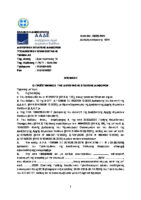
Greece vs “Diary Distributor Ltd.”, November 2021, Administrative Tribunal, Case No 579/2021
This case deals with arm’s length remuneration of a Greek Diary Distributor. Following an audit of “Diary Distributor Ltd.”, the Greek tax authorities determined that the prices paid to related parties for FY 2017 had been above the arm’s length price. On that basis an upwards adjustment of the taxable income was issued. An appeal was filed by “Diary Distributor Ltd.” Judgment of the Court The court dismissed the appeal of “Diary Distributor Ltd.” and upheld the assessment of the tax authorities Click here for English translation Click here for other translation
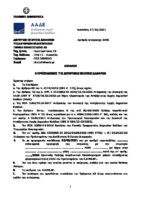
Greece vs “CUP Ltd.”, October 2021, Administrative Tribunal, Case No 3495/2021
This case deals with the choice of transfer pricing method. Following an audit, an upwards adjustment of the taxable income was issued by the tax authorities. The adjustment was based on application of the cost plus method instead of the CUP method as had been chosen by the company. The company disagreed with the assessment and filed an appeal with the tax court. Judgment of the Tax Court The Tax Court allowed the appeal and set aside the assessment of the tax authorities due to lack of statement of reasons for choosing another transfer pricing method. Excerpt “Because the provisions of Article 17 §§§1,2 of the Code of Administrative Procedure (Law 2690/1999) entitled ‘Reasons’ set out the following: “1. The individual administrative act must contain a statement of reasons, which must include a statement of the existence of the legal requirements for its issuance. 2. The statement of reasons must be clear, specific, adequate and must be apparent from the information on the file, unless it is expressly provided by law that it must be contained in the body of the act’. It follows from the combination of the above provisions that the audit report, which constitutes the statement of reasons for the act imposing the tax, must be clear, specific and sufficient. The purpose of the statement of reasons is to enable both the taxpayer and the Court of Justice to verify whether the administrative act was adopted for the benefit of the taxpayer and whether it complies with or is in conformity with the rules of law which define the framework of legality (cf. Epaminondas Spiliotopoulos, Administrative Law Manual, § 5.Reasons for the administrative act). According to case law, the complete vagueness of the Audit Report is equivalent to its non-existence (see CoE 565/2008, 2054/1995). Because, as is clear from the relevant Audit Report (pp. 48-49), in this particular case, the audit rejected the method of the comparable uncontrolled price (CUP), without indicating whether it was possible to maintain this method but with reasonable adjustments. Since in view of the above, the Final Income Tax Adjustment Act No. …………./2020 of the Head of the C.E.M.E.P., for the tax year 2014 is held to be formally defective and therefore void.” Click here for English translation Click here for other translation
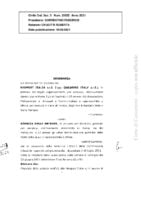
Italy vs NEOPOST ITALIA s.r.l. (QUADIENT ITALY s.r.l.), September 2021, Supreme Court, Case No 25025/2021
Neopost Italia s.r.l. had paid service fees and royalties to its French parent. Following an audit, deductions for these intra-group transactions was adjusted by the tax authorities due to non compliance with the arm’s length principle and lack of documentation. However, for the purpose of determining an arm’s length remuneration a benchmark study had been performed by the tax authorities in which one of the comparables was not independent. The Court of Appeal upheld the decision of the tax authorities. Judgment of the Supreme Court The Supreme Court set aside the decision of the Court of Appeal and remanded the case to the court of first instance. In regards to the comparable company in the benchmark that was not independent, the Supreme Court found that: “it is entirely arbitrary, in comparing the two companies, to assert that the price charged by one of the two is the market price while the other is not”; this is a ruling that affects the unlawfulness of the method used by the Office (or, rather, the identification of the comparator), which is a prerequisite for the tax assessment.” In regards to the plea of “failure of the Court of Appeal to examine decisive facts of the case” the Supreme Court found that this was not grounds for setting aside a judgment: “…failure to examine the evidence does not in itself constitute a failure to examine a decisive fact if the historical fact relevant to the case was nevertheless taken into consideration by the court, even though the judgment did not take account of all the evidence. “…the reasoning, albeit brief, exists and is legitimately made by reference to the judgment of the first instance, while the impeachment does not even identify the historical fact whose examination was omitted by the appeal judge.” Click here for English translation Click here for other translation
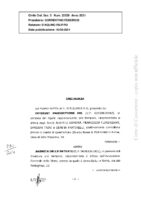
Italy vs INTERVET PRODUCTIONS SRL, January 2021, Corte di Cassazione, Case No 22539/2021
Intervet Productions SRL, a company resident in Italy, manufactures veterinary medicines and supplements. The Italian tax authorities issued a notice of assessment, relating to the 2004 tax year. In that notice, the tax authorities ascertained the inconsistency of the transfer prices concerning the sale of certain goods to a related party in Germany. For the determination of the transfer prices, the taxpayer had used two methods: the resale price method, for products subject to mere marketing, and the cost-plus method, for products subject to further processing by Intervet. The tax authorities had used the CUP method for the purpose of the adjustment. Intervet appealed against the assessment, contesting the comparability of the products compared by the tax authorities but lost in the proceedings on the merits An appeal was then filed with the Supreme Administrative Court. Judgment of the Supreme Administrative Court The Court set aside the assessment. The Court stated that the tax authorities has to prove that the transactions, put in place by the taxpayer, would have generated greater taxable income if they had been conducted between third and independent parties, pursuant to Article 9(3) of the TUIR. In identifying the methods for determining transfer prices, the tax authorities must follow the indications contained in the OECD Transfer Pricing Guidelines and choose the method that is most appropriate in relation to the concrete case. The Court notes that in the judgment under appeal the functional analysis relating to the competing company was completely disregarded, since no assessment was made of the comparability and economic function performed by the latter. It is also noted that no reasons were given as to why the method applied by the taxpayer should be considered inadequate compared to the price comparison method applied by the Agency. Excerpts “…..” Click here for English translation Click here for other translation
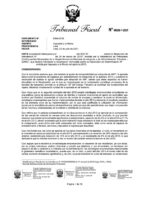
Peru vs “TP-Packaging”, July 2021, Tax Court, Case No RTF 06526-1-2021
“TP Packaging” is mainly engaged in the marketing of packaging materials, which in 2013 required a number of goods and services provided by its related companies. The transfer pricing analysis of the controlled transactions was carried out with “TP Packaging” as the tested party. The transactional net margin method (TNMM) was applied using the profitability indicator ROS (return on sales) and external comparables (eleven comparables). “TP Packaging”‘s financial information for the years 2011 to 2013 was used but certain adjustments had been made to the 2013 financial results. The results showed that “TP Packaging”‘s profitability in 2013 was within the interquartile range. The tax authorities agreed with the study presented in the transfer pricing analysis. However, they did not accept the use of multi-year financial information (years 2011 to 2013) and the adjustments made to the financial results. As a result, “TP Packaging”‘s profitability in 2013 was now below the interquartile range. A transfer pricing adjustment was therefore made to the median, which resulted in an assessment of additional taxable income. Not satisfied with the assessment, “TP Packaging” appealed to the Tax Court. Decision of the Tax Court The Court upheld the assessment issued by the tax authorities and dismissed the appeal of “TP Packaging”. Excerpts “It should be reiterated that the purpose of the accounting adjustment referred to by the appellant was to prepare and present its financial statements in accordance with the IFRS accounting standard, this not having been an aspect taken into account in the search for and selection of comparable companies, given that independent companies were identified as such which adopted in some cases a different accounting standard (US GAAP) and in others the same accounting standard (IFRS), it is therefore not apparent that the exclusion of the accounting adjustment referred to by the appellant helped to improve comparability with the abovementioned companies, the argument that the comparable companies did not make an accounting adjustment to their financial information is not a valid reason, since, as mentioned above, the exclusion of that accounting adjustment would mean that the appellant’s financial information would no longer be shown in accordance with IFRS, which would be justified in the transfer pricing analysis if it were intended to bring the appellant’s accounting standard, as the party under analysis, into line with the accounting standards used by the independent third parties selected as comparable, which has not been verified in the present case. On the other hand, the transfer pricing analysis under the application of the TNM method performed by the submitted study, as well as the analysis performed by the Administration, used the financial information of the Appellant’s complete financial statements as the examined part, i.e. both parties considered it appropriate for the comparability analysis not to segment the Appellant’s financial information (which excludes income and expenses not related to the related transactions under examination)”, Therefore, the Appellant’s claim that the accounting adjustment for the adoption of IFRS relates to other transactions (machine leases) and that its exclusion for the transfer pricing analysis would therefore improve comparability with the independent companies selected as comparables is not supportable. From the foregoing, it is established that the relevance of the comparability adjustment proposed by the appellant (exclusion of the accounting adjustment for the adoption of IFRS) for the purposes of the transfer pricing analysis is not substantiated, and therefore the rejection by the Administration of said adjustment is in accordance with the law.” Click here for English Translation Click here for other translation
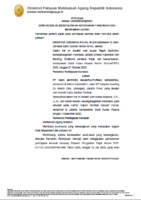
Indonesia vs PT Hino Motors Manufacturing Indonesia, July 2021, Supreme Court, Case No. 1806 B/PK/PJK/2021
PT Hino Motors Manufacturing Indonesia is a subsidiary of a Chinese Group in the automotive industry. Following an audit, the tax authorities issued an assessment for FY 2015 where the benchmark that had been used to determine the income of PT Hino Motors was dismissed and replaced with another. According to the tax authorities Hino Motors had not been subjected to the same economic conditions as the comparables in benchmark provided by the company The Company disagreed and brought the case to the Tax Court where, in a decision issued 11 November 2020, the court set aside the assessment. An appeal was then filed by the tax authorities with the Supreme Court. Judgment of the Supreme Court The Supreme Court ruled in favor of PT Hino Motors and upheld the decision of the Tax Court to set aside the assessment. Excerpts “(…) – That the correction of Corporate Income Tax for Fiscal Year 2015 with a positive correction on the positive fiscal adjustment item amounting to Rp127,749,174,678.00 cannot be maintained, because the positive correction on the positive fiscal adjustment item that has been calculated by the Appellant to its affiliated parties has fulfilled the principles of reasonableness and business prevalence; – The selection of the Appellant’s four comparables in terms of characteristics and function is closer to the Appellant’s business function. The five-year multi-year period (2011-2015) was appropriate because using a three-year multi-year period as the Appellant did was not appropriate because in 2013-2014 the economy in the automotive sector was in a state of declining sales; – The fact that the impact of foreign exchange rates (forex adjustment) in 2013 did not affect the Appellant’s condition because most of the Appellant’s companies were located in China where the fluctuations in the CYN economy did not have a major effect; (…) – That based on the transfer pricing analysis with 11,4,6 and 13 comparators as a whole, the weighted average value of the Appellant’s ROTOC for 2011-2015 of 3.72% was always between the weighted average inter quartile ranges of the comparable companies for 2011-2015. Thus, it can be concluded that the Appellant’s controlled transactions were in accordance with the arm’s length principle; Based on the above considerations, the request for reconsideration filed by the Applicant is unwarranted and must be rejected; (…)” Click here for English Translation Click here for other translation
Kenya vs Oracle Technology Systems (Kenya) Limited, December 2021, Tax Appeals Tribunal, Appeals No 149 of 2019
Following an audit of Oracle Technology Systems (Kenya) Limited, a distributor of Oracle products in Kenya, the tax authority issued an assessment for FY2015-2017 relating to controlled transactions. In assessing the income, the tax authority had used a CUP method instead of the TNMM. Dissatisfied with the assessment, Oracle Technology Systems (Kenya) Limited appealed to the Tax Appeals Tribunal on the basis that the return on its related party transactions was at arm’s length and did not require adjustment. Judgment of Tax Appeals Tribunal The Tribunal referred the case back to the tax authority for an appropriate reassessment. Excerpts “The question that arises is which method was the most suitable one. The OECD TP Guidelines state that the preferred method is CUP. But this only applies where there are appropriate comparables. Internal comparables are of course always preferred where they are reliable or can be reliably adjusted. From our understanding, the TP Policy implied that the reason internal comparables could not be used was due to differences in the functions of the independent distributors as compared with those of the Appellant. 127. We however note that during the hearing and in its submissions, the Appellant went out of its way to show that its functions are routine and not much different from those carried out by other distributors. The Appellant for example states in Paragraph 76 of its Statement of Facts as follows:- ‘The Appellant would like to note that the IT industry itself is a very competitive market and that the Appellant’s functional profile is not different from other value-added distributors in the same competitive market … ” 128. Similarly, the expert witness Dr Neighbour stated in his review of the Appellant’s role as a distributor as thus:- “In my experience, these are standard functions that would be expected of a typical distributor, i.e one that provides some local sales and marketing activity to support the sales as well as provision of customer support and services in respect of the distributed products … “ 129. The arguments offered by the Appellant seem to imply its functions are no different from any other distributor. This seems to contradict what its TP Policy suggests that the reasons it could not use the internal comparables was because the functions carried out by the Appellant and the independent distributors were different and could not be reliably adjusted. 130. If indeed as the Appellant and its expert witness suggests its functions are routine and much in line with those of other distributors in the industry, we are at a loss as to why the internal comparables could not be used, and where such internal comparables were available why the CUP method which as both parties have admitted is the preferred method could not be used. (…) 132. It is unclear to the Tribunal both from the Appellant’s and the Respondent’s arguments and the documentation made available whether the Appellant is indeed a routine distributor as it averred during the hearing or if the services it offers are distinct as stated in the TP Policy. 133. Accordingly, we are of the view that the matter ought to be referred back to the Respondent to carry out a proper audit and in particular a functional analysis to determine what the exact functions of the Appellant are and if these are fundamentally different from those of independent distributors. Only then is it possible to determine the proper method to be applied.” ”]
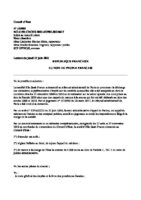
France vs SARL Elie Saab France, June 2021, Conseil d’État, Case No 433985
The French tax authorities had issued an assessment to SARL Elie Saab France in which they asserted that the French subsidiary had not been sufficiently remunerated for additional expenses and contributions to the value of the SARL Elie Saab trademark. The Supreme Administrative Court upheld the decision of the tax authorities. “It is clear from the statements in the judgment under appeal that the company Elie Saab France is responsible for the management, manufacture and distribution for the Elie Saab group of the top-of-the-range daywear line, distributes “Elie Saab” brand accessories for all the group’s entities, as well as the distribution in France and for European customers of the haute couture line, and sells, in its Paris boutique and to boutiques distributing the brand worldwide, a line of evening wear and accessories developed by the group’s Lebanese subsidiary. In addition, Elie Saab France has a showroom in the Paris boutique to present the brand’s haute couture creations, for which it pays the rent and the property fittings as well as the staff costs. Finally, it is responsible for organising the fashion shows of the “Elie Saab” brand for the haute couture and ready-to-wear collections, and is in charge of the brand’s communication and promotional campaigns. Considering that the French company, which has been largely loss-making since its first financial year ended in 2002, was incurring expenses for the benefit of the group as a whole and not for its own activity, the tax authorities reinstated, on the basis of Article 57 of the General Tax Code, in the taxable results of the financial years ended from 2007 to 2010 the amount of expenses related to the promotion of the “Elie Saab” brand and the organisation of fashion shows that had not been re-invoiced to the Lebanese parent company, a margin of 5% for those expenses that had been re-invoiced at cost price, as well as the personnel expenses of the press department.” “Firstly, by rejecting the argument of Elie Saab France that the payment by it of the disputed promotional and communication expenses, which had not been incurred solely to enhance the value of the Elie Saab brand, which was the property of its Lebanese parent company, but also for the exercise of its own activity, in particular in its capacity as the group’s profit centre for the “accessories” activity and as the person responsible for the high-end daytime ready-to-wear line, the court implicitly but necessarily ruled, in a sufficiently reasoned decision and without committing an error of law, that the tax authorities had established the assumption of responsibility by the French company for expenses incumbent on its foreign parent company and, consequently, the existence of a practice falling within the provisions of Article 57 of the General Tax Code.” “Secondly, in holding that Elie Saab France had not established the existence of consideration likely to counter the presumption of transfer of profits to the Lebanese holding company, arguing on the one hand that its parent company had not re-invoiced expenses that it had incurred for the benefit of the group’s entities, such as expenses relating to the provision of services to the group’s employees, The court did not err in law or distort the documents in the file by arguing, on the one hand, that the parent company did not re-invoice expenses that it had incurred for the benefit of the group’s entities, such as expenses related to the provision of support services, to the contract with the Fashion TV channel and to the remuneration of the two co-managers of the parent company and of the group’s creator, and, on the other hand, that the parent company did not invoice a trademark fee.” “It follows from the foregoing that Elie Saab France has no grounds for seeking the annulment of the judgment which it is challenging. Its claims under Article L. 761-1 of the Code of Administrative Justice can only be rejected.” Click here for English Translation Click here for other translation

Greece vs X Ltd., May 2021, Administrative Tribunal, Case No 1674/2021
This case deals with arm’s length pricing of limited risk manufacturing services. Following an audit of the X Ltd, the prices paid to a foreign manufacturer in the group was determined by the Grees tax authorities to have been above the arm’s length price. On that basis an upwards adjustment of the taxable income of X Ltd. was issued. Judgment of the Court The court dismissed the appeal of the X Ltd. Since the audit findings as recorded in the partial income tax audit report of the Head of the C.E.M.E.P. dated 08/07/2020 are found to be valid, thorough and fully substantiated, the present appeal must be dismissed. Click here for English translation Click here for other translation
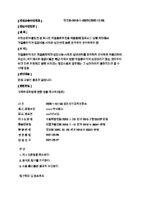
Korea vs “Semicon-Distributor”, May 2021, Seoul High Court, Case No 2020누61166
A Korean subsidiary in the “Semiconductor-group” was active in distribution and sales services. At issue was which transfer pricing method was the most appropriate for determining the arm’s length remuneration for these activities in FY 2013. Judgment of the Court The Court dismissed the claims of the company and upheld the decision of the tax authorities. Excerpt “However, the following circumstances that can be comprehensively acknowledged in the foregoing evidence and description in Evidence A No. 21, namely, (1) OECD Transfer Price Taxation Guidelines 2.101 stipulate that in order for a Gross Margin Ratio to be applied, a taxpayer shall not perform other important functions (manufacturing functions, etc.) that must be compensated using other transfer price methods or financial indicators in a related transaction, which are very sensitive to cost classification, such as operating expenses and other expenses, and thus may cause problems of comparability and irrelevant costs; and (2) Charles H. Berry, which devised the Gross Margin Method of the Transactional Net Margin Method, stated in the paper “Berry Ratios” that, in a case where a company performs other functions in addition to simple sales activities, the distinction between the cost of sales and the cost of operations is unclear and thus the gross margin ratio of sales can be artificially changed, and thus the Gross Margin Method of the Transactional Net Margin Method may not be applied. (3) Although the Plaintiff may perform a service installation and guarantee business, part sales business, in light of the above laws, it is difficult to apply the gross profit margin method among the transactional net margin methods to the Plaintiff’s sales support service transactions (even if the gross profit margin method among the Transactional Net Margin Methods can be applied, as the Plaintiff claims, the following circumstances that can comprehensively acknowledge the purpose of the entire pleadings in each of the descriptions of A Nos. 18 and 19, that is, (1), the codes of 508 companies extracted by the Plaintiff according to the industrial classification codes of the Korean Standard Industrial Classification are “46539: Other industrial machinery and equipment wholesale business, 46592: Medical, Precision and Scientific Equipment wholesale business, 46594: Machinery and equipment for electricity, wholesale business, 46599, and other wholesale business,” (1) In the case of the Plaintiff’s direct comparison of the technical support services and the wholesale business of the Plaintiff, which can be directly determined by the method (1) Four comparable companies were selected, and the difference in the degree of holding inventory assets, trade receivables, and purchase obligations was adjusted for comparability. Considering the characteristics of the Plaintiff in which inventory assets, trade receivables, and purchase obligations do not exist, it is difficult to deem that such adjustment is an ordinary net profit margin that can be generally accepted. Therefore, we do not accept the Plaintiff’s allegation in this part.” Click here for English translation Click here for other translation
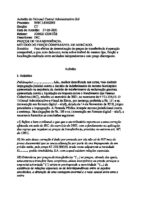
Portugal vs “Publicações Real Estate Lda”, May 2021, Administrative Court of Appeal, Case No 959/13.8BESNT
In 2007 real estate had been transferred from “G gestão imobiliária S.A.” to “Publicações Real Estate Lda”. The Portuguese tax authority issued an assessment, where the pricing of real estate had been adjusted in accordance with the arm’s length principle, based on the prices paid for real estate in the same area. “Publicações Real Estate Lda” filed an appeal with the Administrative Court, where the assessment was later set aside. An appeal was then filed by the tax authorities with the Administrative Court of Appeal. Judgment of the Court The Court of Appeal upheld the assessment notice issued by the tax authorities and set aside the decision of the Administrative Court. Excerpt “The defendant and the judgment in crisis consider that the transaction chosen by the Tax Authorities is not comparable to the one subject to arithmetic correction and that the burden of proving the factual assumptions that determined such correction was not observed. However, this is not correct. The AT has collected information that allows the questioned transaction and the reference transaction to be compared, such as the date of both (2007), the location of both properties (A……….-M……..-M……..), the fact that both are industrial properties as defined by the applicable Municipal Development Plan, the fact that both are industrial warehouses, the fact that there is a study by the Real Estate Association on the price per square metre of warehouses in the area, which is set at between 500.00 euros and 550.00 euros per square metre. To the referred elements, the reasons justifying the corrective action of the AT should be added, to wit (10): i) the lack of presentation by the taxpayer of the transfer pricing documentation, in spite of having been notified to that effect; ii) the Chartered Accountant was not provided with information and documentation which would allow him to assess the reasonability of the price practised in the sale of real estate to a company with which special relations exist; iii) the appellant ascertained in the financial year in question a tax loss of €1. 034,476.33, most of which arose from the tax loss of €868,309.55, inherent to the transaction at issue in the proceedings. The comparability of transactions requires reference to objective factors that arise from the circumstances of the transactions being compared. Objective elements were collected on the calculation of the sale price of the category of property in question in the area under analysis (industrial warehouses). These elements justify the correction to the taxable income imposed by the AT. In turn, there is no evidence in the case-file that allows the comparability assessment made by the AT to be mischaracterised. In view of the evidence gathered of the existence of a similar transaction, carried out between independent entities, with a price different from that of the contested disposal, it was up to the taxpayer to allege and prove, through concrete facts, that the transactions in question are different. This allegation and proof was not made in this case. Therefore, the correction of the value of the transaction and the consequent correction to the taxable income are grounded. By judging in a discrepant sense, the sentence under appeal has committed an error of judgment, for which reason it should be replaced by a decision that rejects the opposition. Accordingly, the present conclusions of appeal are upheld.” Click here for English translation. Click here for other translation
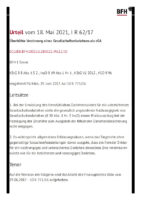
Germany vs Lender GmbH, May 2021, Bundesfinanzhof, Case No I R 62/17
Lender GmbH acquired all shares in T GmbH from T in 2012 (year in dispute) for a purchase price of … €. To finance the purchase price of the shares, Lender GmbH took out a loan from its sole shareholder, D GmbH, a loan in the amount of … €, which bore interest at 8% p.a. (shareholder loan). The interest was not to be paid on an ongoing basis, but only on expiry of the loan agreement on 31.12.2021. No collateral was agreed. D GmbH, for its part, borrowed funds in the same amount and under identical terms and conditions from its shareholders, among others from its Dutch shareholder N U.A. In addition Lender GmbH received a bank loan in the amount of … €, which had an average interest rate of 4.78% p.a. and was fully secured. Finally Lender GmbH also received a vendor loan from the vendor T in the amount of … €, which bore an interest of 10 % p.a. and was not secured. The shareholder loan was subordinated to all other liabilities. The tax office issued a tax assessment in 2016 with regard to interest payments on the shareholder loan. According to the tax authorities an interest rate of of 5 % would have been agreed between independent parties. The difference up to the actual interest rate of 8% was therefore considered a hidden profit distribution(vGA) and added to the income of Lender GmbH. A complaint filed by Lender GmbH against the tax assessment was unsuccessful (Cologne Fiscal Court, Judgment of 29.06.2017 – 10 K 771/16.) The appeal before the Bundesfinanzhof was directed against this judgment. Lender GmbH claims that there has been an infringement of substantive law and requests that the contested judgment be set aside and that the the 2012 corporate income tax assessment be annulled. The tax authorities requests that the appeal be rejected. Judgment of the Court (Bundesfinanzhof) When determining the arm’s length loan interest rate for an unsecured shareholder loan, the statutory subordination of shareholder loans (section 39(1)(5) InsO) does not preclude a risk premium when determining the interest rate to compensate for the lack of loan collateralisation. It is contrary to general principles of practice if the court assumes without factual findings that a third party would agree on the same interest rate for a subordinated and unsecured loan as for a secured and senior loan. The judgment of the Cologne Fiscal Court of 29 June 2017 – 10 K 771/16 is set aside and the case is referred back to the Cologne Fiscal Court for a different hearing and decision. Click here for English translation Click here for other translation
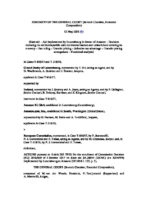
European Commission vs Amazon and Luxembourg, May 2021, European General Court, Case No T-816/17 and T-318/18
In 2017 the European Commission concluded that Luxembourg granted undue tax benefits to Amazon of around €250 million. Following an in-depth investigation the Commission concluded that a tax ruling issued by Luxembourg in 2003, and prolonged in 2011, lowered the tax paid by Amazon in Luxembourg without any valid justification. The tax ruling enabled Amazon to shift the vast majority of its profits from an Amazon group company that is subject to tax in Luxembourg (Amazon EU) to a company which is not subject to tax (Amazon Europe Holding Technologies). In particular, the tax ruling endorsed the payment of a royalty from Amazon EU to Amazon Europe Holding Technologies, which significantly reduced Amazon EU’s taxable profits. This decision was brought before the European Court of Justice by Luxembourg and Amazon. Judgment of the European General Court The General Court found that Luxembourg’s tax treatment of Amazon was not illegal under EU State aid rules. According to a press release “The General Court notes, first of all, the settled case-law according to which, in examining tax measures in the light of the EU rules on State aid, the very existence of an advantage may be established only when compared with ‘normal’ taxation, with the result that, in order to determine whether there is a tax advantage, the position of the recipient as a result of the application of the measure at issue must be compared with his or her position in the absence of the measure at issue and under the normal rules of taxation. In that respect, the General Court observes that the pricing of intra-group transactions carried out by an integrated company in that group is not determined under market conditions. However, where national tax law does not make a distinction between integrated undertakings and standalone undertakings for the purposes of their liability to corporate income tax, it may be considered that that law is intended to tax the profit arising from the economic activity of such an integrated undertaking as though it had arisen from transactions carried out at market prices. In those circumstances, when examining a fiscal measure granted to such an integrated company, the Commission may compare the tax burden of that undertaking resulting from the application of that fiscal measure with the tax burden resulting from the application of the normal rules of taxation under national law of an undertaking, placed in a comparable factual situation, carrying on its activities under market conditions. In addition, the General Court points out that, in examining the method of calculating an integrated company’s taxable income endorsed by a tax ruling, the Commission can find an advantage only if it demonstrates that the methodological errors which, in its view, affect the transfer pricing do not allow a reliable approximation of an arm’s length outcome to be reached, but rather lead to a reduction in the taxable profit of the company concerned compared with the tax burden resulting from the application of normal taxation rules. In the light of those principles, the General Court then examines the merits of the Commission’s analysis in support of its finding that, by endorsing a transfer pricing method that did not allow a reliable approximation of an arm’s length outcome to be reached, the tax ruling at issue granted an advantage to LuxOpCo. In that context, the General Court holds, in the first place, that the primary finding of an advantage is based on an analysis which is incorrect in several respects. Thus, first, in so far as the Commission relied on its own functional analysis of LuxSCS in order to assert, in essence, that contrary to what was taken into account in granting the tax ruling at issue, that company was merely a passive holder of the intangible assets in question, the General Court considers that analysis to be incorrect. In particular, according to the General Court, the Commission did not take due account of the functions performed by LuxSCS for the purposes of exploiting the intangible assets in question or the risks borne by that company in that context. Nor did it demonstrate that it was easier to find undertakings comparable to LuxSCS than undertakings comparable to LuxOpCo, or that choosing LuxSCS as the tested entity would have made it possible to obtain more reliable comparison data. Consequently, contrary to its findings in the contested decision, the Commission did not, according to the General Court, establish that the Luxembourg tax authorities had incorrectly chosen LuxOpCo as the ‘tested party’ in order to determine the amount of the royalty. Secondly, the General Court holds that, even if the ‘arm’s length’ royalty should have been calculated using LuxSCS as the ‘tested party’ in the application of the TNMM, the Commission did not establish the existence of an advantage since it was also unfounded in asserting that LuxSCS’s remuneration could be calculated on the basis of the mere passing on of the development costs of the intangible assets borne in relation to the Buy-In agreements and the cost sharing agreement without in any way taking into account the subsequent increase in value of those intangible assets. Thirdly, the General Court considers that the Commission also erred in evaluating the remuneration that LuxSCS could expect, in the light of the arm’s length principle, for the functions linked to maintaining its ownership of the intangible assets at issue. Contrary to what appears from the contested decision, such functions cannot be treated in the same way as the supply of ‘low value adding’ services, with the result that the Commission’s application of a mark-up most often observed in relation to intra-group supplies of a ‘low value adding’ services is not appropriate in the present case. In view of all the foregoing considerations, the General Court concludes that the elements put forward by the Commission in support of its primary finding are not capable of establishing that LuxOpCo’s tax burden was artificially reduced as a result of an overpricing of the royalty. In the second place, after examining the

Italy vs GI Group S.p.A., May 2021, Supreme Court, Case No 13850/2021
A non-interest-bearing loan had been granted by GI Group S.p.A., to a related company – Goldfinger Limited – in Hong Kong, in order to acquire a 56% shareholding in the Chinese company Ningbo Gi Human Resources Co. Limited. The Italien tax authorities had issued an assessment, where an interest rate on the loan had been determined and an amount equal to the interest calculated on that basis had been added to the taxable income of GI Group S.p.A. GI Group brought this assessment to the Regional Tax Commission where a decision was rendered setting aside the assessment. This decision was appealed to the Supreme Court by the tax authorities. Judgment of the Supreme Court The Supreme court upheld the appeal of the tax authorities and referred the case back to the Regional Tax Commission. According to the Supreme Court, the decision of the Tax Commission dit not comply with the principles of law concerning the subject matter of evidence and the burden of proof on tax authorities and the taxpayer. Excerpts: “…In conclusion, according to the Court, “such discipline, being aimed at repressing the economic phenomenon of transfer pricing, i.e. the shifting of taxable income as a result of transactions between companies belonging to the same group and subject to different national laws, does not require the administration to prove the avoidance function, but only the existence of “transactions” between related companies at a price apparently lower than the normal one” “according to the application practice of the Italian Revenue Agency (Circular No. 6/E of 30 March 2016 on leveraged buy-outs), the reclassification of debt (or part of it) as a capital contribution should represent an “exceptional measure”. Moreover, it is not excluded that free intra-group financing may have a place in the legal system where it can be demonstrated that the deviation from the arm’s length principle is due to “commercial reasons” within the group, related to the role that the parent company assumes in supporting the other companies of the group; “ “…the Regional Commission did not comply with the (aforementioned) principles of law concerning the subject-matter of the evidence and the criterion for sharing the burden of proof, between the tax authorities and the taxpayer, on the subject of international transfer pricing. In essence, the examination of the trial judge had to be oriented along two lines: first, it had to verify whether or not the tax office had provided the evidence, to which it was entitled, that the Italian parent company had carried out a financing transaction in favour of the foreign subsidiary, as a legitimate condition for the recovery of the taxation of the interest income on the loan, on the basis of the market rate observable in relation to loans with sufficiently “comparable” characteristics and provided to entities with the same credit rating as the associated debtor company (see the OECD Report 2020), the determination of which is quaestio facti referred to the judge of merit; secondly, once this preliminary profile had been established, also on the basis of the principle of non-contestation, it had to be verified whether, for its part, the company had demonstrated that the non-interest-bearing loan was due to commercial reasons within the group, or in any event was consistent with normal market conditions or whether, on the contrary, it appeared that that type of transaction (i.e. the loan of money) between independent companies operating in the free market would have taken place under different conditions. Instead, as stated above (see p. 2 of the “Findings”), the C.T.R. required the Office to demonstrate facts and circumstances extraneous to the onus pro bandi of the Administration, such as the existence of an interest of Goldfinger Ltd in obtaining and remunerating the loan and, again, that there had been other similar onerous intra-group loans; Click here for English translation Click here for other translation
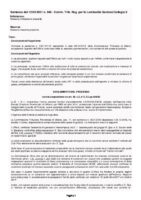
Italy vs E.I. S.r.l., February 2021, Regional Tax Commission, Case No 12/02/2021 n. 546/9
Transactions had taken place between E.I. S.r.l. and a related Spanish company, S. SA, where the pricing had been determined based on the cost plus method. An assessment was issued by the tax authorities on the basis of a “comparable” transactions (internal CUP) between the E.I. S.r.l. and an independent third company where the price had been higher. An appeal was filed by E.I. S.r.l. with the Provincial Tax Commission where E.I S.r.l. argued that the price difference was due to volume discounts. The Provincial Tax Commission held in favour of E.I S.r.l. An appeal was then filed by the tax authorities with the Regional Tax Commission. Judgment of the Regional Tax Commission The Regional Commission dismissed the appeal of the tax authorities and decided in favour of E.I. S.r.l. Excerpts: “The Commission observes that the judges at first instance correctly and in detail reasoned their decisions, with a wealth of detail and a careful examination of all the circumstances examined. On the other hand, the Office has slavishly repeated its observations, merely objecting to the fact that they were not given due consideration by the first instance judges.” “The OECD Guidelines state that: Part 2, B.1, paragraph 2.26: “As a further example, assume that a taxpayer sells 1000 tonnes of a product to an associated enterprise in its multinational group at a price of $80 per tonne and simultaneously sells 500 tonnes of the same product to an independent enterprise at $100 per tonne. In this case it is necessary to assess whether the different quantities should lead to a correction of the transfer price. The relative market should be studied by analysing transactions for similar products in order to determine discounts normally applied depending on the quantity supplied. The example quoted is identical to the case under consideration today; according to the OECD Guidelines, a transfer pricing analysis cannot disregard the need to make an adjustment to the transactions in order to take into account the different quantities supplied to the two parties and to make the quantities comparable;” “National Jurisprudence, on the other hand, is recalled for the Cassation Civil Section, with sentence no. 20805 of 06 September 2017 states that: “(…) the essential aspect of transfer pricing does not concern the justification of the lower price from an economic point of view, but whether the discounts can be considered justified from a fiscal point of view, that is, whether they respond to the principle of free competition, in accordance with the teachings of the Supreme Court.” Click here for English translation Click here for other translation
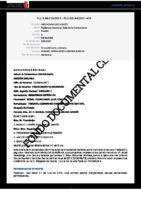
Spain vs BIOMERIEUX ESPAÑA SA, February 2021, Audiencia Nacional, Case No 2021:416
BIOMERIEUX ESPAÑA SA is active in the business of clinical and biological analysis, production, distribution, training and technical assistance. Likewise, the provision of computer services and, in particular, the computer management of laboratories. Following an audit the tax authorities found that the controlled prices agreed for the acquisition of instruments and consumables between bioMérieux España and its related entities, bioMérieux SA and bioMérieux Inc, did not provided bioMérieux España with an arm’s length return on is controlled activities. A tax assessment was issued for FY 2008 on the basis af a thorough critical analysis of the benchmark study provided by the BIOMERIEUX, and detailed reasoning and analysis in regards to comparability and market developments. Judgment of the National Court The Audiencia Nacional dismissed the appeal of Biomerieux España SA and decided in favour of the tax authorities. Excerpts “As we already reasoned in our SAN (2nd) of 6 March 2019 (Rec. 353/2015 ), it is legitimate to resort to what the Guideline calls “measures of central tendency”, but whoever resorts to them has the burden of reasoning and setting out the reasons that lead to their application. In our opinion, the Inspectorate, in this case, does reason and state the reasons.” “2008 was a year of outstanding economic results for the bioMérieux Group, as well as for bioMérieux Spain in terms of sales growth, according to the report. However, this situation of increased results for the Group is not reflected in the income statement of bioMérieux Spain’s distribution business, whose profitability fell from 8% in 2007 to 4.47% in 2008. This is not consistent either with the Group’s results or with the market remuneration for performing the same functions in 2007 and 2008, a market which has not been shown to have seen its margins of free competition reduced.” “It is true that, as stated in point 1.13 of the Guidelines, the objective sought by the rule is “to arrive at a reasonable approximation of what would be an arm’s length result based on reliable information. At this point, it should also be remembered that transfer pricing is not an exact science, but requires value judgments on the part of both the tax administration and taxpayers”. Precisely for this reason, the correct thing to do is to proceed as the inspectorate did, i.e. to ask the appellant to justify the price set and to analyse the reasonableness of the price obtained. In this sense, it is reasonable to require the appellant to keep the information regarding the criteria they have used to set the transfer price and the documentation that has justified them or, at least, to be able to precisely identify the sources from which they have obtained the information. This will allow for verification. In this sense, paragraph 3.3 of the OECD Guidelines “considers it good practice for a taxpayer that uses comparables to justify its transfer prices ( ) to provide the other interested party with the supporting information that allows it to assess the reliability of the comparables used”.” “All these reasons, assessed as a whole, lead us to conclude that the detailed analysis carried out by the Inspectorate allows us to conclude that the calculations made by the Inspectorate are closer to the purpose of the rule, that is to say, to the search for the price set at arm’s length, than those provided by the appellant.” “The applicant submits that the Spanish authorities have reached an amicable agreement with the French authorities and have fixed the agreed mark-up as market rate at 6,20 %. What is sought is to apply the same margin in relation to the US company, in respect of which there is no amicable procedure. The tax authorities opposes this argument, reasoning that the transfer price agreed with France in an amicable procedure is the result of a negotiation between sovereign entities involving considerations of international public law, and therefore its results cannot be extrapolated.” “The agreement obtained is an agreement that binds the negotiating States, but cannot extend its effects to relations with another State. The fact that the Kingdom of Spain, for reasons unknown to us, has reached an agreement with the Republic of France does not mean that the transfer price fixed by the Spanish administration is not correct, but simply that the States have given in on their respective claims and reached an agreement, the effects of which cannot be extrapolated.” Click here for English Translation Click here for other translation
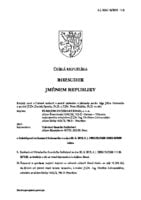
Czech Republic vs. STARCOM INTERNATIONAL s.r.o., February 2021, Regional Court , Case No 25Af 18/2019 – 118
A tax assessment had been issued for FY 2013 resulting in additional taxes of to CZK 227,162,210. At first the tax administration disputed that the applicant had purchased 1 TB SSDs for the purpose of earning, maintaining and securing income. It therefore concluded that the Starcom Internatioal had not proved that the conditions for tax deductions were met. On appeal, the tax administrator changed its position and accepted that all the conditions for tax deductions were met, but now instead concluded that Starcom Internatioal was a connected party to its supplier AZ Group Czech s.r.o. It also concluded that the transfer prices had been set mainly for the purpose of reducing the tax base within the meaning of Section 23(7)(b)(5) of the ITA. It was thus for the tax authorities to prove that Starcom Internatioal and AZ Group Czech s.r.o. (‘AZ’) were ‘otherwise connected persons’ and that the prices agreed between them differed from those which would have been agreed between independent persons in normal commercial relations under the same or similar conditions. Judgment of the Regional Court The Court allowed the appeal and decided predominantly in favour of Starcom Internatioal. “It can therefore be summarised that for the application of section 23(7) of the ITA it is necessary to prove that they are related persons within the meaning of the Income Tax Act, while respecting the case law cited above. A further condition is that the tax authority must prove that the prices agreed between these persons differ from the normal prices that would have been agreed between independent persons in normal commercial relations under the same or similar conditions. It is then up to the taxable person (if he wishes to avoid adjusting the tax base) to explain and substantiate the difference found to his satisfaction.” “Since the applicant was fully successful in the proceedings, it was entitled to the costs of the proceedings, which the court ordered the defendant to pay, in accordance with Article 60(1) of the Civil Procedure Code. The applicant’s costs of the proceedings consist of the court fee paid for filing the action in the amount of CZK 3,000, as well as the lawyer’s fee in accordance with Decree No 177/1996 Coll. in the amount of CZK 3,100, pursuant to Article 7(5) in conjunction with Article 9(4)(d) of Decree No 177/1996 Coll, for three acts of legal service – preparation and acceptance of representation and drafting of the application and the reply to the defendant’s statement of defence, as well as three times the overhead allowance of CZK 300 for each of those acts of legal service pursuant to Article 13(4) of the Ordinance and VAT on those amounts, with the exception of the court fee paid pursuant to Article 57(2) of the Civil Procedure Code. The Court ordered the defendant to pay the costs reasonably incurred in the total amount of CZK 15 342 to the applicant’s representative pursuant to Section 149(1) of Act No 99/1963 Coll. of the Civil Procedure Code in conjunction with Section 64 of the Code of Civil Procedure.” Click here for English Translation Click here for other translation
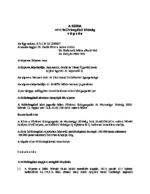
Hungary vs “Lender” Kft, January 2021, Supreme Administrative Court, Case No. Kfv.I.35.251/2020/7
In 2008 “Lender Kft.” entered into a loan agreement with its Brazilian affiliate, S.B.S.C. Ltda. (Kft 1) According to the terms of the contract, the loan amounted to 53,174,516, the maturity date of the loan was 31 January 2013 and the interest was paid semi-annually at the semi-annual CDI rate fixed in the contract plus 200 basis points per annum. In the years 2009-2011, Kft 1 paid 15 % of the interest as withholding tax, and Lender Kft. received 85 % of the interest. In its books, Lender Kft. entered 100 % of the interest as income, while the 15 % withholding tax was recorded as other expenses. According to Lender Kft’s transfer pricing records, the normal market interest rate range was 8,703 % to 10,821 % in FY 2009, 10,704 % to 12,598 % in the FY 2010 and 10,704 % to 12,598 % in FY 2001, and the interest rates applied in the loan transaction were 10,701 % to 12,529 %, 12,517 % to 14,600 % and 12,517 % to 14,600 % in the same years. In other words, according to the records, the interest rates applied to the transaction were partly within and partly above the market price range. “Lender Kft” used the CUP method to determine the transfer price, taking into account external and internal comparables. As an external comparison, it used a so-called risk premium model based on the rating of the debtor party and the terms and conditions of the loan, taking into account publicly available data. For the credit rating of the related company, it used the risk model of the name, on the basis of which it classified the company between A1 and A3. It defined the range of interest rates to be applied in the loan terms and conditions, then the default rate and the rate of return, and finally, by substituting these data into the risk premium model formula, it defined the risk premium rates for each risk rating. In doing so, it used subordinated bonds. The benchmark interest rate range was defined as the sum of the risk-free rate and the risk premium. As an internal comparison, the applicant requested quotations from various commercial banks, as independent parties, before granting the loan, as to the amount of profit it could expect to obtain if it deposited its money with them (Bank1, Bank2) The Tax tax authorities carried out an audit of Lender Kft for FY 2009, 2010 and 2011. In the view of the tax authority at first instance, the CUP method, although appropriate for determining the arm’s length price, was not the method used by the applicant. According to the tax authorities the rating of a debtor using public rating models may differ greatly from the rating carried out by the rating agency which created the model, which results in a high degree of uncertainty as to the method used by the applicant. A further problem was that Lender Kft had based its pricing on a rate for subordinated bonds, whereas a bank loan and a bond are two different financial instruments and cannot be compared. In this context, it was stated that the transaction under examination was a loan contract and not a bond issue. The tax authorities explained that the unit operating costs are the lowest in the banking market and that it had not been demonstrated that the cost of the applicant’s lending was lower than that of a bank loan. It also stated that the mere existence of information through a relationship does not imply a lower risk exposure. In relation to the internal comparables, it stressed that the loan granted by Lender Kft could not be classified as a deposit transaction and that the comparison with the deposit rate was therefore incorrect. According to the tax authority, for the purposes of determining the normal market price, the … banking market best reflects the conditions under which the related undertaking would obtain a loan under market conditions, and therefore the so-called “prime rate” interest rate statistics calculated by the Central Bank of the country in question are the most appropriate for its calculation. This statistic shows the average interest rate at which commercial banks lend to their best customers. Accordingly, the tax authority at first instance took this rate as the basis for determining the difference between the interest rate applied to the transaction at issue and the normal market rate. As a result, the applicant’s corporate tax base was increased by HUF 233,135,000.00 in the financial year 2009, HUF 198,638,000.00 in the financial year 2010 and HUF 208,017,000.00 in the financial year 2011, pursuant to Article 18(1) of Act LXXXI of 1996 on Corporate Tax and Dividend Tax (‘Tao Law’). Lender Kft. filed a complaint against the decision and requested that the decision be altered or annulled and that the defendant be ordered to commence new proceedings. In the complaint it stated that the method used by the tax authorities did not comply with points 1.33, 1.35 and 2.14 of the OECD TPG, nor with Article 7(d) of the PM Regulation. By judgment of 20 April 2018, the Court of First Instance annulled the tax authorities first assessment and ordered the authority to initiate new proceedings in that regard. The court stated that the tax authority must determine whether the pricing of the loan at issue in the case was in line with the arm’s length price, taking into account the OECD Transfer Pricing Guidelines and the expert’s opinion in this context. Under the revised audit process the tax authorities found other issued which were added to the new assessment. “Lender Kft” then filed an appeal with the Administrative Court, which found the appeal well founded in regards of the new issues that had been added to the assessment by the tax authorities but upheld the decision in regards of the original issues. An appeal was then filed with the Supreme Administrative court, which found that the court of first instance had erred
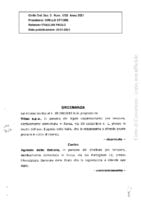
Italy vs Vibac S.p.A., January 2021, Corte di Cassazione, Case No 1232/2021
Transactions had taken place between Vibac S.p.A. and related foreign group companies related to use of trademarks and royalty/license payments. It was up to the Vibac S.p.A. to demonstrate that the remuneration received from related companies for use of the trademark of the products had been at arm’s length. According to the company the royalty had been set at a low price to ensure that the foreign subsidiaries were more competitive. An upward adjustment was issued by the tax authorities rejecting the taxpayer’s argument that the below market royalty was explained by the need to enable its foreign subsidiary to penetrate more effectively the US market. The tax authorities argued that such a strategy could only be justifiable in a limited period. The tax authorities determined the arm’s length royalty payment by application of the Resale Price Method (RPM). However, due to the uniqueness of the asset transferred, which hardly allows the identification of comparable transactions, the same circular, while not excluding that in some cases one of the basic criteria adopted for the transfer of tangible goods (comparison, resale or increased cost) may be applied, points out that it should not be overlooked that a licence agreement depends essentially on the forecasts of the result that may be achieved by the licensee in the territory to which the right of exploitation refers and that it is, therefore, necessary to develop subsidiary valuation methods, always inspired by the principle of the arm’s length price, i.e. the price that would have been agreed upon between independent undertakings. With regard to the determination of the fee concerning the use of intangible assets, the circular notes that it is greatly affected by the specific characteristics of the economic sector to which the intangible right refers and that, in general, it is commensurate with the turnover of the licensee, so that the reference to these indices is a valid initial data for the assessment of the “normal value”. Vibac S.p.A. did not approve of the assessment an brought the case to court. The court of first instance held in favour of the tax authorities. This decision was then appealed to Corte di Cassazione. Judgment of the Court The Italien Corte di Cassazione upheld the decision of the court of first instance and dismissed the appeal of Vibac S.p.A. Excerpts: Indeed, the rationale of the abovementioned domestic tax legislation is to be found in the safeguarding of the principle of free competition, as set out in Article 9 of the OECD Model Convention, which is to be interpreted in the light of the specific features of tax law on tax arbitrage. In fact, the rationale of the domestic tax rules referred to above is to be found in the safeguarding of the principle of free competition, set out in Article 9 of the OECD Model Convention, which provides for the possibility of taxing profits arising from intra-group transactions that have been governed by conditions different from those that would have been agreed between independent companies in comparable transactions carried out on the free market; it is therefore necessary to verify the economic substance of the transaction and to compare it with similar transactions carried out, in comparable circumstances, in free market conditions between independent parties and to assess its compliance with these (Court of Cassation no. 5645 of 2020, id. no. 9615 of 2019; id. 27018 of 2017). Thus, company policy, taken in itself, is not a necessary and sufficient cause of justification for derogating from the normal value rule. Since the normal value of a transaction is a function of the economic characteristics of the transaction, the transaction from which the normal value is to be derived will concern (a) goods and services of the same kind, (b) at the same marketing stage, (c) at the same time and (d) in the same market where the goods or services were acquired. In order to achieve the highest possible degree of comparability, the second part of Article 9 TUIR states that “for the determination of normal value”, reference should be made, “as far as possible, to the price lists or tariffs of the person who supplied the goods or services”. The presence of varied intra-group commercial transactions fully captures the estimative meaning of Article 9, as well as the OECD model. The adoption of the Resale Price Method is advocated, not only by Circular 22.9.1980 (No. 32/9/2267), but also and above all by the 1995 OECD Report. Click here for English translation Click here for other translation
France vs BSA Finances, December 2020, Supreme Administrative Court , Case No 433723
In 2009, 2010 and 2011 BSA Finances received a total of five loans granted by the Luxembourg company Nethuns, which belongs to the same group (the “Lactalis group”). Depending on the date on which the loans were granted, they carried interest rates of respectively 6.196%, 3.98% and 4.52%. Following an audit covering the FY 2009 to 2011, the tax authorities considered that BSA Finances did not justify that the interest rates thus charged should exceed the average effective rates charged by credit institutions for variable-rate loans to companies with an initial term of more than two years. Hence, the portion of interest exceeding these rates was considered non-deductible pursuant to the provisions of Article 212(I) of the General Tax Code. In 2017, the Administrative Court ruled in favor of BSA Finances and discharged the additional corporate tax. But this decision was appealed by the authorities to the Administrative Court of Appeal which in June 2019 overturned the decision of the lower court. The Judgment from the Administrative court of Appels was then appealed by BSA Finances to the French Supreme Administrative Court. Decision of the Supreme Administrative Court The Supreme Administrative Court overturned the decision from the Court of Appeal and found in favor of BSA. “In considering that the company had not established that the margin rates applied were in line with market rates for loans made under the same conditions, whereas the Riskcalc application, which it was not disputed was fed from the company’s balance sheets and profit and loss accounts over several years, had classified its level of risk as “BBB/BBB-” on the basis of comparative ratios established by Moody’s, that the refinancing contracts produced, which made it possible to determine the actual margin rate of the loans taken out by the applicant company itself, were accompanied by details making it possible to compare the main specific conditions with the clauses of the loans in dispute and that, lastly, the combination of these elements was such as to justify, in the absence of any element to the contrary, that the credit margins applied by Nethuns were in line with market practices, the Court distorted the documents in the file submitted for its assessment.” Click here for English translation Click here for other translation

France vs Sté Paule Ka Holding, December 2020, Paris Administrative Court of Appeal, Case No 18PA02715
Sté Paule Ka Holding, was set up as part of a leveraged buy-out (LBO) operation to finance the acquisition of the Paule Ka group, and in 2011 it acquired the entire capital of the group a price of 42 million euros. The acquisition was financed by issuing convertible bonds carrying an interest rate of 8%. The French tax authorities issued an assessment where deductions for certain payments related to the acquisition and part of the interest payments on the bonds were disallowed. Decision from the Administrative court of appeal The Court found in favor of the company in regards to the payment related to the acquisition and in favor of the tax administration in regards to the partially disallowed deduction of interest payments. “It follows from the foregoing that the elements invoked by the administration do not provide proof that the expenditure of EUR 390,227 correctly entered in the accounts was not incurred in the interest of the company Paule Ka Holding. The latter is thus entitled to argue that the administration was wrong to refuse to deduct it in respect of the financial year ended in 2012 and, consequently, to request the reduction of the tax bases and the discharge of the corresponding taxes, including the penalties for deliberate failure to comply as provided for in a) of Article 1729 of the General Tax Code, applied by the administration to this head of rectification.” “...These bonds have a term of ten years, bear interest at a rate of 8%, have a principal amount that is repayable in full at maturity, are not accompanied by any guarantee or security, bear capitalised interest and are convertible at maturity at the rate of one new share with a value of one euro for every 10 OCAs granted. Paule Ka Holding recognised interest on bonds of EUR 2 083 490 for the year ended 2012 and EUR 2 574 298 for the year ended 2013 as an expense. The department questioned the amount of these deductions for the interest paid on the bonds subscribed by Black Tie Luxco by applying the legal interest rate provided for in Article 39(1)(3) of the General Tax Code, i.e. 3.64% and 3.10% for the said financial years. Deductions for the difference in the calculated interest in the amount of EUR 1,092,601 for the financial year ending in 2012 and EUR 908,667 for the financial year ending in 2013 were disallowed. To justify the rate applied to the above-mentioned compulsory loans, Paule Ka Holding produced a study drawn up by the firm Dauge et associés on 30 September 2015. This firm carried out a credit rating of the company, based on an analysis of its financial structure with regard to its balance sheet situation, based on two criteria, the Banque de France rating of the borrower, based on the criteria of earning capacity, financial autonomy The Banque de France rating of the borrower, based on the criteria of earning capacity, financial autonomy, solvency and liquidity, and the estimate of the credit risk of the OCAs issued using the Standard and Poor’s analysis grid, on the basis of the group’s consolidated business plan, to conclude that the rating is estimated at BB-, corresponding to a satisfactory business risk profile and an aggressive financial risk. Based on this rating, it then estimated the credit margin applicable to the OCAs based on the European Commission’s recommendations for estimating reference and discount rates, with margin levels based on credit rating categories. The firm concluded from these elements that the interest rate of 8% seemed appropriate given the profile of the borrower and the characteristics of the bonds issued. However, the study produced consists of generalities and the data presented in it is not documented. Indeed, the mere reference to a credit rating does not imply that all the companies concerned by this rating have identical repayment capacities, taking into account all the quantitative and qualitative factors specific to each company. Furthermore, it does not appear from this study that the internal rating of Paule Ka Holding, as described, takes sufficient account of the company’s own characteristics, in particular the state of its accounts, its competitive positioning and the quality of its managers and employees. This internal rating does not take into account the possibility of the company receiving external assistance in the event of difficulties in honouring its commitments. Under these conditions, this study is insufficient to justify the rate applied to the bonds in dispute. In addition, Paule Ka Holding has provided examples of companies that took out bonds in the context of LBO transactions for acquisitions dated from May 2011 to June 2012 at rates varying between 7 and 12%, which, according to the company, show that the rate of 8% was a market rate compared with those applied by other companies of comparable size and for loans of the same nature. However, the investigation shows that the bonds presented for comparison have either a shorter duration than those in dispute or are not convertible into shares. Their amount is very different from that issued by Paule Ka Holding, some of which are also associated with “senior” debts. Moreover, the issuing companies, of very different sizes, carry out their activities in different fields from that of Paule Ka Holding, a takeover structure of a group in the high-end ready-to-wear sector. There is nothing to show the conditions under which the loans presented for comparison purposes were established. Under these conditions, since the comparability of the economic conditions has not been demonstrated, the terms of comparison proposed by Paule Ka Holding do not justify the rate applied to the bond loans in dispute. It follows from the foregoing that Paule Ka Holding does not justify the rate it could have obtained from independent financial institutions or organisations for a loan granted under similar conditions with regard to the yield on bond loans from undertakings in comparable economic conditions, for loans constituting a realistic alternative to an intra-group loan, taking into account its own characteristics, in particular its risk profile. It does not therefore
France vs WB Ambassador, December 2020, Supreme Administrative Court, Case No 428522
WB Ambassador, took out two loans with its Luxembourg parent company and another group company, each bearing an annual interest rate of 7%. Following an audit, the tax authorities, considering that the company did not justify that the 7% interest rate of the above-mentioned intra-group loans corresponded to the rate it could have obtained from independent financial institutions or organisations under similar conditions and partially disallowed deductions of the interest incurred. Supreme Administrative Court The Supreme Administrative Court overturned the decision of the Administrative court of Appeal and ruled in favor of the WB Ambassador. It stated that the Lower Court had erred in law in ruling out the possibility that a company, in order to justify the rate it could have obtained from independent financial institutions for a loan granted under similar conditions, could rely, in order to assess that rate, on the yield of bond issues granted by undertakings in comparable economic conditions. Consequently, WB Ambassador was entitled, without needing to examine the other pleas in law of its appeal, to seek the annulment of the judgment which it is challenging. “The borrowing company, which has the burden of proving the rate it could have obtained from independent financial institutions or organisations for a loan granted under similar conditions, may provide this proof by any means. In this respect, in order to evaluate this rate, it may, where appropriate, take account of the yield on bonds issued by undertakings in comparable economic conditions, where such bonds constitute, in the circumstances under consideration, a realistic alternative to an intra-group loan.” Click here for English translation Click here for other translation

Romania vs “GAS distributor” SC A, December 2020, Court of Appeal, Case No 238/12.03.2020
The disputed issue concerns the purchase prices of natural gas by SC A from an affiliated company SC B. By orders of the National Energy Regulatory Authority (NERA), the prices of supply of natural gas to domestic and non-domestic consumers were regulated and fixed, but not the price at which SC A purchased it from the SC B. The tax authority issued an assessment where the price of the controlled gas transaction was determined by reference to profit level indicators of comparable businesses. SC A brought the decision to the Romanian courts. Judgment of the Court of Appeal The appeal of SC A was dismissed and the assessment of the tax authorities upheld. Excerpt “In the present case, in order to adjust the expenses for the cost of the goods purchased from SC “B.” SRL, based on the level of the central market trend, the tax body used the information provided by the ORBIS and FISCNET applications. Following the comparative analysis of the information provided by the two IT applications, the tax body identified 22 potentially comparable companies in Romania, of which only one met the qualitative criteria, which is why it correctly moved to a higher search level, namely that of the European Union, identifying 6 companies that were comparable in terms of quantity and quality. In this regard, it was noted that, according to Article 8 of OPANAF No 442/2016, transactions between related persons are considered to be carried out according to the market value principle if the financial indicator of the transaction/transaction value (margin/profit/price) falls within the range of comparison. The following provisions shall be respected in determining the comparator range: 1. the comparability analysis will consider territorial criteria in the following order: national, European Union, pan-European, international; 2. reasonable availability of data at the time of transfer pricing or at the time of their documentation, for which the taxpayer/payer being verified provides supporting documentation for the data used at the time of transfer pricing; 3. the margin of comparison is the range of price or margin/profit values for comparable transactions between independent comparable companies; 4. for the determination of outliers, the margin of comparison shall be divided into 4 segments. The maximum and minimum segments represent the extreme results. The range of comparison is the range of price or margin/output values for comparable transactions between independent comparators, after eliminating the extreme results from the margin of comparison; 5. the extreme results within the margin of comparison shall not be used in determining and calculating the estimate/adjustment; 6. if the median value cannot be identified (the median value is the value at the middle of the range of comparison), the arithmetic mean of the two middle values of the range of comparison shall be taken. In so far as the tax authority complied with the legal procedure for estimating the purchase prices, as required by ANAF Order 442/2016, the appellant’s criticisms are unfounded, especially as they do not essentially concern the specific procedure carried out by the tax authority. Consequently, the appellant’s criticisms, which relate to the ground for annulment relied on, are unfounded, which is why the appeal was dismissed as unfounded.” Click here for English translation Click here for other translation
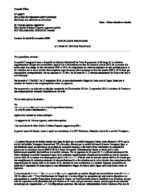
France vs Ferragamo France, November 2020, Conseil d’Etat, Case No 425577
Ferragamo France, which was set up in 1992 and is wholly owned by the Dutch company Ferragamo International BV, which in turn is owned by the Italian company Salvatore Ferragamo Spa, carries on the business of retailing shoes, leather goods and luxury accessories and distributes, in shops in France, products under the ‘Salvatore Ferragamo’ brand, which is owned by the Italian parent company. An assessment had been issued to Ferragamo France in which the French tax authorities asserted that the French subsidiary had not been sufficiently remunerated for additional expenses and contributions to the value of the Ferragamo trademark. The French subsidiary had been remunerated on a gross margin basis, but had incurred losses in previous years and had indirect cost exceeding those of the selected comparable companies. The Administrative Court decided in favour of Ferragamo and dismissed the assessment. According to the Court the tax administration has not demonstrated the existence of an advantage granted by Ferragamo France to Salvatore Ferragamo SPA, nor the amount of this advantage. Judgment of the Conseil d’Etat The Conseil d’Etat overturned the decision of the Administrative Court and remanded the case back to the Administrative Court of Appeal for further considerations. “In ruling that the administration did not establish the existence of an advantage granted to the Italian company on the grounds that the French company’s results for the financial years ending from 2010 to 2015 had been profitable without any change in the company’s transfer pricing policy, whereas it had noted that the exposure of additional charges of wages and rents in comparison with independent companies was intended to increase, in a strategic market in the luxury sector, the value of the Italian brand which did not yet have the same notoriety as its direct competitors, the administrative court of appeal erred in law. Moreover, although it emerged from the documents in the file submitted to the trial judges that the tax authorities had established the existence of a practice falling within the provisions of Article 57 of the General Tax Code, by showing that the remuneration granted by the Italian company was not sufficient to cover the additional expenses which contributed to the value of the Salvatore Ferragamo trade mark incurred by the French subsidiary and by arguing that the latter had been continuously loss-making since at least 1996 until 2009, the court distorted the facts and documents in the file. By dismissing, under these conditions, the existence of an indirect transfer of profits to be reintegrated into its taxable income when the company did not establish, by merely claiming a profitable situation between 2010 and 2015, that it had received a consideration for the advantage in question, the court incorrectly qualified the facts of the case.” Click here for English Translation Click here for other translation
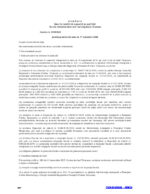
Romania vs “Electrolux” A. SA, November 2020, Supreme Administrative Court, Case No 6059/2020
In this case, a Romanian manufacturer and distributor (A. SA) in the Electrolux group (C) had been loss making while the group as a whole had been profitable. The tax authorities issued an assessment, where the profit of A. SA had been determined based on a comparison to the profitability of independent traders in households appliances. When calculating the profit margin of A. SA certain adjustments was made to the costs – depreciations, extraordinary costs etc. When comparing A. SA’s net profit to financial results with those of the group to which it belongs, it emerged that, during the period under review, the applicant was loss-making while C. made a profit. With reference to paragraphs 1.70 and 1.71 of the OECD Transfer Pricing Guidelines, when an affiliated company consistently makes a loss while the group as a whole is profitable, the data may call for a special analysis of the transfer pricing elements, as this loss-making company may not receive an adequate reward from the group of which it is part and with which it does business for the benefits derived from its activities. An analysis of the way in which the prices at which the applicant’s products are sold to other companies in C. are determined shows that those prices are imposed by the group, and that there is a uniform group policy of remunerating the manufacturing companies within the group and those carrying out distribution activities. According to the document called “Framework Documentation 2013”, Annex 28 of the transfer pricing file, transfer prices are established on the basis of budgeted estimated costs, comprising direct material cost, direct labour cost and direct manufacturing costs, as well as indirect manufacturing costs and processing costs, plus a margin of 2.5%. Compared to this mark-up, the mark-up applied to B.’s direct and indirect production costs was between 27.04% and 34.87% over the period 2008-2013, as shown in B.’s public financial statements. It is true that B. is an entrepreneur whose activity involves several functions and risks, which may lead to higher mark-ups or higher losses, but it is worth noting that the mark-up applied to the cost of goods sold by B. is 11-14 times higher than that established for A. S.A.. During the entire period subject to tax inspection, the applicant incurred losses, while C. made a profit. In the years 2010, 2011 and 2013, with a turnover of more than 400.000.000 RON, the applicant always recorded a net loss. According to the tax authorities the court of first instance erred in finding that the comparison between the operating cost margin of 2.50% established by the transfer pricing policy for the applicant’s household appliance manufacturing activities and B.’s gross cost margin was erroneous, given that the applicant failed to identify the source of the cost of goods sold values used for the calculation of B.’s gross cost margin, according to RIF p. 5. A comparative analysis of the applicant’s sales invoices for household appliances to C. on the one hand and to independent companies on the other found that, for identical products, in similar quantities, at similar times of the year, the applicant sold to independent companies, under conditions presumed to be competitive and negotiated, at unit prices at least 25% higher than the prices at which it sold the same products to group companies. Judgment of Supreme Court The Court referred the case back to the lower court, within the limits of the cassation, for the completion of the evidence, in compliance with the rulings given on the questions of law in this decision. Excerpt “The Court of First Instance held that the defendant authorities had estimated the income which the applicant should have obtained from transactions with related persons by taking into account the median value of the interquartile range, relying on the provisions of Article 2(2)(b) of the EC Treaty. (2) and (3) of Annex 1 to OPANAF No 222/2008. These provisions, which concern both the comparison and the adjustment, stipulate, with regard to the first issue, that the maximum and minimum segments of the comparison interval are extreme results which will not be used in the comparison margin. They were held by the court to unduly restrict the range of comparison since neither Article 11 of the Tax Code, to the application of which the Order is given, nor the Methodological Norms for the application of the Tax Code provide for the exclusion of the upper and lower quartiles from the range of comparison. Citing paragraph 2.7 of Chapter II, Part I of the OECD Guidelines, which it held to be of superior legal force to FINANCE Ordinance No 222/2008, the court concluded that, in order to consider that the prices charged in transactions with related persons comply with the arm’s length principle, it is sufficient that the taxpayer’s net margin falls within the interquartile range of comparison, without eliminating the extremes. The High Court finds that there is no argument to exclude from the application of the provisions of OPANAF No 222/2008 relating to the preparation of the transfer pricing file and, in particular, the provisions cited above, which exclude extreme results from the comparison margin. The Order is a regulatory act and applies in addition to the provisions of Article 11(11) of Regulation (EC) No 1073/2004. (2) of the Tax Code and Art. 79 para. (2) of O.G. no. 92/2003 on the Fiscal Procedure Code. The higher rules do not regulate the comparison method or the adjustment method, which were left within the scope of the secondary rules. On the other hand, the provisions of the Guidelines cited by the Court of First Instance do not support the thesis that such extreme results are not excluded, since they refer to the choice of the most appropriate method for analysing transfer prices between related persons, and not to the comparability analysis referred to in Chapter III, Section A.7, which allows the use of a comparison range and the exclusion of extremes (paragraph 3.63). Moreover, the comparison
France vs Studialis, October 2020, Administrative Court of Appeal, Case No 18PA01026
Between the end of 2008 and the end of 2012 Studialis had issued bonds subscribed by British funds, partners of a Luxembourg company, itself a majority partner of Studialis, carrying an interest rate of 10%. The Tax authorities considered that the interest rate on the bonds was higher than the limit provided for by Article 212, I of the CGI (at the time between 2.8% and 4.1%). According to the authorities only an effective loan offer contemporaneous with the transactions and taking into account the specific characteristics of the borrowing company could establish with certainty the rate it would have received from a independent credit institution, and rejected all the evidence in support of the pricing presented by the company. Decision of the Administrative Court of Appeal The Court ruled in favor of Studialis. It considered that the evidence provided by Studialis – loan offers and certificates from independent banks combined with and a comparability study on rates of bonds using “Riskcalc” – sufficiently justified the 10% interest rate on the bonds issued by Studialis. Click here for English translation Click here for other translation
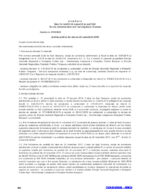
Romania vs “Milk and Dairy” A. SA, September 2020, Supreme Administrative Court, Case No 4702/2020
In regards of transfer pricing A. SA had two activities – production of dairy products and distribution of milk – that had been subject to an audit by the tax authorities which resulted in an assessment of additional taxable income. The transfer pricing assessment had been upheld by the court of first instance and A. SA then filed an appeal to the Supreme Court. In regards of production activities the main criticism by A. SA was that the tax authorities had replaced one market price with another price considered convenient by tax authorities, without legal basis, although the tax inspection accepted the list of companies and comparable transactions for all three sections of the file. The judge of the merits did not motivate his choice in law and supports the maintenance of the median according to the RIF, but does not specify how he reached this conclusion, the data for which the cost plus method is substituted and the legal grounds are not analysed. In regards of distribution activities the criticism was that the forensic accountant reached the same conclusion as the company under review, but the court did not retain it, stating that it would require the tax authority to request a change in the transfer pricing file. The court also noted that the expert “commented lapidarily” in his analysis and in his conclusion. It considers that the court’s conclusion to rely strictly on the tax authority’s interpretation is erroneous, since the tax authority does not regularly carry out price analyses on affiliated companies in the geographical area in which the company is located. In practice, as long as the tax body cannot be suspected of having business ideas, it also follows that the tax body cannot correctly and consistently analyse pricing in an independent market as well as in a controlled market; in the present case, however, the method was chosen by the tax inspectorate with the intention of maximising the amounts set for additional payment, without taking into account, as it should have, the objective factors and the legal provisions applicable in the case, which were interpreted erroneously, without taking into account the principles of the OECD Guidelines. The tax body has access to databases on transfer pricing practices within the ANAF central unit. In this respect, the query of the database by the tax authority is absolutely necessary in order to determine both the transfer pricing method and the prices charged, and not the arbitrary determination of a random method without any reasoning. Judgment of Supreme Court The Supreme Court dismissed the appeal of A. SA and upheld the decision of the court of first instance. Excerpts “7.3.3.1. Production activity. The main criticism on this aspect concerns the re-framing of all market prices in the comparison range with the median price. The tax authority removed two companies from the comparison list which did not meet the independence criteria and calculated separately for each of the years under review at the median level resulting from this recalculation. The first court held that the tax authority correctly referred to the median resulting from the comparison of the 4 companies that met the independence criteria and did not make an estimate in accordance with Article 3 of OPANAF No 222/2008, since formally, F. met the conditions to be used for the price comparison, but the median resulting from the analysis of the 6 companies is different from the one resulting from the removal from the comparison of the companies that did not meet the independence criteria, and the new C. pen. The new C.C. had been established in the abstract, ignoring the above calculation formula. In accordance with Article 2 of Order No 222/2008 on the contents of the transfer pricing file: “(1)The margin of comparison is the range of price or profit values for comparable transactions between comparable independent companies. (2) For the determination of extreme values, the comparison margin shall be divided into 4 segments. The maximum and minimum segments represent the extreme results. For the purpose of determining the comparator range, the extreme results within the comparator range will not be used. (3) If the transfer price consideration established by the taxpayer is not included in the comparison range, the competent tax authority shall establish the median value as the transfer price at market price. The median value shall be the value which is in the middle of the comparison range. (4) If the median value cannot be identified, the arithmetic mean of the two middle values of the comparison range shall be taken. (5) The benchmarking will consider territorial criteria in the following order: national, European Union, international.” The tax authority justified the measure taken by the fact that the adjustment occurred in the case of years for which the indicator in question was found to be lower than the minimum limit of the quartile range, and that applying the calculation of the adjustment to the median of the quartile range is correct and logical, because just as the indicator in question can have values lower than the median, so it can also have values higher than the median. The High Court finds that the first court applied the law correctly, validating the measure ordered by the tax authority. The applicant’s claim that the tax inspection team accepted the list of companies and comparable transactions for all three sections (concerning the activity of selling raw milk as a raw material, concerning the activity of producing dairy products and concerning the activity of distributing goods) cannot be upheld, so that it was not necessary to apply the median value for the transfer price at market price. The acceptance referred to by the tax authority concerned only the fact that the transfer pricing file submitted to the tax inspection met the minimum requirements in terms of content (comparative lists, calculation of profit indicators for the companies included in those lists, information from the accounting records). Otherwise, a tax audit would be pointless if the actual handing over
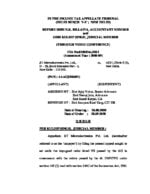
India vs ST Microelectronics Pvt. Ltd., September 2020, Income Tax Tribunal, ITA No.6169/Del./2012
ST Microelectronics Pvt. Ltd. is a subsidiary of ST Microelectronics Pte. Ltd. which in turn is a wholly owned subsidiary of ST Microelectronics NV, Netherlands. ST Microelectronics Pvt. Ltd. is into the business of Integrated Circuit Design, CAD Tools and software development for its overseas group concerns. It also provides marketing support services to a group company and software development services related to design implementation and maintenance with respect to Integrated Circuits as required by guidelines/instructions. During the year under assessment, the taxpayer entered into various transactions with its Associated Enterprises. In order to benchmark its international transactions qua provision of software development services and qua provision of marketing support services ST Microelectronics used Transactional Net Margin Method (TNMM) with Operating Profit/Operating Cost as the Profit Level Indicator (PLI) being the Most Appropriate Method (MAM), computed its own margin at 11.11% as against weighted average arithmetic mean margin of 19 comparables at 11.31% and found its international transactions at arm’s length. The Transfer Pricing Officer by applying qualitative and quantitative filters finally selected 13 comparables and computed their margin at 23.20% and thereby computed the adjustment of Rs.38,30,91,011/-. The taxpayer carried the matter before the Disputes Resolution Panel by way of filing objections who has excluded one comparable and included another comparable in the final list which resulted in a margin of 21.53%. On that basis the adjustment was revised to Rs.33,01,81,949/-. ST Microelectronics filed an appeal with the Income Tax Tribunal. Judgment of the Tribunal The Tribunal allowed the appeal filed by ST Microelectronics. Click here for other translation
Slovenia vs “Vehicles Distributor”, September 2020, Administrative Court, UPRS Sodba III U 208/2018-12
What “Vehicles Distributor” seeks to achieve in the present case is an attempt to adjust (reduce) the transaction price retrospectively by reference to a new transfer price, and not to claim repayment of the customs duty overpaid as a result of an incorrect customs value in the customs declarations upon release for free circulation. The customs declarations at issue were lodged as regular declarations and customs duties were levied on the value of the goods determined therein. It is not, therefore, the case that the value indicated in the declarations was arbitrary or fictitious or that the price at the time of sale of the goods could not be determined. Nor is there any basis in the facts for the applicant’s allegation that the goods were released for free circulation on the basis of the provisional value of the goods. Click here for English translation Click here for other translation
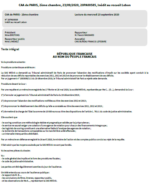
France vs Willink SAS, September 2020, CAA de PARIS, Case No 20PA00585
In 2011, Willink SAS issued two intercompany convertible bonds with a maturity of 10 years and an annual interest rate of 8%. The tax authorities found that the 8% interest rate had not been determined in accordance with the arm’s length principle. Willink appealed, but in a decision issued in 2019 the Administrative Court sided with the tax authorities. An appeal was then filed with the Court of Appeal. Judgment of the Supreme Court The Court of Appeal dismissed the appeal of Willink and upheld the decision of the Administrative Court. Excerpt “7. It is common ground that the funds Apax France VIII-A, Apax France VIII-B and the companies MidInvest and Telecom Online are linked to the company Willink, of which they are all partners, and that the rate of 8% exceeds the rate provided for in the first paragraph of 3° of 1 of Article 39 of the General Tax Code. To justify that this rate was not higher than the one it could have obtained from independent financial institutions or organisations under similar conditions, SAS Willink produced before the Court a comparative rate study carried out in 2020 using the Riskcalc software developed by Moody’s Analytics, a subsidiary of the rating agency Moody’s. This study is based on a model calculating the probability of default in the short term (one year) and the long term (five years) and then associates an implicit scoring. In order to select the most reliable and consistent scoring possible, this was determined on the basis of the applicant’s financial statements for the years 2011, 2012 and 2013. A search for comparable transactions on the open market was then carried out using the SetP Capital IQ database. Transactions were selected for which the issuing companies had a score comparable to Willink, issued by public or private companies across a range of industries during the relevant period. The sample was then refined, including transactions with a maturity close to each of the bonds to be compared. An interquartile range of arm’s length interest rates was then constructed on the basis of the bonds identified as comparables and used to identify median rates. 8. Although it is possible to assess the arm’s length rates by taking into account the yield on bonds, it is only on condition that, even if the loan is a realistic alternative to an intra-group loan, the reference companies are in comparable economic conditions. In the present case, this condition cannot be considered to be met for the companies selected in the sample of the report mentioned above. The level of risk used as a basis for comparison is based on a statistical model derived from historical quantitative data for companies that are not representative of the market, since defaulting companies are over-represented, and was determined on the basis of some ten financial data provided by the company itself. There is nothing to establish that this risk rating adequately takes into account all the factors recognised as forward-looking, and in particular the characteristics specific to the sector of activity concerned, even though this sector of activity is provided for the implementation of the model. Nor is it established that the so-called comparable companies in the study sample, which belonged to heterogeneous sectors of activity, would have presented the same level of risk for a banker as that with which the interested party was confronted at the same time. It follows that SAS Willink, which cannot usefully argue in these circumstances that the service cannot require a rating from a rating agency for each of the intra-group financing operations, cannot be regarded as providing the proof, which is incumbent on it, that it could have obtained a rate of 8 % from independent financial institutions or organisations under similar conditions. 9. It follows from all the foregoing that SAS Willink is not entitled to maintain that it was wrongly dismissed by the contested judgment of the Paris Administrative Court. Consequently, its claims for the application of Article L 761-1 of the Code of Administrative Justice can only be rejected.” Click here for English translation Click here for other translation
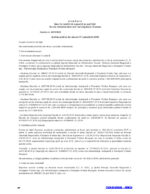
Romania vs “Machinery rental” S.C. A. SRL, September 2020, Supreme Administrative Court, Case No 4453/2020
An assessment had been issued where the pricing of intra group rental expenses for machinery had been set aside by the tax authorities for FY 2010-2013. By an application filed with the Court of Appeal S.C. A. S.R.L. requested the Court for annulment of the assessment. The Court of Appeal by judgment no. 164 of 31 October 2017, partially annulled the assessment. Unsatisfied with this decision, both parties filed an appeal to the High Court. S.C. A. S.R.L. considered that the first court misapplied the substantive rules of law applicable to the case with regard to the additional determination of a corporation tax in the amount of RON 56,715 for 2010, with reference to the interpretation of the OECD Guidelines. “Although the expert appointed by the court of first instance correctly established the adjusted margins of trade mark-up for each of the years 2010 to 2013 and the adjusted margins of operating profit for the same period, he erred in finding that, for the purposes of the final calculation, an analysis of the year-by-year comparability of the profitability indicators obtained in the period 2010 to 2013 is required. The approach is wrong because paragraphs 3.76 and 3.79 of the OECD Guidelines require the elimination of any market influences or gaps that may have an impact on the company, the only correct method being to use multi-year financial data. The use of this method is intended to minimise the impact of individual factors on comparable entities and the economic environment, as well as temporary economic factors such as the economic crisis.” Judgment of Supreme Court The Supreme Court upheld the decision of the court of first instance. Excerpts “As regards the method chosen, although the appellant criticises the ‘year-on-year’ comparability method, it does not specifically point out what its shortcomings are, but only why it is necessary to use the method of multi-year or agreed financial data. The ‘year-on-year’ comparability method was used because it was observed that the adjusted net trading profit margins and adjusted operating profit margins for 2012 were lower than the lower quartile limit, so it was correctly required to adjust the company’s 2012 revenue to bring the profitability indicators to the median of the market range obtained for independent comparable companies. Paragraph 3.76 of the OECD Guidelines was correctly interpreted by the court of first instance as meaning that the provision primarily considers the analysis of the data for the year under assessment and, in the alternative, the data for previous years, so that the use of the aggregate comparison method is not required. Furthermore, paragraph 3.79 of the OECD Guidelines states that the use of multi-yearly data may only be used to improve the accuracy of the range of comparison, but in the present case the appellant has not shown in concrete terms the consequences of using that method.” “With regard to the estimation of transfer prices and the increase of the tax base by the amount of RON 3 815 806, the appellant-respondent submits that the difference in income between the expert’s report and the tax inspection report is due solely to the fact that the expert used the indicators from 7 companies and the tax authority used the indicators from 3 companies out of the 11 chosen. The criticism is unfounded because the expert and, by implication, the court of first instance, demonstrated that there were 4 other companies which were comparable in terms of the activity carried out and for which the tax inspection authorities considered that there was no information, but it was demonstrated by the evidence in the file that they should be included in the comparability sample.” Click here for English translation Click here for other translation
Poland vs Cans Corp Sp z.o.o., August 2020, Administrative Court, I SA/Sz 115/20
At issue in this case was the remuneration of a Polish manufacturing subsidiary in an international group dealing in the production and sale of metal packaging for food products, including beverage cans, food cans, household cans and metal lids for jars etc. The Polish tax authorities had issued an tax assessment for FY 2009 – 2012 based on a TNMM benchmark study where financial results of comparable independent manufactures operating in the packaging industry showed that the the Polish manufacturing site had underestimated revenues obtained from the sale of goods to related entities The Court of first instance held in favor of the tax authorities. The case was then brought before the Administrative Court of Appeal. In the Court’s view, the authorities did not subject the case to thorough verification in accordance with the legal standards on which the decision was based – including, in particular, the analysis of comparable transactions (CUP’s). In the Court’s opinion, the authorities have illegally equated the fact of the loss achieved by the applicant with the data resulting from the general financial ratios for the entire activity of the applicant in 2013. The economic rationality of the transaction should be assessed, in the opinion of the Court, through the prism of the benefit that a specific entity may obtain from the transaction and not in relation to general financial ratios of the compared entities covering the entirety of their activity for a given year. For as long as the tax authority does not prove that the difference in price conditions was only for the purpose of tax avoidance and did not result from economic conditions, the abovementioned Article 11 cannot be applied (cf. glossary to the judgment of the Supreme Court of 22 April 1999, Case No III RN 184/98, OSP 2000, No 5, p. 264). Click here for translation
Greece vs “G Pharma Ltd”, july 2020, Administrative Tribunal, Case No 1582/2020
“G Pharma Ltd” is a distributor of generic and specialised pharmaceutical products purchased exclusively from affiliated suppliers. It has no significant intangible assets nor does it assume any significant risks. However for 17 consecutive years it has had losses. Following an audit, the tax authorities issued an assessment, where the income of G Pharma Ltd was determined by application of the Transactional Net Margin Method (TNMM). According to the tax authorities a limited risk distributor such as G Pharma Ltd would be expected to be compensated with a small, guaranteed, positive profitability. G Pharma Ltd disagreed with the assessment and filed an appeal. Judgment of the Court The court dismissed the appeal of G Pharma Ltd and upheld the assessment issued by the tax authorities. Excerpts “First, the reasons for the rejection of the final comparable sample of two companies were set out in detail and then the reasons for using the net profit margin as an appropriate indicator of profitability for the chosen method of documenting intra-group transactions were documented in a clear and substantiated manner, citing the relevant OECD guidelines, in order to establish whether or not the principle of equidistance was respected. Subsequently, since the claim concerning the inclusion of the company ……………………. in the final sample of comparable companies was accepted, the calculations of the arm’s length thresholds were provided in order to assess whether or not the arm’s length principle was respected. Following the above, the method of calculation of the resulting difference due to the non-respect of the arm’s length principle in the intra-group invoicing of the applicant’s transactions with the related companies of the group was analysed. Consequently, the applicant’s claims in respect of the first plea in law of the application are not upheld and are rejected as unfounded in law and in substance. Because the applicant itself, as documented in detail in the documentation file, arrived at the above method of documentation, which it nevertheless applied on incorrect bases. The choice of the gross profit margin as an appropriate indicator of profitability is incorrect as it is not provided for in the OECD guidelines” “based on the above, it would be expected that it would be compensated with a small, guaranteed, positive profitability. Instead, the picture it presents over time is one of a company with consistently disproportionately high losses from inception to the present day beyond any notion of business sense or contrary to normal commercial transactions, which demonstrates the need to adjust its intragroup pricing given the fact that all of its purchases and a significant portion of its operating expenses are intragroup transactions. Since the applicant’s claim that ‘in calculating the adjustment to its operating profitability, due to non-compliance with the arm’s length principle, account should also be taken of the adjustments to the tax adjustment already made by the accounting differences declared by the company’ cannot be accepted and is rejected, since this is a comparison between dissimilar figures, that is to say, a comparison between the applicant’s tax result and the accounting results of comparable companies in the sample. Because the applicant’s claim that, ‘any adjustment to its operating profitability should be based on the 1st quartile value and not that of the median’, is not accepted and is rejected, as, when assessing the operating profile, the applicant performs additional functions beyond a mere reseller and in particular than the comparable companies in the final sample as it has a disproportionately high cost of operating expenses to gross income compared to the comparable companies. Moreover, none of the comparable undertakings in the final sample is representative of the industry as they all have similar gross revenues to the applicant and therefore similar market share in the pharmaceutical industry. The choice of the median is the most appropriate because it eliminates possible comparability deficits (differences in factors and circumstances) that may exist between the applicant and the undertakings in the sample. Because the tax audit has come to the clear and well-founded conclusion that the pricing policy pursued by the applicant with its related undertakings does not comply with the arm’s length principle and is outside the acceptable limits. Since it follows from the foregoing that the contested income tax assessment measure was lawfully adopted, the applicant’s claims to the contrary must be rejected as unfounded.” Click here for English translation Click here for other translation
Poland vs “Fish Factory” sp. z o.o., July 2020, Administrative Court, I SA/Gd 184/20 – Wyrok
The activity of Spółka A sp. z o.o. included salmon breeding, processing, smoking and sale and distribution of the finished products. The company operated within Group A with head quarter in the Netherlands. By decision of 27 May 2019, the tax authorities determined that the operating expenses determined by transactions with related parties were inflated by PLN 29,613,156.00. The authorities did not accept calculations presented by the Company, as there were no reliable accounting records regarding the amount of costs incurred. Furthermore, the authorities held that the cost plus method, which should guarantee profit on the transaction in the Company, had been applied incorrect. The dispute before the administrative Court boils down to assessing whether the court of first instance, in compliance with the provisions in force, reversed the decision of the authorities in its entirety and referred the case back for reconsideration due to the deficiencies found in the evidentiary proceedings, making it necessary to conduct the proceedings in a significant part. “As indicated by the Supreme Administrative Court in its judgment of 20 June 2018 in case II FSK 1665/16, the regulation contained in Art. 11 of the LLD is a special regulation and its purpose is to protect the interests of the State Treasury against such activities of taxpayers which consist in applying prices deviating from market prices in controlled transactions in order to achieve a favourable tax result for themselves. Therefore, the rationale for the application of Article 11 of the ACT is not only the fact of occurrence of the relationship referred to in paragraphs 1 and 4, but the use of those relationships to change the level of taxation (tax avoidance). The regulation contained in Article 11 of the CFRA is based on the assumption that all transactions should comply with market conditions, i.e. conditions which would be agreed upon by independent entities in the same or in a similar situation. However, the mere fact of economic relations referred to in Article 11 of the CFR may not in itself give rise to negative tax consequences for related entities. However, the use of such relationships to change the level of taxation contrary to the statutory obligation is of tax significance. Using the position of affiliated entities for such purpose finds a tax sanction, which is the estimation of income. However, this sanction cannot be applied without proving that the related party position is used to shift income (profits) in order to reduce taxation. The findings in this respect should have the characteristics of a clear, logical conclusion from the evidence gathered. “…The estimation of prices applied in transactions between taxpayers and related parties cannot be made solely by simply transferring the price or margin from a transaction between independent parties – without assessing the comparability of the terms of those transactions. The tax authority, based on comparative data, should therefore primarily demonstrate the reliability of the transactions (entities) compared, and thus also refer to the economic functions and strategies applied by operators, also in the context of assessing the importance of these factors for the possibility of comparison.” “…in the opinion of the Court, the Director of the Chamber rightly revoked the decision of the tax authorities of 27 May 2019 due to failure to observe the obligation to analyse the possibility of applying the so-called traditional methods of estimating the income of a Party, indicated in the Regulation, and failure to justify the reasons why the Body decided that those methods could not be applied in this case. The First Instance Authority did not justify that the most appropriate pricing method in the case should be the transactional net margin method.” Click here for translation

Greece vs “Agri Ltd”, july 2020, Administrative Tribunal, Case No A 1514/2020
A Greek MNE Group, “Agri Ltd”, was active and specialised in wholesale trade of agricultural machinery, parts and tools. In 2012 a German company was established by the group to distribute products in the Central European region. The pricing of the goods sold by Agri Ltd. to the German distributor was determined by testing the income of Agri Ltd using a TNMM. Following an audit the tax authorities issued a revised tax assessment, where the pricing of the inter-company transactions had instead been determined by applying a traditional cost plus method where the German subsidiary was the tested party. The resulting assessment was appealed by Agri Ltd. Judgment of the Tribunal The Tribunal dismissed the appeal of Argri Ltd. “Since the tax audit, documented and clearly concluded that the cost plus margin method should have been chosen for the sales of the applicant to its subsidiary, the findings of the audit, as recorded in the 18.12.2019 Partial Income Tax Audit Report, are considered valid, acceptable and fully justified. Since it is clear from the above that the impugned income tax adjustment order was lawfully issued, the applicant’s contentions to the contrary are rejected as unfounded.” Click here for English translation Click here for other translation
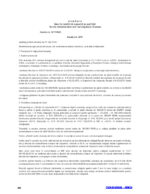
Romania vs “Stone” A SRL, July 2020, Supreme Administrative Court, Case No 3217/2020
“Stone” A SRL had bought stones/minerals from related parties and paid for certain services. Following an audit the tax authorities had issued an assessment, where the price paid for stones had been adjusted based on cost plus method and deductions for costs of services had been denied due to lack of benefit. The court of first instance upheld the assessment in regards of the profit adjustment related to purchase of stones, but set aside the assessment in regards of denied deductions for services. This decision was appealed to the Supreme Court by both “Stone” A SRL and the tax authorities. Judgment of Supreme Court The Supreme Court found the appeal unfounded and upheld the decision of the court of first instance. Excerpt “The appellant claimed that the court of first instance misapplied the OECD Guidelines (Organisation for Economic Co-operation and Development transfer pricing guidelines) in adjusting/deducing the expenses by the amount of RON 24 703 representing the value of the stone purchased in 2010 from E. S.R.L.. That criticism is also unfounded. It appears from the contents of the RIF that the tax authority proceeded, in accordance with Article 11 para. (2) (a) of Law No 571/2003, to adjust the expenses with the cost of the raw materials in question using the net margin method, after having verified the transfer price file in the form and with the explanations submitted by the applicant. The applicant considers that account should have been taken of the price of the stone purchased, which would have been of a higher quality than that supplied by other trading partners, to which transport costs were added. However, the party fails to recognise that such an argument had to be accompanied by appropriate evidence of the facts relied on, which in fact was not the case either in the administrative procedure or before the first instance. Even the technical expert appointed stated that he did not have access to the documents of E.S.R.L. in order to be able to carry out a comparative verification of the price charged in relation to the appellant applicant compared with the relationship with other business partners, limiting himself to assuming only that the transport of raw materials was also taken into account, although the High Court finds that such a circumstance is not apparent from Contract No x/2009 concluded between the companies.” “According to Article 11(11)(a) of Regulation No 17 (2)(b) of Law No 571/2003, in the context of a transaction between related Romanian persons, the tax authorities may adjust the amount of the income or expenses of any person, as necessary, to reflect the market price of the goods or services provided, based on the cost plus method, whereby the market price is established on the basis of the costs of the good or service provided by the transaction, increased by the appropriate profit margin. In the present case, however, the cost-plus method used and described by the appellant was not correctly applied, as the production costs were not separately identified by category of customer – affiliated and non-affiliated, so that the first instance lawfully and properly upheld the findings in the contested tax documents to the effect that the appellant did not provide a full justification of the transfer price, even after the submission of additional documents, following the request of the inspection bodies. Thus, it was precisely Article 11 of the Tax Code, Article 3(3)(a) and (b) of the Tax Code, which was given effect to. (1) Annex 3 of the MFP Order no. 222/2008 (“identification of three examples of transactions similar to those to be assessed”) and point 29 of the Methodological Norms for the application of Art. 11 of the Tax Code (“the net margin method involves calculating the net profit margin obtained by a person from one or more transactions with related persons and estimating this margin on the basis of the level obtained by the same person in transactions with independent persons […]”), relied on by the appellant, by selecting a sample of 3 comparable companies (taken into account under D. P.T.), operating in the same field as the appellant, taking into account the same indicators for the selected affiliated and non-affiliated persons and identifying examples of transactions similar to those to be estimated.” Click here for English translation Click here for other translation
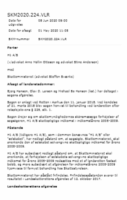
Denmark vs Tetra Pak Processing Systems A/S, June 2020, Court of Appeal, Case No SKM2020.224.VLR
At issue was whether the Danish tax authorities had been entitled to make a discretionary assessment of the taxable income of Tetra Pak on the basis of inadequate transfer pricing documentation and continuous losses. And, if such a discretionary assessment was justified, whether the company had satisfied the burden of proving that the tax authorities’ assessments were manifestly unreasonable. The Court held that the transfer pricing documentation provided by the company was so inadequate that it did not provide the tax authorities with a sufficient basis for determining whether the arm’s length principle had been observed. The tax authorities were therefore entitled to make a discretionary assessment of the taxable income. To this end, the Court held that the tax authorities were entitled to use the TNM method with the Danish company as the test person, since sufficiently reliable information on the group’s sales companies had not been provided. (In April 2021 a final decision (Tetra Pak) was issued by the Danish Supreme Court.) Click here for translation (Part I) Click here for translation (Part II)
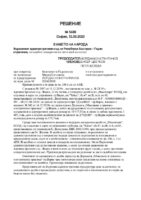
Bulgaria vs Maxilari EOOD, May 2020, Supreme Administrative Court Case no 5499 (2524/2020)
Maxilari sells mushrooms imported from Poland to related parties. Following an audit, the tax authorities concluded that the sale was made at significantly lower prices than the market price. This conclusion was derrived by applying a CUP method where the prices of the mushrooms was compared to commodity prices of similar products. A complaint was filed by Maxilari with the Administrative Court which later held that the assessment was in accordance with the substantive law – on the basis of the information gathered on wholesale sales of similar goods, the revenue authorities correctly determined the market prices for the sale of such goods, referring to the data provided by the State Commission for Commodity Exchanges and Auctions, whose reply is official, the data relate to a specific geographical area and market conditions identical to those under which the applicant trades, the price indicated is wholesale. On that basis the Court concluded that Maxilari’s appeal was unfounded. An appeal was then filed by Maxilari with the Supreme Administrative Court. Judgment of the Supreme Administrative Court The Supreme Administrative Court set aside the decision of the Administrative Court and ruled in favour of Maxilari. Excerpts “This Court does not share his conclusion and finds it unsupported by the facts of the case. It follows from the definition of the comparable uncontrolled price method in Article 18(1) of the Ordinance that this method requires a comparison between the price of a good or service in a controlled transaction and the price of a good or service in a comparable uncontrolled transaction. By definition – §1, item 2 of the Regulation, “uncontrolled transaction” is a transaction made between independent / unrelated / persons. The analysis of the facts of the case leads to the conclusion that in practice the revenue authority has not established such an “uncontrolled transaction” on the basis of which it has made the comparison with the sales prices of the audited company. The information submitted by the State Commission for Commodity Exchanges and Auctions does not contain any data on the type of mushrooms /mushrooms or other cultivated ones/, the importing country, the quantity and quality of the mushrooms, the companies trading in cultivated mushrooms. The absence of such information excludes the possibility of carrying out a comparability analysis as required by Article 6 of the Ordinance. In the course of the audit, the obliged person has given explanations that he purchases quantities of mushrooms of low quality, with little durability, that he has no costs for transport, storage, etc. /which was also established during the audit/, and therefore sells at such low prices. At the same time, a valuation expertise was appointed in the case /both basic and additional/, and in the additional conclusion, an analysis was made of the market prices at which similar mushrooms imported from Poland were sold by third parties not related to the audited company, which prices did not differ significantly from the prices at which Maxilari Ltd. sold. That expert report was not commented on at all by the Court of First Instance and the expert’s findings are not contradicted by the other evidence in the case. The new documentary evidence submitted with the cassation appeal concerning the market prices should not be discussed in the light of the prohibition of new facts under Article 220 of the Code of Civil Procedure. In addition, the appellant submits that it has submitted evidence of final audit certificates, whereas in fact audit reports of three companies have been submitted and there is no evidence that audit certificates have been issued on the basis of those reports. In view of the foregoing, it should be held that the revenue authority has not proved with admissible means of evidence the existence of a hypothesis under Article 15 in conjunction with Article 16, paragraph 1 of the Income Tax Act, giving grounds for the financial result of the company to be transformed in accordance with Article 78 of the Income Tax Act and to be determined additional corporate tax liabilities and interest for delay. By holding otherwise and rejecting the appeal of the company against the contested revision act, the Administrative Court – Varna has rendered an incorrect judgment.“ Click here for English translation Click here for other translation
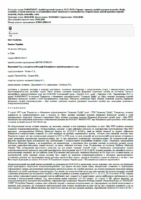
Ukrain vs Ajalyk Trade LLC, February 2020, Supreme Administrative Court, Case No 804/5360/17
In the case of Ajalyk Trade LLC, the Supreme Court ruled in favour of the tax authorities, confirming the legality of the tax adjustment. The court held, that if the quantity and price of goods are determined in the specifications of the contract and/or in additional agreements, the contract cannot be considered a forward contract for tax purposes. As a result, the taxpayer cannot compare prices in controlled transactions with prices in comparable uncontrolled transactions at the time where such an agreement is concluded. Click here for English translation Click here for other translation
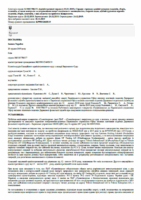
Ukrain vs Sumykhimprom, December 2019, Supreme Administrative Court, Case No 818/1786/17
The “Sumykhimprom” case concerned export transactions of fertilizers to a related party in Switzerland and import transactions of natural gas from a related party in Cyprus. According to the tax authorities, the pricing of the controlled export transactions of fertilizers had been below arm’s length and the pricing of the controlled import transactions of natural gas had been above arm’s length. Judgment of the Supreme Court The Supreme Court confirmed the position of the tax authorities, determined based on the results of the audit of controlled transactions of a producer of mineral fertilizers, and the legality of additional corporate income tax in the amount of UAH 43 million and a reduction of losses carried forward by UAH 195 million. If the company carried out potentially comparable with controlled uncontrolled operations, it can use them, including for the application of the net profit method. However, the delivery conditions must be comparable, since they affect the functionality of the company, the price and, therefore, comparability. In the calculation of profitability income and expenses from exchange rate differences must be taken into account. Click here for English translation Click here for other translation
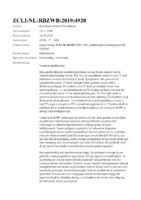
Netherlands vs “Fertilizer BV”, November 2019, District Court, Case No. ECLI:NL:RBZWB:2019:4920
In 2016 Fertilizer BV had been issued a tax assessment for FY 2012 in which the tax authorities had imposed additional taxable income of €162,506,660. Fertilizer BV is the parent company of a fiscal unity for corporation tax (hereinafter: FU). It is a limited partner in a limited partnership under Dutch law, which operates a factory in [Country 1]. The interested party borrowed the money for the capital contribution to the limited partnership from a wholly-owned subsidiary. The share in profits from the limited partnership was expressed as profit from a permanent establishment. In dispute was the amount of interest attributable to the permanent establishment. The court followed the inspector in allocating – in connection with the [circumstances] in [Country 1] – 75% equity and 25% loan capital to the PE. Furthermore, the FU had deposits and loans in USD. These positions were partly hedged by forward exchange contracts. Fertilizer BV valued these deposits and loans at the historical acquisition price or lower value in use. In dispute between the parties was whether and to what extent the positions should be valued as connected. In the opinion of the court, the mere fact that deposits and loans were denominated in USD did not mean that they should be valued as connected. The court considered part of it to be connected. Fertilizer BV is a production company. It sells its products to affiliated sales organisations at prices derived from market prices. After the commissioning of a new factory, Fertilizer BV produced more than before (hereinafter: the surplus). On the basis of two agreements, Fertilizer BV sold the surplus, at cost price with a surcharge of 5%, to a subsidiary established abroad. In the opinion of the court, no real commercial risk had been transferred to the subsidiary and the inspector rightly corrected the taxable amount. Click here for English Translation Click here for other translation
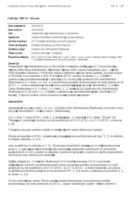
Poland vs “Cans Corp”, September 2019, Provincial Administrative Court i Szczecin, Case no SA/Sz155/19
At issue in this case was the remuneration of a Polish manufacturing subsidiary in an international group dealing in the production and sale of metal packaging for food products, including beverage cans, food cans, household cans and metal closures. The tax authorities had issued an tax assessment for FY 2009 – 2012 based on a benchmark study. Decision of the Administrative Court The Court upheld the decision of the tax authorities concerning income for the tax year from 01/01/2012 to 31/12/2012. In 2012, the Polish manufacturing site operated by producing lids for jars. In the course of the audit proceedings against the Party regarding corporate income tax for 2012, the first instance authority determined – based on a comparative analysis of the financial results of similar independent manufactures operating in the packaging industry on the market in Central and Eastern Europe, that this market showed an upward trend and in none of the years 2009-2012 this industry recorded a downward trend, reaching in the audited year 2012 In the case of three selected domestic entrepreneurs selected for analysis profitability based on EBIT from 8.52 % to 13.13%, and in the case of companies operating on markets in Central and Eastern European countries – the interquartile range determined on the basis of the EBIT ratio: upper quartile 10.30%, median: 8.69%, lower quartile 7.74%. The above circumstances allowed the authority of first instance to state that the the Polish manufacturing site had underestimated revenues obtained from the sale of goods to related entities Thus, in the opinion of the Court, it became necessary to determine the Party’s income. The above conclusions – regarding the lack of application by the Party in transactions with related entities of market prices of goods sold – the authority derived from the conducted comparative analysis of entities dealing with identical activities of the Party (i.e. the production of food packaging). The tax authorities subjected this analysis to the entities selected by it that have no connections with other entities, selected in terms of criteria such as: area of activity, PKW codes, turnover, period of activity, and then (due to the fact that the above typing criteria allowed to obtain a comparative base consisting of only three units) extended them by a geographical criterion, then is other Central […] countries, obtaining a database of six entities in total. Profitability based on the EBIT ratio was compared in this group (according to the formula: operating profit (operating loss / operating income x 100%). obtaining a database of six entities in total. Profitability based on the EBIT ratio was compared in this group (according to the formula: operating profit (operating loss / operating income x 100%). obtaining a database of six entities in total. Profitability based on the EBIT ratio was compared in this group (according to the formula: operating profit (operating loss / operating income x 100%). Click here for translation
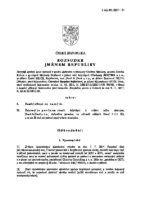
Czech Republic vs. AZETKO s.r.o., September 2019, Supreme Court, No. 5 Afs 341/2017 – 47
The tax authorities of the Czech Republic issued an assessment of additional income taxes and penalties for FY 2010 and 2011, because AZETKO s.r.o. according to the tax authorities did not receive an arm’s length remuneration for administration and operation of a website and e-shop on behalf on a related party, Quantus Consulting s.r.o. AZETKO disagreed with the assessment and brought the case to court. The regional court ruled in favor of AZETKO, but the tax administration appealed the decision to the Supreme Administrative Court. Judgment of the Supreme Court The Supreme Court found the tax administrations change in pricing method under the appeal of the case unsubstantiated. The tax administration had originally applied the CUP method, but in the appeal proceedings instead used the net margin transaction method (TNMM). On that basis, the appeal was dismissed by the Court. The conditions for application of the transfer pricing provisions in Section 23(7) of the Czech Income Tax Act was summarised by the Court as follows If it is proved that the parties are related persons within the meaning of Section 23(7) of the Income Tax Act, it is for the tax administrator to prove that the prices agreed between these persons differ from the prices that would have been agreed between independent persons in normal business relations under the same or similar conditions. Therefore, the principle that in tax proceedings it is the tax subject who bears the burden of allegations in relation to its tax liability and the burden of proof in relation to these allegations does not apply (cf. The tax administrator must therefore carry out a comparison in which it must establish both the price agreed between the related parties and the normal price (compared with the average price, the so-called reference price) at which independent persons trade in a comparable commodity. A necessary (but not sufficient) condition for the adjustment of the tax base under Section 23(7) of the Income Tax Act is the existence of a price difference. In order to establish the ‘normal’ nature of the price, the administrator must be able to bear the burden of proof in relation to all relevant aspects. The tax authorities can, and usually will, determine the normal price by comparing the prices actually obtained for the same or similar commodity between genuine independent operators. However, it may determine it, in particular because of the absence or unavailability of data on such prices, only as a hypothetical estimate based on logical and rational reasoning and economic experience. On the issue of business strategy the court provided the following insights “According to the above-mentioned guidelines, a business strategy is understood as an attempt to penetrate a new market, where prices can be significantly distorted by higher costs of introducing a product to the market while applying a lower final selling price of this product, but it can also be different circumstances. In assessing this factor, the SAC agrees with the regional court that the administrative authorities assessed the business strategy only for the applicant, namely that it is an established company with an established business program. However, for the companies being compared, they did not assess this factor, and the influence of this question on the assessment of the present case cannot be ruled out without further ado.” Click here for translation
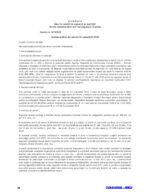
Romania vs “Broker” A SRL, September 2016, Supreme Administrative Court, Case No 3818/2019
Following an audit Broker A SRL was ordered to submit corrective statements on the corporate income tax for the tax years 2016 and 2017, and not to take over the tax loss from previous years, in the amount of RON 62,773,810 in 2016 and 2017. The tax authorities had found shortcomings in the comparability study drawn up by the company and replaced it with their own study. According to Broaker A SRL the transfer pricing adjustment was unlawful: the measure of reworking the comparability study has no legal basis and was not reasoned by the tax authorities; the findings of the tax inspection bodies are based on a serious error concerning the accounting recognition of A. BV’s income in its records; unlawfulness as regards the adjustment of income in respect of support services. ANAF has made serious errors of calculation by reference to its own reasoning in establishing the adjustments. unlawfulness of the tax decision in relation to the adjustment of expenditure on strategic management services. The findings of the tax inspection team lead directly and directly to double taxation at group level of this income, to which the following criticisms are made: the tax authorities erroneously adjusted income relating to strategic management services which were not the subject of the Support Services Contract between A. SRL and A. BV and which were not provided by the company; the imposition of the obligation to re-invoice A. BV for management services leads to double taxation at group level. Judgment of Supreme Court The Supreme Court found the appeal of Broker A SRL unfounded and upheld the assessment of the tax authorities. Click here for English translation Click here for other translation
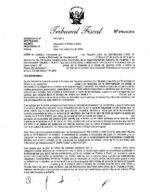
Peru vs “Lender SA”, September 2019, Tax Court, Case No 07944-9-2019
“Lender SA” had granted loans to its shareholders and, following an audit, the tax authorities concluded that the interest payments on these loans had not been at arm’s length. A tax assessment was issued which increased the taxable income of “Lender SA” by additional interest. The tax authorities had determined the “arm’s length” interest rate based on an average of the interest rates used by banks for loans with the same duration. “Lender SA” appealed to the Tax Court. Decision of the court. The Tax Court dismissed the tax authorities’ assessment. The court concluded that the interest rate on the loans had not been sufficiently substantiated by the tax authorities. The duration of the loans is not the only comparability factor. Factors such as contractual terms, economic circumstances, loan amounts, guarantees, creditworthiness and credit rating must also be taken into account when determining the arm’s length interest rate of a loan. Excerpt in English “In the case under analysis, it can be seen that in order to find the market value of the observed transaction, the Administration used the uncontrolled comparable price method, which is based exclusively on the price or amount of the consideration that would have been agreed with or between independent parties in comparable transactions. To the extent that the transaction observed corresponds to a loan of money in which the price or amount of the consideration is interest, the application of the comparable uncontrolled price method in this case involves comparing the interest rates of loan transactions made under the same or similar conditions to the loan transactions under analysis. As mentioned above, the Administration obtained the comparable interest rates based on the analysis of the average annual lending interest rates of operations in local and foreign currency of the banks BBVA Continental, Crédito, BANBIF, Scotiabank Perú, Citibank Perú, Interbank and HSBC Bank Perú, according to the information obtained from the web page of the Superintendencia de Banca y Seguros, whose review shows that they correspond to average interest rates of a referential nature. That this Court has established in Resolution No. 05608-1-2017, that for purposes of the application of the comparable uncontrolled price method involves the comparison of interest rates of loan transactions made under the same or similar conditions to the loan transactions, for which the element of loan terms and their qualification as commercial credits is not sufficient for comparability, but must be evaluated for each of the transactions, considering for this purpose the characteristics of the transactions, the economic functions or activities, the contractual terms, the economic or market circumstances, among others. That according to the above, the Administration considered as the only element in its analysis of comparability the term of the loans, determining on this basis a range of interest rates that it considered as market value, however, according to the aforementioned criterion it should have considered for such analysis the characteristics of the operations, the functions or economic activities, the contractual terms, the economic or market circumstances, the amounts of the loans, the existence or not of guarantees, the solvency and credit rating of the debtor, among others, which influence the determination of the interest rates. In this regard, it has not been proven that the Administration had made a due comparison of the same or similar operations in order to correctly establish the market value of the interest rates in application of the transfer pricing rules, specifically, in accordance with the provisions of paragraph d) of article 32-A of the Income Tax Law, and therefore, the objection is not supported and should therefore be lifted. Click here for English Translation
France vs SAS Wheelabrator Group, July 2019, Conseil d’Etat Opinion, No 429426
In an Opinion issued on 10 July 2019 on request from the Administrative Court of Versailles, the Conseil d’Etat states as a principle that the arm’s length nature of intra-group interest rate can be demonstrated by reference to comparable unrelated transactions, when these loans constitutes realistic alternatives to the intra-group loan. Excerpt from the Opinion “… 5. The rate that the borrowing enterprise could have obtained from independent financial establishments or organizations under similar conditions means, for the purposes of these provisions, the rate that such establishments or organizations would have been susceptible, account given its own characteristics, in particular its risk profile, to grant it for a loan with the same characteristics under arm’s length conditions. 6. This rate cannot, having regard to the difference in nature between a loan from a financial institution or body and financing by bond issue, be that which this enterprise would itself have been able to serve for subscribers if it had chosen to finance itself by issuing bonds rather than taking out a loan. 7. The borrowing enterprise, which bears the burden of proving the rate that it could have obtained from independent financial institutions or organizations for a loan granted under similar conditions, has the option of providing this proof by any way. As such, to assess this rate, it may if necessary take into account the yield on bond loans issued by companies in comparable economic conditions, when these loans constitute, in the hypothesis considered, a realistic alternative to a intra-group loan. 8. This notice will be notified to the Versailles Administrative Court, to the simplified joint stock company Wheelabrator Group and to the Minister for Public Action and Accounts. It will be published in the Official Journal of the French Republic.” Click here for translation
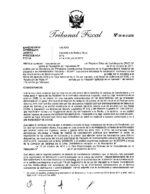
Peru vs “Pharma-Distributor”, July 2019, Tax Court, Case No 06144-9-2019
As a result of a tax audit initiated against “Pharma-Distributor”, the Peruvian tax authority, SUNAT, issued an assessment where an adjustment of transfer prices in the amount of S/. 5,720,692.00 was added to the taxable income for FY 2009. SUNAT had applied the transactional net margin method, instead of the resale price method, used by “Pharma-Distributor”. SUNAT found that the resale price method used by “Pharma-Distributor” was not the most appropriate method, since it does not include other functions directly related to its business activity such as sales force, advertising, marketing, reflected in the expenses assumed in medical visitors, promotions, medical samples, merchandising, promoters, events and conferences for doctors, among others, which are accounted for at the operating profit level. Comparability adjustments were made by the tax authorities considering certain exceptional events that affected the normal operations of “Pharma-Distributor”, such as: i) issuance of credit notes in excess for extraordinary discounts, ii) problems with inventory management and iii) payment of liberalities. After these adjustments had been made it was determined that “Pharma-Distributor” had an operating profit below the arm’s length operating profit established by the benchmark analysis. Not satisfied with the assessment, “Pharma-Distributor” appealed to the Tax Court. Decision of the Tax Court The Court upheld the assessment issued by the tax authorities and dismissed the appeal of “Pharma-Distributor”. “As explained above, in order to calculate the comparability adjustment in question, the Administration verified the levels of sales and discounts that the appellant had had in the last two years (2008 and 2009), observing that the amount of discounts applied via credit notes had been increasing as 2008 went by and during the first eight months of 2009, but that the real boom in the issuance of the aforementioned credit notes occurred between the months of September and December 2009, for which reason it took that period as the “exceptional period”, and considered the other months of 2009 as the “normal period”, which turns out to be a reliable criterion, given that in effect, during the first eight months of 2009, the level of issuance of credit notes ranged between 13% and 29%, that during 2008 said level reached a peak of 21% and that during the months of September to December 2009, the aforementioned level ranged between 44% and 122%, It is clear that it is in these last months that the appellant reached a high level of credit note issuance in comparison with the previous months of 2009, thus showing that the Administration gave reasons and a due explanation on the calculation it made, contrary to the appellant’s arguments. Although the appellant alleges that the “normal” period and the “exceptional” period should refer only to full years in application of Article 57 of the Income Tax Law and Article 110 of its regulations, it should be noted that the first of said articles refers to the taxable year considered by the Income Tax Law for the allocation of income and expenses, and the second is related to the authority of the Administration to consider information from the taxpayer and comparable operations corresponding to two or more previous years and to use information from the taxpayer is not required to use the information from previous years in order to determine the origin of the reported losses, when such losses are part of other losses generated in comparable transactions or are the result of specific conditions of previous years, within the framework of the comparability analysis; nevertheless, it is not apparent that any of such articles, obliges the Administration to make the calculation of a comparability adjustment considering only information of whole years or fiscal years, as alleged by the appellant, because as it is noted, it is feasible to consider different periods (longer or shorter), as long as its application has been duly explained and responds to the purpose of any comparability adjustment, that is, to improve the level of comparability, making the commercial characteristics of the appellant as similar as possible to that of the comparable companies. Furthermore, in the present case, the comparability adjustments were related to the “exceptional events” that occurred in 2009, being that in the case of the credit notes, it was verified that this occurred in the months of September to December 2009. It should also be noted that according to the OECD Guidelines mentioned above, the objective is to arrive at a reasonable approximation of what would be an arm’s length result based on reliable information, stating that transfer pricing is not an exact science, but requires value judgments by both the Tax Administration and the taxpayers. Likewise, there is no provision that establishes the use of the same methodology or a standard criterion for the calculation of all the comparability adjustments that are required to be made to make the information comparable in a given case, therefore, the fact that the Administration has made the calculation of the comparability adjustment for inventory devaluation, considering full years or fiscal years (January 1 to December 31), does not imply that the calculation of the adjustment for excess credit note issuance should also be determined under the same calculation criterion, and that the contrary would lead to its loss of reliability, does not imply that the calculation of the adjustment for excess issuance of credit notes should also be determined under the same calculation criterion, and that the contrary, leads to its loss of reliability, even more so when based on the documentation provided by the appellant corresponding to the previous fiscal year and the fiscal year audited, it does not appear that in the first months of fiscal year 2009 the specific special conditions that motivated the extraordinary issuance of credit notes for discounts had taken place.” Click here for English Translation
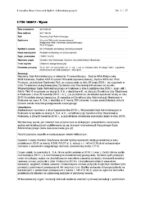
Poland vs L S.A, June 2019, Supreme Administrative Court, Case No. II FSK 1808/17 – Wyrok NSA
A Polish subsidiary in a German Group had taken out a significant inter-company loan resulting in a significantly reduced income due to interest deductions. At issue was application of the Polish arm’s length provisions and the arm’s length nature of the interest rate on the loan. The tax authorities had issued an assessment where the interest rate on the loans had been adjusted and the taxable income increased. On that basis, a complaint was filed by the company to the Administrative Court. The administrative court rejected the complaint and ruled in favor of the tax authorities. An appeal was then brought before the Supreme Administrative Court. The Supreme Administrative Court rejected the appeal, although it did not share some of the conclusions and statements of the Court of first instance. The key issue in the case was to determine is whether the provisions of Art. 11 (Containing the Polish arm’s length provisions), allowing the authority to determine the income of the Company and the tax due without taking into account the conditions arising from existing relationships, including capital applies. Art. 11 paragraph 1 and paragraph 4. allows for the this provision to apply if three cumulative conditions are met: 1) the existence of connections between the parties referred to in art. 11 paragraph 1 points 1-3 or in para. 4 item 1 or 2 update; 2) the impact of these connections resulting in conditions that differ from those that would be agreed between independent entities; 3) the taxpayer’s failure to recognize income or income lower than would be expected if the above mentioned connections had not been there. The Supreme Administrative Court agreed that these cumulative conditions are met. The authority has made estimates of income on the basis of § 21 paragraph. 1 and 2 cited above. Regulation in the light of which it rules, if the taxpayer to provide an entity affiliated with the taxpayer loan ( credit ) or will receive such a loan ( credit ), regardless of their purpose and destiny, or also give or receive in any form of warranty or guarantee, the price of the market for this service are the interest or commission or other form of remuneration, which agreeing on for such a service, provided on comparable terms , entities independent ( paragraph. 1). The arm’s length interest rate is determined on the basis of the interest, that the entity would have to pay an independent party for obtaining a loan ( loans ) for the same period in comparable circumstances. However, according to the Supreme Administrative Court the inter group loan agreement differs from the typical loan agreements concluded by banks. The applicant does not conduct an economic activity identical to that of banks; With regard to the nature of the transaction applicant suffered much less risk of insolvency of a counter party, than borne by the bank in relation to the borrowers; The Company had a much greater possibility of controlling the situation of the financial and solvency of the counter party in the course of the duration of the contract than the bank in case of a contract of credit; The applicant does not bear the costs of verifying the ability of credit counter party and had the opportunity to immediately recover the funds provided in the framework of the agreement, which differ from the conditions defined by the parties of the contract of credit, concluded with the bank; The applicant does not incur other costs associated with granting and service the loan , which usually bear the banks; The applicant functioning in the group ‘s capital, implemented assumptions and tasks of economic different from those, which are the essence of the activities of entities operating on the market of services financial. Since comparable transactions between unrelated entities could not be established during the period under consideration, the CUP method was not applicable to the disputed contract. The Supreme Administrative Court states that the judgment under appeal meets the requirements provided for in art. 141 § 4 and fully enables its instance control, despite some shortcomings. The tax authority, while re- examining the case, is not bound within the meaning of the legal assessment contained in the fragment of the justification of the Administrative Court questioned by the Supreme Administrative Court. Instead, the legal assessment contained in this judgment is binding. Considering the, the Supreme Administrative Court dismissed complaint. Click here for translation
Italy vs Fashionbox, January 2019, Supreme Court, Case No 14609
The Italien tax authorities had issued an assessment against Fashion box s.p.a., adjusting revenues for FY 2004 with the sum of EUR 988,888.27, related to transfer pricing transactions between the taxpayer and foreign subsidiaries of Fashion Box Group s.p.a. located in various European countries. In particular, the tax authorities pointed out that sales to the European subsidiaries accounted for 95 % of total sales and that the discounts applied to subsidiaries were 31 % while those offered to Italian shops were between 2 and 2,5 %. The products were sold in Italy for slightly lower prices than those applied to European subsidiaries. Therefore, the subsidiaries could enjoy a much higher profits. An Italian shop had a theoretical mark-up of 138% while the foreign distributor had a mark-up of 233 %. Hence, profits had been transferred to the foreign entities of the group. The Regional Tax Tribunal rejected the assessment. In its judgment the Tribunal stated that it was necessary to compare the prices of the products ‘at the same marketing stage’. In the present case, prices charged ‘at retail’ on the domestic market, had been compared with the ‘wholesale’ prices charged to foreign subsidiaries. The tax authorities appealed against this judgment. Judgment of the Supreme Court The Court dismissed the appeal of the tax authorities and ruled in favor of Fashion Box s.p.a. Excerpt “On this point, the Regional Commission provided adequate and appropriate reasons for its decision, pointing out that the higher discounts applied to European subsidiaries (31 %), compared to those applied to Italian companies (2,5 %), were justified by the different stage of marketing of the products. In fact, it is clearly stated in the grounds that the tax recovery made by the Office is based solely on the greater amount of the discount in favour of the European subsidiaries, but no account is taken of the fact that, while sales to the European subsidiaries are wholesale, those to Italian customers are ‘retail’, so that the comparison relates to products which are not at the same stage of marketing, with the consequent impracticability of the ‘price comparison’ method. Nor can that reasoning be regarded as insufficient, merely because it did not take account of the ‘counter-evidence’ offered by the Revenue Agency, which, noting the different marketing stage of the products, in the case of a comparison of prices between sales to European subsidiaries (wholesale) and sales to Italian companies (retail), also compared the prices charged to the independent Danish customer, to whom discounts of 25 % were applied. Indeed, quite apart from the fact that the level of discount in that situation is very close to that applied to the foreign subsidiaries (25 % and 31 % respectively) and that the Danish customer De Lorenzo had not signed up to the obligation to increase the level of sales every year and was a ‘multi-brand’ retailer, with a larger volume of sales – so that even in that case there were absolutely significant differences – it should be noted that the trial judge does not have to take into consideration all the evidence in the file, when he provides an adequate and analytical statement of reasons for his conviction, based on a solid basis of argument” Click here for English translation Click here for other translation
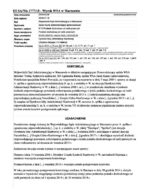
Poland vs “Shopping Centre Developer sp.k.”, May 2019, Administrative Court, Case No III SA/Wa 1777/18
A Polish company, “Shopping Centre Lender sp.k.”, had been granted three intra group loans in FY 2013 for EUR 2 million, EUR 115 million and EUR 43.5 million. The interest rate on the loans had been set at 9%. The tax authorities found that the 9% interest rate was higher than the arm’s length rate and carried out its own analysis on the basis of the comparative data from 66 transactions. In addition, data posted on the internet on the website of the National Bank of Poland was consulted. The summary showed that in the aforementioned period, the average interest rates applied by Polish financial institutions for loans granted to enterprises in EUR ranged from 2.4% to 3.6%. Furthermore, by letters in April 2017 the tax authorities requested information from domestic financial institutions regarding the interest rates and commission rates for loans granted to commercial companies in the period from June 2013 to September 2014. The information received showed that the interest rates applied by the banks were set as the sum of: the EURIBOR base rate (usually three months) and the bank’s margin. Between June 2013 and September 2014, interest rates varied and ranged from 0.515% to 6.50%. On the basis of the information received an assessment was issued where the interest rate on the three inter group loans had been lowered from 9% to 3.667% resulting in lower interest expenses and thus additional taxable income. Shopping Centre Lender sp.k. filed an appeal with the Administrative Court claiming that the procedure for estimating income – determining the arm’s length interest rate – had not been followed correctly by the tax authority. Judgment of the Administrative Court The Administrative Court issued a judgment in favour of Shopping Centre Lender sp.k. The Court found that the tax authorities procedure for estimating income had been in breach of the provisions of the Act and the Ordinance on transfer pricing adjustments. Click here for English Translation Click here for other translation
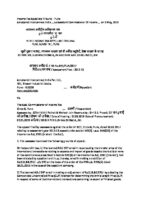
India vs Amphenol Interconnect India Pvt. Ltd., May 2019, Income Tax Appellate Tribunal, Case No ITA No.641/PUN/2017
According to Amphenol Interconnect the TNMM was the most appropriate method for determining the arm’s length price in respect of exports and import of goods from the related parties. And since the net profit margin of Amphenol was comparable to the net profit margin of the comparable companies, the transactions were at arm’s length. The tax authorities disagreed and issued an assessment for FY 2012-2013 where the controlled transactions had instead been priced using the CUP method. Judgment of the Tribunal The Tribunal decided in favor of Amphenol. Excerpt “The Hon’ble High Court after analyzing the issues at length has held that CUP method would not be the most appropriate method in view of various adjustments, which would have to be made due to differences in FAR, in order to arrive at the arm’s length price of finished goods. The Hon’ble High Court notes that the Tribunal had taken into account the fact that for overwhelming majority of exports to associated enterprises, the TPO has accepted the TNMM method for arriving at the arm’s length price and hence, there was no reason why for balance of export of finished goods, TNMM method should not be applied. Similar direction was also given in respect of imports of finished goods, which were sold to third parties and the associated enterprises and by applying FAR analysis, it was held that where the finished goods were customized goods and the geographical differences, volume differences, timing differences, risk differences and functional differences were there, then CUP method would not be the most appropriate method to determine arm’s length price. The TNMM method was held to be most appropriate method. Further, the Hon’ble High Court has applied similar reasoning while deciding appeal of assessee relating to assessment year 2005-06 in ITA No.1388/2015, vide judgment dated 18.04.2018 and the appeal of Revenue has been dismissed. In the totality of the above said facts and circumstances, where the issue stands covered by the order of jurisdictional High Court in the case of assessee itself, there is no merit in the orders of authorities below in making aforesaid transfer pricing adjustment in the hands of assessee both with respect to exports to associated enterprises and with respect to imports from associated enterprises. It may be pointed out that majority of transactions have been accepted to be at arm’s length price by the TPO by applying TNMM method, only in respect of few transactions, the TPO had applied CUP method. There is no merit in the order of TPO in this regard and reversing the final order passed by Assessing Officer, we allow the claim of assessee and direct the Assessing Officer to delete the transfer pricing adjustment made in the hands of assessee. The grounds of appeal No.2 and 3 are thus, allowed. The grounds of appeal No.4 to 6 are academic as pointed out by the learned Authorized Representative for the assessee and the same are dismissed.”
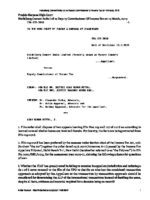
India vs Heidelberg Cement India Ltd, March 2019, High Court, Case No ITA-125-2018
Heidelberg Cement India Ltd is engaged in the business of manufacturing of cement and sells them to its customers in India. A TNM method where all the transactions was combined had been used by the company for determining the arm’s length price of its controlled transactions as they were considered closely linked. Following an audit for FY 2010 2011, the Indian tax authorities issued an assessment of additional taxable income where the pricing of the transactions had instead been determined on a transaction by transaction basis. According to the tax authorities, technical know-how fees paid to the parent company were excessive. At issue before the High Court was whether the combined transaction approach as applied by the company or the transaction by transaction approach as applied by the tax authorities was the most appropriate method for determining the arm’s length pricing of the international transactions. Judgment of the High Court The court decided predominantly in favour of the tax authorities. Excerpt: “Under Section 92(1) of the Act, any income arising from ‘an international transaction’ was required to be computed having regard to arm’s length price. More than one transaction can be taken together for determination of arm’s length price only if they were closely linked. Aggregation of transaction or combined transaction approach is accepted practice for determination of arm’s length price, however, such aggregation of transaction can be allowed if they were linked with each other. As per the transfer pricing study report, the only statement made by the assessee is that the assessee is engaged in the business of manufacturing the cement which is its primary business activity and therefore, all the transactions relating to cement manufacturing activity should be bundled together for determination of their ALP applying TNMM as the most appropriate method. The services rendered by the AE are specifically mentioned in the agreement. Therefore, there is no reason that such services cannot be evaluated independently on standalone basis.” “The Tribunal also observed that it was the duty of the assessee to show with cogent evidence and factual analysis backed by economic reasoning and business that all the international transactions were originating from one source or they were independent or were part of package deal. Further, the TPO had not recorded any finding while 5 of 6 rejecting the claim of aggregating the transaction of the assessee. Accordingly, the Tribunal had rightly remanded the matter to the file of the TPO with a direction to the assessee to justify how international transactions were closely linked.” Click here for translation
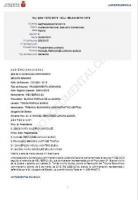
Spain vs Ikea, March 2019, Audiencia Nacional, Case No SAN 1072/2019
The tax administration had issued an adjustment to the taxable profit of IKEA’s subsidiary in Spain considering that taxable profit in years 2007, 2008, and 2009 had not been determined in accordance with the arm’s length principle. In 2007 taxable profits had been below the interquartile range and in 2008 and 2009 taxable profits had been within the interquartile range but below the median. In all years taxable profits had been adjusted to the median in the benchmark study. Judgment of the Court In regards to the adjustment mechanism – benchmark study, interquartile range, median – the Court provide the following reasoning “However, the OECD Guidelines in point 3.60 provide that “if the relevant terms of the controlled transaction (e.g. price or margin) are within the arm’s length range, no adjustment is necessary”. Conversely, under rule 3.61, if the relevant terms of the controlled transaction “(e.g., price or margin) are outside the arm’s length range determined by the tax administration, the taxpayer should be given the opportunity to argue how the terms of the controlled transaction satisfy the arm’s length principle, and whether the result falls within the arm’s length range (i.e., that the arm’s length range is different from the arm’s length range determined by the tax administration). If the taxpayer is unable to demonstrate these facts, the tax administration must determine the point within the arm’s length range to which to adjust the condition of the controlled transaction”. And, finally, rule 3.62 provides: “In determining this point, where the range comprises highly reliable and relatively equal results, it may be argued that any one of them satisfies the arm’s length principle. Where some defects in comparability persist, as discussed in paragraph 3.57, it may be appropriate to use measures of central tendency to determine this point (e.g. median, mean or weighted mean, depending on the specific characteristics of the data) in order to minimise the risk of error caused by defects in comparability that persist but are not known or cannot be quantified”. In the Board’s view, the appellant should be upheld on this point. Indeed, as we have indicated, the Inspectorate was consistent, it gave the same treatment to the 2007 and 2008 financial years, as it understood that it should apply the median of 4.1%, in accordance with point 3.62 of the Guideline, it was appropriate to use measures of central tendency such as the median, specifically because it considered that “the study has comparability defects given that the companies included in the samples have lower sales volumes” – p. 38 of the Ruling. 38 of the Resolution. Logically, the circumstances justifying the use of the median were valid for both 2007 and 2008, as the reasons were the same. However, the TEAC, starting from the fact that the Inspectorate assumes the opinion of PwC, affirms that the data obtained will never be perfectly reliable, not being congruent “that the sample is used as an analysis of comparability as well as to extract data on which the regularisation itself is based, to then be rejected for the effect that could be favourable to the interested party, such as for the application of rule 3.60 of the aforementioned Guidelines, which excludes adjustments when they are within the range”. Therefore, it annulled the Agreement on this point, as the entity was within the range, remember that the interquartile range was between 2.1% and 7.6% and in 2008 it was at 2.42%. In other words, for the TEAC it was not possible to apply the rule of art. 3.62 on which the Tax Inspectorate based itself, because in 2008, the company was within the margins required by art. 3.60, which was not the case in 2007. However, in our opinion it is clear that if the ROS is outside the limits of the inter-quantile range, the corresponding adjustment must be made, as only from 2.1 % onwards is the company within the comparable market margins. However, in order to apply the median, there must also be “comparability defects”, and if these did not exist for 2008, for the same reason they did not exist for 2007 either. It should be noted that, in response to the arguments of the Inspectorate which argued that there were defects of comparability, the TEAC states that “a difference in the volume of sales is not sufficient reason to reject the validity of the report… The fact that the entity being verified occupies a leading position within its sector due to its sales volume does not in itself cause a lack of comparability – p. 40 TEAC Resolution-. In short, it seems to us that, once it has been determined that the appellant’s ROS in the year under discussion is outside the lowest inter-quantile range – 2.1% – it is indeed appropriate to make the corresponding adjustment. However, the fact that that is the case does not, without more, allow the median to be applied in the terms provided for in Rule 3.62, since the application of that rule is not justified by the fact of being outside the range of full competence, but by the existence of ‘comparability defects’, which, according to the arguments of the TEAC itself, were not the case in 2008 and, by extension, would not be the case in relation to 2007 either. The plea is upheld, since the Board agrees, with the applicant, that the adjustment should have been made on 2.1% and not 4.1%. It is not necessary, therefore, to analyse whether the median of the interquantile range should have been used instead of the median of the sample.” Click here for English translation Click here for other translation
Switzerland vs “A.”, March 2019, Court of Justice, Case No ATA/222/2019
CCompany A was active in the management and administration of trusts and companies; related advice and services. A held 99% of the shares in E, a Seychelles-based company. This subsidiary acted as a sub-contractor for company registrations and corporate affairs in the Seychelles. A and E had entered into a service contract dated 6 February 2009 under which the subsidiary provided these services to A. Following an audit, tax assessments were issued for the tax years 2009 – 2012, in which the tax authorities (AFC-GE) had attributed a percentage of 5% of E’s expenses as the maximum allowable remuneration for the activities of the subsidiary. The remainder was added back to A’s taxable income. An administrative appeal was lodged against these tax assessments, but the appeal was later dismissed in 2016. A then appealed to the Administrative Court (TPAI), which, by judgment of 18 December 2017, upheld A’s appeal and annulled the assessments and fines. The tax authorities appealed to the Court of Justice. Judgment of the Court The Court of Justice overturned the decision of the Administrative Court and ruled in favour of the tax authorities. Excerpt “6. a. Implementation of the arm’s length principle presupposes identification of the market value of the asset transferred or the service rendered. Where there is an open market, the prices on that market are decisive and allow for an effective comparison with the prices applied between associated companies (ATF 140 II 88 recital 4.2 and the references cited therein). b. If there is no free market allowing an effective comparison, then the method of comparison with a comparable transaction (or comparable price method) should be used, which consists of making a comparison with the price applied between third parties in a transaction with the same characteristics, i.e. taking into account all the decisive circumstances (BGE 140 II 88 recital 4.2; 138 II 57 recital 2.2; Federal Court ruling 2C_674/2015 of 26 October 2017 recital 7.2). This method corresponds to the comparable open market price method presented in the OECD principles (n. 2.13 et seq.). For this method to be applicable, the transaction with a third party or between third parties must be similar to the transaction under review, i.e. it must have been entered into in circumstances comparable to those of the transaction under review. However, the notion of “comparable transaction” is not easy to define. The relevance of the comparison with transactions concluded with third parties presupposes that the determining economic circumstances of these transactions are similar to those of the transaction under review (OECD principles, n. 1.33 et seq.). The comparability of transactions is determined according to their nature and in the light of all the circumstances of the particular case. If the relevant economic conditions differ from those of the transaction under review, adjustments must be made to eliminate the effects of these differences (OECD principles, 1.33 et seq.). However, it cannot be entirely ruled out that a comparable transaction would not have been concluded at the market price, since the formation of the price may be influenced by several factors, such as market conditions, contractual terms (for example, the existence of secondary services, the quantity of goods sold, payment terms), the commercial strategy pursued by the third-party purchaser or the economic functions of the parties. Nevertheless, the price charged in a comparable transaction is presumed to correspond to the market price; in the event of a dispute, the burden of proof to the contrary lies with the company (Federal Court ruling 2C_1082/2013 of 14 January 2015, para. 5.2 and the references cited). c. In the absence of a comparable transaction, the arm’s length price is determined using other methods, such as the cost plus method. This method consists in determining the costs incurred by the company providing the service, to which an appropriate margin is added in order to obtain an appropriate profit taking into account the functions performed and the market conditions (ATF 140 II 88 rec. 4.2 p. 94; judgment of the Federal Court 2C_11/2018 of 10 December 2018 recital 7.4). d. A concealed distribution of profits also presupposes that the unusual nature of the benefit was recognisable by the company’s governing bodies. This condition is presumed to have been met if the disproportion was clearly recognisable. In this respect, reference should be made to the case law and doctrine developed in private law concerning the imputation of knowledge of the corporate bodies to the legal person, which holds that this imputation does not apply in an absolute manner, but that it must only come into play for what is known to the body that is at least seized of the matter, or else when the information acquired by one body has not been passed on to another body, due to a defect in the organisation of the company (Federal Court ruling 2C_1082/2013 cited above, rec. 6.1 and references cited). 7. It is up to the taxing authority to establish the facts on which the tax claim is based or which increase it, whereas the taxpayer must allege and prove the facts which eliminate or reduce this claim, these rules also applying to proceedings before the appeal authorities (ATF 140 II 248 recital 3.5). In tax reminder and fine proceedings, the tax authority must prove that the assessment is incomplete (Federal Court ruling 2C_342/2017 of 12 April 2018, recital 4.1). In the area of services that can be valued in money, the tax authorities must prove that the company has provided a service and that it has not received any consideration or has received insufficient consideration. If the evidence gathered by the tax authorities provides sufficient indications of the existence of such a disproportion, it is then up to the taxpayer to establish the accuracy of his allegations to the contrary (ATF 138 II 57 rec. 7.1 p. 66; Federal Court ruling 2C_814/2017 cited above, para. 8.1.3). Moreover, once a fact is considered to be established, the question of the burden of proof no longer arises
Italy vs BI S.r.l, November 2018, Tax Tribunal of Milano, Case no. 5445/3/2018
The Italian tax authorities had issued an assessment against a local distribution company of a multinational group, where the transfer pricing analysis conducted by the taxpayer had been disregarded. The tax authorities, carried out a new benchmark analysis based on the transactional net margin method (“TNMM”) and adjusted the company’s profitability to the median. Judgment of the Court The Court decided in favour of BI S.r.l. and cancelled the assessment. The Court stated that the profitability range calculated by the tax authorities goes, for the year 2013, from a minimum value of 1.40% to a maximum of 18.28%. The local distribution company had obtained a ROS/EBIT margin of 8.38%, and since the last percentage falls between the minimum and the maximum, the court set aside the assessment. In regards to the TP analysis performed by the tax authorities the Court stated: “The company had applied the CUP method, as it was considered the most direct and reliable method to apply the principle of free competition and, therefore, according to today’s appellant, this method had to be preferred to the application of any other method. The Office, on the other hand, considered the TNMM method more correct, thus arriving at ROS (return on sales) values that were totally different from those applied by the company for the three-year period 2010, 2011 and 2012. The office, by changing method, without any specific reason had settled on the percentage of the median. The office had taken refuge behind that percentage, without justifying in the notices of assessment why “The appellant’s objections on the issue of comparables are upheld, as the present company exercised, for the years in dispute, sales and routine functions, while the key role within the group was played by the company B.R.; the latter, as the “real entrepreneur” who was responsible for the fundamental decision-making fruitions, the definition of the various business strategies and, no less, the fruitions in the development and production area.” “B.I. was the sole distributor in Italy of a single supplier, to which it was linked by a shareholding relationship. The comparables compared by the Office did not adequately match the model of the company under examination, as the companies compared carried out production activities, operated in different sectors and distributed different products. This being the case, the office had identified competitors that were not comparable in terms of product sector, market and risk level. These obvious differences in distribution channels, type of goods or products sold or totally different local realities make the analysis carried out by the office unacceptable as a whole.” Click here for English translation Click here for other translation
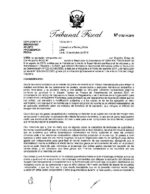
Peru vs “Soft Drink Distributor”, October 2018, Tax Court, Case No 07821-9-2018
“Soft Drink Distributor” imported concentrates and syrups for a total amount of S/ 8,117,356.00 from related companies, which were then sold exclusively to Ambev, the company responsible for the production, distribution and marketing of soft drinks in the local market. “Soft Drink Distributor” also imported finished products for a total amount of S/ 291,616.00 from its related companies, which were sold to local companies in charge of the distribution and marketing of soft drinks on the local market. The controlled transactions were priced using the resale price method. Following an audit, the tax authorities concluded that the resale price method used by the Soft Drink Distributor did not take into account the extensive marketing and advertising activities. To remedy this, the tax authorities applied the TNMM instead and concluded that the prices paid by Soft Drink Distributor to its related parties had been higher that the arm’s length price. A tax assessment was therefore issued, which adjusted the taxable profits upwards. Soft Drink Distributor was not satisfied with the assessment and appealed. Decision of the Tax Court. The Tax Court dismissed Soft Drink Distributor’s appeal. The court concluded that the resale price method was not suitable in the particular circumstances of this case and that the transactional net margin method was the more appropriate method. Click here for English Translation
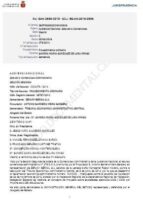
Spain vs. Zeraim Iberica SA, June 2018, Audiencia Nacional, Case No. ES:AN:2018:2856
ZERAIM IBERICA SA, a Spanish subsidiary in the Swiss Syngenta Group (that produces seeds and agrochemicals), had first been issued a tax assessment relating to fiscal years 2006 and 2007 and later another assessment for FY 2008 and 2009 related to the arm’s length price of seeds acquired from Zeraim Gedera (Israel) and thus the profitability of the distribution activities in Spain. The company held that new evidence – an advance pricing agreement (APA) between France and Switzerland – demonstrated that the comparability analysis carried out by the Spanish tax authorities suffered from significant deficiencies and resulted in at totally irrational result, intending to allocate a net operating result or net margin of 32.79% in fiscal year 2008 and 30.81% in 2009 to ZERAIM IBERICA SA when the profitability of distribution companies in the sector had average net margins of 1.59%. The tax authorities on there side argued that the best method for pricing the transactions was the Resale Price Method and further argued that the companies in the benchmark study provided by the taxpayer were not comparable. The authorities also pointed to the fact that ZERAIM IBERICA SA prior to entering the distribution agreement had a gross margin of around 40%, and now after entering the agreement would have a net margin of only 1.5%. The Court held in favor of the tax authorities due to (1) lack of explanation to the shift in profitability of ZERAIM IBERICA SA before and after entering the distribution agreement and (2) lack in comparability between the companies selected for the benchmark study and the Spanish distributor and (3) the transactional net margin method presented by the taxpayer in accordance with Spanish regulations is subordinated to the direct methods (resale price minus etc.). Click here for English translation Click here for other translation
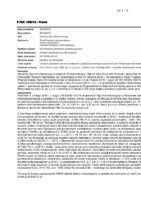
Poland vs “Blueberry Factory” Sp z.o.o., June 2018, Supreme Administrative Court, II FSK 1665/16
In this case there were family, capital and personal ties between the Blueberry Factory and its shareholders, and the terms and conditions of the Company’s transactions with its shareholders (purchase of blueberry fruit) had not been at arm’s length. The higher prices paid by the Blueberry Farm benefited the shareholders (suppliers), who thus generated higher income from their agricultural activities, not subject to income tax. The company generated only losses in the years 2011 – 2013. According to the Polish tax authorities, the Blueberry Farm purchased blueberry fruit at excessive prices and thus overstated its tax-deductible expenses by PLN 347,845.48. The excessive prices (relative to market prices) increased the income of its shareholders (agricultural producers), whose income was not subject to personal income tax as being derived from agricultural activities. The tax authorities applied the provisions of Art. 11.1, Par. 2.2 of the Corporate Income Tax Act of February 15th 1992, as the gross margin earned by the Blueberry Factory on sales of blueberries (2.56%) did not cover the costs of consumption of materials and energy, third party services, depreciation and other costs, which resulted in a loss for 2012. (PLN 218,838.03), and losses for 2011 and 2013. The application of excessive fruit purchase prices from the Company’s shareholders (4 persons running fruit farms and 1 farm owner), with family, personal and capital ties, also resulted in the Blueberry Factory taking out 6 loans from it’s shareholders for the total amount of PLN 877,697.70. in 2012. The average gross margin of the Blueberry Factory when selling goods (blueberries) in 2012 was 2.2%. Meanwhile, unrelated entities, selected in the course of the proceedings, which were involved in the purchase and sale of blueberries, having the relevant certificates necessary to sell fruit abroad, had gross margins ranging from 3.5% to 21.87%. The tax authorities held that the average gross margin in comparable transactions was 11.35% and PLN 2.27 per kilogram. The tax authorities determined the Blueberry Factory’s corporate income tax liability for 2012 at PLN 22,114, instead of the declared loss (PLN 218,838.03). The Court of first instance agreed with the tax authorities that there were capital, personal and family ties between these entities. In the opinion of the court, all the conditions referred to in Art. 11.1 of the Polish Act on Public Offering, which authorises the determination of the income and tax payable by way of estimation, had been fulfilled. The Court also considered the pricing method used by the authorities – resale prices – to be appropriate. The comparability analysis took into account both the type and quality of fruit traded (the fact of holding certificates). The average margin applied by independent entities was calculated. In estimating the cost of blueberry fruit purchased by the Company, favourable assumptions were made, as the basis for the estimation was the margins applied by entities (fruit producer groups) which purchased blueberry fruit, holding only the G-certificate and applying the lowest margins among the surveyed entities. The comparability analysis also took into account, among others, such factors as the certificates held, type of recipients of the goods (domestic and foreign), type of entity, production process, technologies used, type and time of transactions. The Court also deemed it appropriate that DUKS issued a provision under Art. 179.1 of the Polish Corporate Governance Act, which excluded information on entities conducting business competitive to the Company. The Blueberry Factory filed a complaint against the decision. The Supreme Administrative Court considered that the appeal was justified and therefore had to be granted. The gist of the dispute in the case at hand is to assess whether, in fact, the procedure for estimating income [Article 11 of the Act] was carried out correctly, as claimed by the authority and accepted by the Court of First Instance, or, as the applicant argues in cassation – with a breach of the provisions of the Act and the Regulation – which is linked to the authority’s analysis of the comparability of transactions. “All this allows us to conclude that, although the OECD Transfer Pricing Guidelines do not contain standards of generally applicable law (Article 87(1) of the Polish Constitution), when interpreting the provisions governing the prerequisites for the use of transfer pricing and the general conditions for determining income by means of estimation (Article 11(1) to (3) of the Act), the indications of those guidelines should be taken into account as a kind of “set of good practices” and a point of reference for choosing the right interpretative direction.” “In the light of the above, contrary to what the WSA suggested, the aforementioned guidelines will be relevant to the assessment of the assessment method used by the authority and, in particular, of its implementation.” The Court of first instance did not sufficiently consider the proceedings conducted by the authorities – in particular with regard to the comparability analysis. It was principally assumed that the Company’s business model was the basis for its market strategy – which in its opinion was to generate losses in order to maximise profits of its shareholders. At the same time, despite arguments consistently raised by a party in the course of proceedings, the court did not address issues regarding comparability factors. First of all, the key issue in this case, namely that the party has the status of an agricultural producer group. This, in turn, raises other relevant issues: – the specific nature of the entity, the principles and essence of the group’s operation, the scope of the objectives it should pursue, the strategy of producer groups – the use of aid measures, the issue and importance of the Recognition Plan, the issue of the group’s market strategy during the recognition period. The Supreme Administrative Court referred the case back to the Court of first instance for reconsideration. Poland II FSK 1665-16 en

Colombia vs Vidrio Andino S.A., June 2018, Counsil of State, Case No. 25000 23 27 000 2011 00265-01 (20821)
Following an audit, the Colombian tax authorities issued a notice of additional taxable income for FY 2006. The notice was based on an assessment in which they concluded that Vidrio Andino S.A.’s profit margin was below the interquartile range established in the benchmark study, and the result was therefore adjusted to the median. An appeal was filed with the Administrative Court, which later ruled in favour of the tax authorities. An appeal was then filed with the Council of State. According to Vidrio Andino S.A., the results were within the range when a comparability adjustment was made to the results for extraordinary administrative expenses. Judgment of the Court The Council of State overturned the decision of the Administrative Court and ruled in favour of Vidrio Andino S.A. Excerpt in English “The Chamber then departs from the Tribunal’s conclusion, as it considers that the applicant demonstrated the existence of a higher value of administrative expenses assumed by Vidrio Andino due to an exceptional economic circumstance, which should be eliminated from a comparison with independent third parties in order to reasonably estimate its profit margins. While it is true that other companies also saw an increase in their expenses, albeit in smaller percentages, that variation was reflected in their operating income, so it is reasonable to estimate that Vidrio Andino’s higher expenses did not have a similar result, as they were related to a construction project, which is a particular economic circumstance of the plaintiff. That particular economic circumstance does not necessarily correspond to an unforeseeable or irresistible event, but to a situation specific to the controlled entity, which distorts the comparative examination of its transactions with comparable third parties, in so far as it hinders the objectivity of the comparison. Although an extraordinary expense that responds to an unforeseeable event may give rise to a comparability adjustment, such a qualification does not appear as a necessary condition to justify making an adjustment, with a view to obtaining better comparability conditions between the transactions evaluated by means of transfer prices, especially when no correction was required by the DIAN to maintain consistency. Regarding the opportunity to make the adjustments, the Chamber considers that, even though the appropriate adjustments were not reflected in the information return, it is not possible to ignore the analysis contained in the transfer pricing study, i.e. in the supporting documentation, when comparing the economic reality of the company with the information contained in the income tax return for the corresponding taxable year. Indeed, although it is expected that the information return fully reflects the economic situation of the taxpayer compared to its comparables, including the appropriate adjustments, as they are necessary to determine the real profit margin, in this case, in the absence of correspondence, it is fully viable to resort to the supporting documentation, additional studies or the application of other methods, in order to verify whether the adjustment in the tax return is appropriate to reflect the economic reality of the company. This does not prevent the tax administration from deploying its auditing capacity in relation to the information return: If the DIAN considers that the economic reality of the plaintiff’s operation corresponded to what was indicated in the information return, and not in the supporting documentation, it should disprove the information contained in the supporting documentation, or prove the reasons that show the plaintiff’s violation of the arm’s length principle.” Click here for English translation Click here for other translation
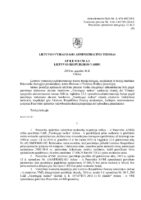
Lithuania vs „Vaistingoji melisa“, May 2018, Supreme Administrative Court, Case No A-676-602/2018
The tax authority had reduced Vaistingoji melisa’s deductions for rental payments to its shareholder, which, in its view, exceeded the rental payment at arm’s length. Vaistingoji melisa filed a complaint with the Tax Disputes Commission which in 2016 dismissed the complaint and upheld the decision of the tax authority. An appeal was then filed with the court, which upheld the decision of the Tax Disputes Commission. Finally, an appeal was filed with the Supreme Administrative Court. Judgment of the Court. The Supreme Administrative Court overturned the decision of the first instance court and remitted the assessment for reconsideration. According to the Court, the tax authority had failed to determine the arm’s length price of the property and to provide sufficient justification for its assessment. Excerpt in English “56. As already mentioned above, the applicant rented premises from associated persons for the operation of pharmacies. Paragraph 11.2 of the Requirements for pharmacy premises and equipment approved by Order No V-7 of the Minister of Health of the Republic of Lithuania of 7 January 2003 (wording in force from 1 January 2012 to 1 May 2014) stipulates that a pharmacy outbuilding must be located only on the ground floor of a building, except for pharmacies established in health care institutions. The market surveys of UAB Ober-haus show, inter alia, a range of rental prices for commercial premises in Panevėžys in the centre (ground floor), the centre (other floors) and other districts. Therefore, the tax administration should have based its calculations on the rental prices of the commercial premises in the centre (ground floor), which are higher than the rental prices of other premises. However, as can be seen from page 6 of the inspection report, this was not done, resulting in incorrect calculations. It should be noted that the Court agrees with the reasoning of the Commission and the Court of First Instance that the applicant has not identified any other factors (other than the one discussed above) relating to the requirements for the pharmacy premises and their fitting-out which may have an impact on the rental price. 57. In the light of the foregoing, the Chamber of Judges annuls the decisions of the Court of First Instance, the Commission and the Inland Revenue and refers the tax dispute to the defendant for a fresh examination of the decision of the Panevėžys Inland Revenue Authority. When re-examining the tax dispute, the tax administrator should also assess the information certificates No 16-NK09-29 and No 16-NK09-30 of 4 October 2016 on the lease price of the property, in a concise form, submitted by the applicant to the court of first instance by UAB Capital vertinimas (vol. I., item 134159). 58. The tax authorities wrongly emphasise the burden of proof on the applicant alone to prove that the pricing of transactions with associated persons complies with the arm’s length principle. There is no doubt that a taxpayer, in fulfilling its obligations to declare and pay tax under the law, must have evidence to prove that it has properly discharged that obligation. However, there is also no doubt that the tax administration, when establishing that the taxpayer has not properly fulfilled its obligations to declare and pay the tax in accordance with the law and when establishing the tax arrears by an administrative decision, must duly substantiate its decision with evidence (Article 67 of the ITA). It follows from these general obligations of the taxpayer and the tax administration that in the present case the tax administration was obliged to duly substantiate its decision, although, as stated by the tax administration, the burden of proof under the Rules rests solely on the taxpayer. 59. The Rules establish the taxpayer’s obligation to have documentation of a controlled transaction (documentation showing whether the taxpayer has followed the arm’s length principle in determining the prices of transactions with associated persons) and to submit it to the tax administration. If the tax authority determines that the pricing of transactions between associated persons does not comply with the arm’s length principle, the prices shall be adjusted, the company’s taxable income shall be recalculated, and additional taxes shall be charged. In checking and assessing whether the pricing of transactions between selected companies and associated persons complies with the arm’s length principle, the tax administration must follow the same legislation and guidance on pricing of transactions between associated persons. Therefore, in the present case, the taxpayer’s burden of proof arising from the Rules should not be the sole focus of the present case, since the tax authorities must also follow these rules when taking a decision on the basis of Article 40 of the Corporate Income Tax Law, i.e. when making an adjustment of the value of transactions or economic transactions and a recharacterisation of the income or payments. In the latter case, the tax administration is obliged to carry out the evidentiary process in accordance with all the requirements of the Rules and other legal acts when taking a decision.” Click here for English Translation Click here for other translation
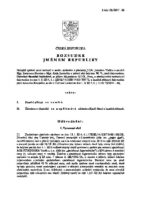
Czech Republic vs. M.V., April 2018, Supreme Administrative Court , Case No 3 Afs 105/2017 – 22
The reason for the adjustment of the tax base was, among other things, the finding that M.V.sold on 4 January 2010 all the stock of goods of the range of garden supplies to AGROTECHNIKA Vaněk s.r.o. (“Agrotechnika”) at an 80% discount on the sales price (i.e. purchase price + margin). M.V. and Agrotechnika were related persons within the meaning of Article 23(7) of Act No 586/1992 Coll., on Income Taxes, as M.V. is the managing director and sole shareholder of Agrotechnika. The sale price after the discount corresponded to approximately 40 % of the purchase price, which, according to the tax administrator, did not correspond to the price that would have been agreed between independent persons in normal commercial relations under the same or similar conditions. The prices established with comparable operators showed that the normal price corresponded to the purchase price of the goods. M.V. did not provide satisfactory evidence of the difference of CZK 1 557 720. The Regional court dismissed M.V.’s appeal by the decision set out in the body of the judgment. It did not accept the plea that the difference found was not supported by the evidence in the administrative file. The tax administration determined the normal price on the basis of a comparison with two comparable entities, for which it drew data from its own database and from the files of those tax entities. In the first case, the taxpayer was a natural person who had sold to a related person in the tax years 2009 and 2010 a stock of goods (garden equipment and garden supplies in 2009 and army clothing in 2010) at the purchase price in each case. In the second case, two natural persons operating in an association of natural persons without legal personality set up a legal person into which they contributed in the tax year 2005 stocks of goods (household goods, hardware) which they owned jointly, and these stocks were valued on the basis of an expert’s report at an amount corresponding to the cost and book value of the stocks of goods + a 30% margin. With regard, inter alia, to the taxable period, the tax authorities narrowed the collection to the former entity and set the normal price of the stocks sold at the purchase price of the goods. Although the tax administrator did not have a 100% identical comparable entity, the selected entity met the comparability criterion because it was doing business in the same region as the plaintiff, sold goods to a related person in the same taxable year, traded goods of a similar nature, and sold a complex group of goods identical to the plaintiff at the purchase price of the goods. Therefore, the defendant did not accept the objection that the tax authorities had violated Section 23(7) of the Income Tax Act by increasing the applicant’s tax base without meeting their burden of proof. On the contrary, the burden of proof was on the applicant, who did not, however, satisfactorily prove the difference between the agreed price and the normal price. Judgment of the Court The Supreme Administrative Court thus concludes that the contested order of the Regional Court is lawful. It therefore dismisses the appeal as unfounded Excerpts “The basic condition for establishing the reference price is an independent relationship between the entities that negotiated it. This condition follows directly from the wording of Section 23(7) of the Income Tax Act, which expressly and unambiguously refers to a price agreed between “independent” (or unrelated) persons in normal business relations (see above). This price is determined on the basis of the arm’s length principle, which is based on the conditions that would apply between independent entities in comparable transactions and circumstances, i.e. in so-called ‘comparable independent transactions’. The purpose of this provision is to view the legal transactions in such a way that the result is the same situation from a tax point of view as in the case where the legal transaction occurs between entities that are not connected persons (see the judgment of the Supreme Administrative Court of 18 March 2015, No. 6 Afs 176/2014 24). [19] The reference price is therefore essentially a simulation of a price created on the basis of a consideration of what price those persons would have negotiated in a situation identical to that of related persons if they were not related and if they had normal business relations with each other. The reference price may be determined by the tax authorities by comparing the prices actually achieved for an identical or similar commodity between actually existing independent operators or (in particular because of the absence or unavailability of data on such prices) only as a hypothetical estimate based on logical and rational reasoning and economic experience. In the event that it is not possible to establish the reference price in this way either, the price established in accordance with a special legal regulation, namely Act No 151/1997 Coll., on the valuation of property, shall be used in accordance with Article 23(7) of the Income Tax Act (see, for example, Supreme Administrative Court Judgment No 7 Afs 74/2010-81). [20] Therefore, the mutual independence of the entities that have entered into a comparable transaction is a necessary requirement for establishing a reference price. However, the tax administrator did not comply with this condition, since it chose transactions between related entities as comparable transactions against which to measure the transfer price agreed between the applicant and Agrotechnika. Although the complainant claims in its appeal that it established a price range for two comparable independent persons, it also admits that they were natural persons who, in connection with a change in the legal form of their business, sold all their stock of goods to a newly established legal person in which those natural persons were also partners and managing directors. It is therefore clear that the transfer of stocks took place in both cases between related persons – the natural person and the legal person who was linked
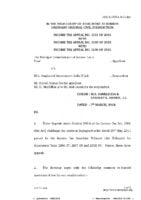
India vs Amphenol Interconnect India (Private) Ltd., March 2018, Bombay High Court, case no. 536
In the case of Amphenol Interconnect the issue was whether two transactions – the resale of goods and sales assistance services for a commission – could be aggregated for transfer pricing purposes and whether the CUP or the TNMM was the most appropriate transfer pricing method. The court found that that the CUP Method could not be used for the buy/sell transaction because of differences in location, volumes and customisation. The transactions could be aggregated and benchmarked together using the TNM Method.
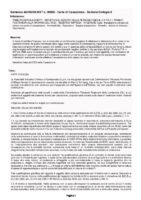
Italy vs Recordati Industria Chimica e Farmaceutica S.p.A, September 2017, Supreme Court, Case No 20805
Recordati Industria Chimica e Farmaceutica S.p.A had been issued an assessment by the tax authorities for FY 2003 on various issues related to transfer pricing. Recordati Industria Chimica e Farmaceutica S.p.A. disagreed with the assessment and brought the case to court. The Regional Tax Commission of Lombardy (Ctr) issued a decision where it partially annulled the assessment. This decision was challenged both by the tax authorities and Recordati Industria Chimica e Farmaceutica S.p.A. Judgment of the Supreme Court Before the Supreme Court there were 29 issues to be resolved. The Supreme Court predominantly ruled in favour of the tax authorities. The court confirms that transfer pricing adjustments are applicable even in the absence of proof by the administration of a concrete tax advantage by the taxpayer. The shift of taxable income following transactions between companies belonging to the same group and subject to different national regulations, does not require the administration to prove the elusive function, but only the existence of “transactions” between companies linked at an apparently lower than normal price. The court also states that it cannot be excluded that overall business strategy can induce companies to carry out uneconomic operations in view of and in function of other benefits “(…) the essential aspect of transfer pricing does not concern the justification of the lower price from an economic point of view, but whether the discounts can be considered justified from a fiscal point of view, that is, whether they respond to the principle of free competition, in accordance with the teachings of the Supreme Court.” Click here for English translation Click here for other translation
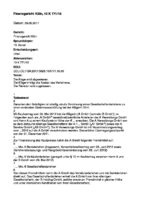
Germany vs “A Investment GmbH”, June 2017, Tax Court , Case no 10 K 771/16
A Investment GmbH, acquired all shares of B in May 2012. To finance the acquisition, A Investment GmbH took up a bank loan with a interest rate of 4.78%, a vendor loan with an interest rate of 10% and a shareholder loan with an interest rate 8% from its parent company, Capital B.V. The 8 % interest rate on the shareholder loan was determined by A Investment GmbH by applying the CUP method based on external comparables. The German tax authority, found that the interest rate of 8 % did not comply with the arm’s length principle. An assessment was issued where the interest rate was set to 5% based on the interest rate on the bank loan (internal CUP). A Investment GmbH filed an appeal to Cologne Fiscal Court. The court ruled that the interest rate of the bank loan, 4.78%, was a reliable CUP for setting the arm’s length interest rate of the controlled loan. The vendor loan was considered irrelevant as the 10 % interests could have been influenced by other factors. With regard to the subordination of claims on the loan from Capital B.V., pursuant to Section 39 (1) (5) of the German Insolvency Act, neither the non-provision of collateral nor the subordination of the loans could justify a risk premium in the determination of the arm’s length interest. Implicit support within the group – at least for the loans from Capital B.V – was considered by the Court in this respect. The appeal of A Investment GmbH was dismissed by the Court. This decision is now appealed by A Investment GmbH to the Supreme Tax Court under file I R 62/17 and is pending. Click here for English translation Click here for other translation
Slovenia vs “Benchmark Corp”, January 2017, Administrative Court, Case No UPRS Sodba I U 632/2016-7
The Court of Justice concluded that the tax authority had acted correctly when, in the course of a tax inspection, it adjusted the tax base on the basis of the transfer pricing documentation submitted by the taxpayer, even though the taxpayer subsequently requested that the entire case be re-examined after it had ascertained the tax consequences of the primary and secondary adjustments. The tax authority was also correct in following the comparability analysis and the taxable person’s proposal and in adopting the contested decision on that basis. “30. In its observations on the record, in the appeal and in the application, the applicant complains that the contested decision is not adequately reasoned and that the Appellate Body also failed to address the appellant’s objections in relation to transfer pricing. The reasons given by the appellate authority are indeed deficient in the light of the appellant’s objections, but, in the Court’s view, do not constitute a substantive breach of the procedural rules. In its grounds of appeal, the appellate authority follows the reasoning of the appellate authority at first instance and thereby (implicitly) rejects as unfounded objections which are of a substantive nature. As regards the objections of a factual nature, the defendant explains that the facts and circumstances relied on in the appeal are not sufficiently proven, and thus states the main reason for their disregard or rejection. In the Court’s view, the decisions of both the appellate and the appellate authorities have all the elements required by law. Pursuant to Article 214 of the Administrative Procedure Act, the statement of reasons for an administrative decision must include a statement of the facts, the findings of fact and the evidence on which they are based, the reasons which were decisive for the assessment of the particular evidence, a reference to the provisions of the regulations on which the decision is based and the reasons which, in the light of the findings of fact, dictate such a decision, as well as the reasons for not upholding a claim. The contested decision is also reviewable. The reasoning of the contested decision gives extensive and clear reasons why the first-instance authority did not take into account the analysis of the so-called non-optimal costs, which the applicant explains are exceptional costs linked to the implementation of the new production programme and that no data on such costs of comparable companies are available. These costs have already been taken into account by the complainant, which follows from the complainant’s reasons why the median is not appropriate for it. The first-instance authority also reasoned its rejection of the functional analysis submitted by the applicant on 19.12.2014 after the applicant withdrew its proposal to adjust the transfer prices. In its reply to the applicant’s comments, the tax authority explained at length, on a function-by-function basis, the reasoned reasons why the new functional analysis was not acceptable. In the Court’s view, the reasoning of the contested decision also shows the reasons for the decision. The Court also agrees with the assessment of the evidence made by the two tax authorities. Both tax authorities have also provided reasoned responses to the applicant’s comments and objections. The applicant’s submissions and explanations were addressed by the first-instance tax authorities both in the minutes of the DIN and in the statement of reasons of the contested decision. As the defendant rightly points out, the DIN case at issue was not about witness statements, as the applicant submits, but about the giving of reasons in the DIN proceedings. However, since the explanations were extensive, the tax authority was justified in requesting written documentation or written explanations, which it then took a decision on. 31. There is also no infringement of substantive law in the present case. The tax authority took its decision on transfer pricing on the basis of the substantive provision of Article 16 ZDDPO-2 and correctly applied that provision. The applicant’s objection that the tax authority did not take into account the OECD Guidelines is unfounded. The OECD Transfer Pricing Guidelines are not binding on international companies and tax administrations. They are a document focusing on the main issues of principle that arise in transfer pricing (paragraph 19 of the Preface to the 2010 Guidelines), and they encourage OECD Member States to follow them in their administrative transfer pricing practices and taxpayers to follow them when assessing for tax purposes whether transfer pricing is consistent with the arm’s length principle (16 ). The Court observes that the OECD Guidelines are not part of the Slovenian legal order and constitute only a legal act of an international organisation of which the Republic of Slovenia is a member. A legal act created by an international organisation can be directly applicable in a Member State only if the Member State has transferred part of its sovereign rights to the organisation, which the Republic of Slovenia has not done by ratifying the OECD Convention. The OECD Guidelines themselves are not directly binding on the State, as is also clear from the OECD’s internal acts (Article 18 of the OECD Rules of Procedure). However, the provisions of the ITA-2 and the TC Rules indisputably follow the provisions of the OECD Guidelines, as the tax authorities have already correctly explained to the claimant (as did the Supreme Court of the Republic of Slovenia in its judgment of 25.8.2016 in Case X Ips 452/2014). In the present case, however, the tax authority based its decision on Article 16 and Article 17 ZDDPO-2, which, in the Court’s view, also constitutes the relevant legal provision for the decision. As regards the disguised payment of profits, in the Court’s view, the first-instance authority also correctly applied the provision of Article 74(7) ZDDPO-2, which it also correctly interpreted. 32. Since the contested decision is correct and lawful and the action is unfounded, and the Court has not found any violations of constitutional rights, nor any violations of the rules of procedure which it is obliged to observe ex officio, it dismissed the
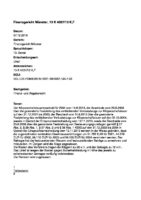
Germany vs “X Sub GmbH”, December 2016, Münster Fiscal Court, Case No 13 K 4037/13 K,F
X Sub GmbH is a German subsidiary of a multinational group. The parent company Y Par B.V. and the financial hub of the group Z Fin B.V. – a sister company to the German subsidiary – are both located in the Netherlands. In its function as a financial hub, Z Fin B.V granted several loans to X Sub GmbH. As part of a tax audit, the German tax authority considered that the interest on the inter-company loans paid by X Sub GmbH to Z Fin B.V. was too high. In order to determine the arm’s length interest rate, X Sub GmbH had applied the CUP method. The tax authority instead applied the cost plus method and issued an assessment. X Sub GmbH filed an appeal to Münster Fiscal Court. The Court found that the cost plus method had been correctly chosen by the tax authority, as the external CUPs could not be used because of differences in conditions between the uncontrolled transactions and the controlled transactions. Hence, the Court dismissed the appeal of X Sub GmbH. The decision has been appealed by X Sub GmbH to the German Federal Fiscal Court, ref. I R 4/17, where it is still pending. Click here for English translation Click here for other translation
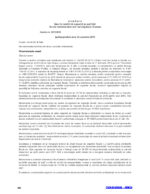
Romania vs SC A SRL, October 2016, Supreme Administrative Court, Case No 2651/2016
At issue were tax deductions for expenses related to assets and expenses for services paid by SC A SRL to a related party, C SpA Italy. Following an audit the tax authorities had issued an assessment, where certain costs were considered non deductible and where the cost of services had been determined by applying the transactional net margin method (TNMM). The assessment was brought to the courts by SC A SRL. Judgment of Supreme Court The Supreme Court found the appeal of SC A SRL unfounded and decided in favor of the tax authorities. Excerpt “As regards the criticisms made by the appellant concerning the use of the net transaction margin method used by the tax authorities and held by the judgment delivered by the court of first instance to be correct, the Supreme Court considers them to be unfounded. As is apparent from the evidence adduced in the case, during the period examined by the tax inspection bodies, it was found that the transactions carried out by the appellant were transactions between related persons and that the price at which goods were transferred in transactions between related persons was the transfer price. Since the appellant submitted an incomplete record of the transfer prices charged in relation to the affiliated person C Spa Italia, in the period 2007-2010, without justifying the transfer prices charged, the tax authorities proceeded in accordance with the provisions of Article 3 of OMFP No 222/2008 to adjust the transfer prices charged between the two companies pursuant to the provisions of Article 11(1) and (2) of Law No 571/2003 on the Fiscal Code, as subsequently amended and supplemented. The trial judge correctly rejected the conclusions contained in the expert’s report with regard to the method of the net transaction margin used by the tax inspection bodies, the court of judicial review, in its analysis of that ground of appeal, points out that the purpose of the forensic technical expert’s report is to provide the court with an expert opinion on the documentation under examination, but the assessment of the evidence is made on the basis of the judge’s reasoning by correlating it with the other evidence adduced in the case and analysing it in the light of the legal rules applicable in the matter. In that context, the High Court finds that the criticisms made by the appellant-appellant in relation to the method of the net trading margin used which led to the adjustment of the income from operations in relation to the affiliated company C Spa Italia in the amount of 35 246 585 lei are in fact unfounded, since the judgment under appeal correctly held that the contested administrative and fiscal acts by which additional tax liabilities were established representing income tax with ancillary charges for the period under review are lawful and well founded. Having regard to all those considerations, the High Court, pursuant to Article 20(1) of Law No 554/2004 and Article 312(1) of the Code of Civil Procedure, will dismiss the appeal brought by the applicant, company A SRL, as unfounded. ” Click here for English translation Click here for other translation
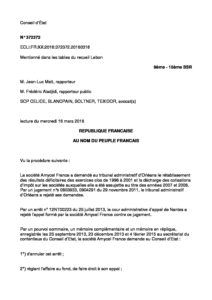
France vs. Sté Amycel France, 16 March 2016, CE, No 372372),
In Sté Amycel France the Court held that the Tax Administration must use an “appropriate” comparable when making transfer pricing adjustments. The French company was selling goods to both group companies and unrelated final customers. The tax administration had used a transaction with the third party customers as an internal comparable. However, as the related companies were acting as distributors, the comparison with the pricing applied to a third party customers was considered inappropriate for the purposes of assessing an arm’s length dealing. The court found that the pricing difference actually reflected the fact that the contractual relationship in the two situations was not comparable. Click here for other translation
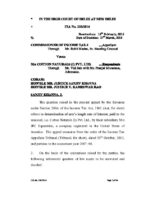
India vs Cotton Naturals (I) Pvt. Ltd., March 2015, High Court of Delhi, ITA No. 233/2014
Loan agreements were entered into between Cotton Naturals (I) Pvt. and a US subsidiary on 13th April, 2002, 7th May, 2003 and then on 8th September, 2003. The rate of interest had been fixed at 4% per annum on the principal sum. The CUP method had been applied to determine the rate. The tax authorities held that the arm’s length interest rate should instead be set at 14% p.a. Following an objection to the assessment, at partial relief was granted in the form of a reduction of the rate to 12,20%. An appeal was filed by Cotton Naturals with the Tax Appellate Tribunal Cotton Naturals (I) Pvt. Ltd. where in February 2013 the assessment was set aside. An appeal was then filed with the High Court by the tax authorities. Decision of the High Court The High Court decided in favor of Cotton Naturals (I) Pvt. Ltd. and set aside the tax assessment. Excerpts “Transfer pricing determination is not primarily undertaken to re-write the character and nature of the transaction, though this is permissible under two exceptions. Chapter X and Transfer Pricing rules do not permit the Revenue authorities to step into the shoes of the assessee and decide whether or not a transaction should have been entered. It is for the assessed to take commercial decisions and decide how to conduct and carry on its business. Actual business transactions that are legitimate cannot be restructured.” “Transfer pricing is a mechanism to undo an attempt to shift profits and correct any under or over payment in a controlled transaction by ascertaining the fair purpose is to ascertain whether the transfer price is the same price which would have been agreed and paid for by unrelated enterprises transacting with each other, if the price is determined by market forces. The first step in this exercise is to ascertain the international transaction, which in the present case is payment of interest on the money lent. The next step is to ascertain the functions performed under the international transaction by the respective AEs. Thereafter, the comparables have to be selected by undertaking a comparability analysis. The comparability analysis should ensure that the functions performed by the comparables match with the functions being performed by the AE to whom payment is made for the services rendered. These aspects have been elucidated in detail in Sony India Ltd. (supra) by referring to the OECD Guidelines as well as United Nations Practical Manual of Transfer Pricing for Developing Countries.” “The finding of the TPO that for this reason the interest rate should be computed at 14% per annum i.e. the average yield on unrated bonds for Financial Years (FY, for short) 2006-07, has to be rejected.” “We have no hesitation in holding that the interest rate should be the market determined interest rate applicable to the currency concerned in which the loan has to be repaid. Interest rates should not be computed on the basis of interest payable on the currency or legal tender of the place or the country of residence of either party. Interest rates applicable to loans and deposits in the national currency of the borrower or the lender would vary and are dependent upon the fiscal policy of the Central bank, mandate of the Government and several other parameters. Interest rates payable on currency specific loans/ deposits are significantly universal and globally applicable. The currency in which the loan is to be re-paid normally determines the rate of return on the money lent, i.e. the rate of interest.” “In the light of the aforesaid discussion, the substantial question of law mentioned above has to be answered against the appellant i.e. the Revenue and in favour of the respondent-assessee. The appeal is accordingly disposed of. There will be no order as to costs.”
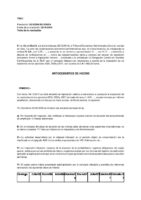
Spain vs “X Beverages S.A.”, October 2013, TEAC, Case No 00/02296/2012/00/00
“X Beverages S.A.” had entered into an agreement with the ABCDE Group for the use of concentrate and trademarks for the production and sale of beverages in Spain, but according to the agreement, “X Beverages S.A.” only paid for the concentrate. Following an audit for the financial years 2005-2007, the tax authorities issued an assessment which considered part of the payment to be royalties on which withholding tax should have been paid. Court’s Judgment The Court agreed that part of the payment could be qualified as royalties, but the assessment made by the tax authorities had been based on secret comparables – leaving the taxpayer defenceless – and on this basis the Court annulled the assessment. Excerpts “The taxpayer itself seems to recognize that the so-called “Contract of …” contains both a distribution contract and a trademark assignment contract when it says on page 127 of its statement of allegations “Indeed, this authorization of use is necessary to be able to carry out the activity of packaging and distribution that is the object of the contract, and it would not be possible for X to carry out its obligations under the contract if it did not have this authorization to use the trademark. If X did not have the right to use the trademark, it would not be able to package and label the product as required by its principal (Z), nor would it be able to distribute it under said trademark, in accordance with the terms of the contract.” And although the “authorization of use” of the trademark recognized by the taxpayer is qualified by the latter as an obligation and not as a right of the same, seeming to want to reach the conclusion that only if it were a right it would generate a royalty, in the opinion of this Court both aspects (obligation and right) are not mutually exclusive but complementary: X acquires the right to use the trademark and the obligation to use the same with respect to the products (the beverages) made by it with the “concentrates” acquired from the ABCD Group. And without the existence of limits and/or conditions. Limits and/or conditions which, on the other hand, are inherent to any assignment of rights contract, which is never absolute. In the present case, such limits would be that X may not use the trademark to identify other products not made with the “concentrates” purchased from the ABCD Group and that it may not identify the products made with such “concentrates” under another trademark. Both things are logical since the trademark owner remains the owner of the trademark (he only assigns its use in a certain temporal and territorial scope) and must protect its prestige by means of the indicated precautions (previously called limits and/or conditions). Por otro lado, y en contra de lo alegado (pág. 129 of the pleadings), the right to use the trademark is not something merely “instrumental” but something “substantial” to the contracts entered into between the parties in the sense that it is in the interest of the supplier to sell its concentrates and of X to market the products it manufactures with such concentrates under certain trademarks (ABCD or M8), of special diffusion and prestige in the market and whose use implies a volume of sales notably higher than that which it would obtain if it marketed the products under X ‘s own denomination without such diffusion and prestige in the market. The importance of the trademark is such (and more so the ones we are now dealing with) that it would be difficult to understand in the opinion of the Inspectorate a purely “instrumental” transfer of use of the same, and much less free of charge, as the claimant defends. This circumstance is supported by the Inspection in the Valuation Report, which grants to the assignment of the trademark, as an example, percentages of 61.17% of the price of the concentrate in the case of ABCD-1 and 46.18% in the case of ABCD-2.” “Thus, it is clear that the promotion of the ABCD trademark in Spain (not of the products themselves, which is what is made with the “concentrates” acquired by X) generates expenses for the holder of the trademark[2] ( ABCD Group and, specifically,ABCD C…), the inspection revealed that “it does not seem reasonable to think that the ABCD trademarks in Spain only generate expenses and no income” (….) “From a strictly economic perspective, the actions of the ABCD group, assuming such an amount of expenses to make the brand known to the consumer without this action generating any income for the brand in Spain, lacks all rationality”. This is an additional fact taken into account by the Inspectorate for the purpose of confirming the rationality of the fact that the assignment of use of the trademark is not free of charge but that the ABCD Group obtains income from it.” “In the case at hand, we cannot properly speak of “lack of evidence” but more properly of “lack of externalized evidence” since, even if such evidence exists (which this Court, in principle, has no doubt about), it cannot be incorporated into the file that is made available to the interested party, Therefore, the latter is defenseless when it comes to being able to oppose the suitability of the comparables used, so that, as stated in the previously transcribed SAN, we are faced with an “inadequate assessment method” in terms of generating defenselessness in the taxpayer. This Central Court has recently pronounced in the same sense as above in its RG of 05-09-2013 (RG 3780/11). Having said the above with respect to the “subjective motivation”, it should be noted that the objections raised by the taxpayer with respect to the “technical motivation” refer basically to the fact that the data used by the Inspection to assess are not in any case comparable with those of ABCD because ABCD is unique and neither by its product characteristics, nor by the characteristics of the product …. . In
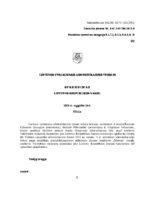
Lithuania vs RUAB Melesta, August 2013, Supreme Administrative Court, Case No A575-1421/2013
RUAB Melesta was a supplier of black metal, while the companies that had been included in the bencmark study were involved in the supply of metalliferous minerals. The tax authority found that the comparability analysis performed by RUAB Melesta was insufficient and had resulted in a much too wide a arm’s length range. After excluding companies with comparability defects from the benchmark study, RUAB Melesta’s results turned out to be outside the arm’s length range and an adjustment was made to its taxable income. An appeal was filed and the Regional Administrative Court ruled in favour of Melesta and annulled the assessment. The tax authority then appealed to the Supreme Administrative Court. Judgment of the Court. The Supreme Administrative Court concluded that the companies selected in the benchmark study that had been removed by the tax authority were not comparable and ruled in favour of the tax authority. Click here for English Translation Click here for other translation
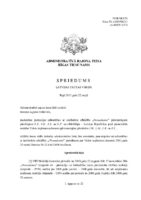
Latvia vs SIA „RPM”, May 2013, Administrative District Court, A420496211 (A-00305-13/7)
The tax authority (SRS) had disregarded the TP method chosen by the taxpayer and performed its own TP analysis which showed that the income had been below the 1. quartile, and on that basis an assessment of additional taxable income was issued. Judgment The Administrative Court largely annulled the assessment and ruled in favour of the taxpayer. The court emphasised the need for the tax authority to justify its reasons for rejecting a particular TP method and its choice of criteria in a benchmarking study. The court found that the tax authority had failed to provide sufficient justification for its choice of TP method, profit level indicator and comparables due to an incorrect comparability analysis. Click here for English translation Click here for other translation
![Australia vs SNF, June 2011, Full Federal Court, Case [2011] FCAFC 74](https://tpguidelines.com/wp-content/uploads/securepdfs/Commissioner-of-Taxation-v-SNF-Australia-Pty-Ltd-2011-FCAFC-74-1-June-2011-pdf-image-141x200.jpg)
Australia vs SNF, June 2011, Full Federal Court, Case [2011] FCAFC 74
SNF was a member of a global group with headquarters in France. SNF bought polyacrylamides from group companies overseas, and sold them to unrelated end-users in various industries in Australia. From its incorporation in 1990 until 2004, SNF consistently returned tax losses. SNF was subject to a transfer pricing audit. Determinations were made under Division 13 of Part III of the Income Tax Assessment Act 1936 to adjust the consideration for the company’s international related party transactions to reflect an arm’s length amount. For the income years from 1997 to 2003, the Commissioner made determinations under ss136AD(3) and (4) of the Act as to the arm’s length price of the chemicals. The tax authorities issued notices of assessment in 2007, and subsequently disallowed the taxpayer’s objections to those assessments. Before the Court the commissioner submitted that the taxpayer was able to continue to trade, not because of the alleged price support, but because of an injection over the period of $31.2 million in share capital from its parent. It was said that an independent distributer would not have continued to trade at a loss for 13 years to further a market penetration strategy for the benefit of an unrelated supplier. The unstated conclusion is that the losses were being generated by the excessive prices paid by the taxpayer. In response SNF produced evidence of sales by the overseas suppliers to third party purchasers, which it submitted established comparable uncontrolled prices (CUP) that were as high as or higher than the prices paid by SNF. Judgment The Court found that losses in SNF had not been caused by excessive prises paid for polyacrylamides bought from group companies – but instead unreasonably low levels of sales, by competition in the Australian market, by excessive stock losses and by poor management. Based on these findings the Commissioner’s appeal was dismissed with costs.
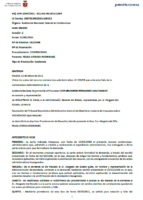
Spain vs EcoloJeans SL, May 2011, National Court, Case No SAN 2304/2011 – ECLI:ES:AN:2011:2304
EcoloJeans SL had made purchases from its majority shareholder, Mr Donato. According to the tax authorities, the agreed prices for these purchases were higher than the arm’s length price, resulting in lower taxation. The tax authorities had determined the arm’s length price by applying the resale price method, based on the margin obtained by companies in the same sector in comparable transactions with independent parties. For this purpose, a sample of six wholesalers had been selected – two whose identification data were known and four that had not been identified by the authorities for reasons of confidentiality. EcoloJeans SL filed a complaint against the assessment to the TEAR, but the complaint was later rejected. An appeal was then lodged with the TEAC (Tribunal Económico Administrativo Central), which was partially upheld in the sense that the Tribunal found a lack of reasoning (due to use of secret comparables), leaving EcoloJeans SL defenceless. Judgment of the National Court. The Court upheld the TEAC’s decision in regards of lack of reasoning (use of secret comparables) in the pricing of the controlled transactions. Excerpt “In the contested decision, the TEAC analyses the valuation method used by the Actuary, which was based on data obtained from certain companies in the sector, and states, textually: “Having analysed the file by this Central Court, the only documentation relating to these companies that is contained is a sheet for each one on which, obtained from the AEAT database, the recorded profit and loss account of the 1998 Corporation Tax returns is reflected, the ‘screenshots’ of the AEAT’s CDB to which the interested party refers, and which contain the data used by the inspection (turnover and supplies), without figuring either the tax identification number or the name of the holder of those data, or any reference to the activity carried on. The regulations require that the act of determining the normal market value be reasoned, containing the grounds on which the valuation made is based; that the valuation that gives rise to the increase in the taxable base with respect to that declared is rationally and sufficiently justified. And the meaning or purpose of that statement of reasons is to preserve the interested party’s right of defence, and therefore the Administration must use in that valuation procedure data that can be made fully known to the interested party so that it can defend itself adequately, and not data affected by confidentiality, and which, for that reason, the interested party is denied knowledge thereof, as occurs in the present case, however relevant such data may be for the specific case. Therefore, this Court considers that the interested party’s right of defence has been impaired as a result of the Inspectorate’s actions, preventing the lack of identification of the companies used in the sampling to determine the market value, the verification by the interested party of their suitability or unsuitability for the purposes of the valuation and, therefore, preventing it from timely defending its right and adequately opposing the valuation carried out, causing it, in short, a defencelessness that would lead to the annulment of the act. For all of the above reasons, and considering that this Court considers that there is a lack of reasoning in the valuation agreement which caused him to be defenceless, his claim on this point must be upheld and the adjustment made must be annulled”. Click here for English translation Click here for other translation
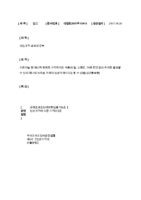
Korea vs Pharma Corp, September 2007, Supreme Court, Case No 2007두13913
A Korean pharma corporation produced and sold finished pharmaceuticals. Active ingredients were imported from foreign related parties in the United States and Ireland. The Korean pharma corporation produced and sold the original finished products by importing the five original patented raw materials that had expired from the patent period in each business period from December 1, 2001 to November 30. The tax authorities calculated the normal price of the original raw materials by a comparable third party pricing method. As for the specific methodology, the median price of imported generic raw materials for other domestic pharmaceutical companies was calculated by multiplying the ratio between the original product and the medical insurance price of the drug (generic finished product) produced by the domestic generic raw material by other domestic pharmaceutical companies. After calculating the normal price of the raw materials, the difference between the original price of the original raw materials and the difference between the original price and the normal price of the raw materials was included in the income. The tax authorities filed a law suit against the company for the disposition of a corporate tax levy, which had the following points: there are significant differences between generic drugs (or their raw materials) and original drugs (or their raw materials) in terms of customer loyalty, was not a market price reflecting the difference in quality but a government regulation price, which is an indicator of finished products, and was not correlated with the import price of raw materials, so it was pointed out that it was inappropriate as an index to adjust for significant difference. Judgment of the Supreme Court “Generic raw materials in this case have the same composition and molecular structure as the original raw materials of the case and their efficacy, ie biological efficacy, do not seem to be much different, so the rest of the generic raw materials It would be possible to derive reasonable normal prices through such adjustments to the import prices of generic raw materials in this case. The medical insurance drug price does not include the consideration of the market value of the drug and its raw materials in the decision process, and furthermore, it is not considered whether the raw material of the drug is original or generic. And the upper limit is also determined by the number of items listed on the same ingredient formulation and the upper limit of the listed ingredients. Therefore, the price of the original finished product in the case of the health insurance drug price and the price of the generic drug It is hard to say that the adjustment method that utilizes the difference between drug prices can not be a way to rationally eliminate differences in consumer loyalty etc. that have a significant impact on the import price of generic raw materials in this case.” The Supreme Court concluded that if the original drug (or raw material) and generic drug (or raw material) are different in terms of customer loyalty, sales method and cost structure, and if the difference can be reasonably adjusted, it was possible to derive a reasonable normal price. The problem was whether rational adjustments could be applied to take into account the difference in price between the original drug and the generic drug. The Supreme Court held that such an adjustment could not be made, at that the assessment issued by the tax authorities was illegal. Click here for English translation
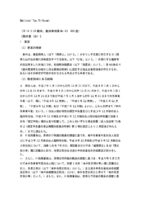
Japan vs “Guarantee Co. Ltd.”, May 2002, National Tax Tribunal, Cases No. 63, p. 454
“Guarantee Co. Ltd.” owned all the shares of G, a company located in the Netherlands, and had provided financial guarantees for loans – in the form of so called “keep well agreements” and guarantee agreements. The main issue in this case is whether or not it was possible to calculate an arm’s length price for the consideration for the guarantee issued. Judgment of the National Tax Tribunal The Tax Tribunal came to the conclusion that the price for the guarantees could be determined based on the CUP method and set at 0,10% of the guaranteed amounts. Excerpt “Therefore, a comparative study of the conclusion of each of the Keep Well Agreements, etc. in question and the Bank Guarantee Transactions in question shows that, as stated in (a) of (b) above, the conclusion of each of the Keep Well Agreements, etc. in question is found to have a function substantially equivalent to a guarantee, although there are differences in the contract form from the Bank Guarantee Transactions in question, and therefore, the Bank Guarantee Transactions in question are considered to be “at arm’s length”. The bank guarantee transactions are considered to have the same function as the guarantee transactions, although the contractual form differs from that of the bank guarantee transactions, and therefore, the arm’s length price of each of the Keep Well Agreements is considered to be calculated using the “method equivalent to the arm’s length price method”. And since each of the Bank Guarantee Transactions in question, which took place at the same time as the Conclusion of each of the Keep Well Agreements in question, etc., carried out between April 1990 and November 1990, are under the same circumstances as B in (C) in (C) above, the guarantee fee rate (0.1%) for them, even without adjusting for differences for the same reasons as C in (C) above, is ) as the guarantee fee rate to be used for the calculation of the arm’s length price for the conclusion of each of the Keep Well Agreements in question, etc. is reasonable. On the other hand, according to the results of the Tribunal’s investigation, the guarantee fee rates for the bank guarantee transactions carried out at the same time as the conclusion of the Keep Well Agreements in question from 1991 onwards are as shown in Annex 6-2, and the level of those guarantee fee rates has increased dramatically compared to before 1990. The reasons for this sharp increase in guarantee fees are, according to the Tribunal’s investigations, generally said to be due to the impact of the BIS regulations on banks or changes in risk management and cost awareness of guarantees in banks, although this is not certain. In addition, the Tribunal was unable to obtain sufficient data on any of the bank guarantee transactions to determine whether or not an adjustment for differences was necessary when they were used as comparator transactions, and to quantify the differences. Therefore, it must be said that it is impossible to calculate the arm’s length price for the conclusion of each of the Keep Well Agreements after 1991, using the bank guarantee transactions as comparator transactions. C. As stated above, with regard to the conclusion, etc. of the Keep Well Agreements up to 1990, it is deemed possible to calculate the arm’s length price by applying a method equivalent to the arm’s length price comparison method using the Bank Guarantee Transactions as the comparable transactions, but with regard to the conclusion, etc. of the Keep Well Agreements in 1991 and later, it is not possible to calculate the arm’s length price by using the arm’s length price comparison method. etc., it is not possible to adopt a method equivalent to the method equivalent to the arm’s length price comparison method, and there is no room for adopting any other method prescribed by government order.” Click here for English translation Click here for other translation
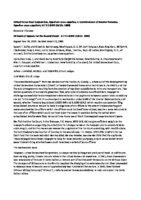
US vs United States Steel Corporation, March 1980, United States Court of Appeals, Second Circuit, 617 F.2d 942
US Court of Appeal had to decide whether the controlled prices determined by US Steel was in accordance with the arm’s length principle, or rather what kind of evidence was sufficient for a taxpayer to challenge successfully the Commissioner’s determination that payments between a parent and a subsidiary are not “arm’s length” and thus are subject to reallocation under § 482 of the Internal Revenue Code. The appeal before the Court of Appeal related to a decision issued by the Tax Court in 1977 where it had been concluded that a § 482 reallocation of profits issued by the tax authorities was justified because US Steel had caused a related party – Navios – to charge rates such that, at all times, the delivered price of Orinoco-origin iron ore in the United States was equivalent of the Lower Lake Erie price. In the Tax Court’s view, this equivalence served several purposes. First, it protected US Steel’s interest in the revenues of its subsidiary, Oliver Mining Co., by insuring that the Lower Lake Erie price was not undercut by cheaper foreign ore. Second, because US Steel could be sure of selling its Orinoco production so long as the delivered United States price did not exceed the Lower Lake Erie price, it enabled US Steel to earn “extra” profits. Third, such extra profits, because they were earned through Navios, were not subject to Venezuelan tax and were sheltered from United States tax. Judgment of the Court The Second Circuit set aside the decision of the Tax Court and ruled in favor of US Steel. Excerpts “We think it is clear that if a taxpayer can show that the price he paid or was charged for a service is “the amount which was charged or would have been charged for the same or similar services in independent transactions with or between unrelated parties” it has earned the right, under the Regulations, to be free from a § 482 reallocation despite other evidence tending to show that its activities have resulted in a shifting of tax liability among controlled corporations. Where, as in this case, the taxpayer offers evidence that the same amount was actually charged for the same service in transactions with independent buyers, the question resolves itself into an evaluation of whether or not the circumstances of the sales to independent buyers are “similar” enough to sales to the controlling corporation under the circumstances, “considering all relevant facts.” In our view, “considering all the relevant facts,” the evidence was sufficient to show similar enough transactions with independent buyers to establish that the price Steel paid Navios was an arm’s length price.” “In sum, the record shows that over four years’ time half a dozen large corporations chose to use the services of Navios despite the fact that they were not compelled to do so. In such circumstances, we think the taxpayer has met its burden of showing that the fees it paid (which were identical to those paid by the independents) were arm’s length prices. We do not say that, had different or additional facts been developed, the Commissioner could not have countered the taxpayer’s showing and sustained the validity of his reallocation. Such a counter-showing would have required evidence that Navios’ charges, although freely paid by other, independent buyers, deviated from a market price that the Commissioner could have proved existed for example, if worldwide ore-shipping contracts had been recorded and published during the period in question.” “We do not think that in order so to hold it must be shown that Navios’ prices were the result of a perfectly competitive market. Prices arrived at by independent buyers and sellers in arm’s length transactions may vary from such a perfect market price depending on factors extraneous to § 482. (…) The fact that transactions take place in the market place at different price levels does not, by itself, prove that transactions between unrelated buyers and sellers, such as Navios and Jones & Laughlin are not at “arm’s length.” The Regulations say that “independent transactions with or between unrelated parties” are enough to insulate a taxpayer’s price from § 482. We decline to use the “all relevant facts” clause to transform this limited approach into a requirement that the taxpayer’s price be the result of a perfectly competitive market. Nor does the statute require that all independent transactions be at the price taxpayer charged or paid; therefore, the fact that Orinoco ore bought by Bethlehem Steel was transported to the United States at rates different from what Navios charged Steel and other customers is irrelevant. Since there were independent transactions significant in number and dollar amount and occurring over a long period of time, we need not address the question of how many such “independent transactions” at the taxpayer’s price would be needed to insulate taxpayer from § 482 in a situation where a preponderance of the “independent” transactions take place at a price far different from the price paid or charged by taxpayer.” “Although certain factors make the operations undertaken by Navios for Steel unique at one point, for example, Navios’ ore-carriers were the largest of their kind in the world the approach taken by the Tax Court would lead to a highly undesirable uncertainty if accepted. In very few industries are transactions truly comparable in the strict sense used by Judge Quealy. Every transaction in wheat, for example, is more or less the same, except for standard variations in amount, time of delivery and place of delivery. But few products or services are as fungible as wheat. To say that Pittsburgh Steel was buying a service from Navios with one set of expectations about duration and risk, and Steel another, may be to recognize economic reality; but it is also to engraft a crippling degree of economic sophistication onto a broadly drawn statute, which if “comparable” is taken to mean “identical”, as Judge Quealy would read it would allow the taxpayer no safe harbor from the Commissioner’s virtually unrestricted discretion to
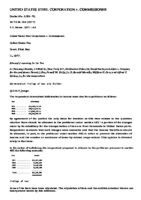
US vs United States Steel Corporation, May 1977, US Tax Court, T.C. Memo. 1977-140
The US tax authorities had issued an assessment on the basis of transfer prices as determined by US Steel was not considered in accordance with the arm’s length principle and thus subject to reallocation under § 482 of the Internal Revenue Code. Judgment of the Court The Tax Court concluded that the assessment issued by the tax authorities was justified because US Steel had caused a related party – Navios – to charge rates such that, at all times, the delivered price of Orinoco-origin iron ore in the United States was equivalent of the Lower Lake Erie price. In the Tax Court’s view, this equivalence served several purposes. First, it protected US Steel’s interest in the revenues of its subsidiary, Oliver Mining Co., by insuring that the Lower Lake Erie price was not undercut by cheaper foreign ore. Second, because US Steel could be sure of selling its Orinoco production so long as the delivered United States price did not exceed the Lower Lake Erie price, it enabled US Steel to earn “extra” profits. Third, such extra profits, because they were earned through Navios, were not subject to Venezuelan tax and were sheltered from United States tax.
